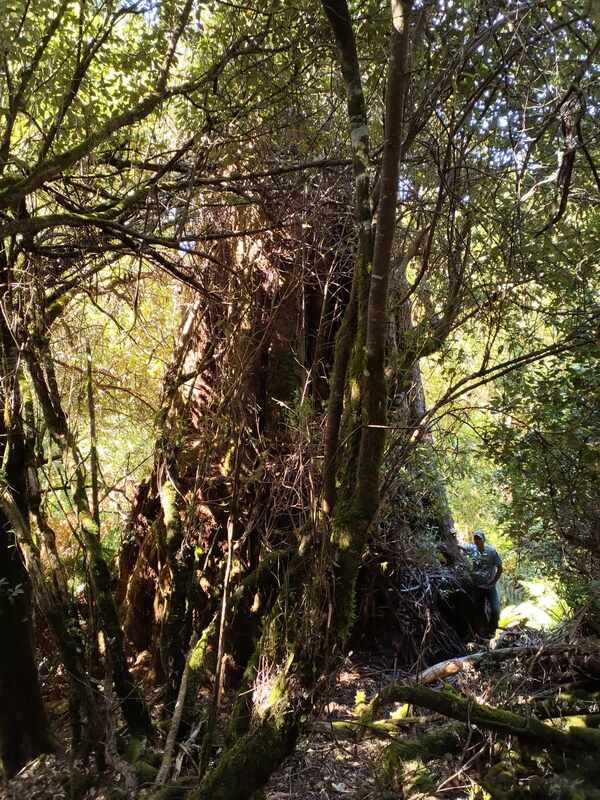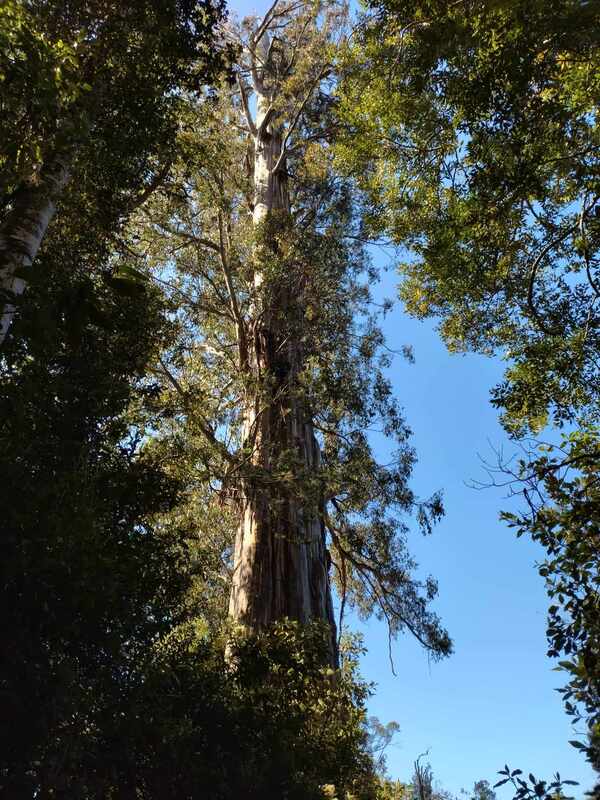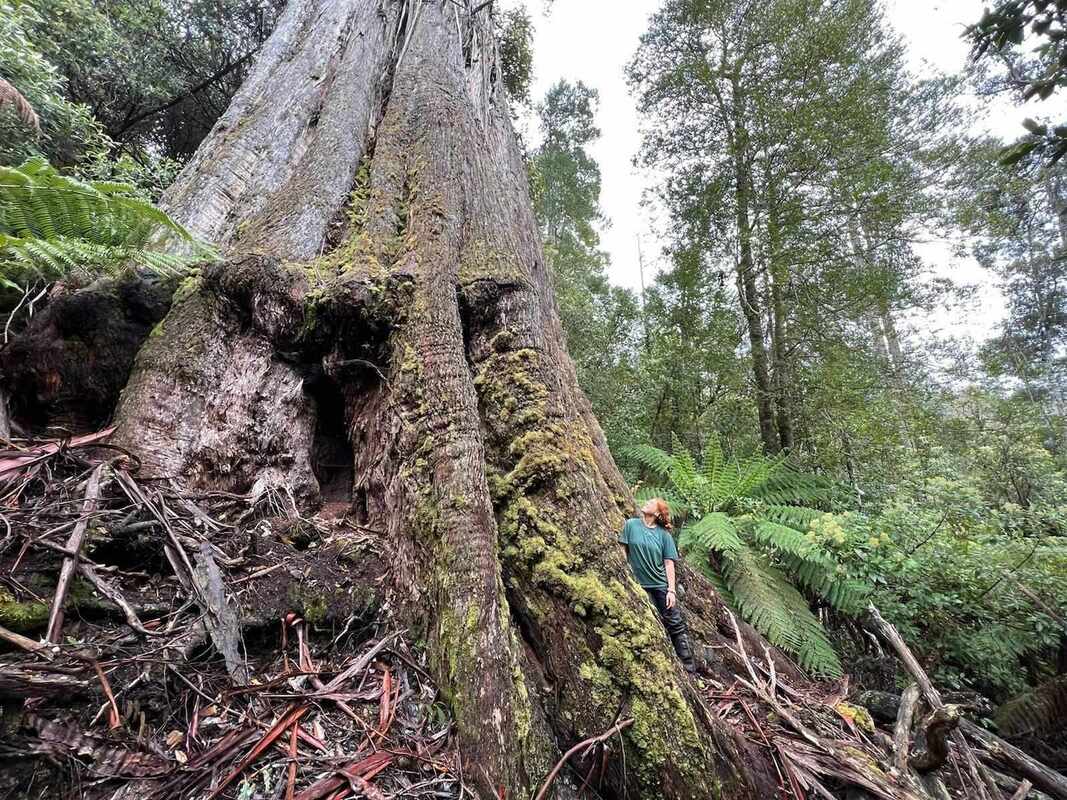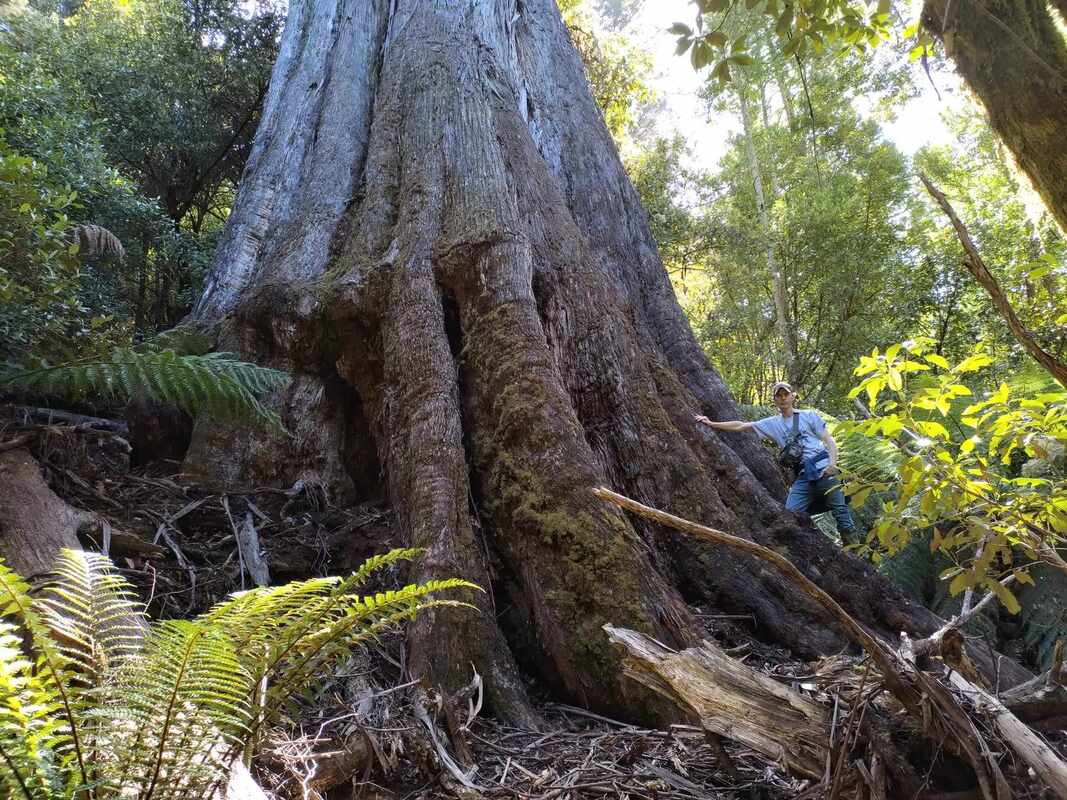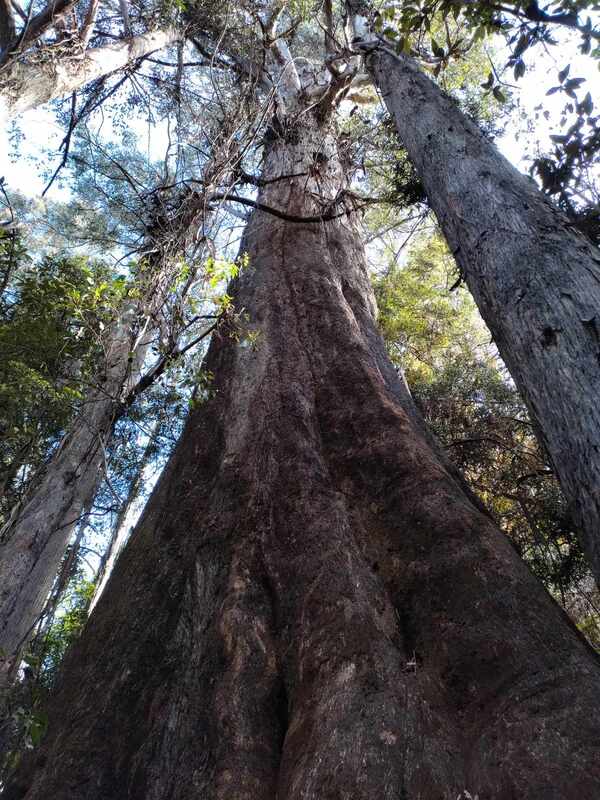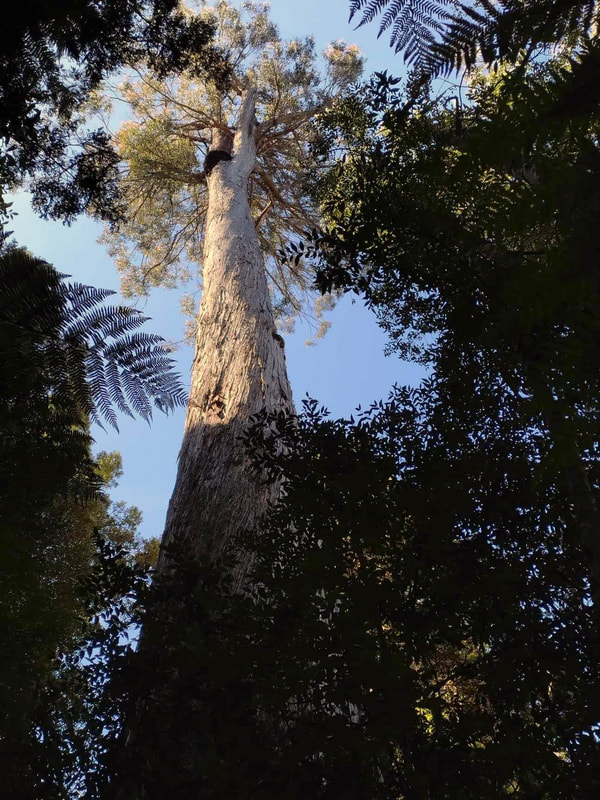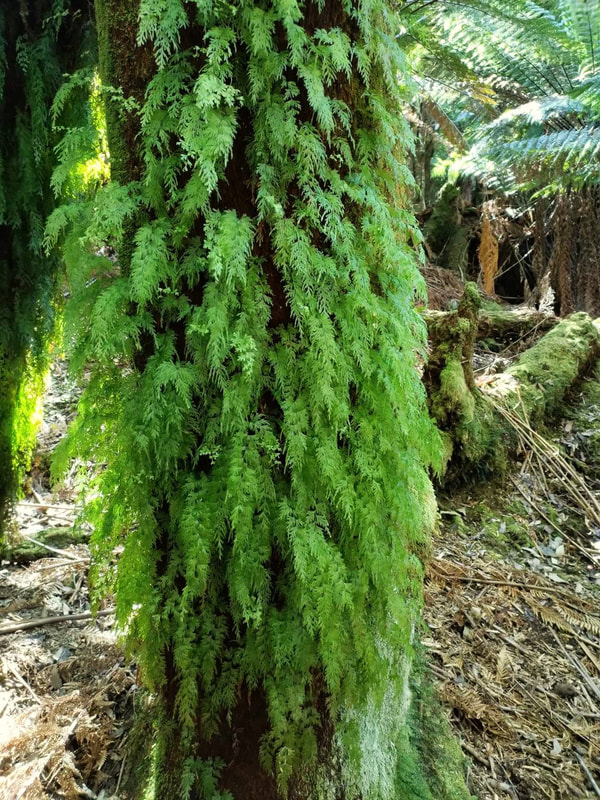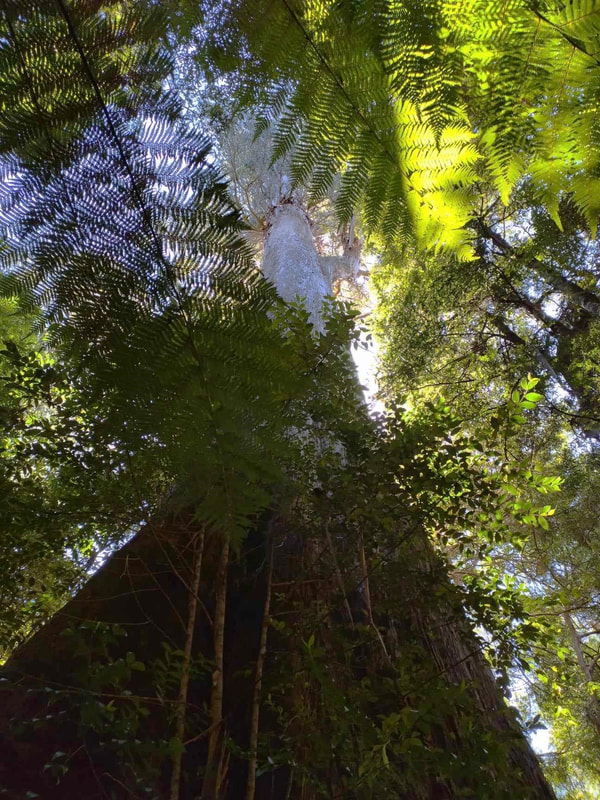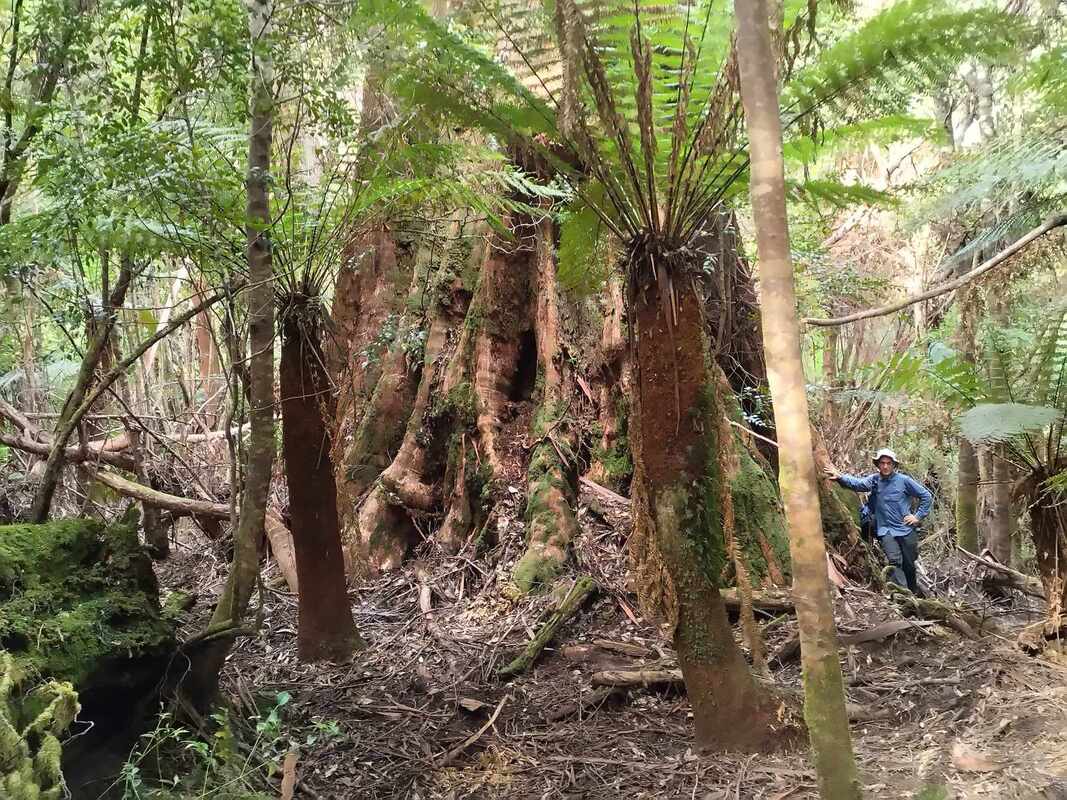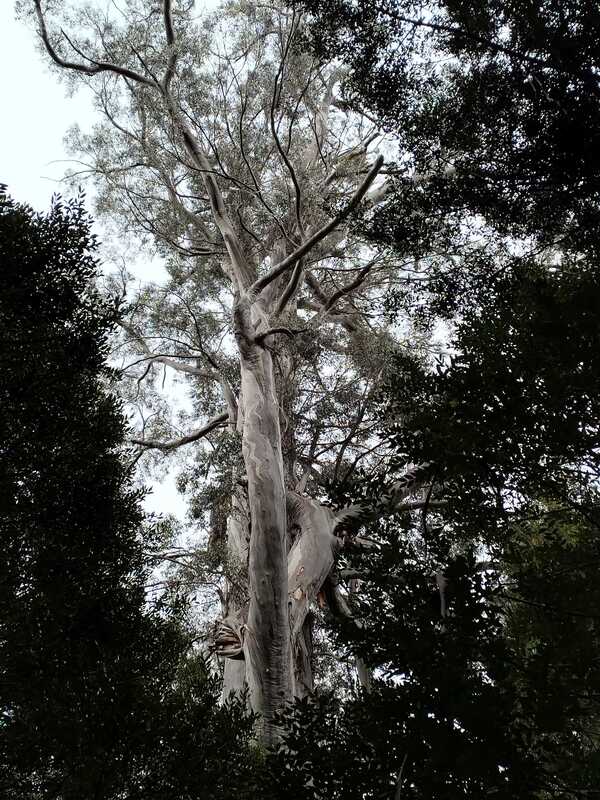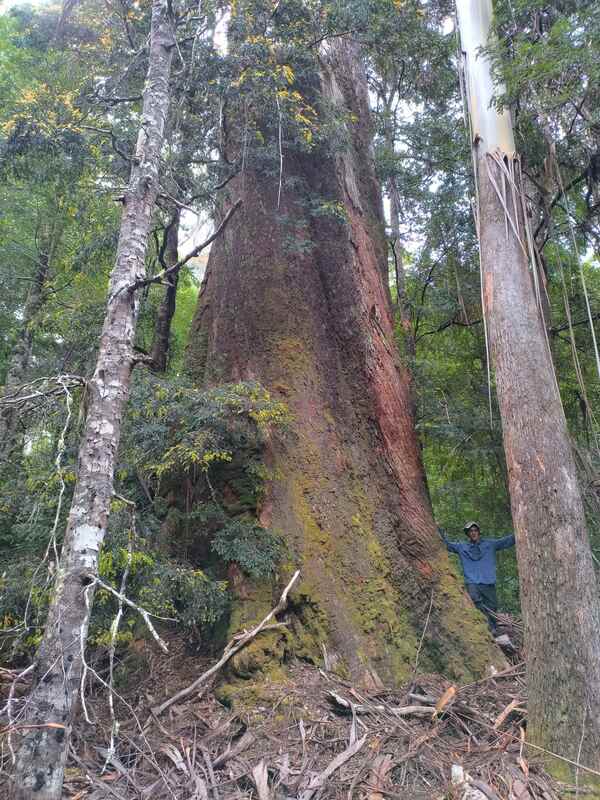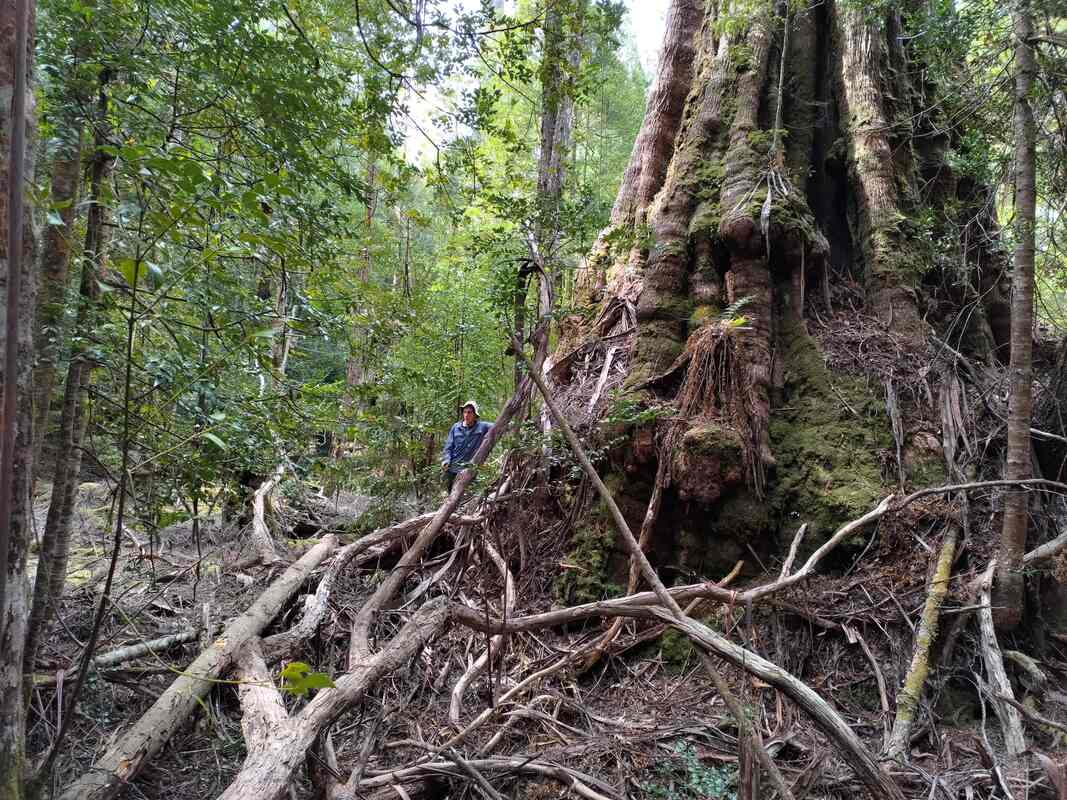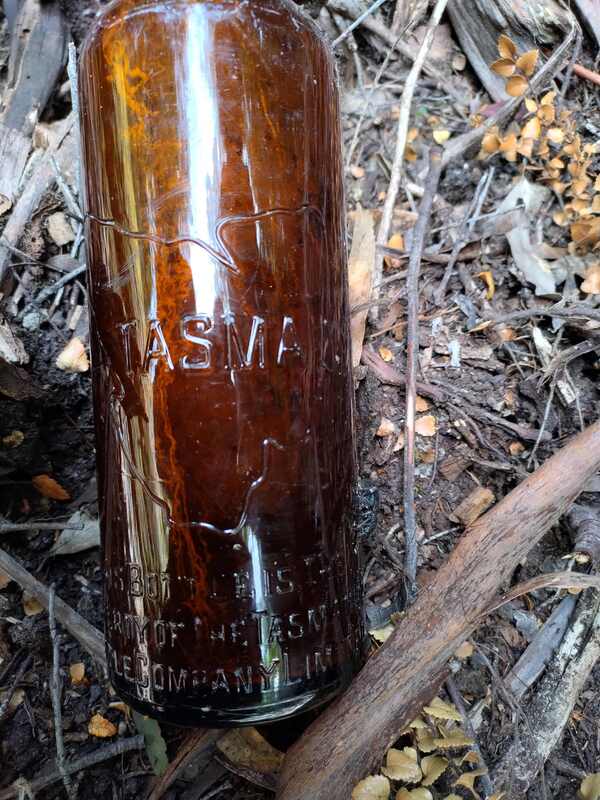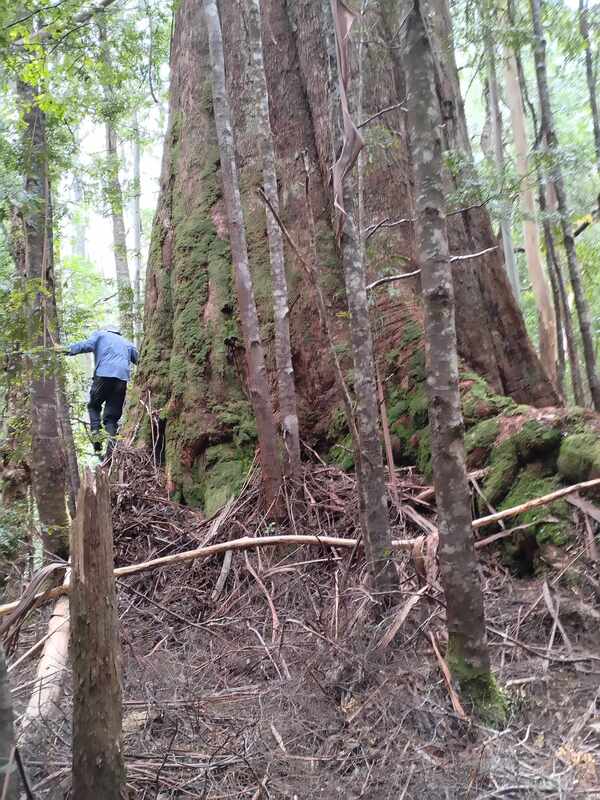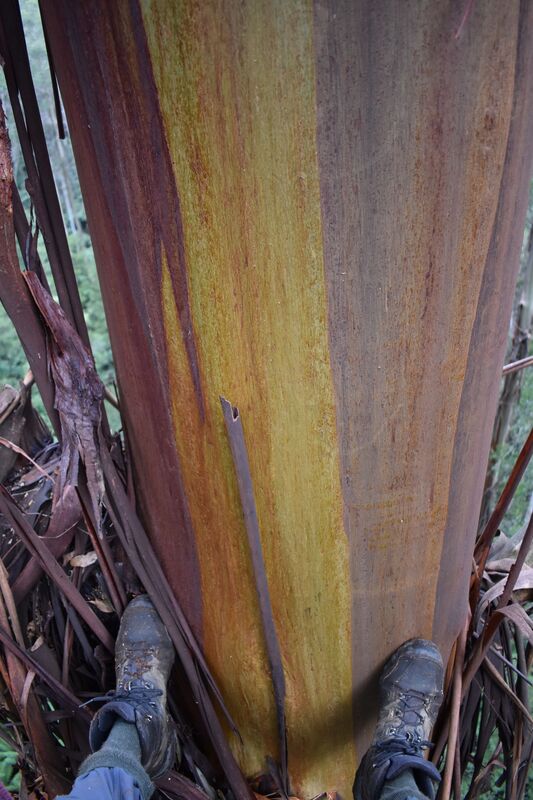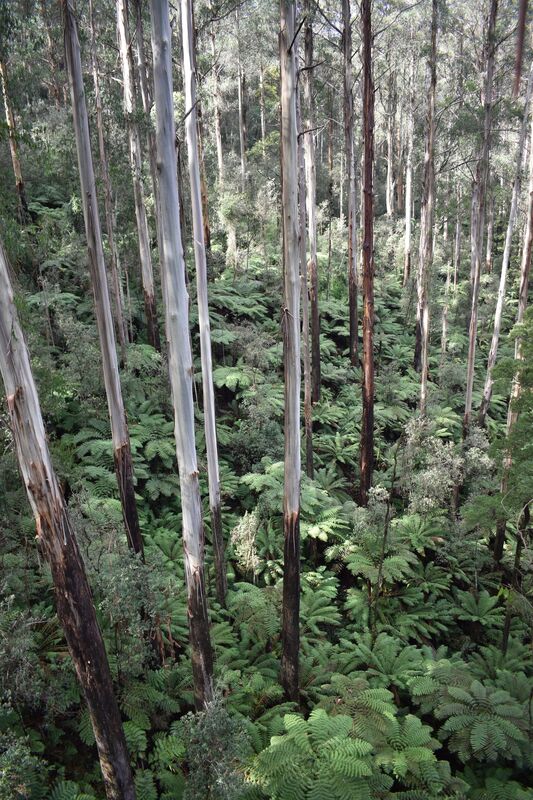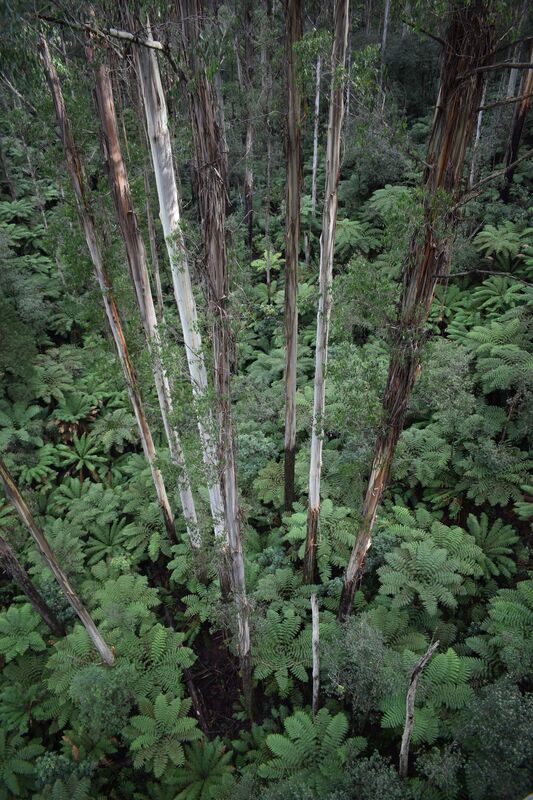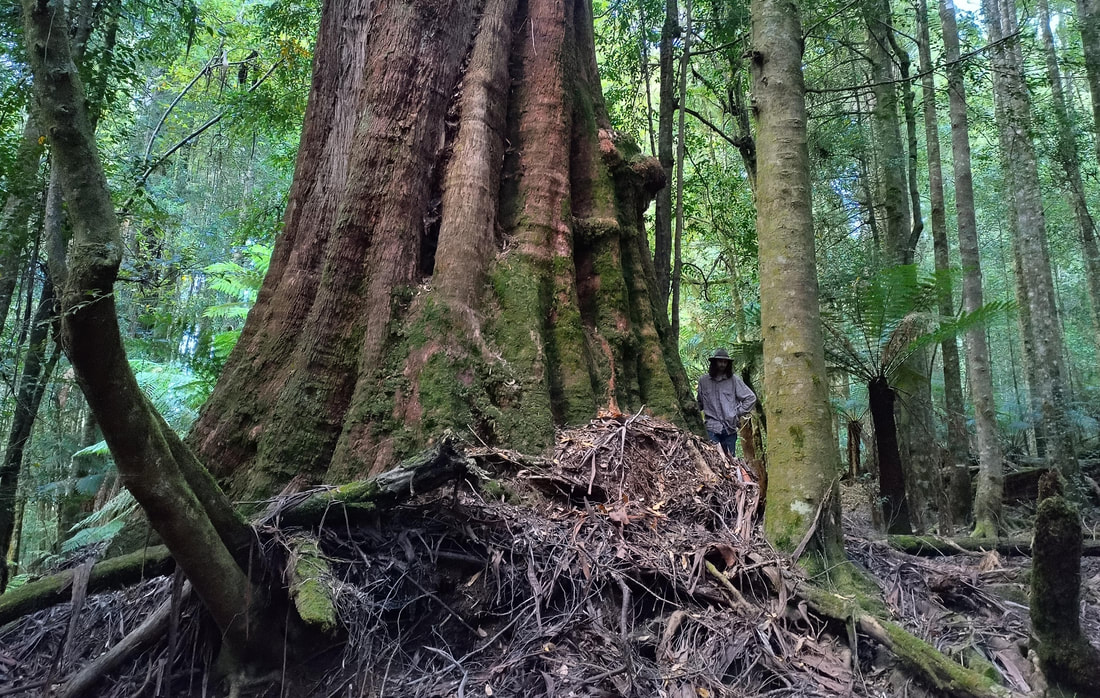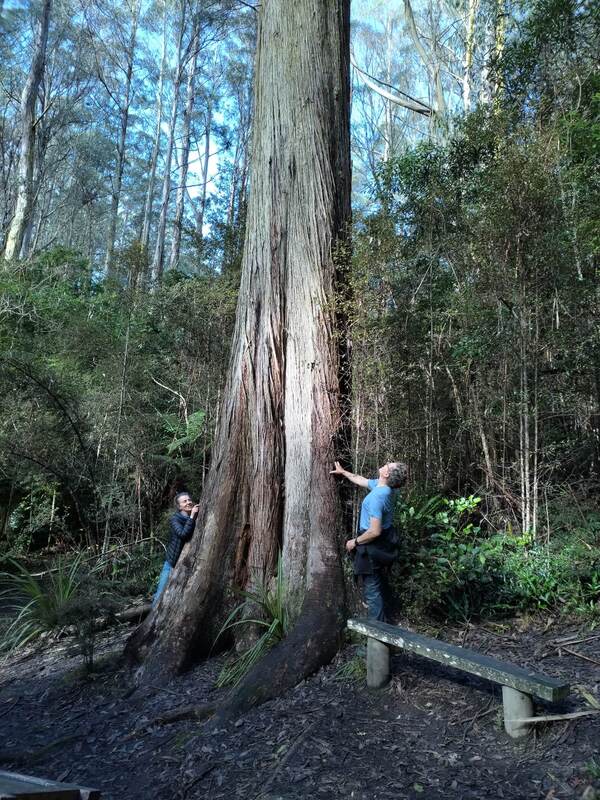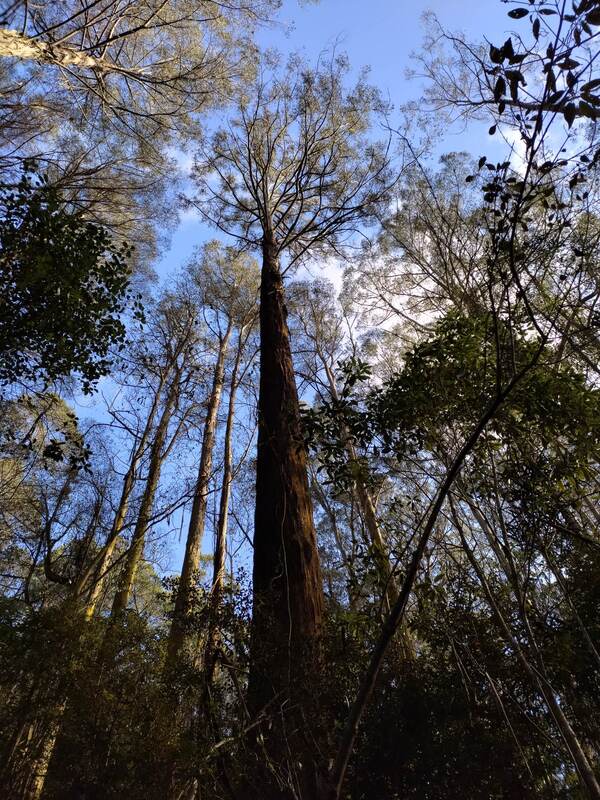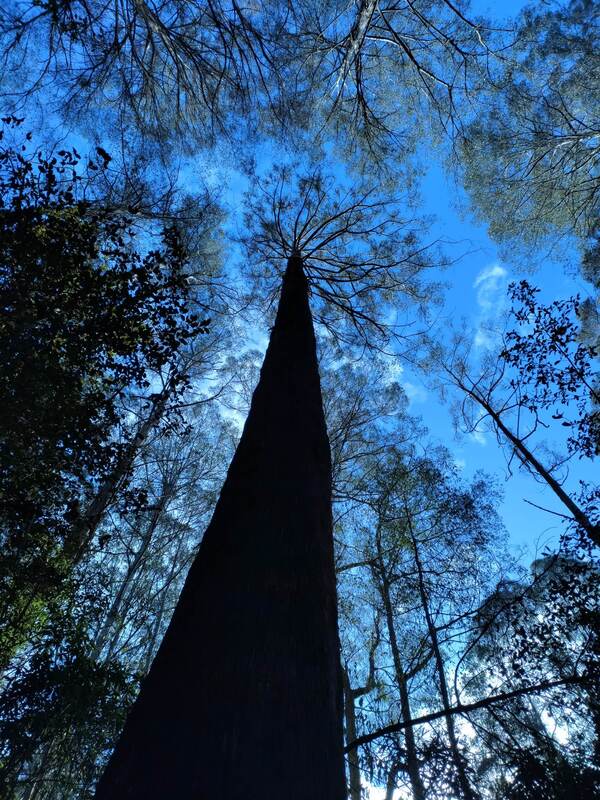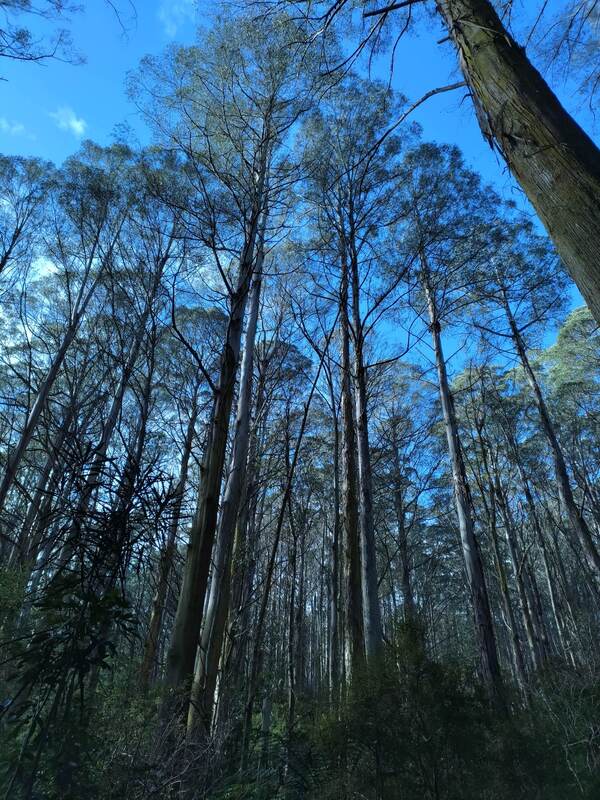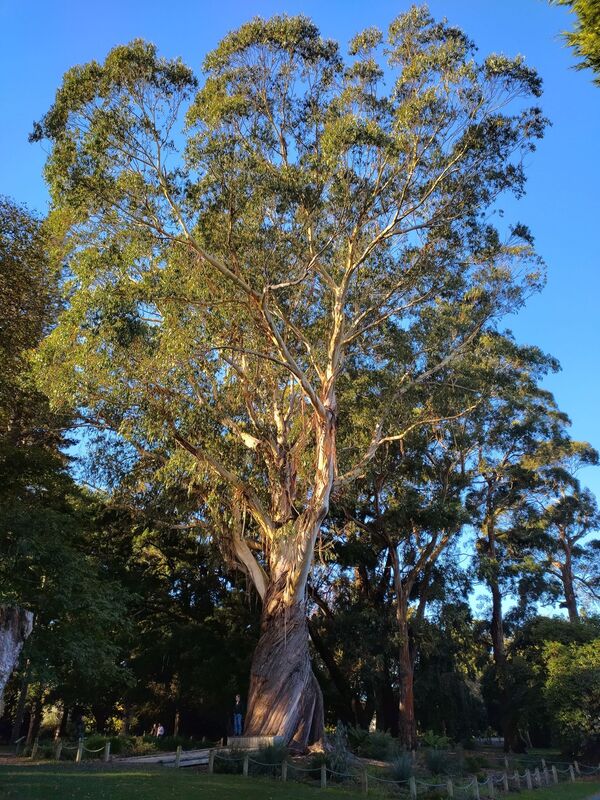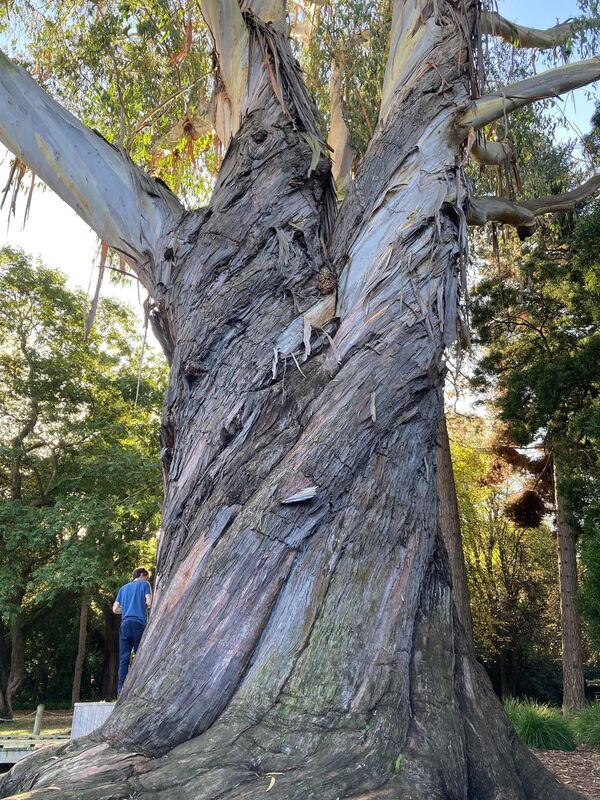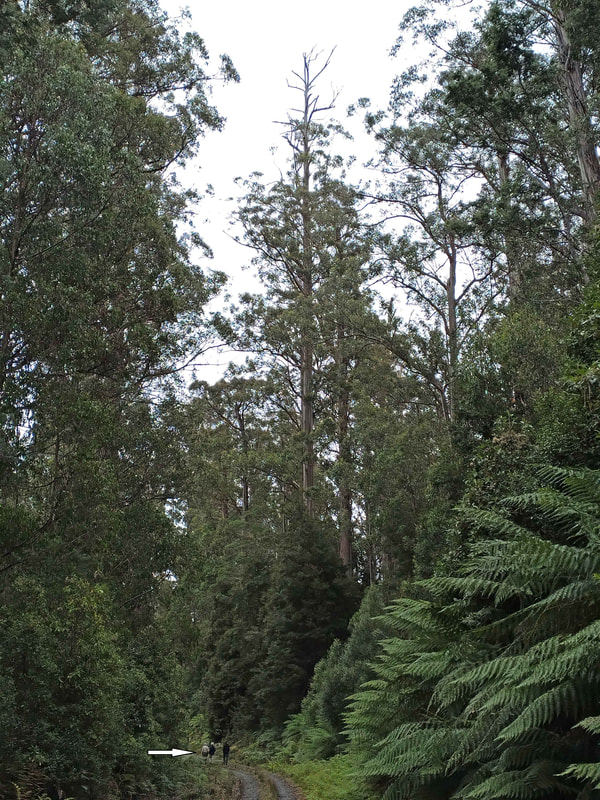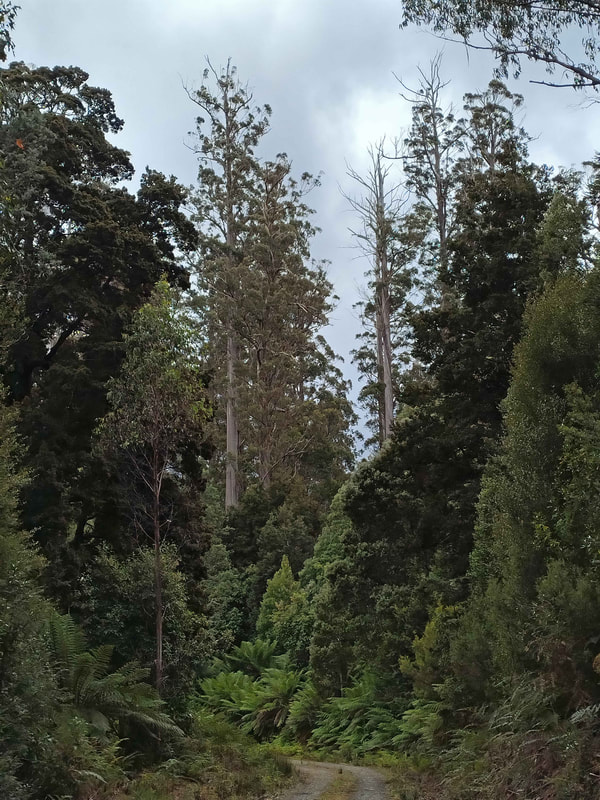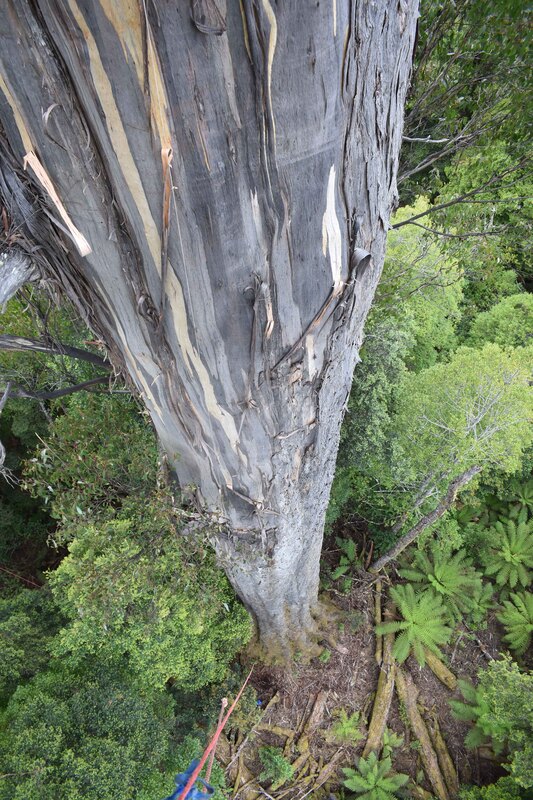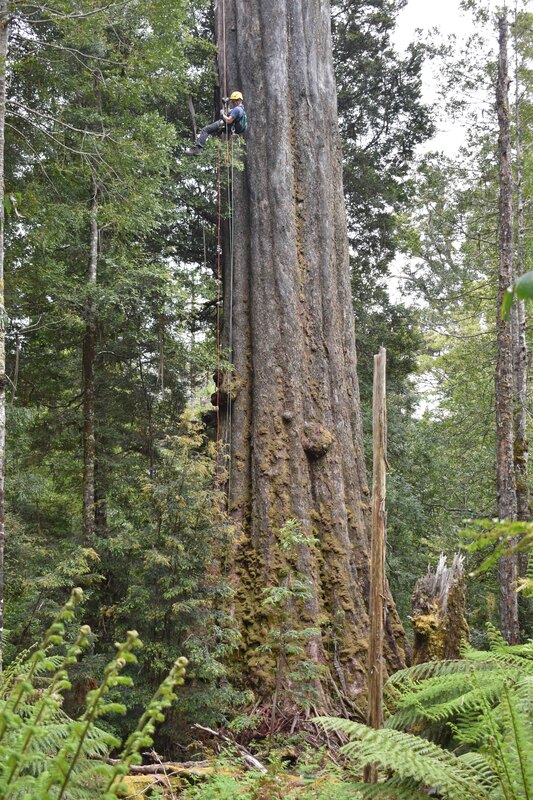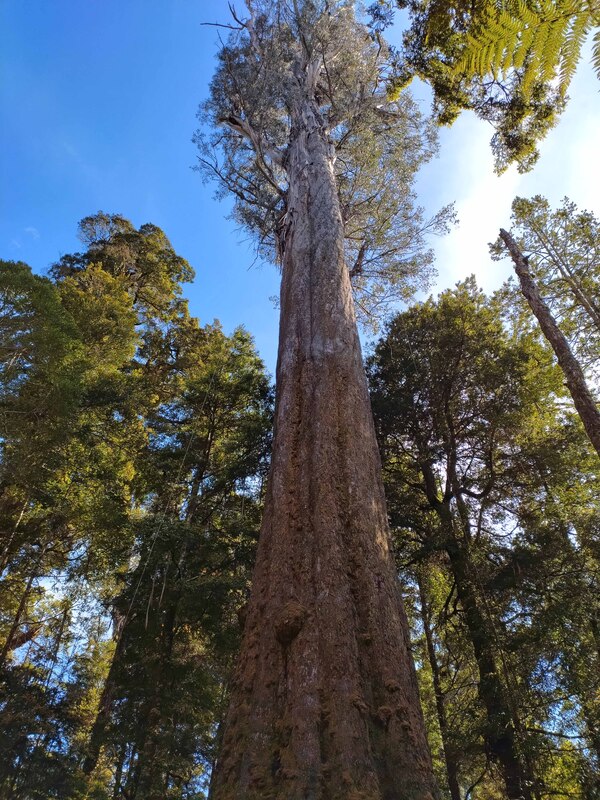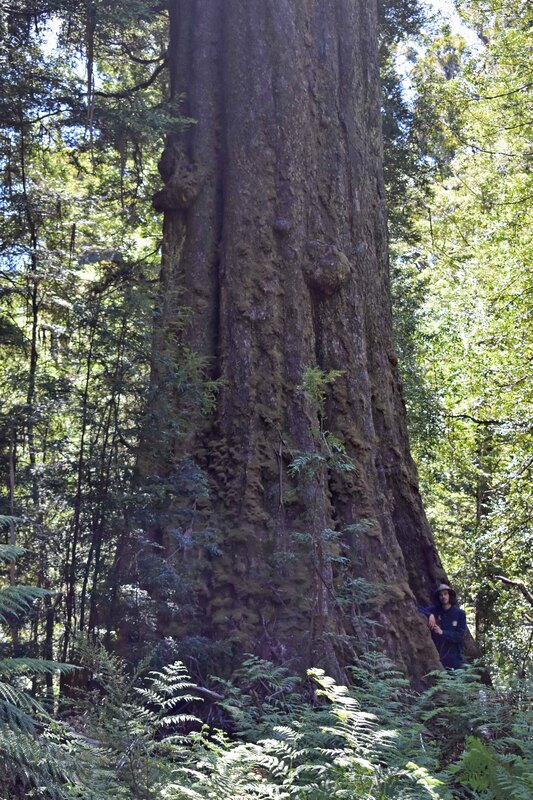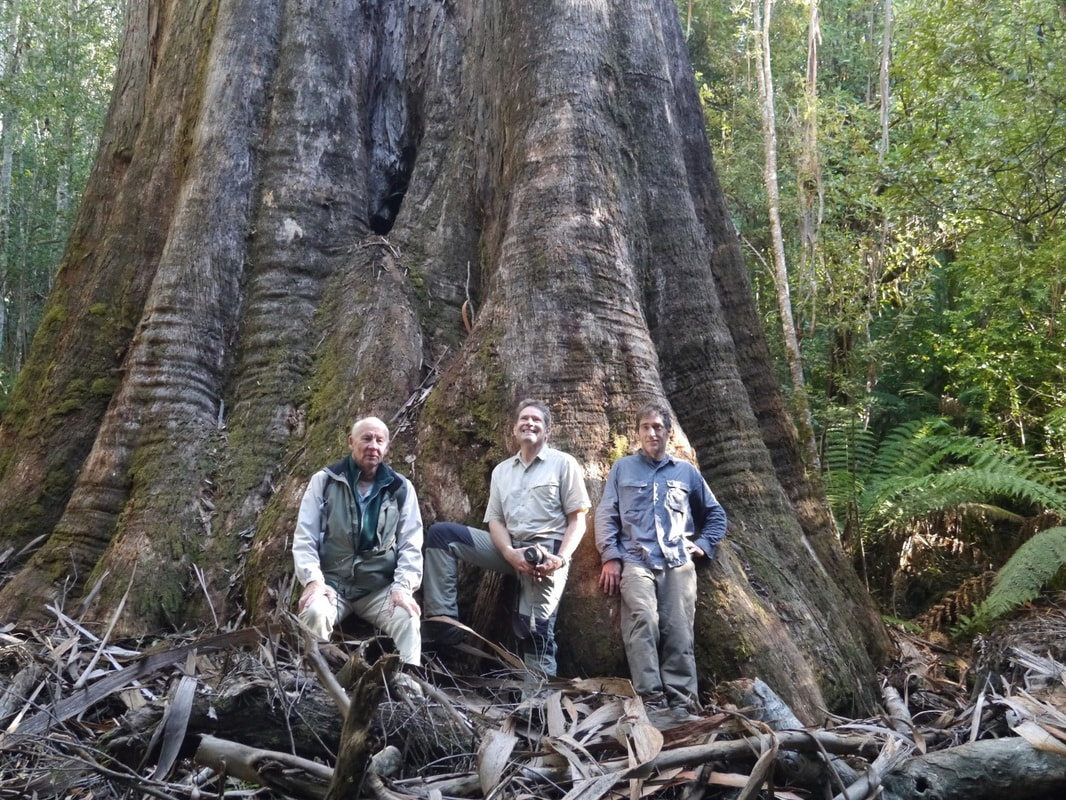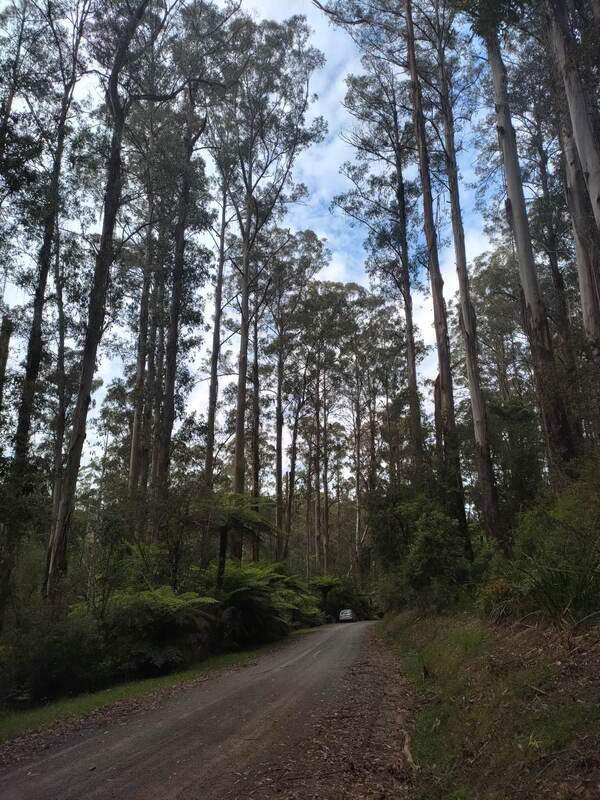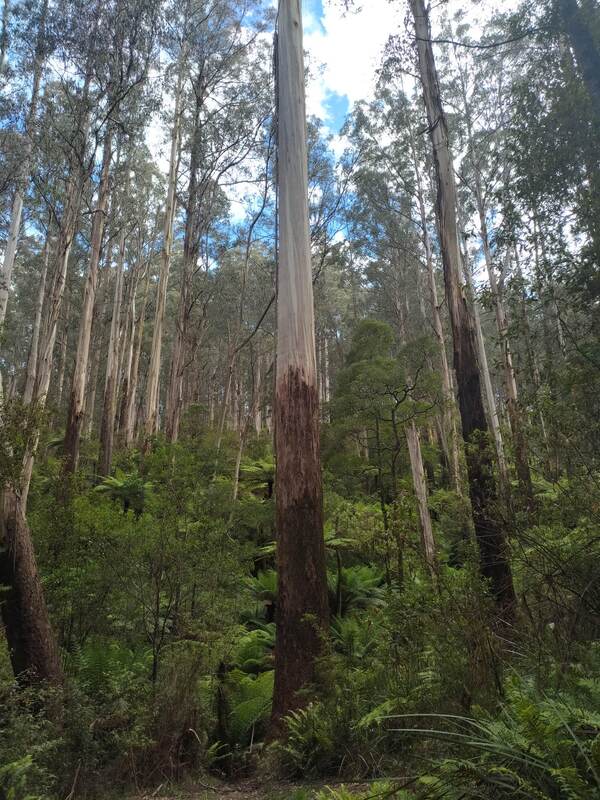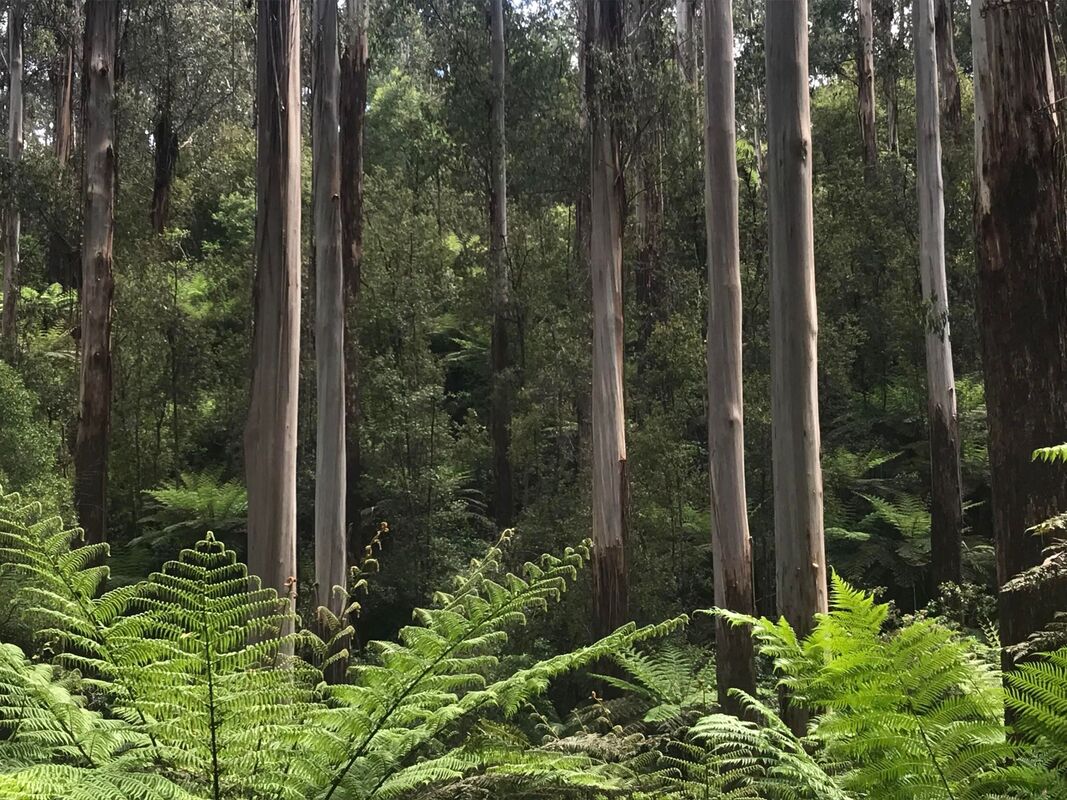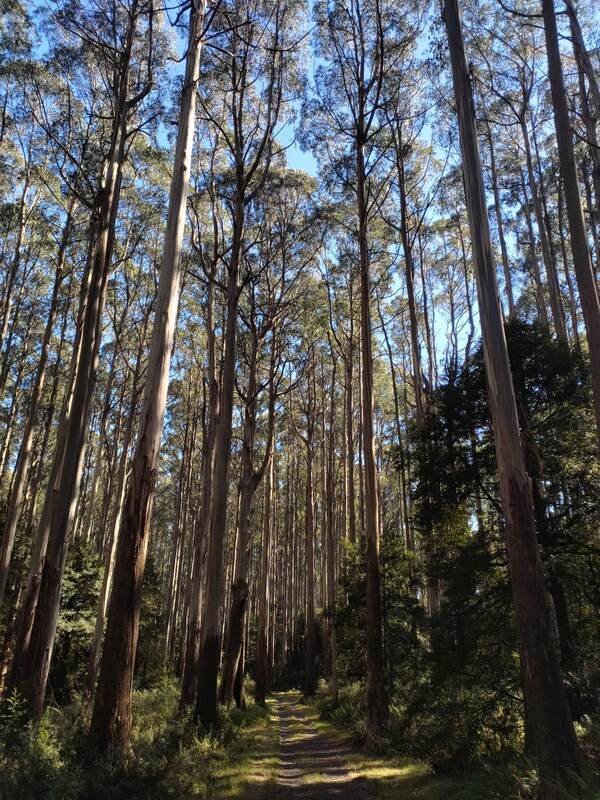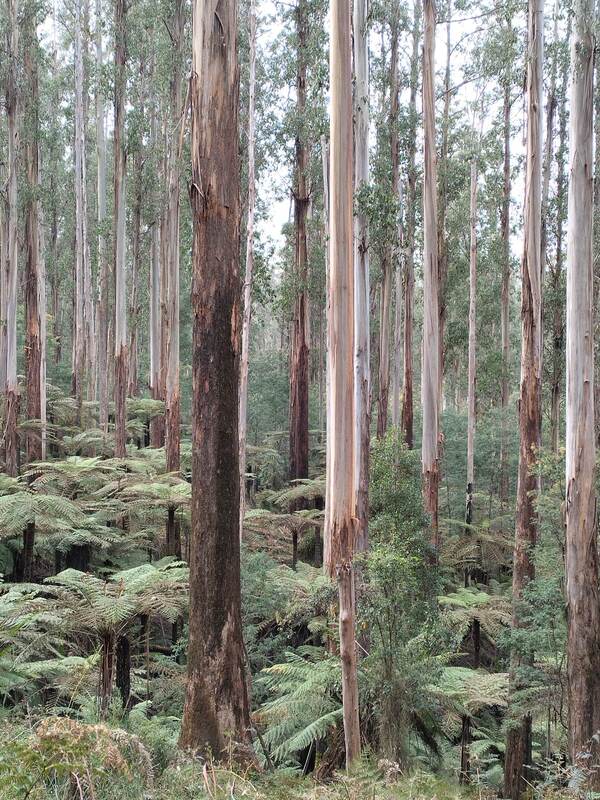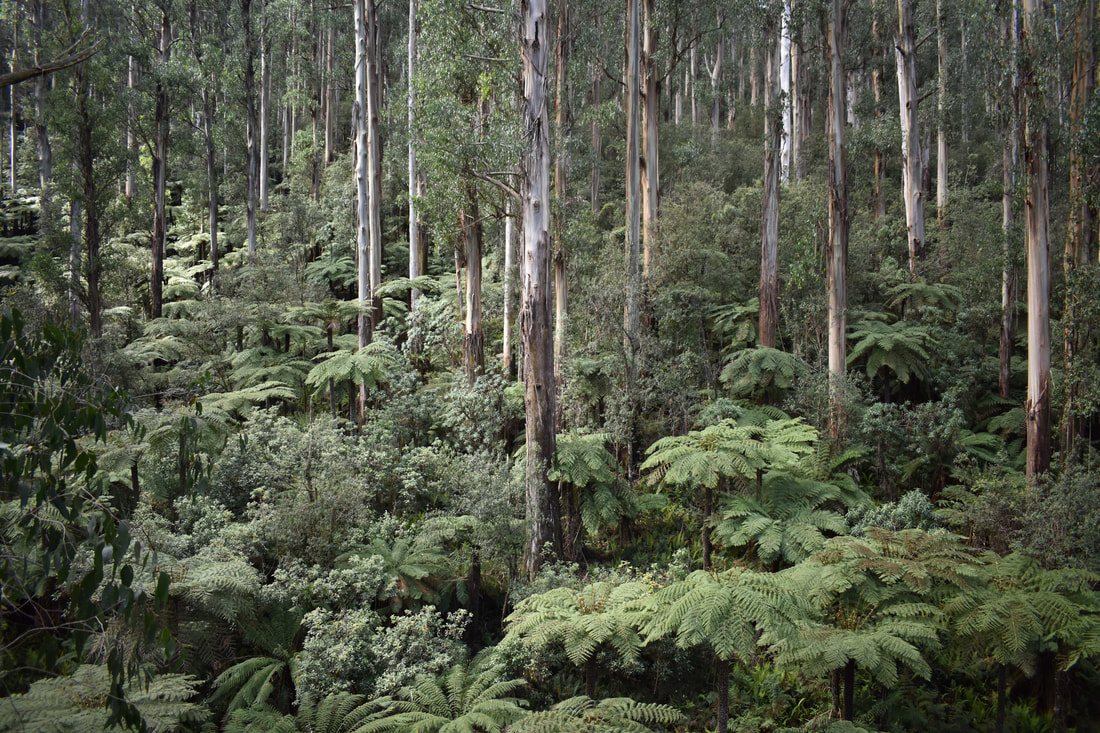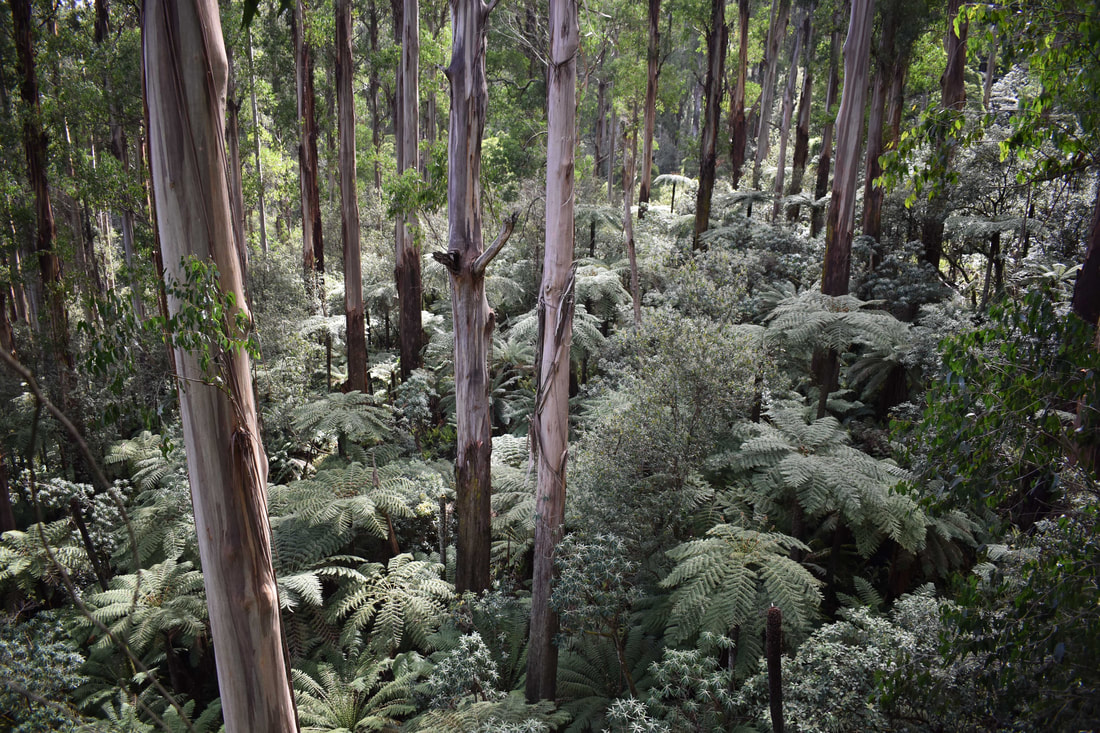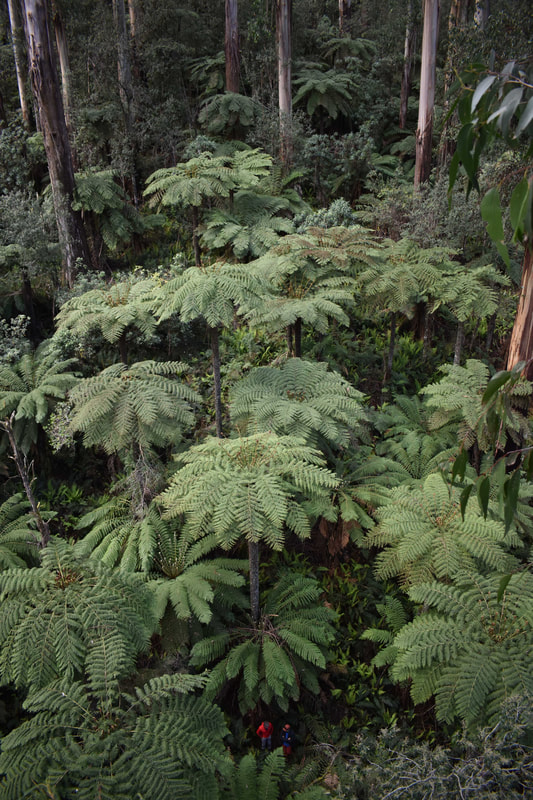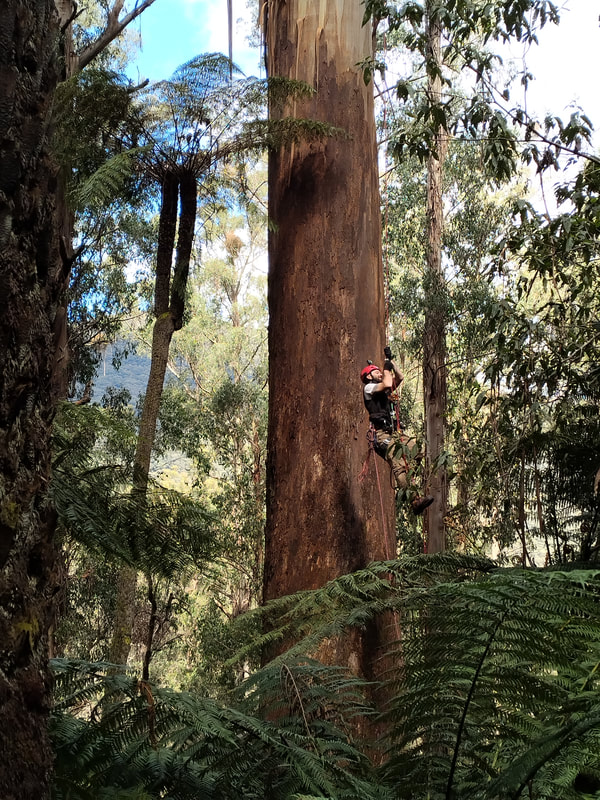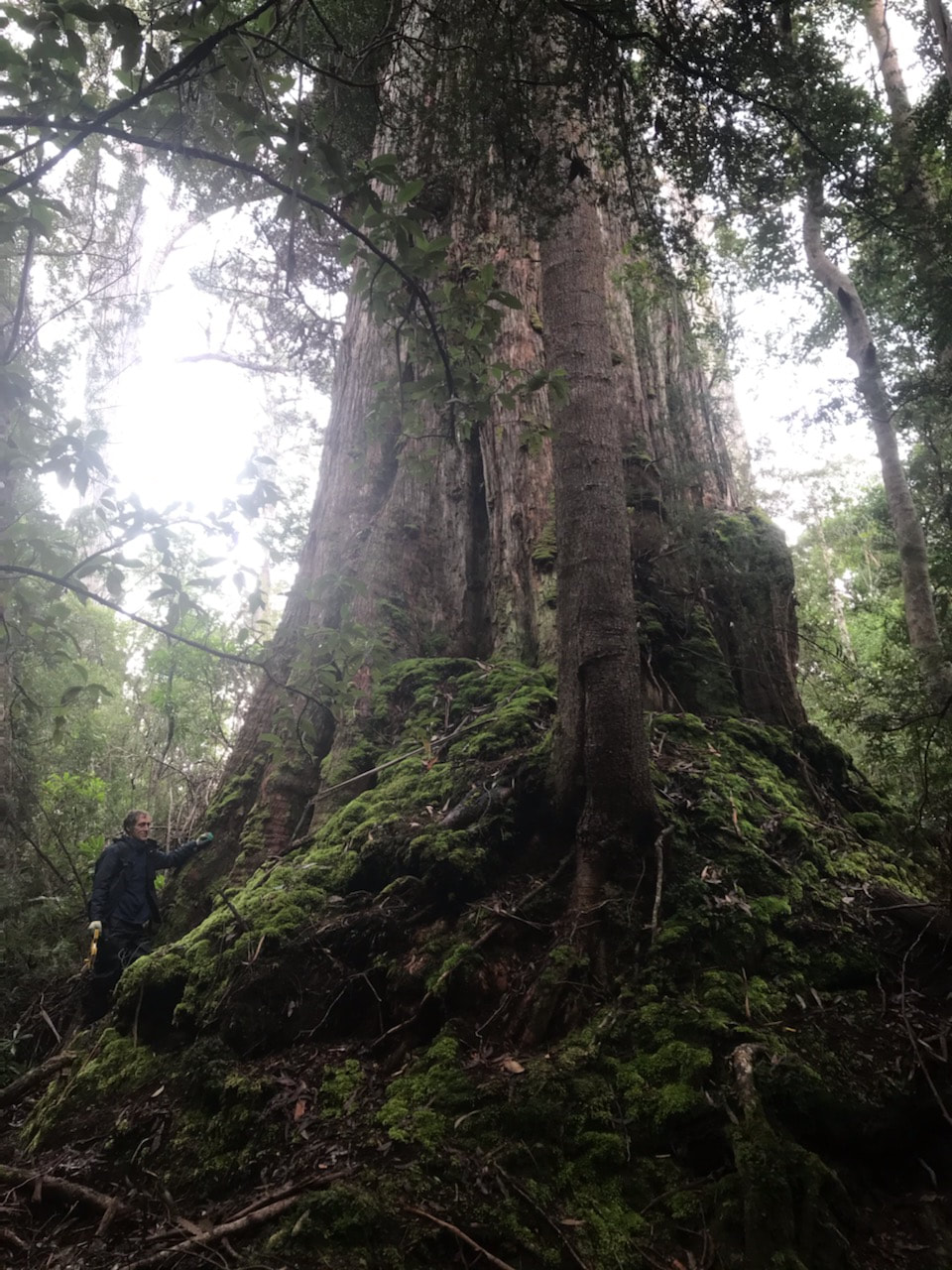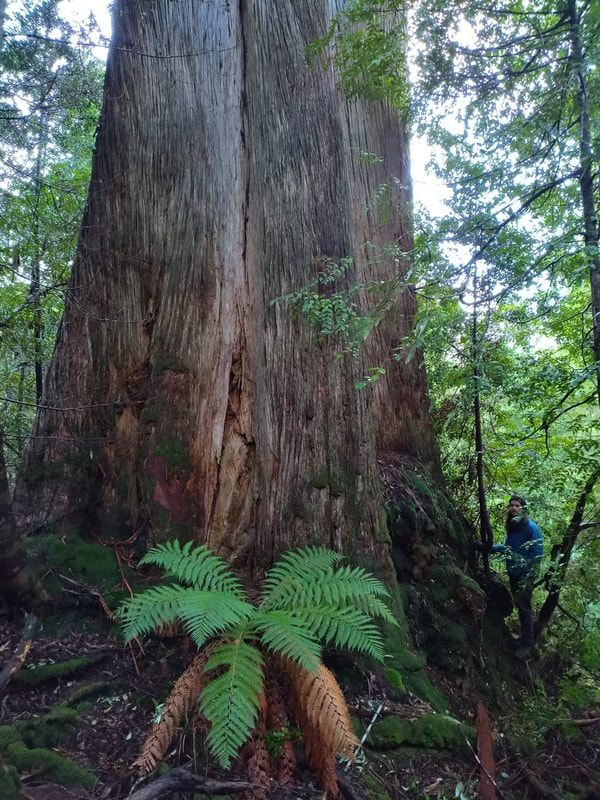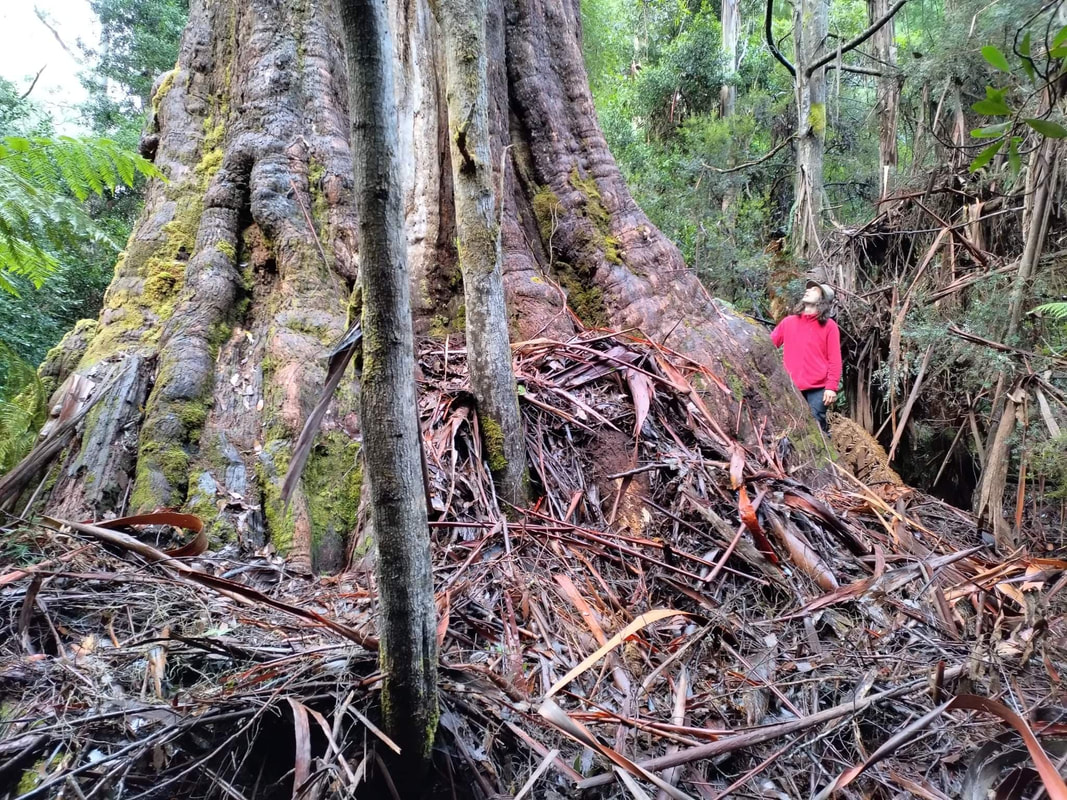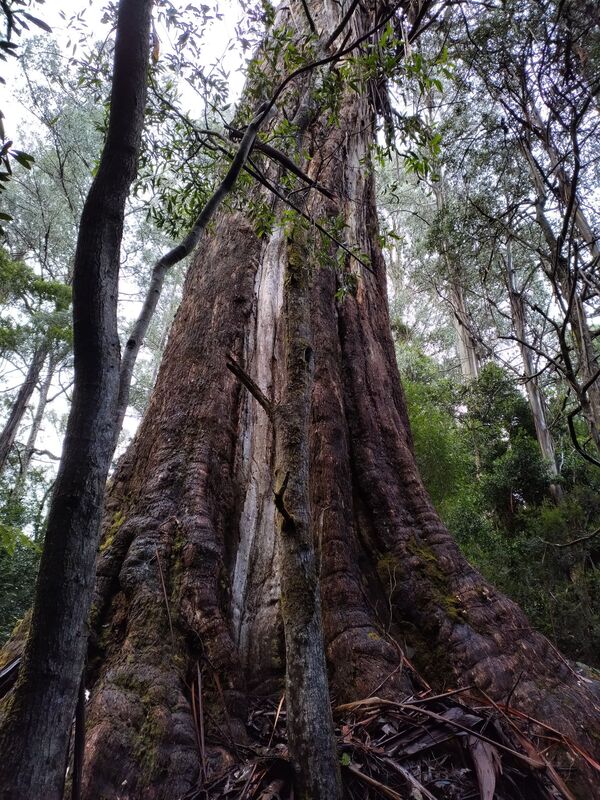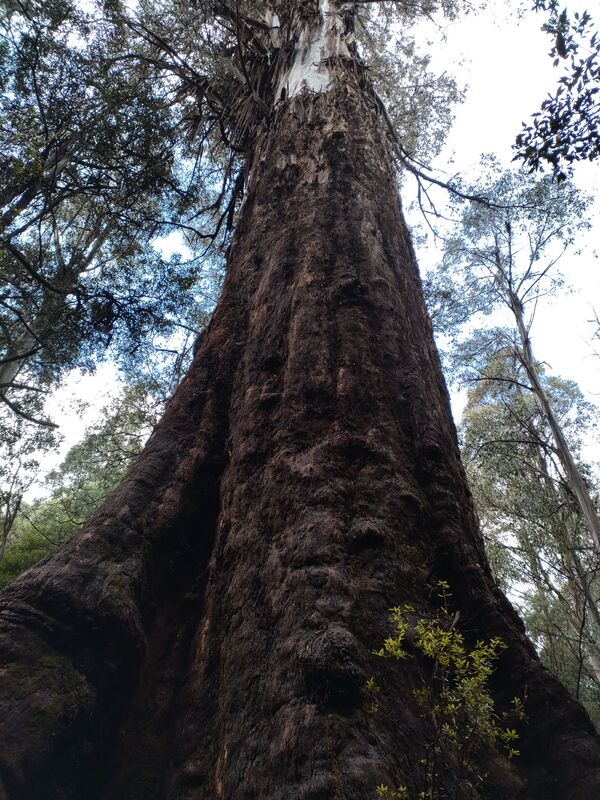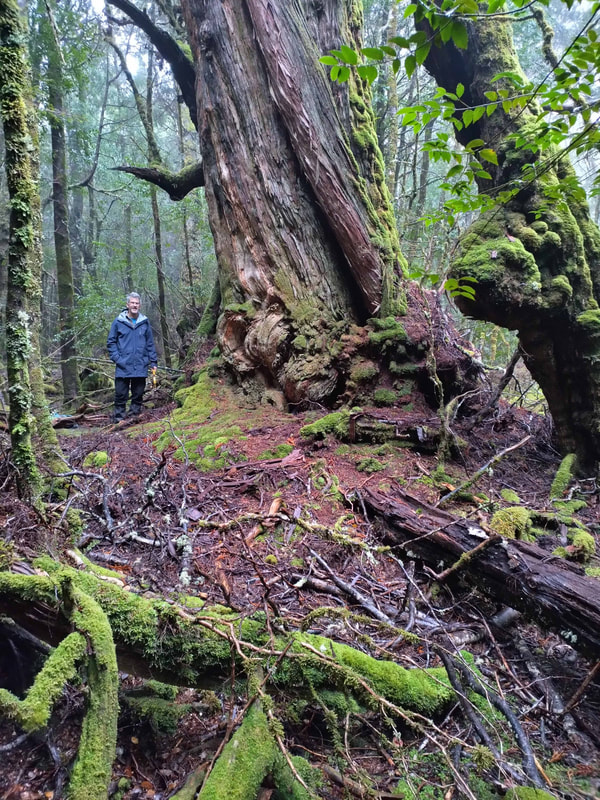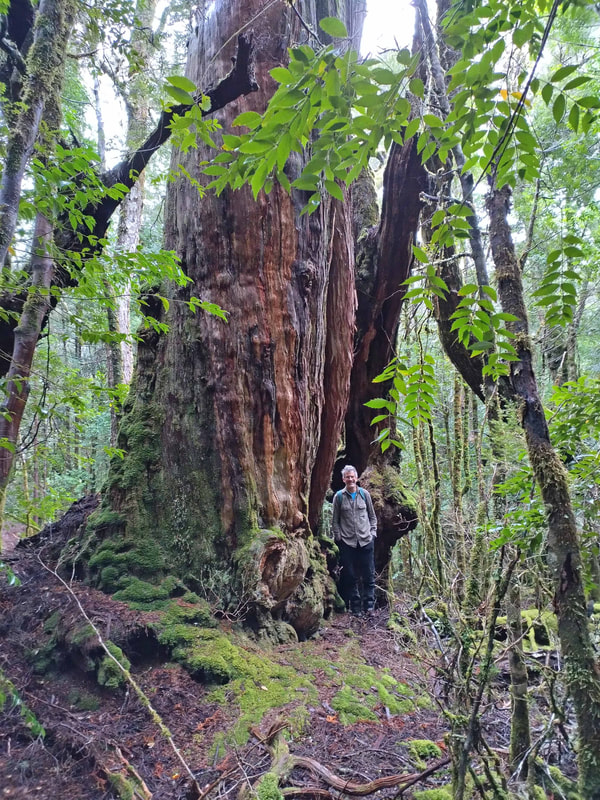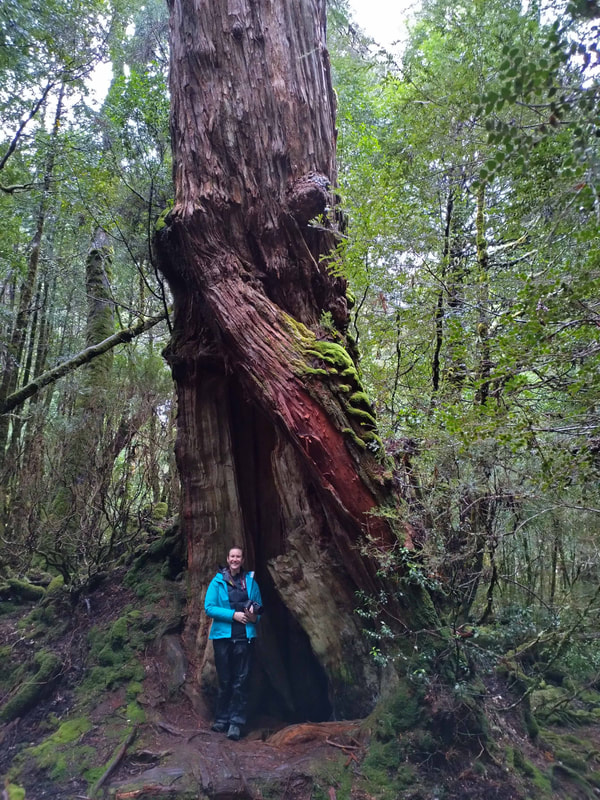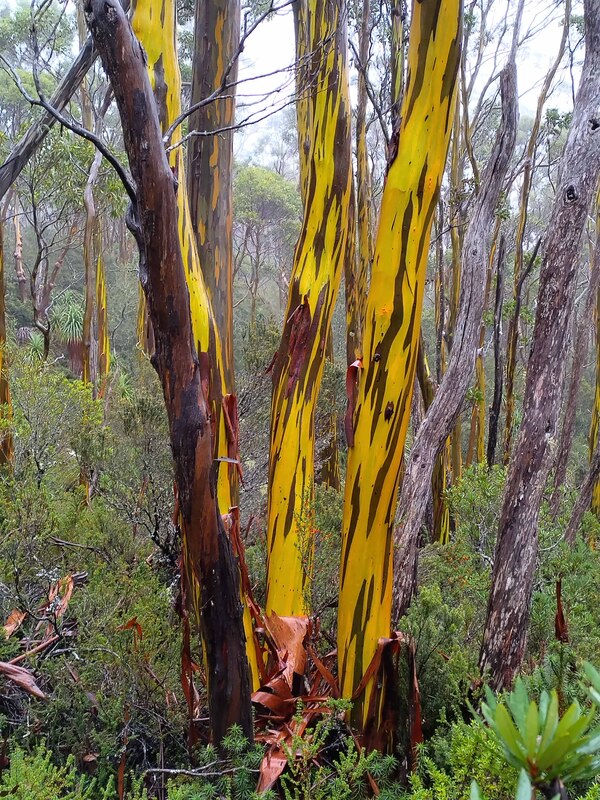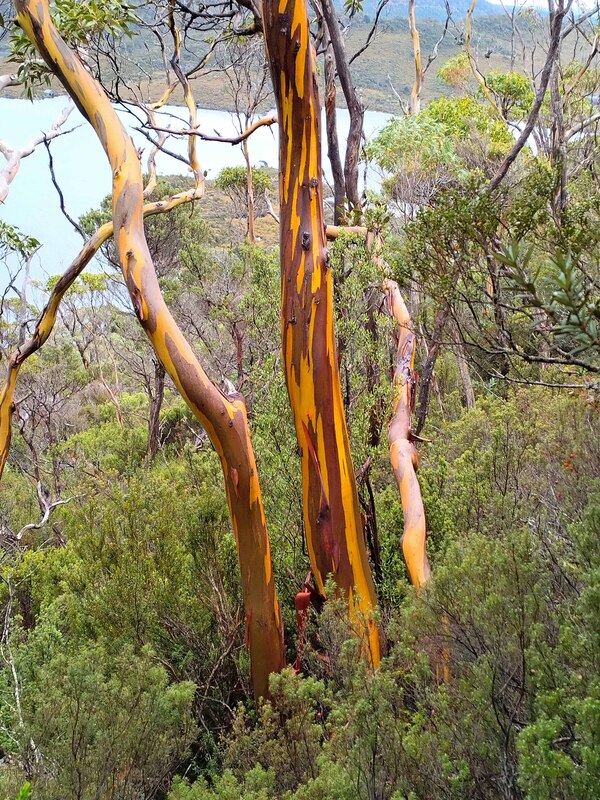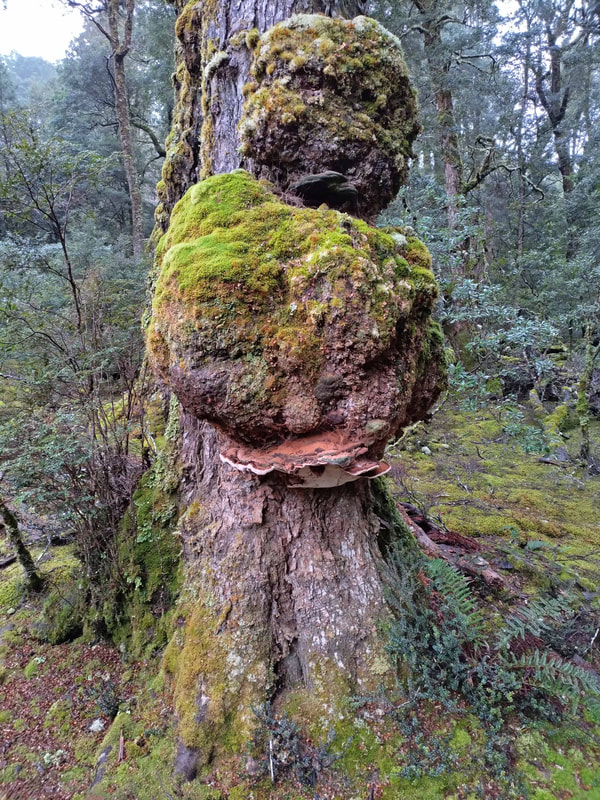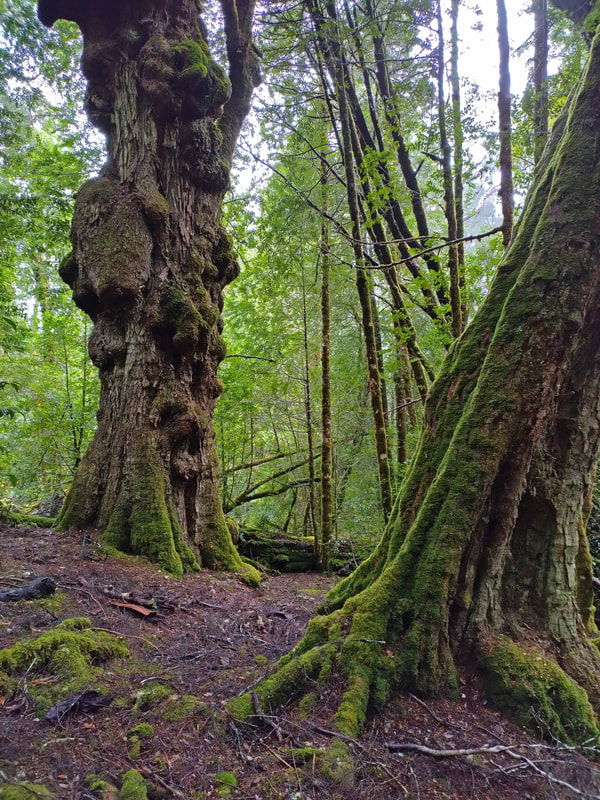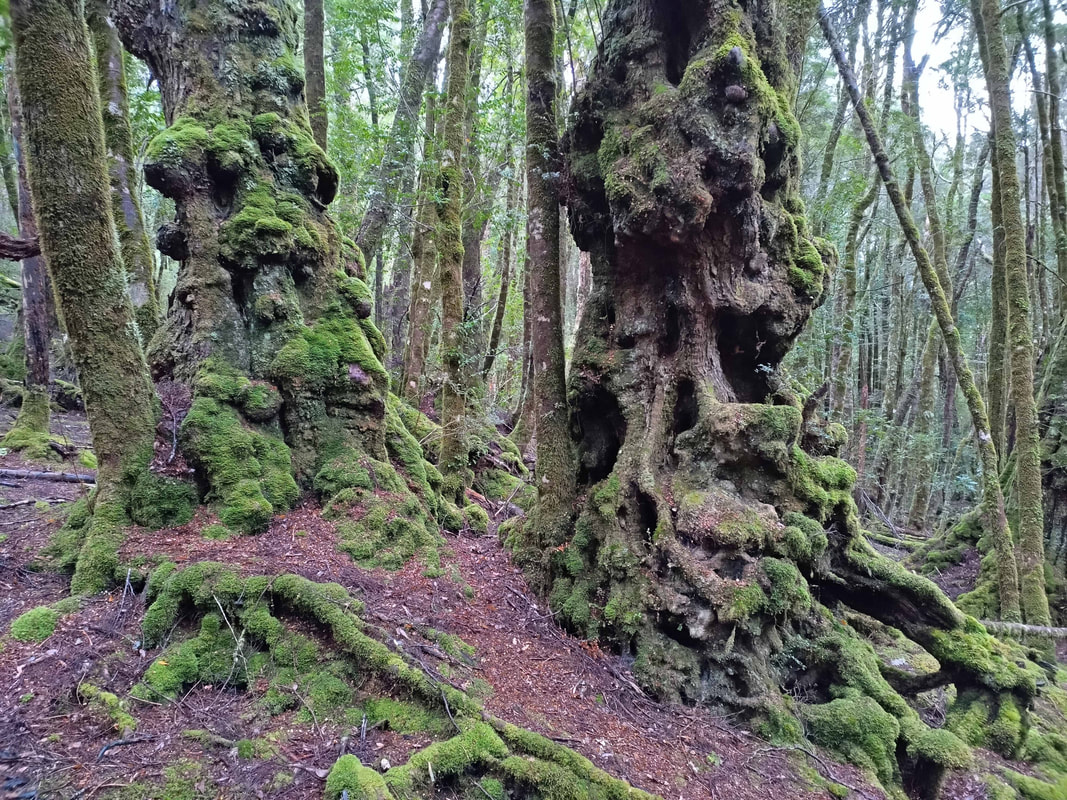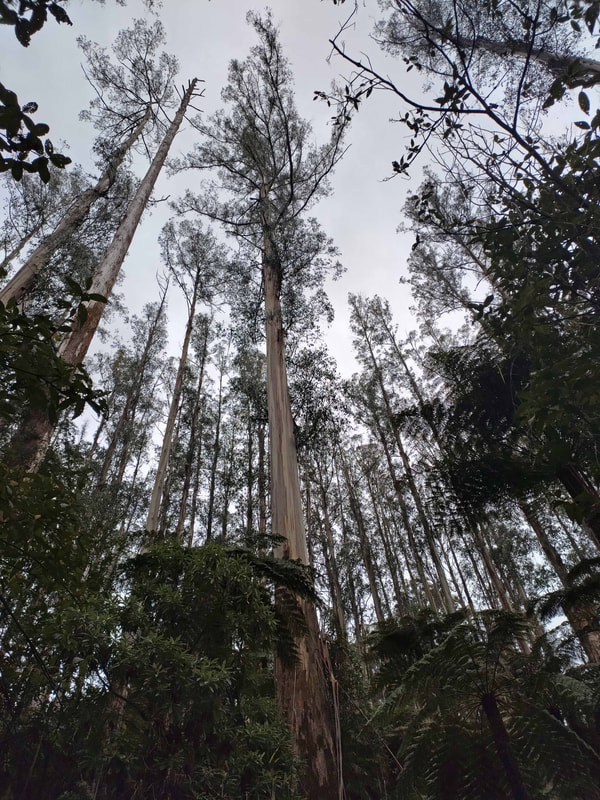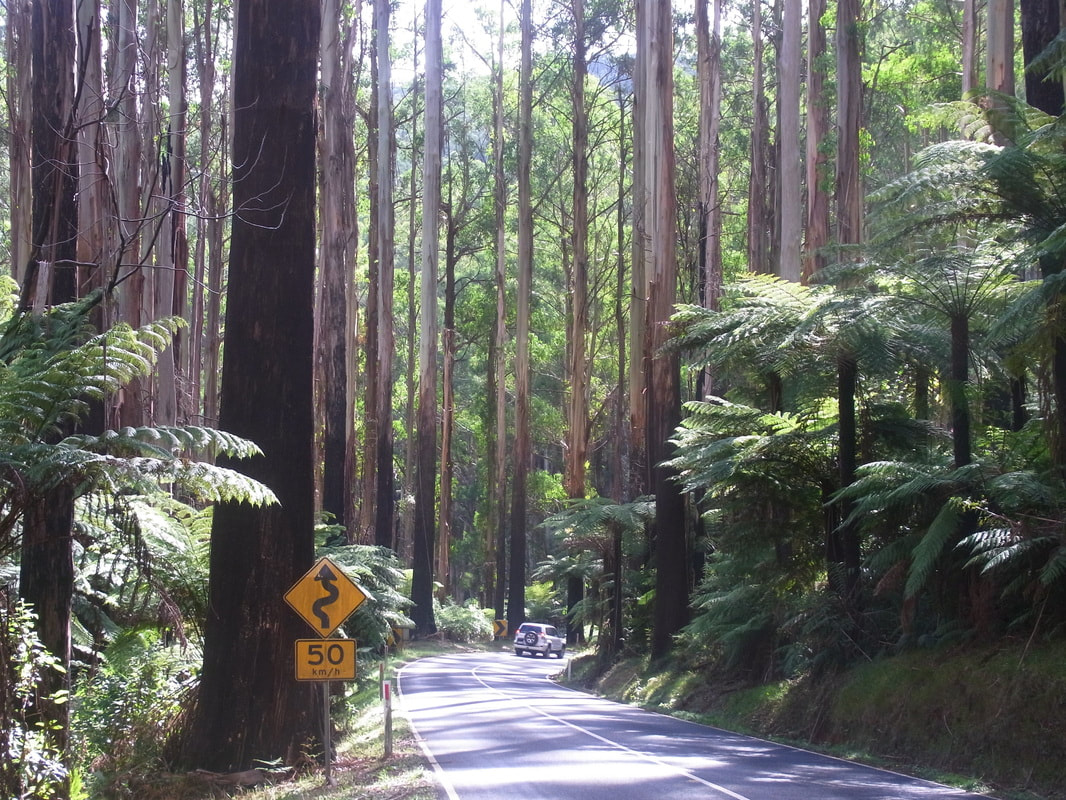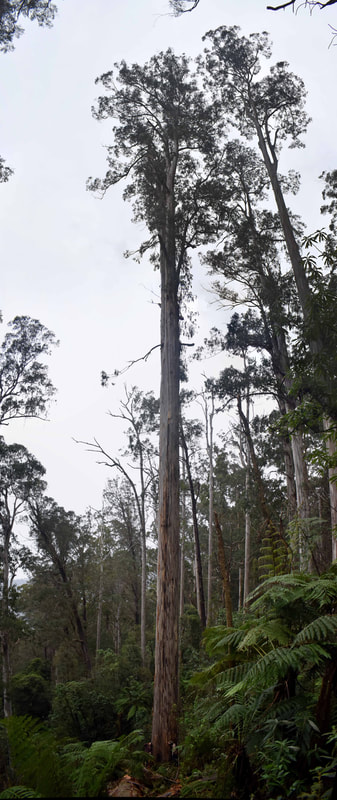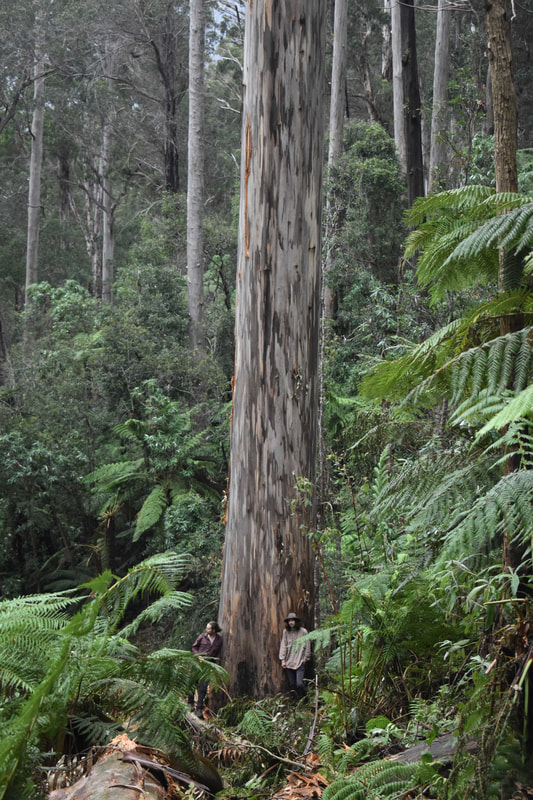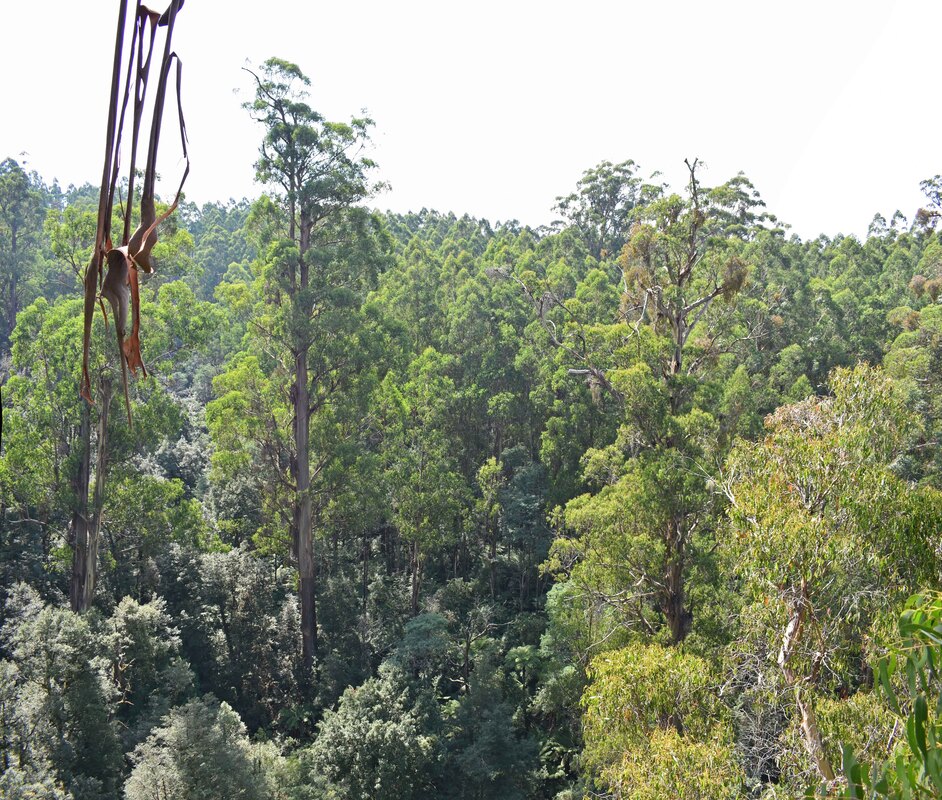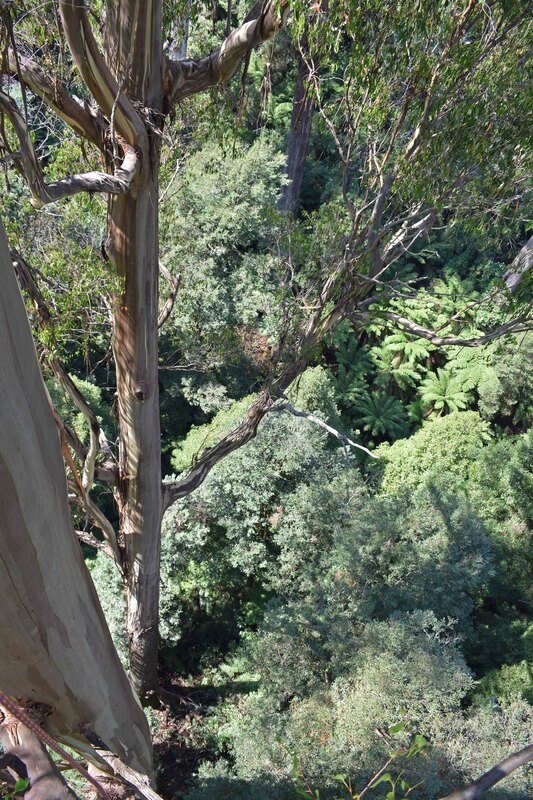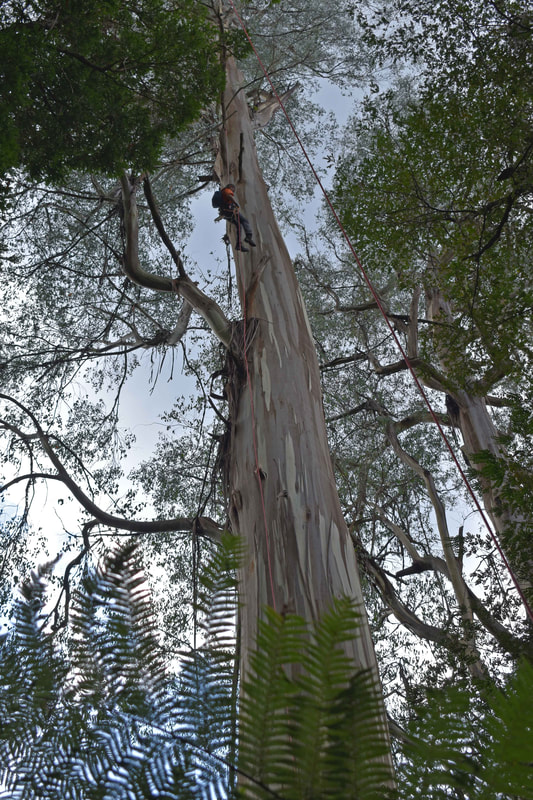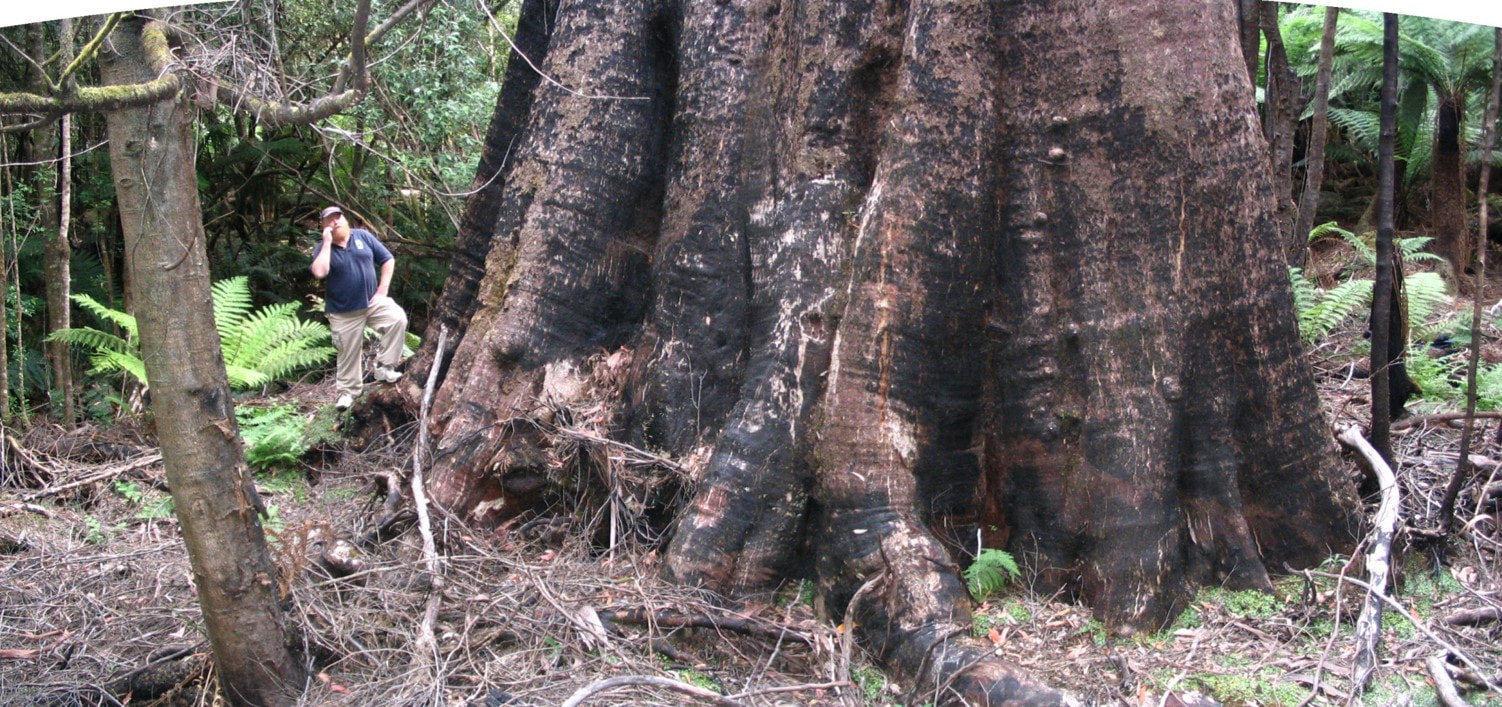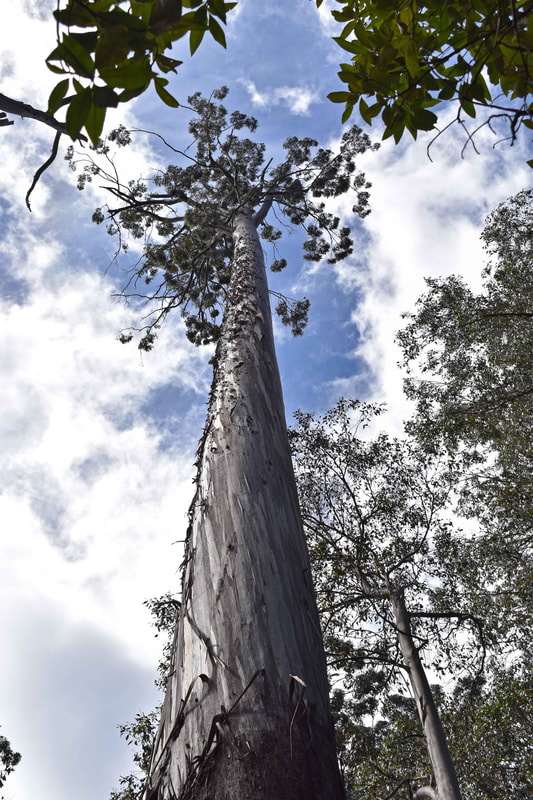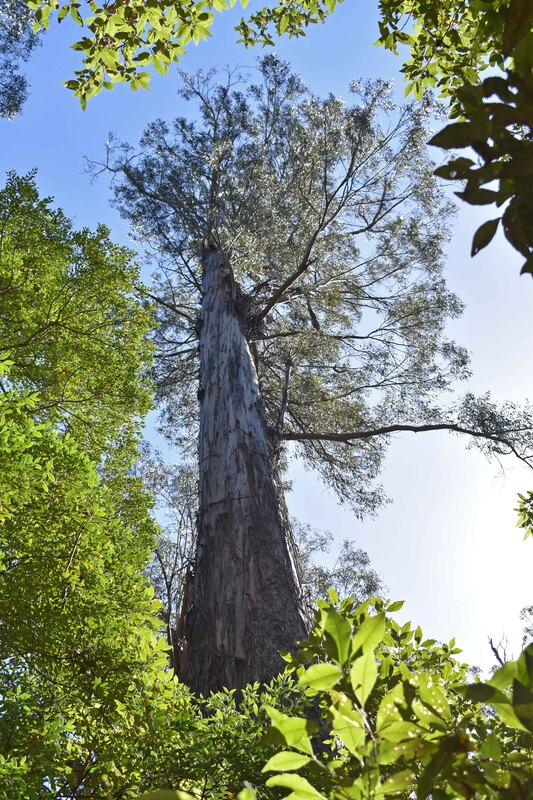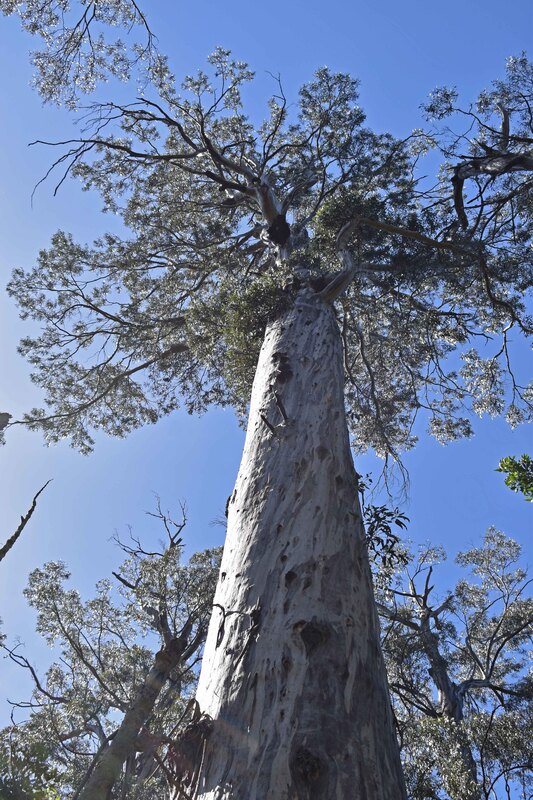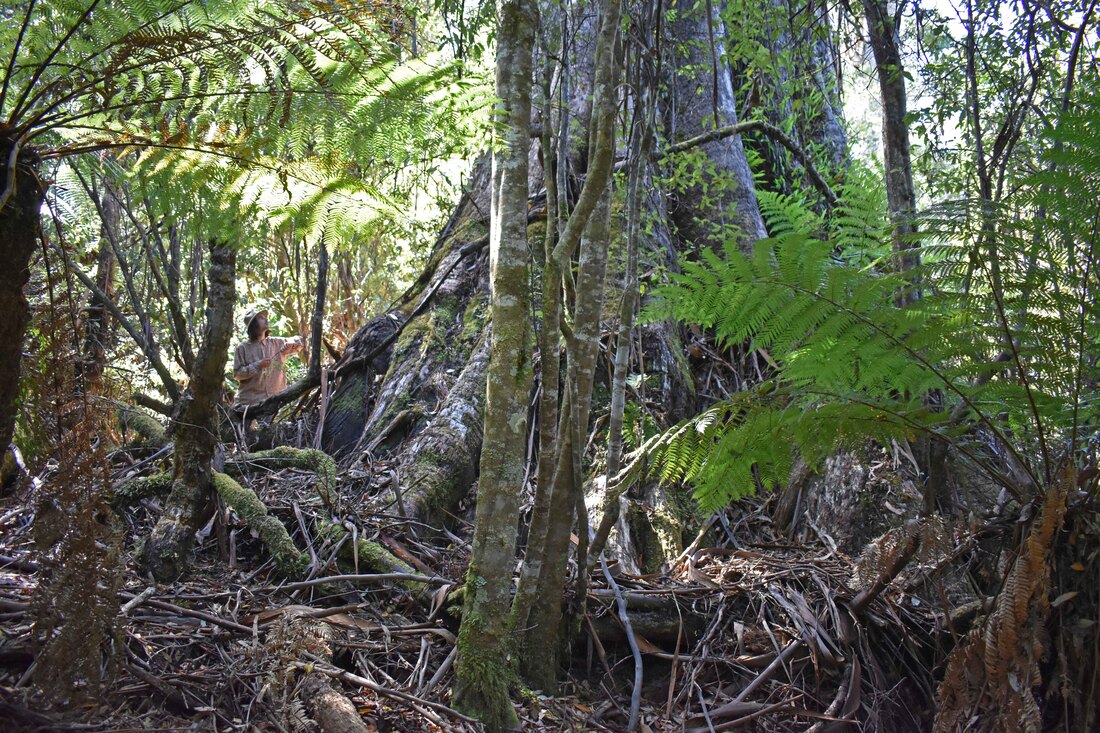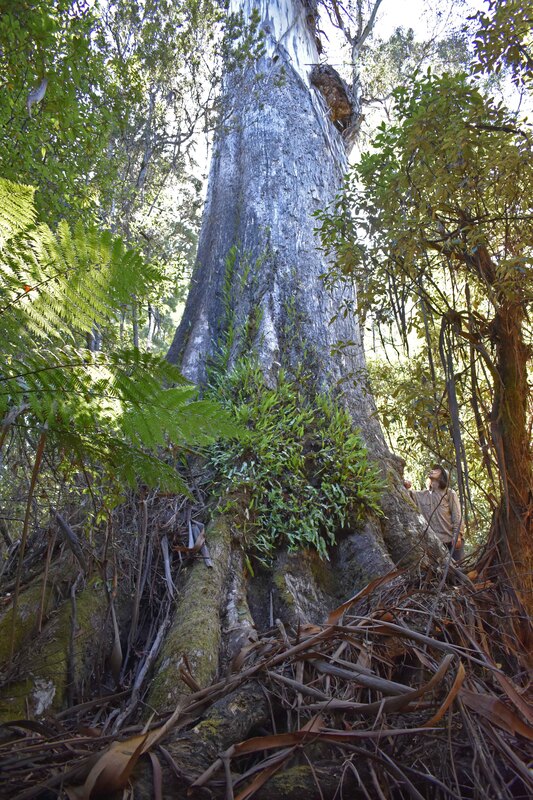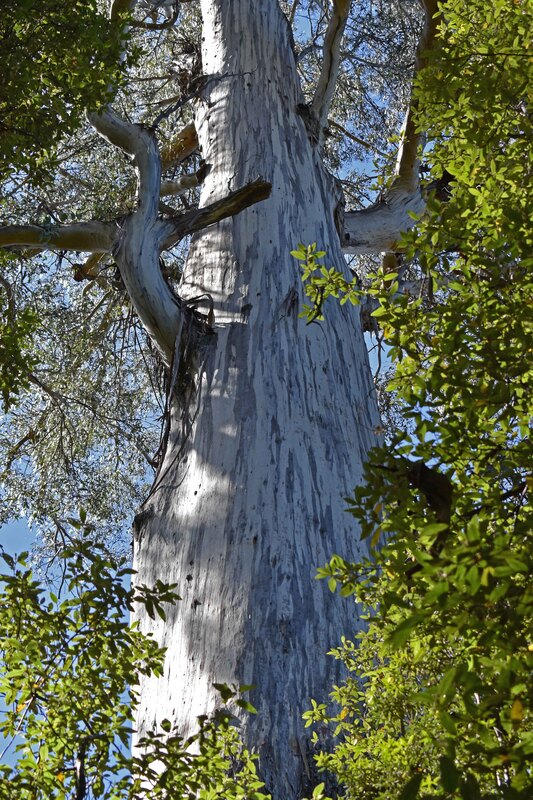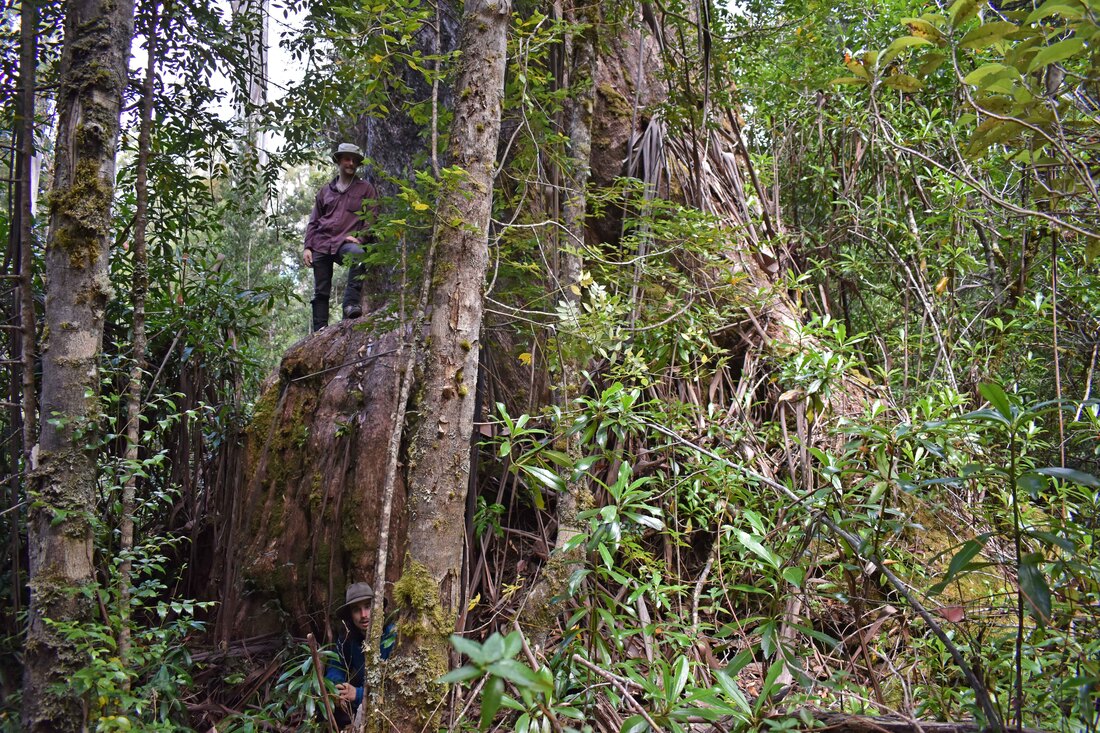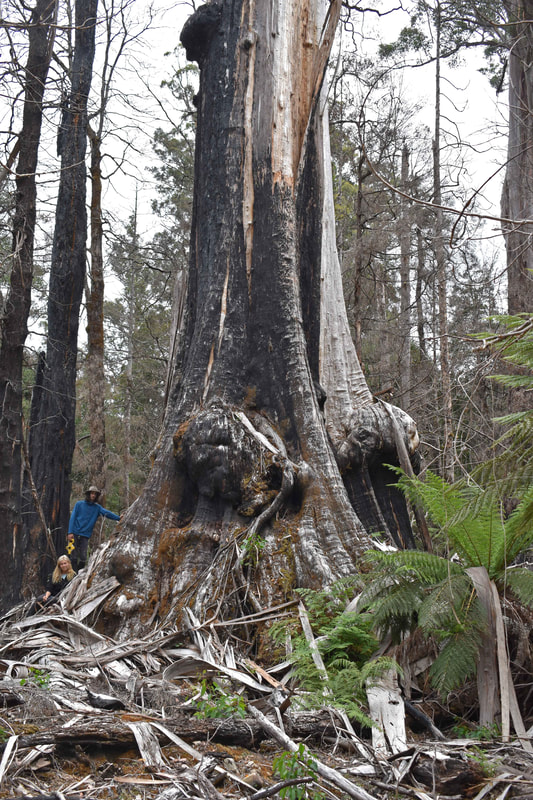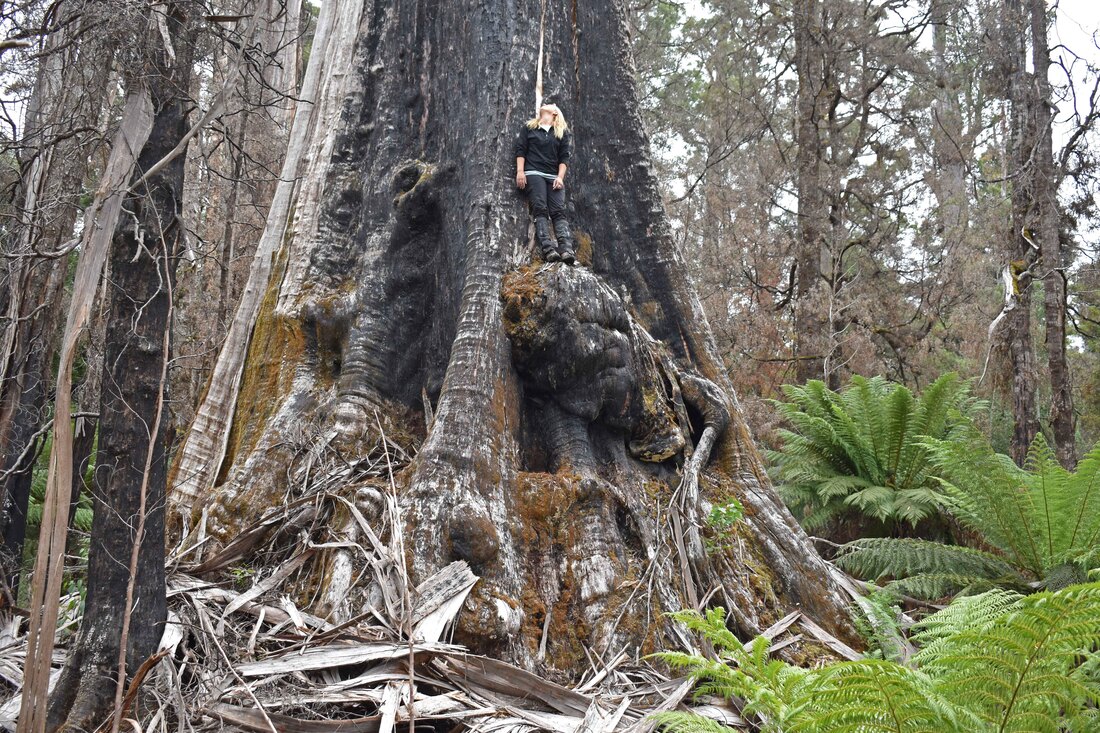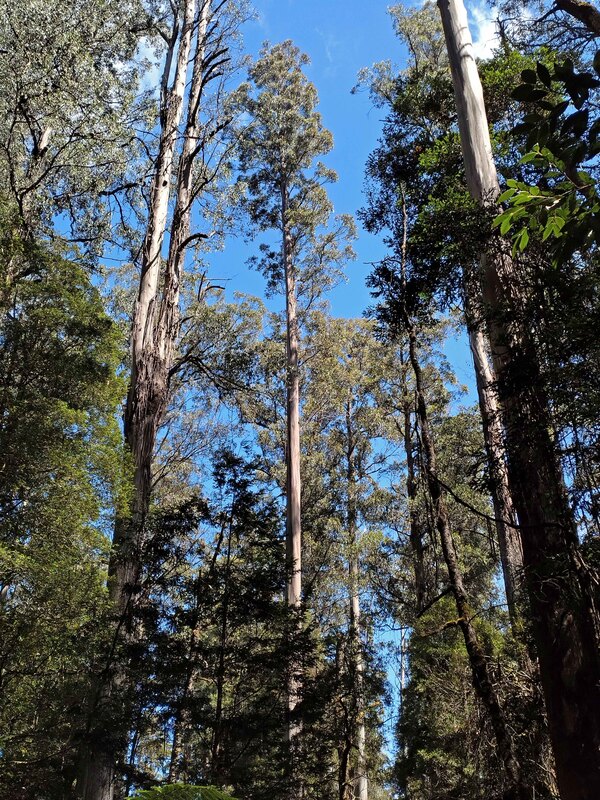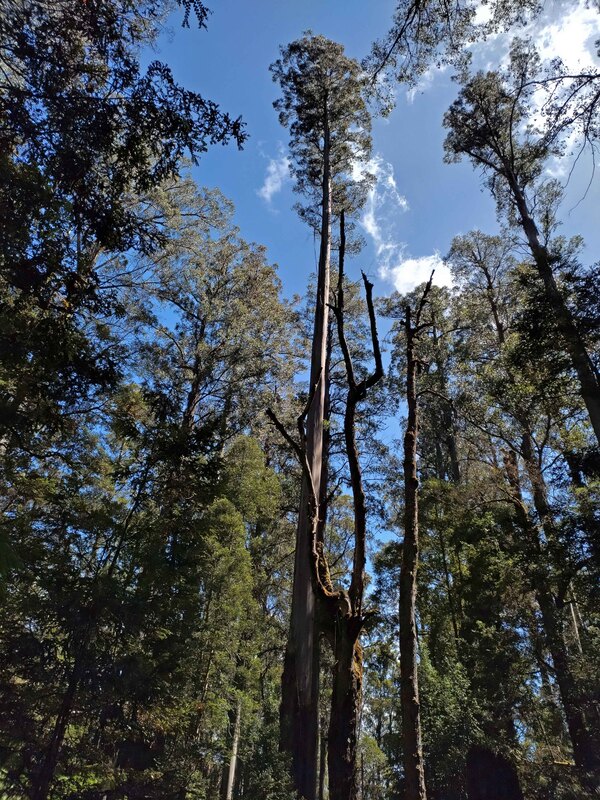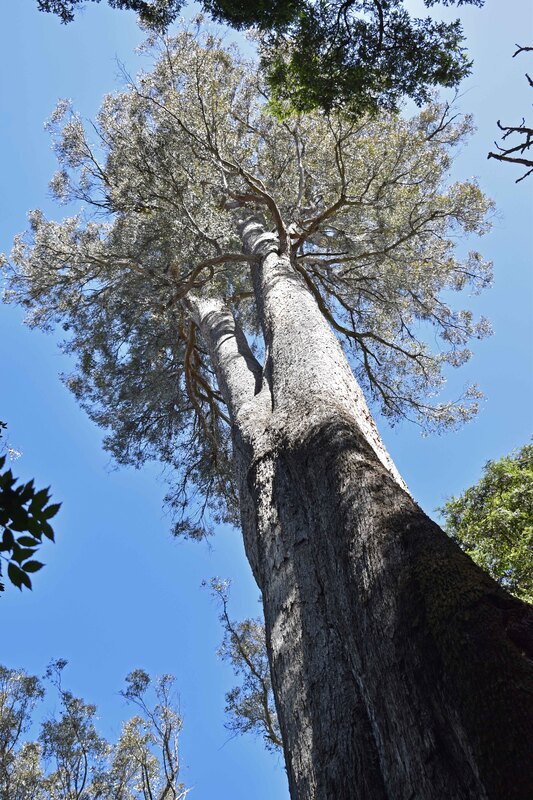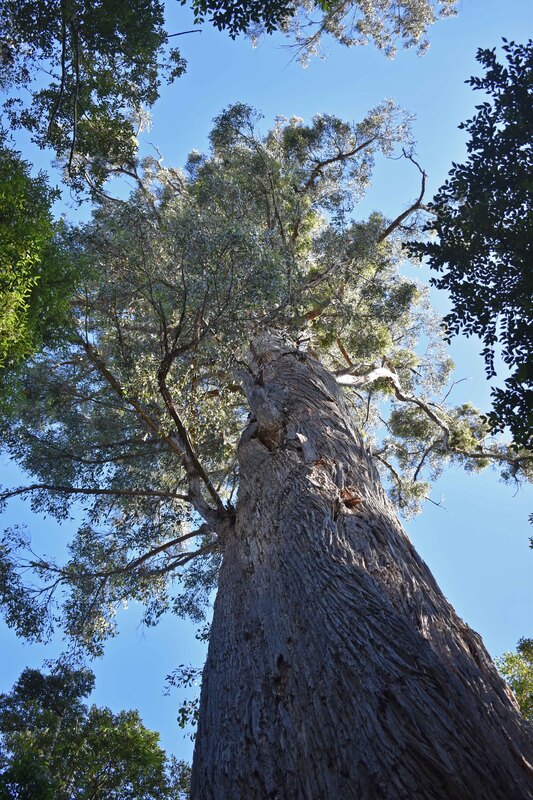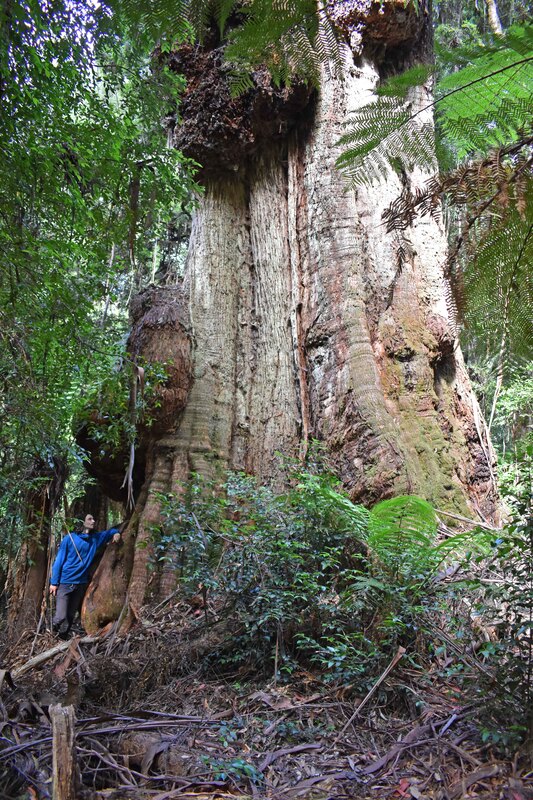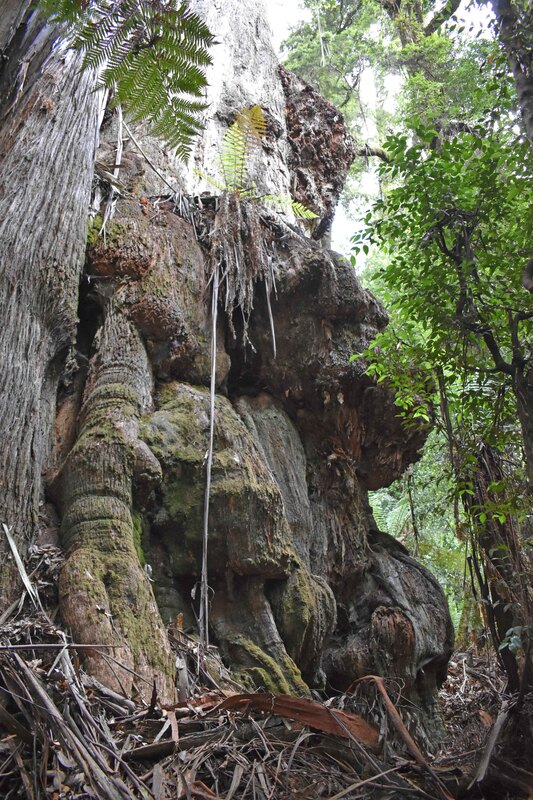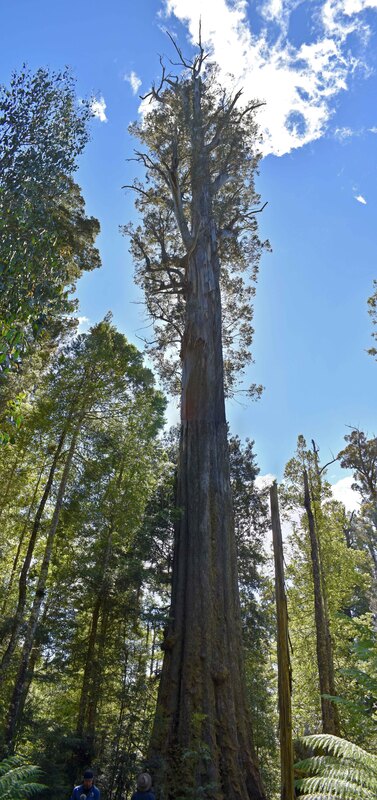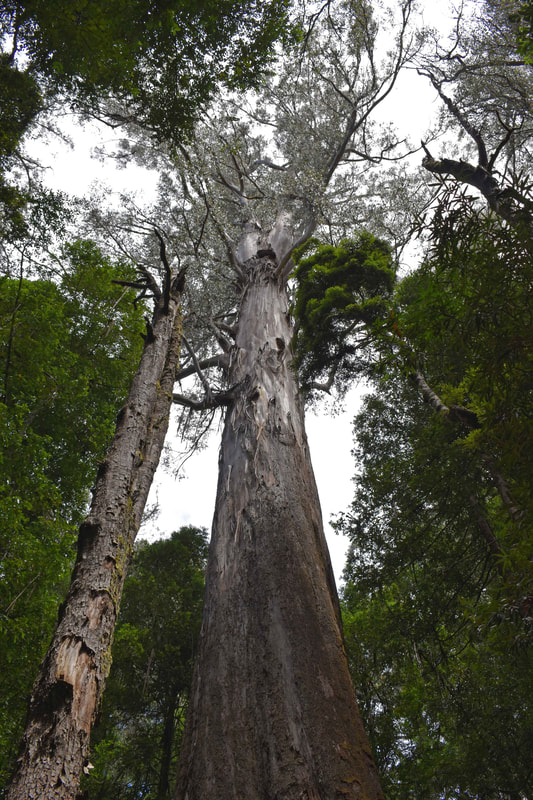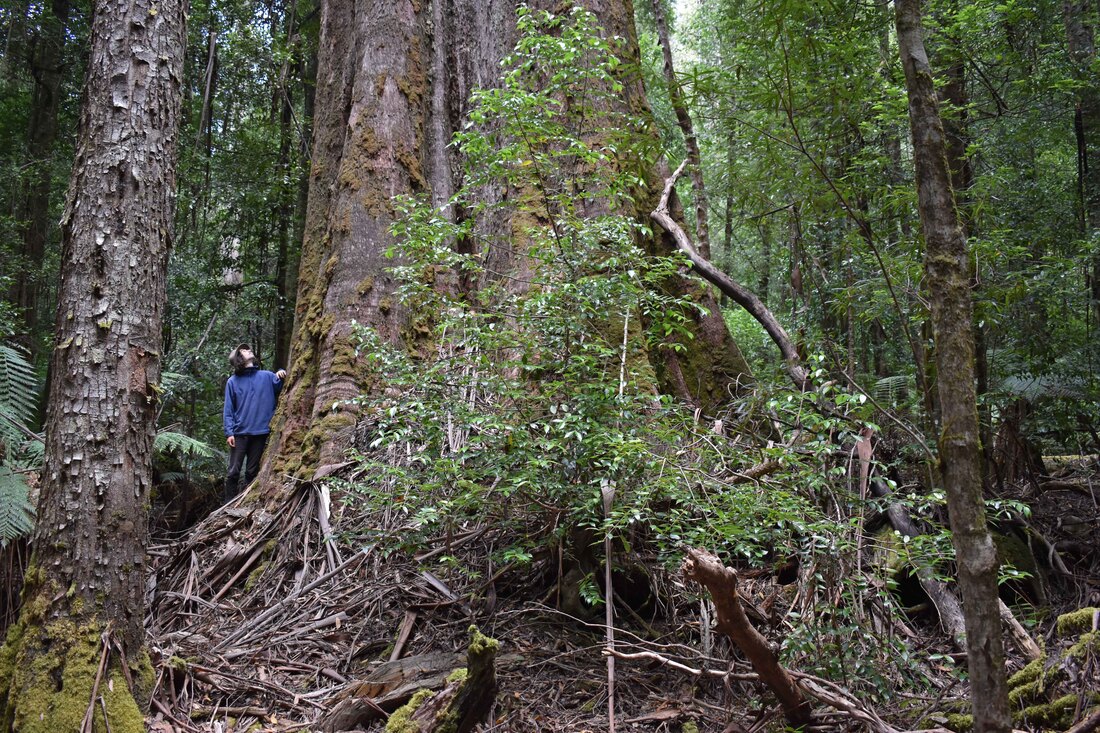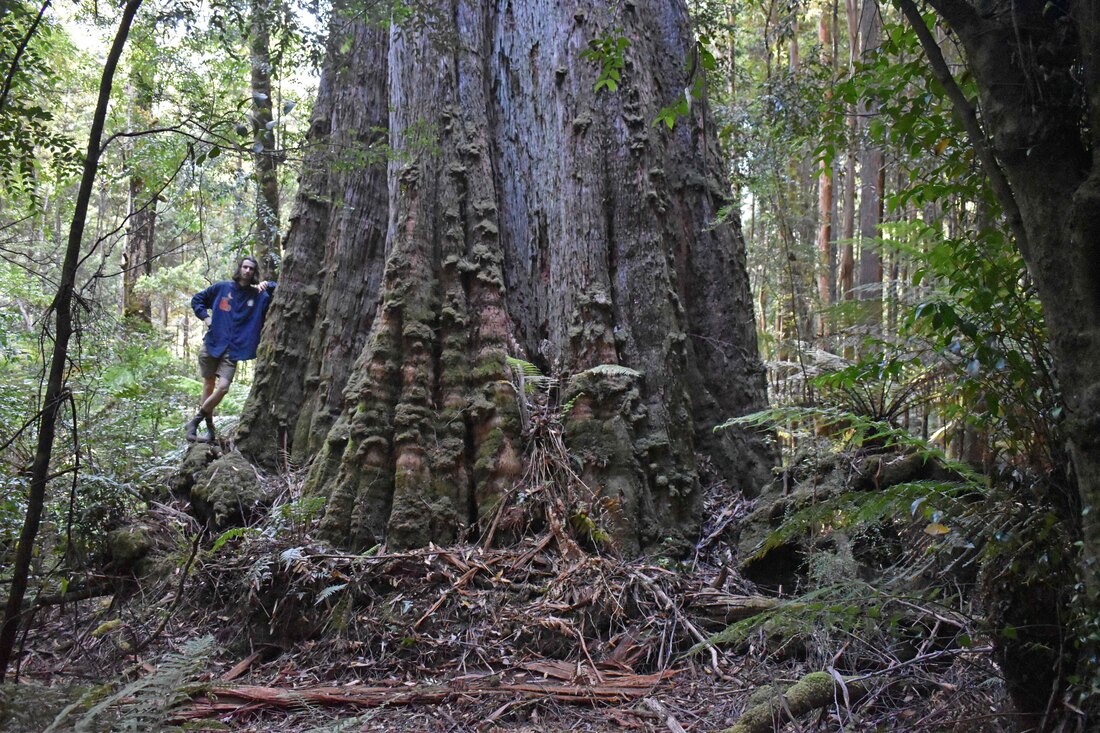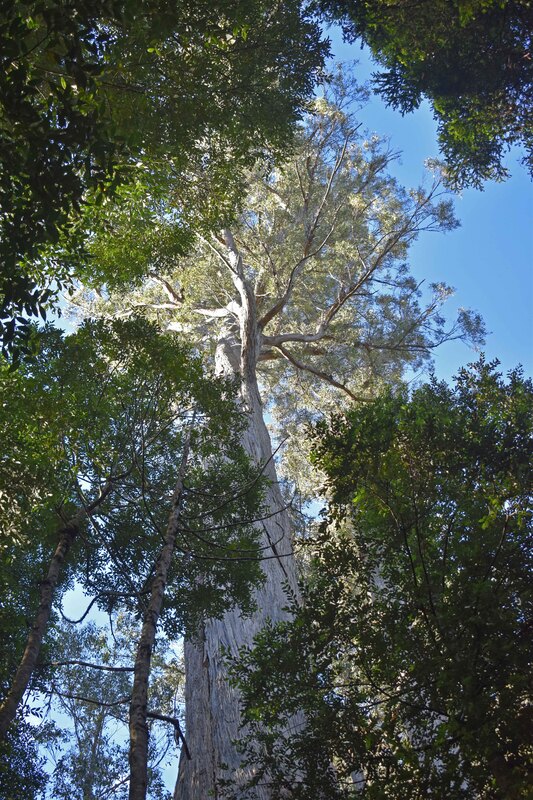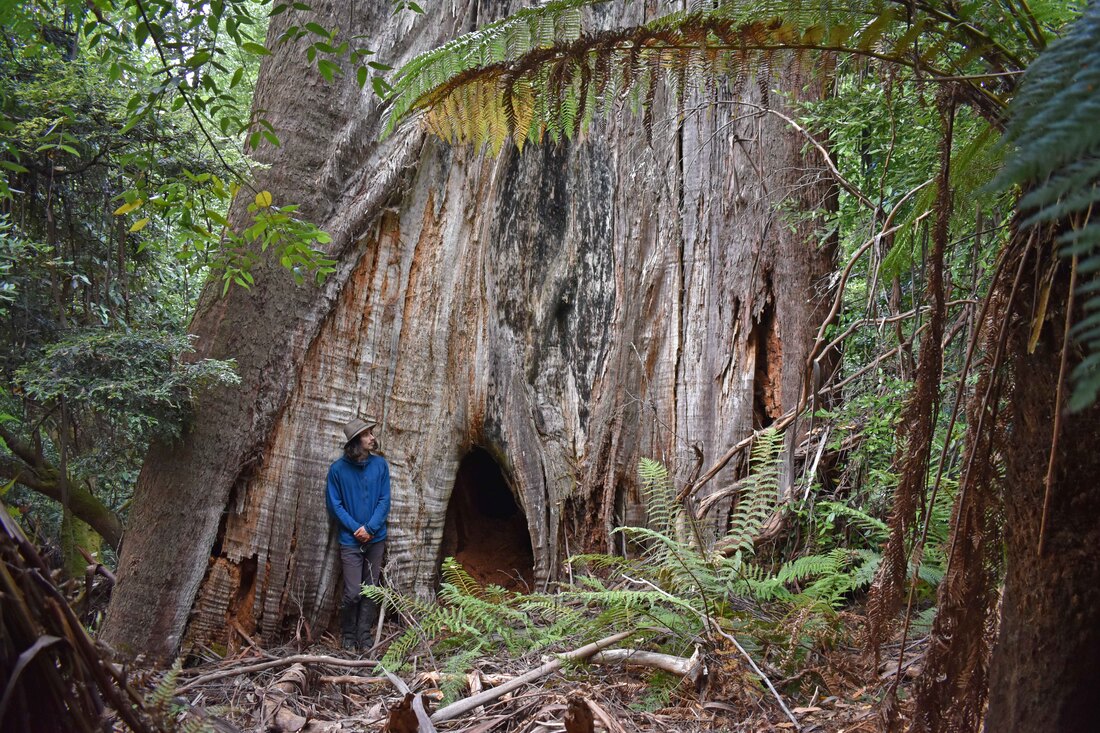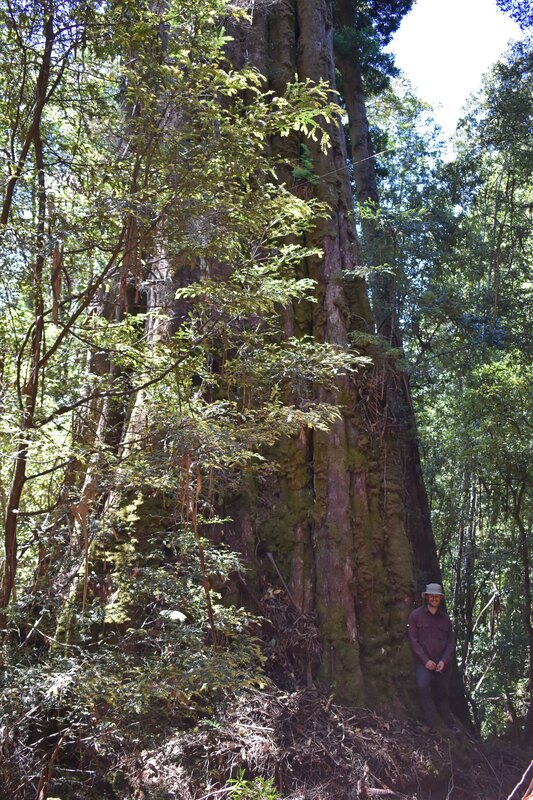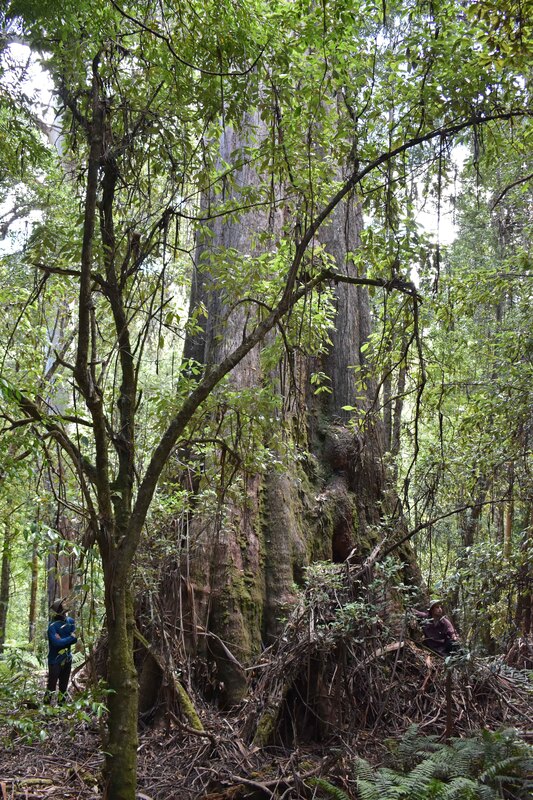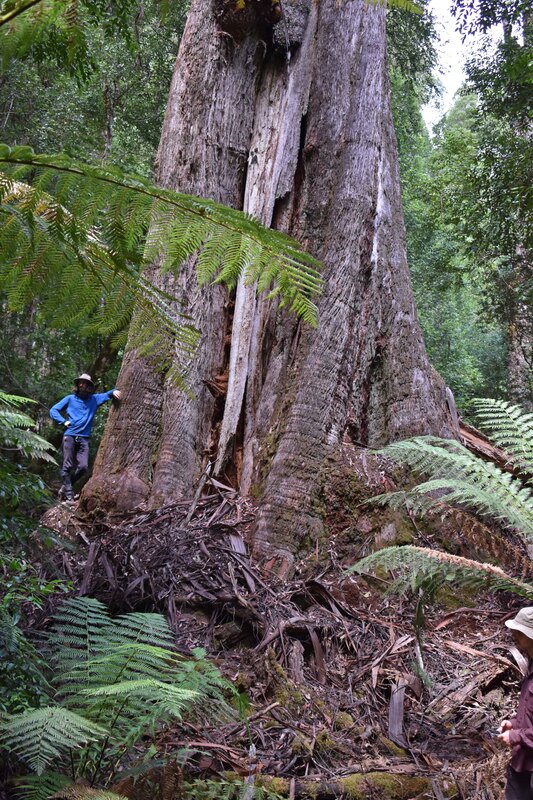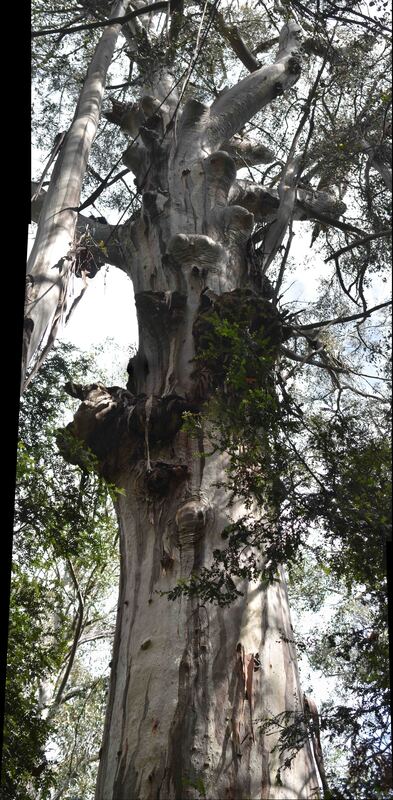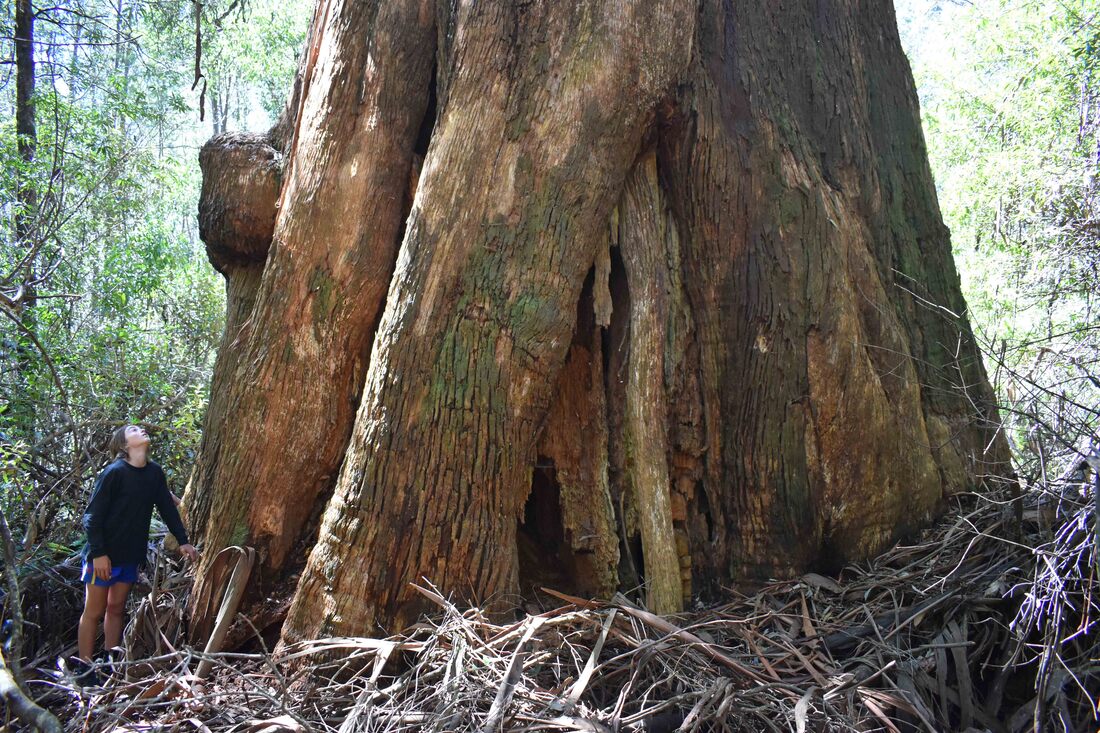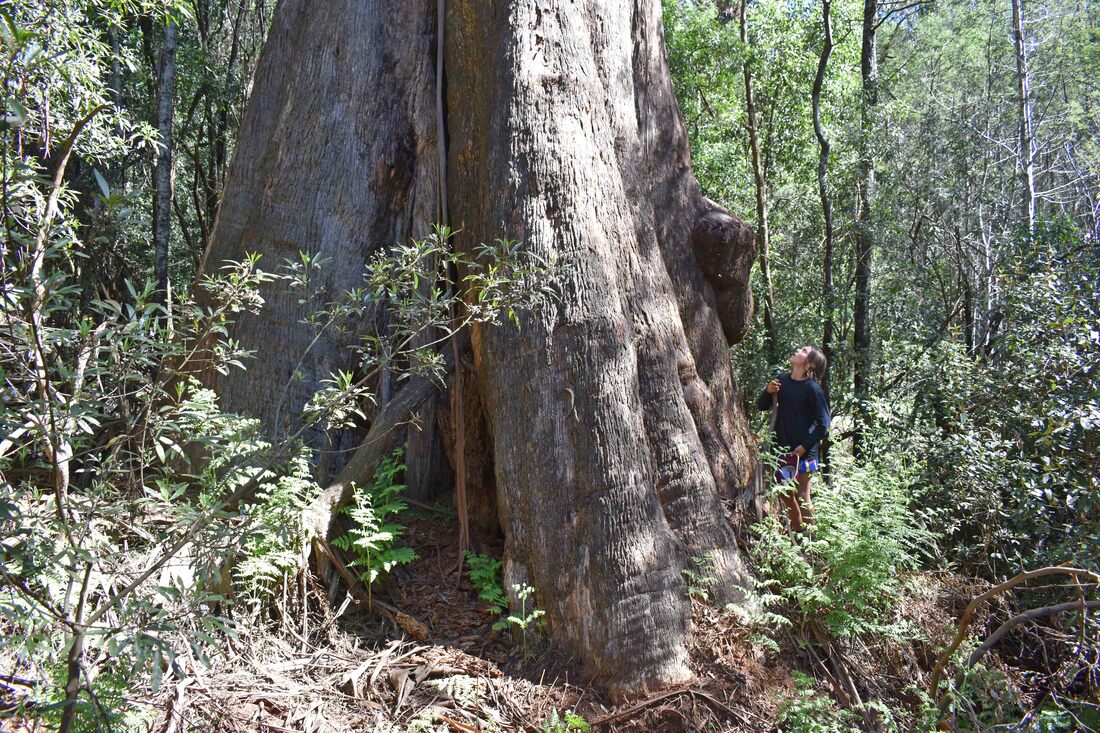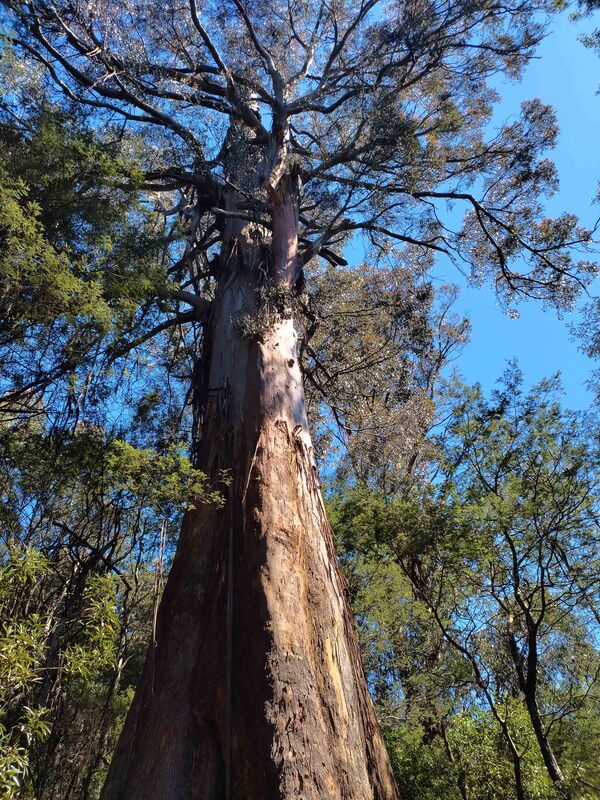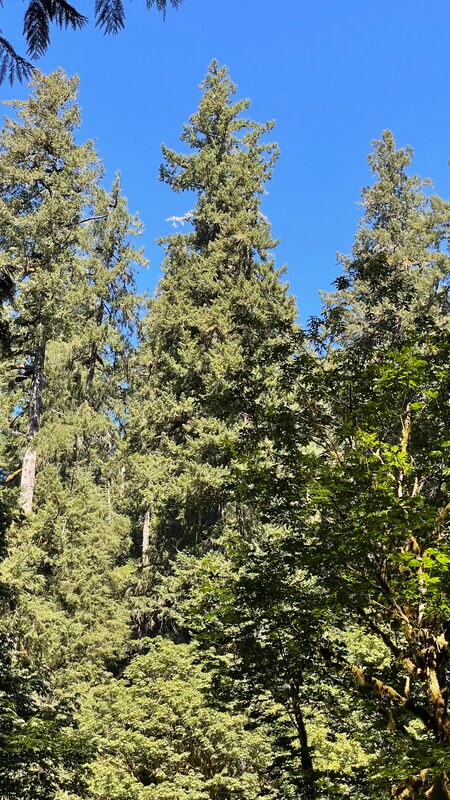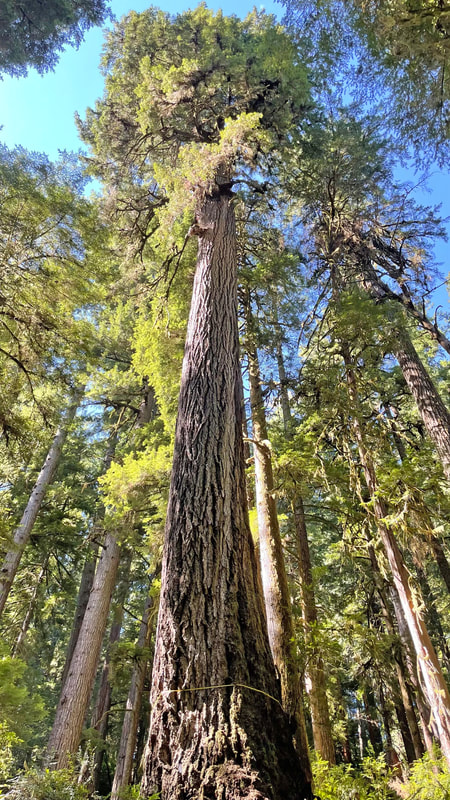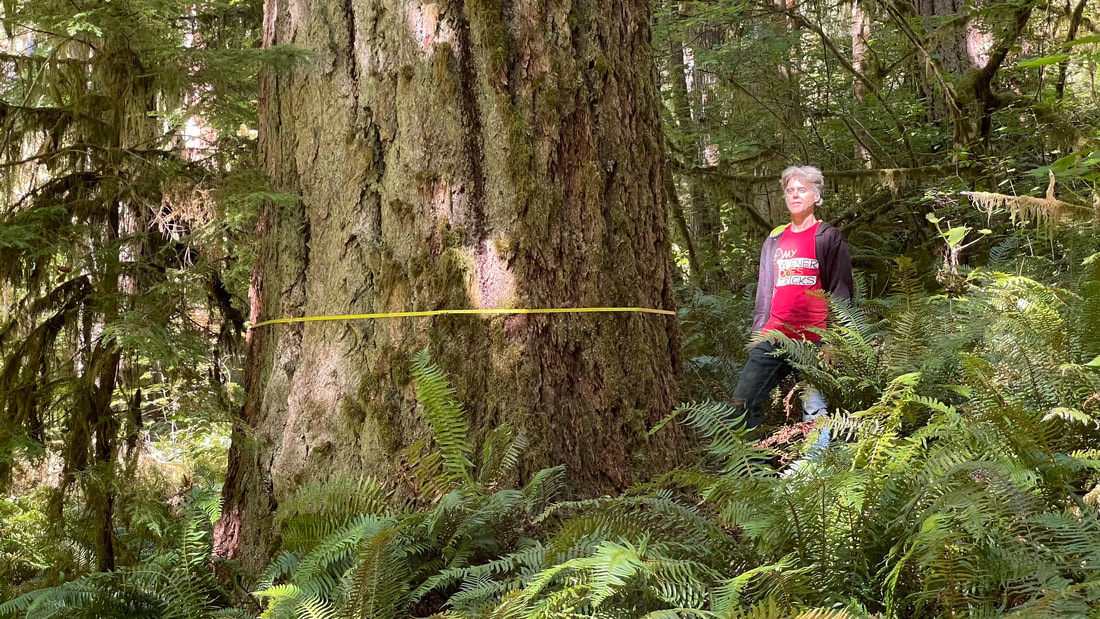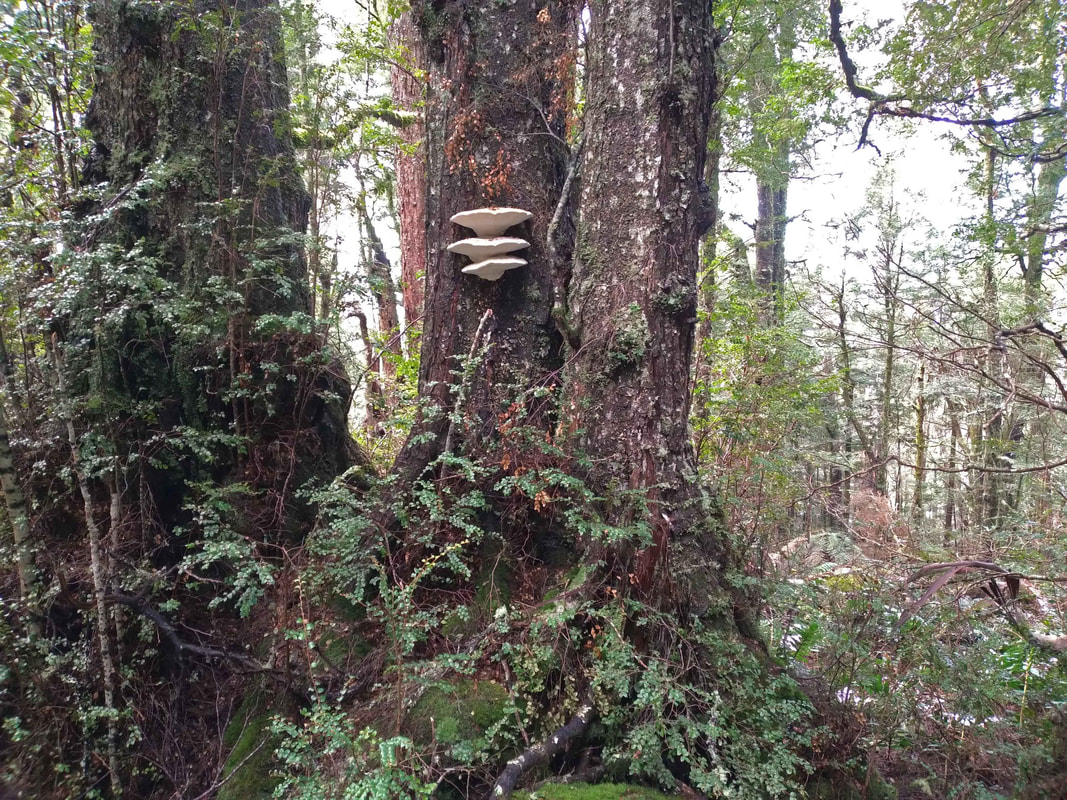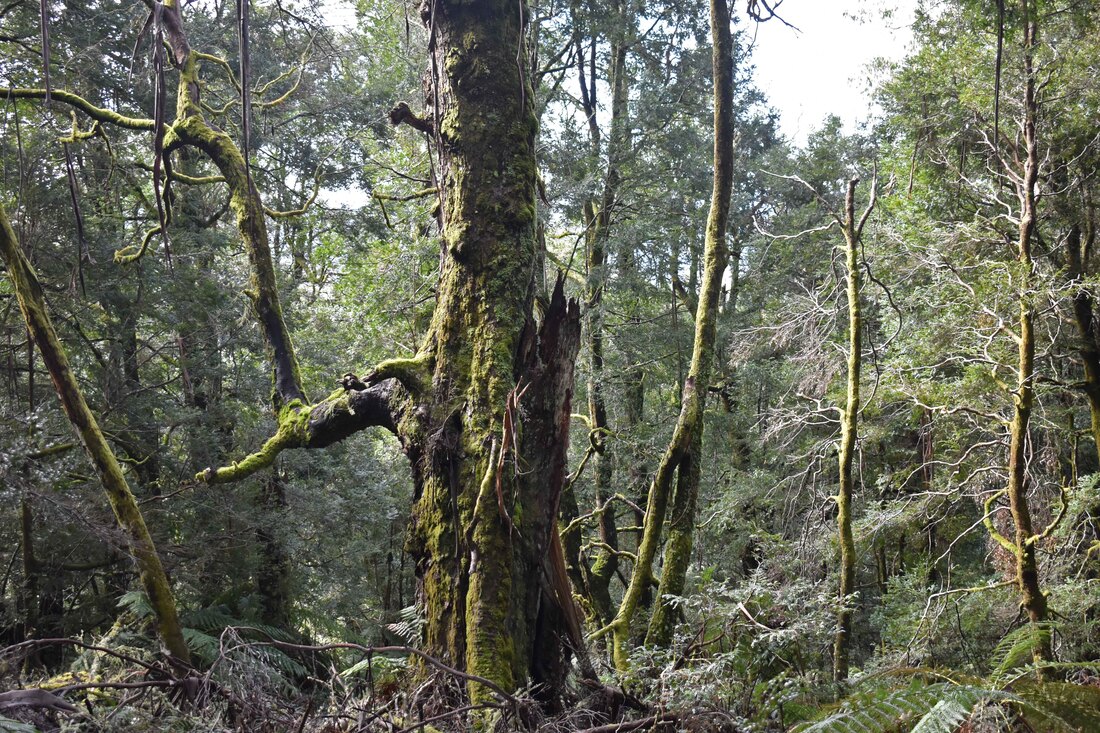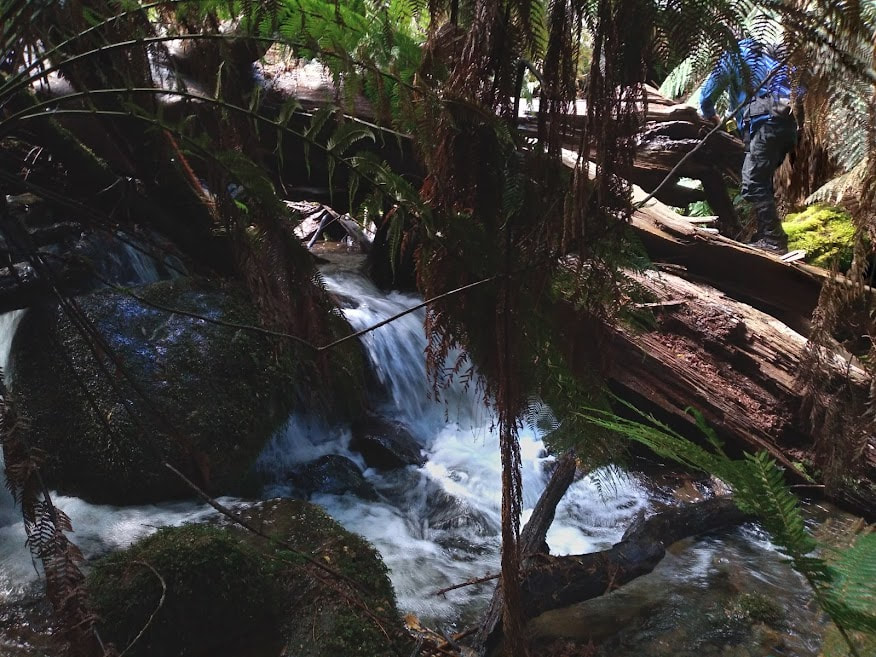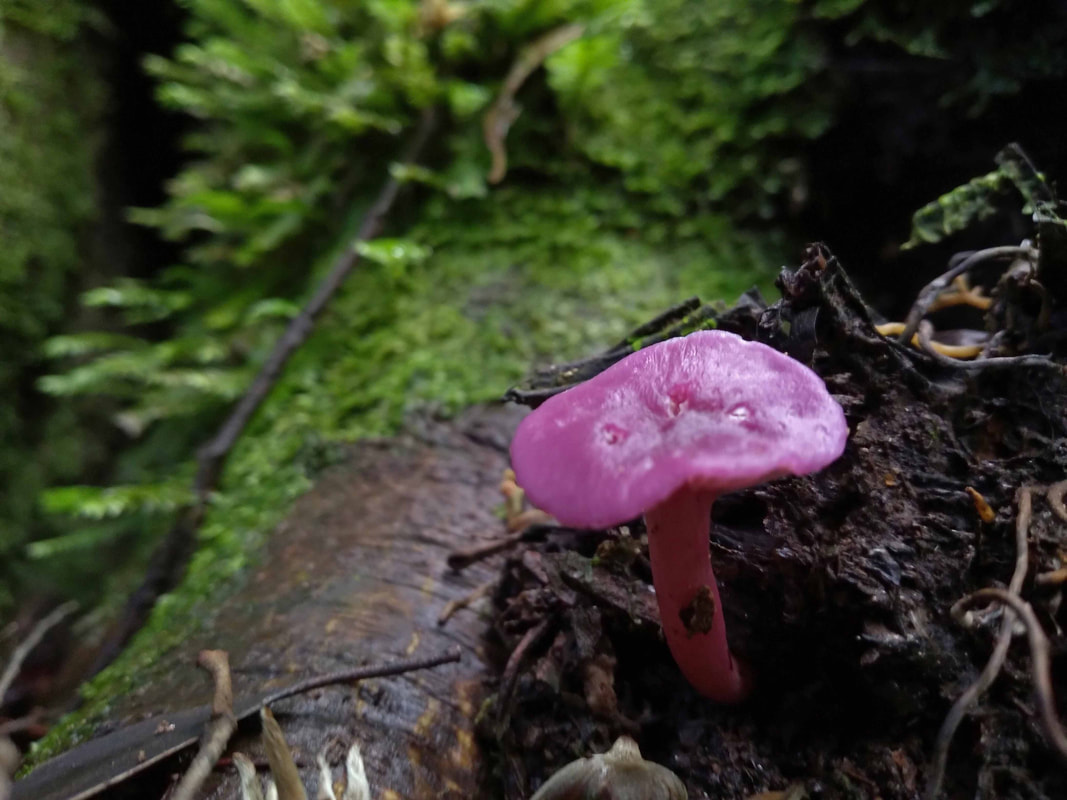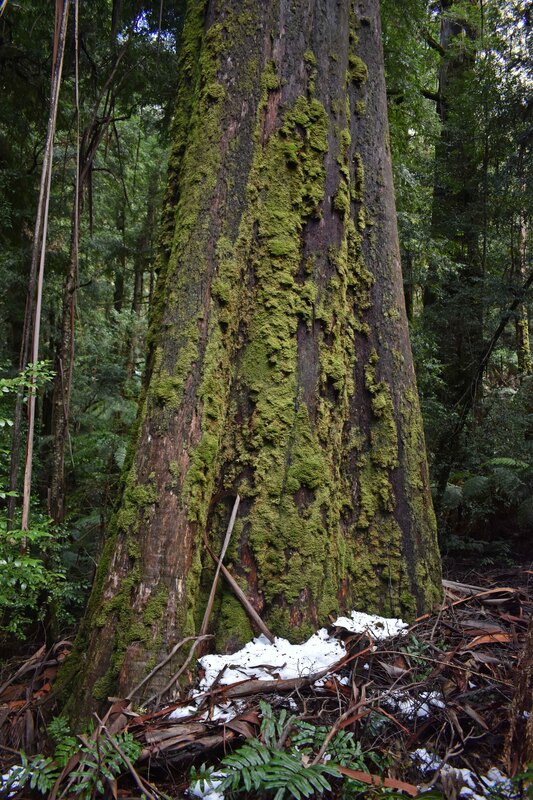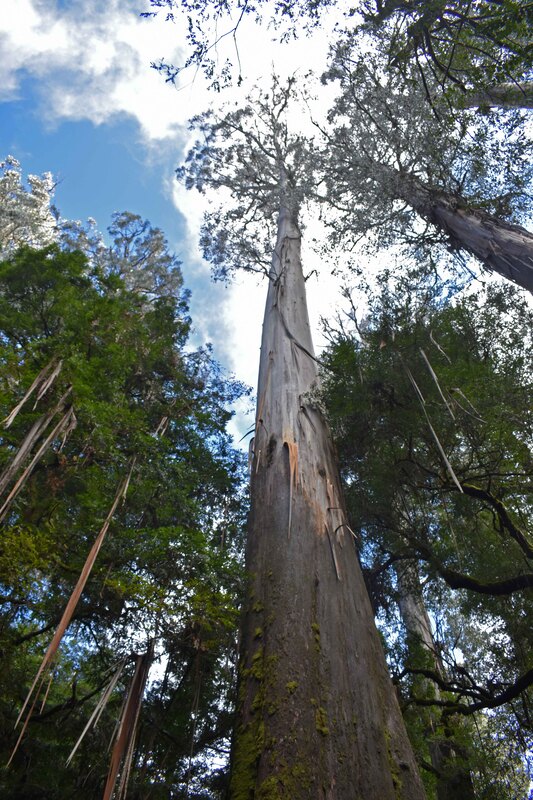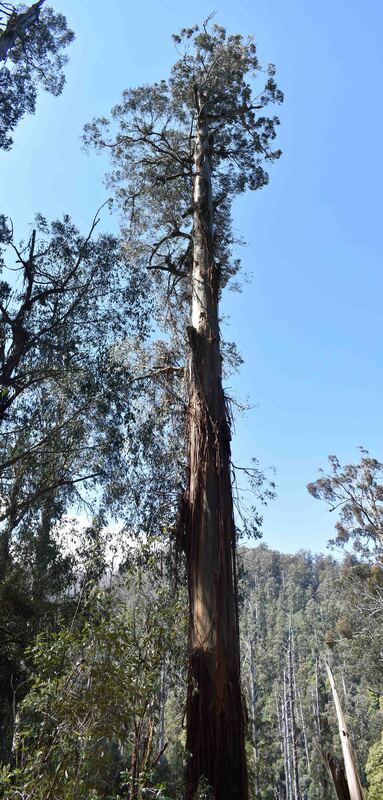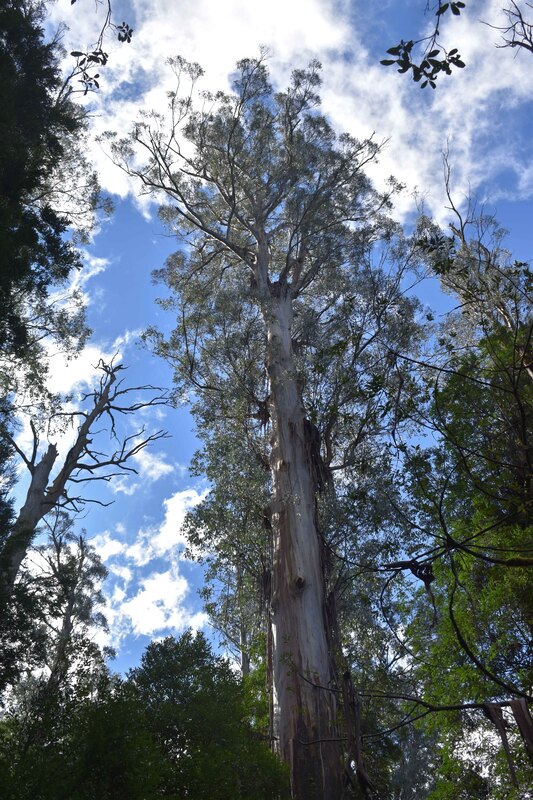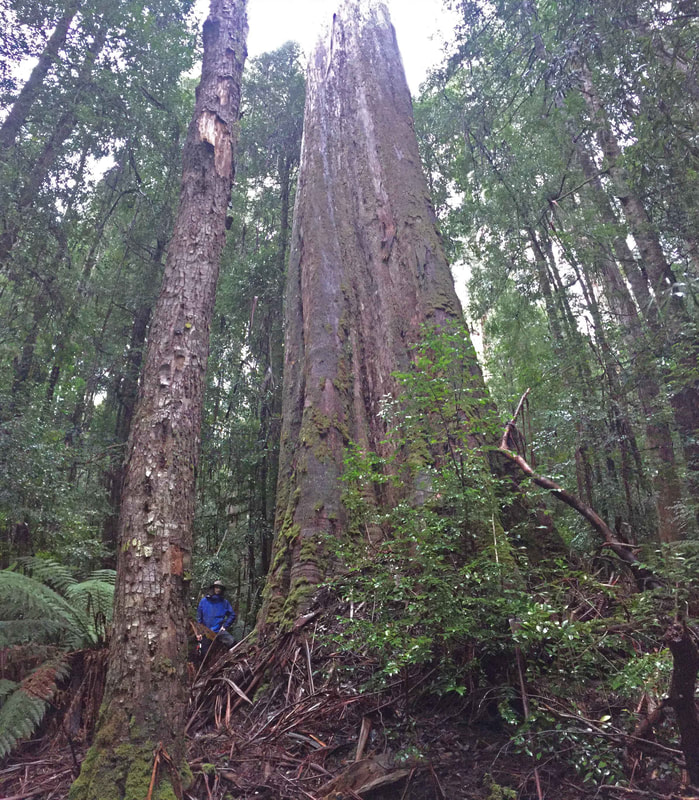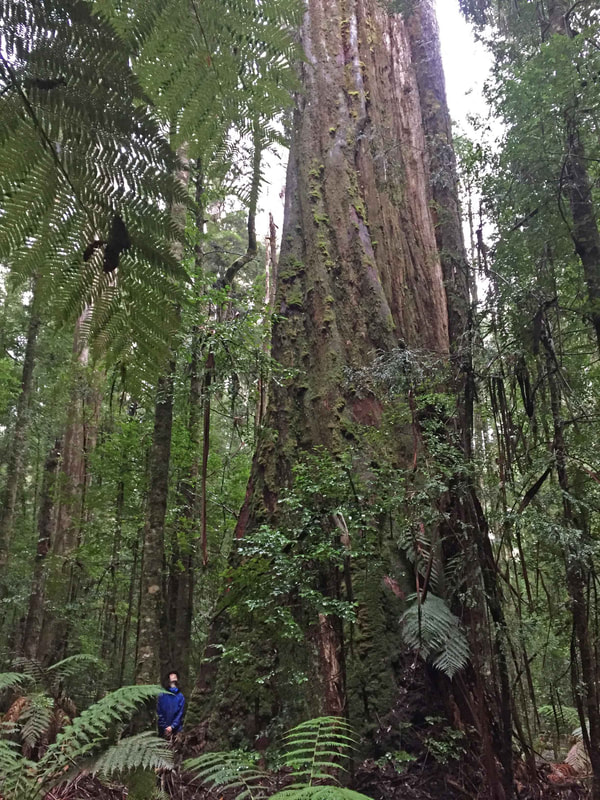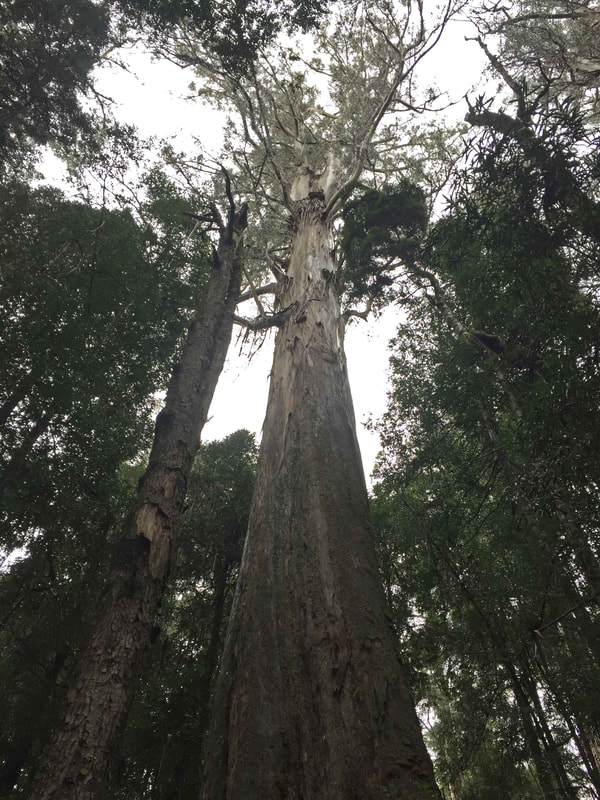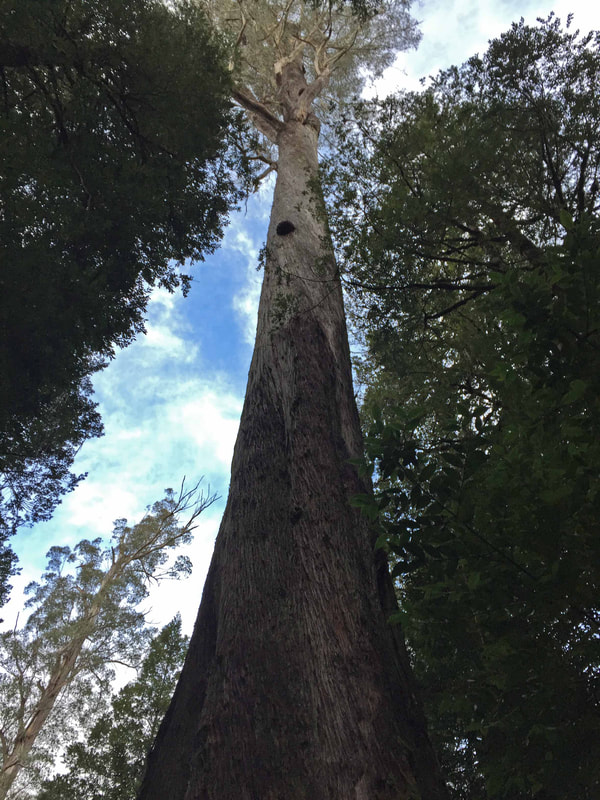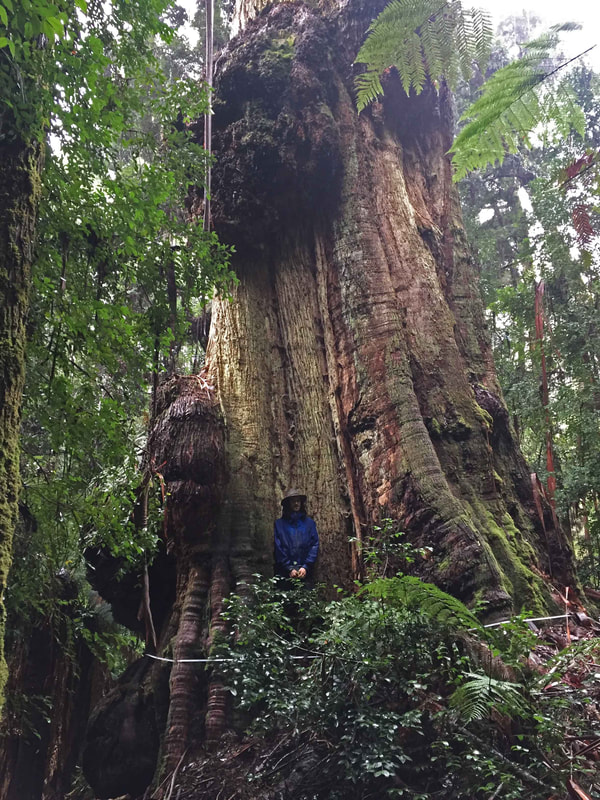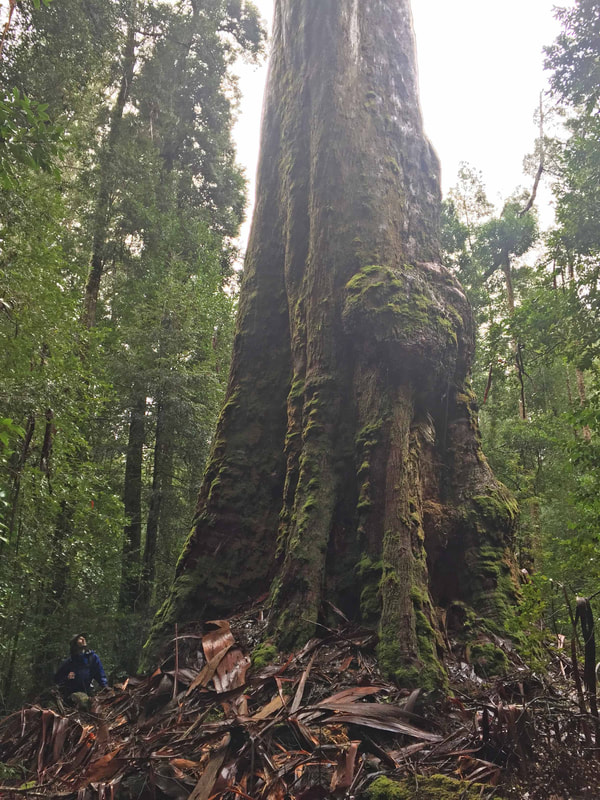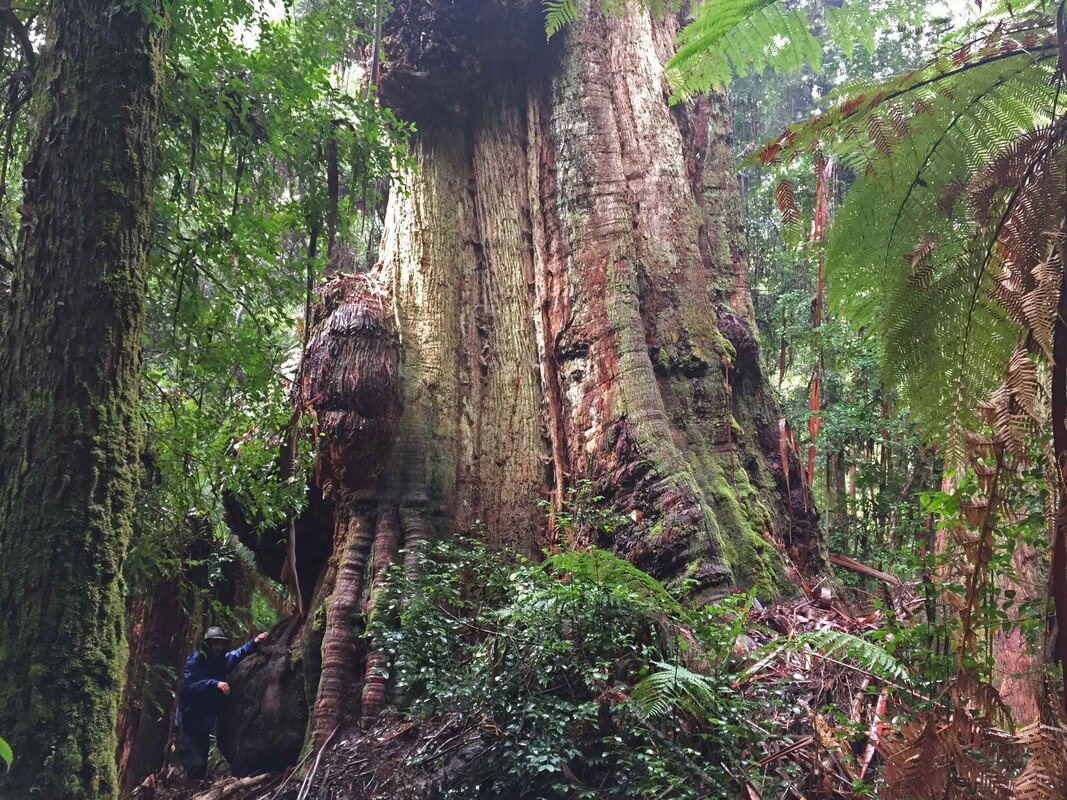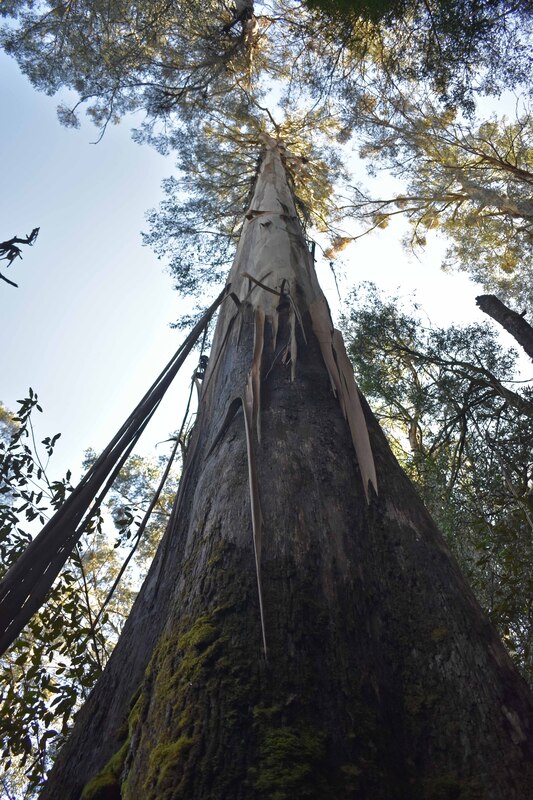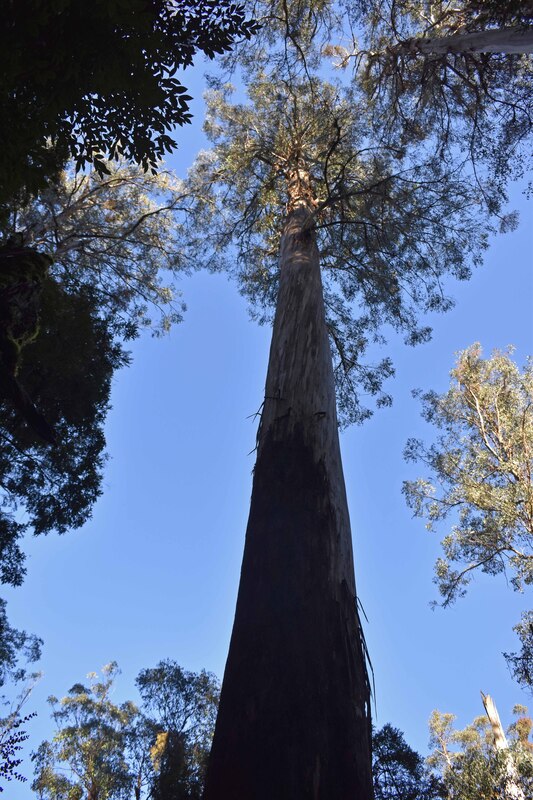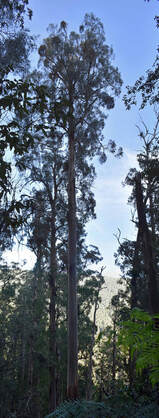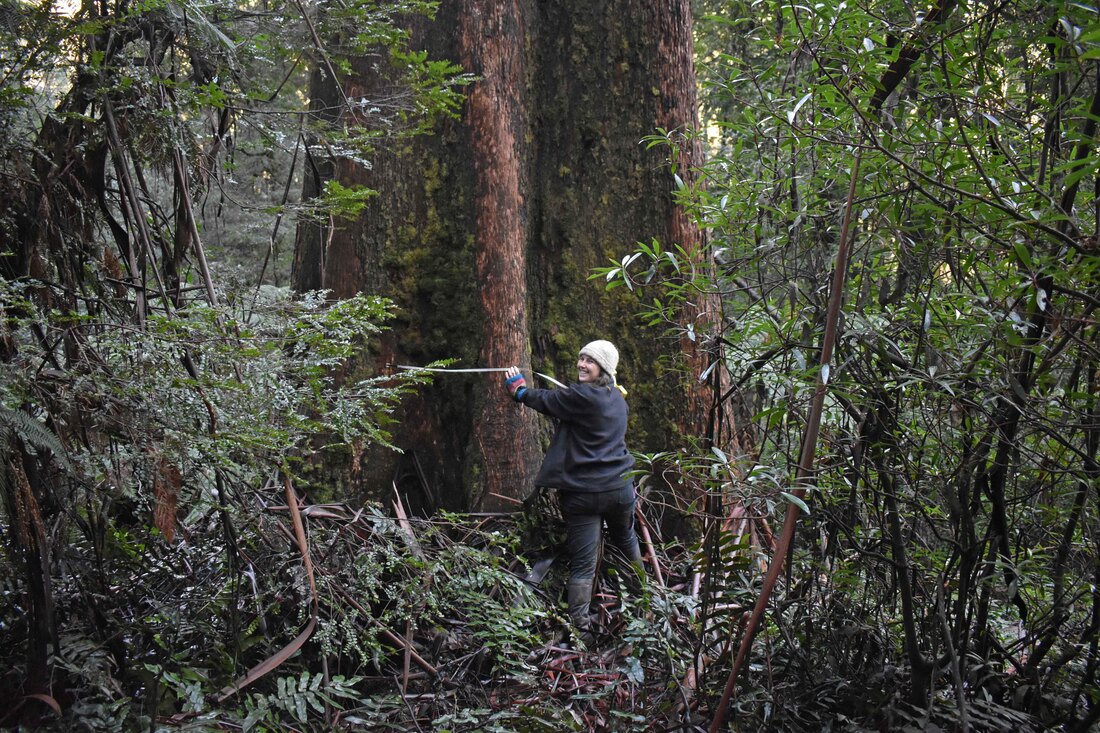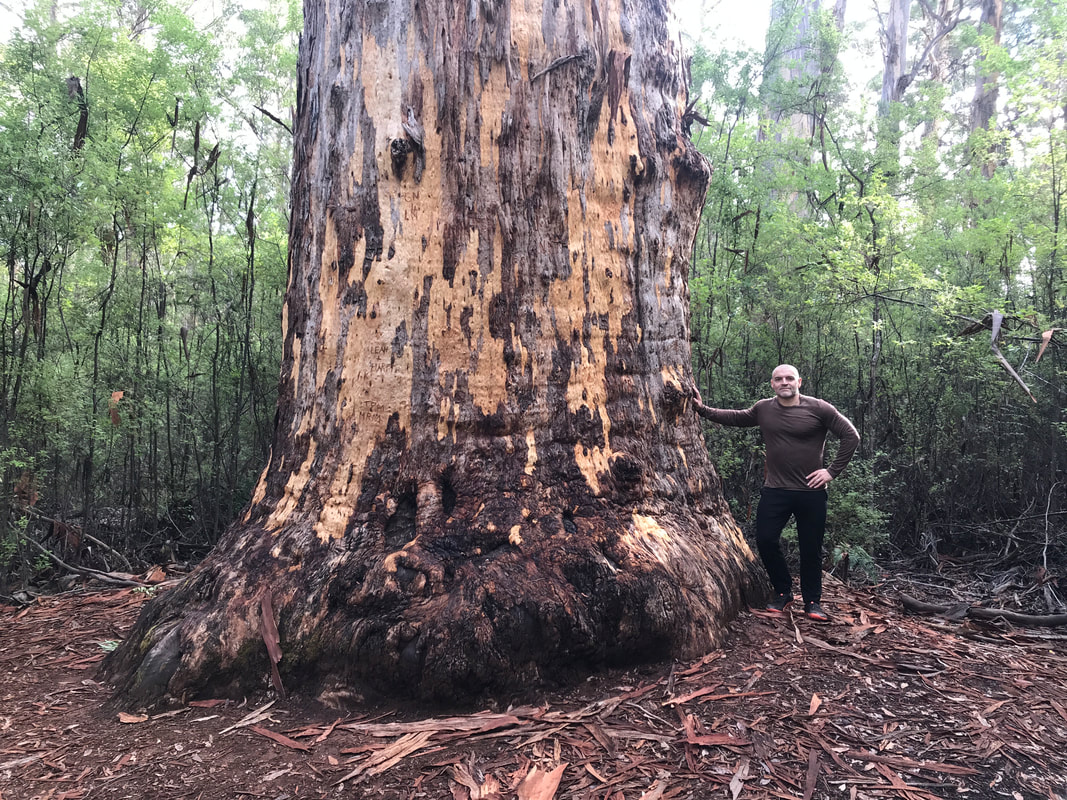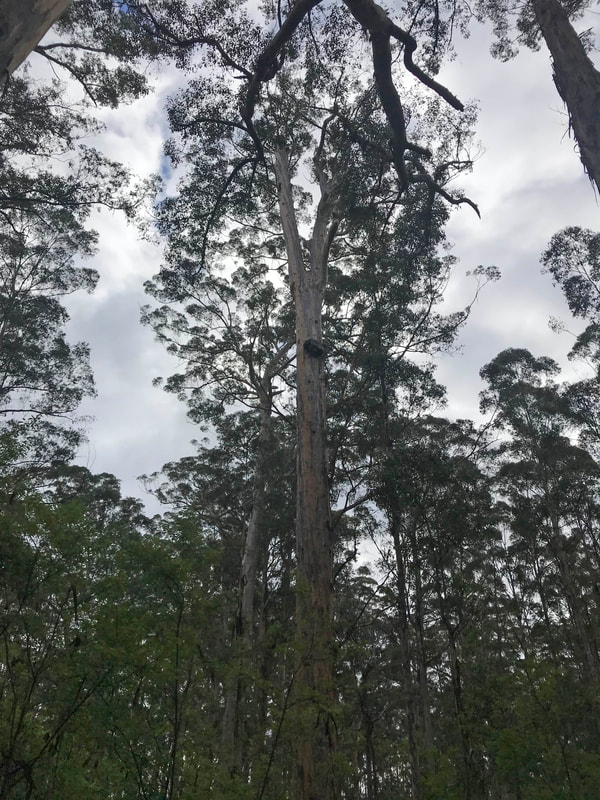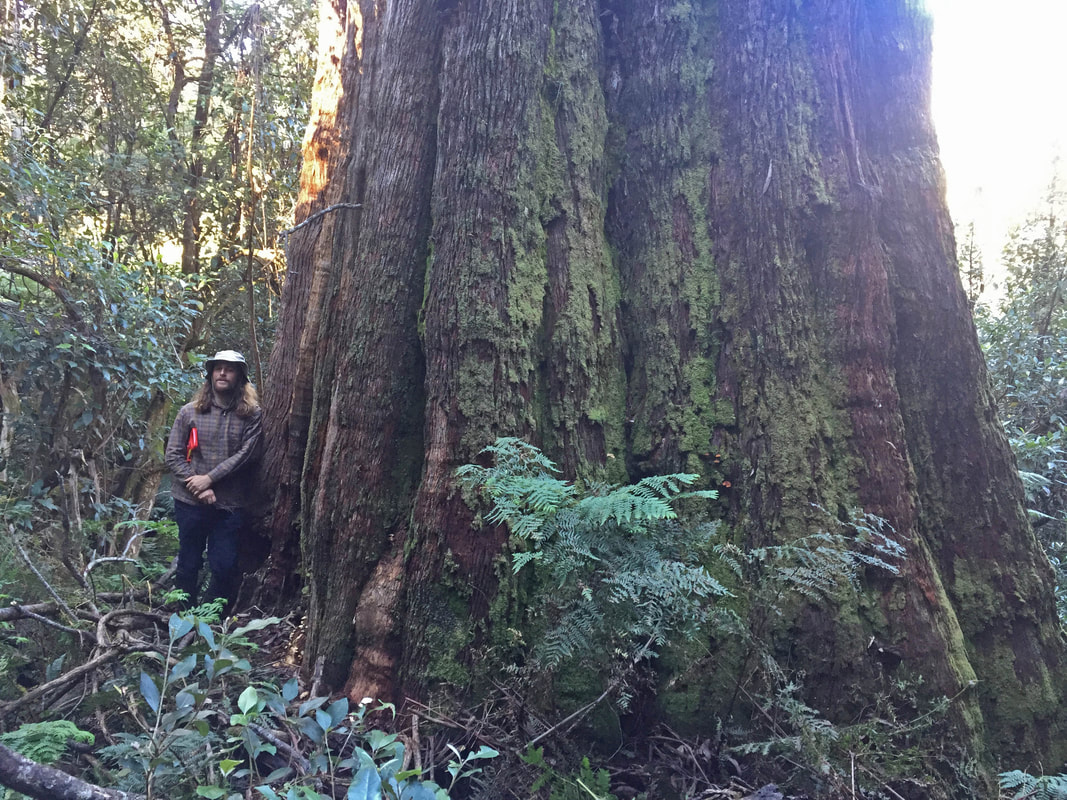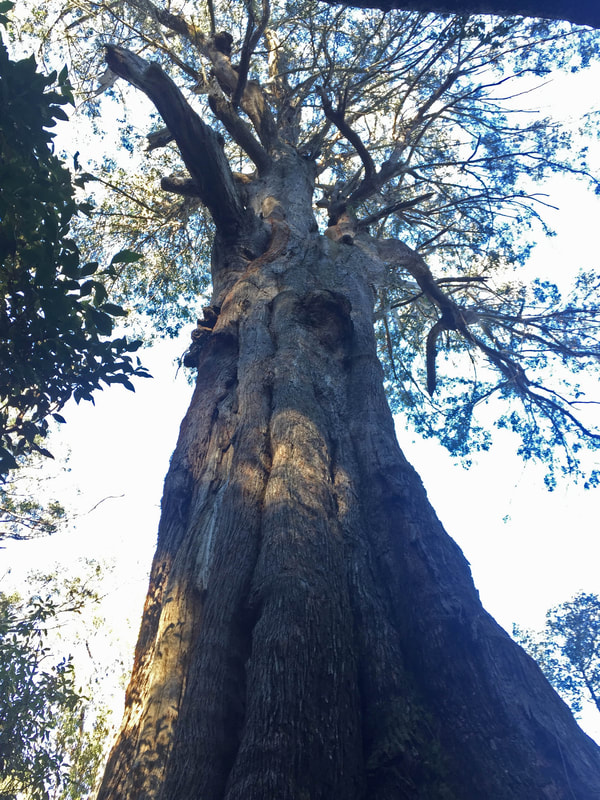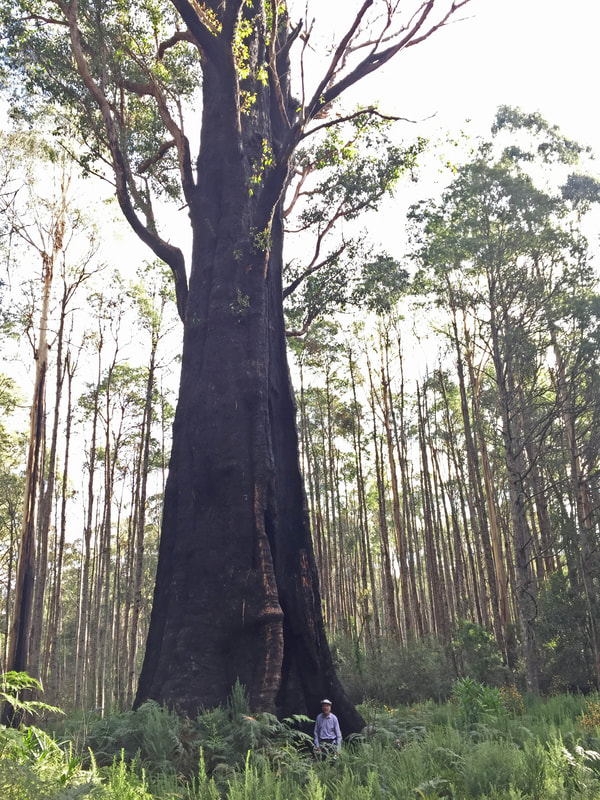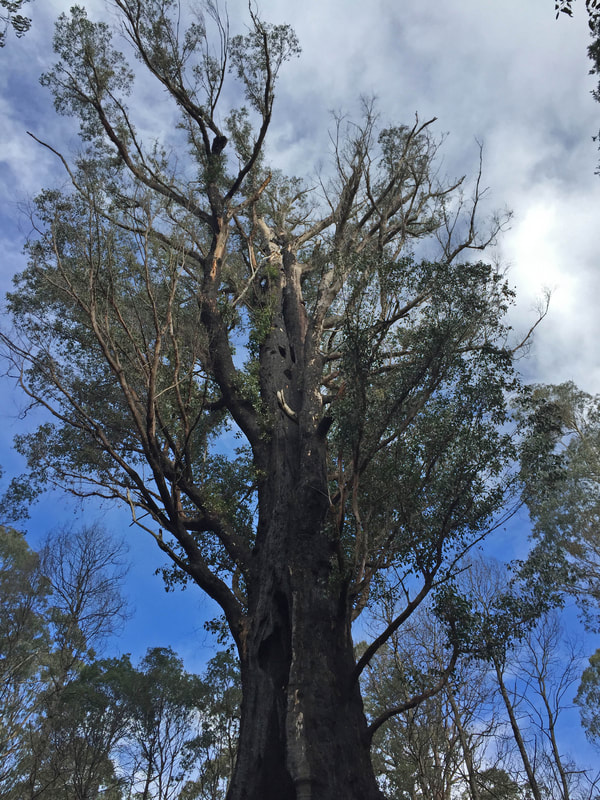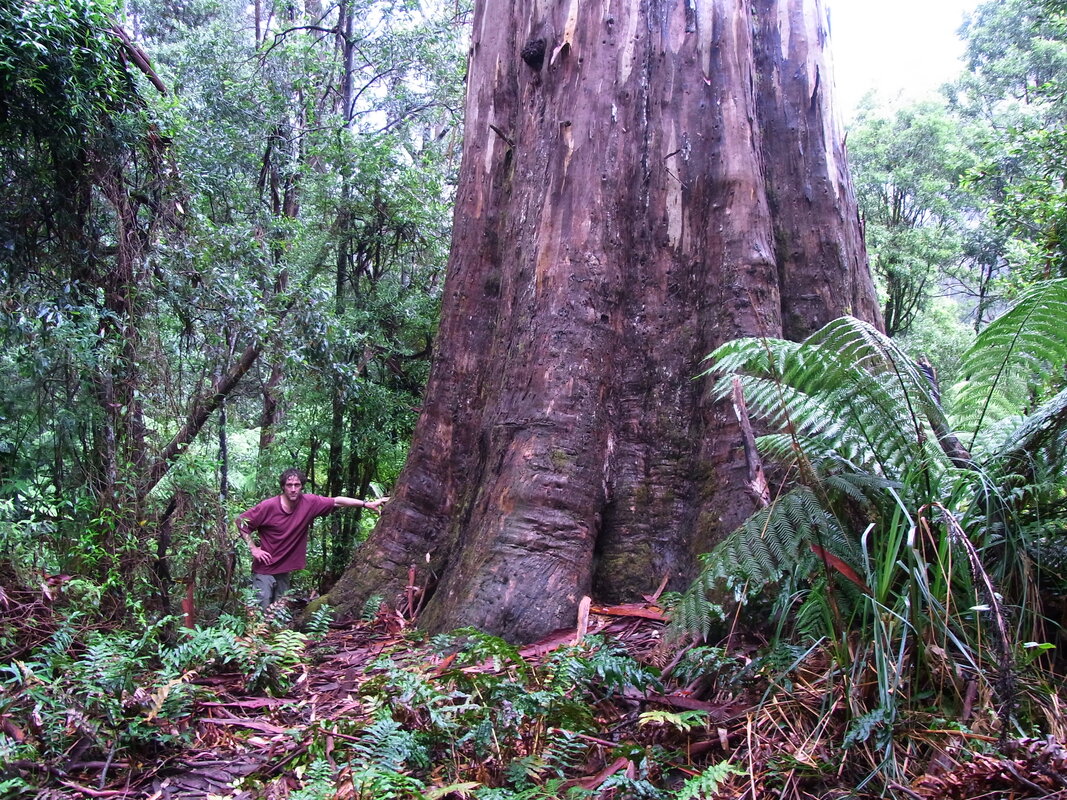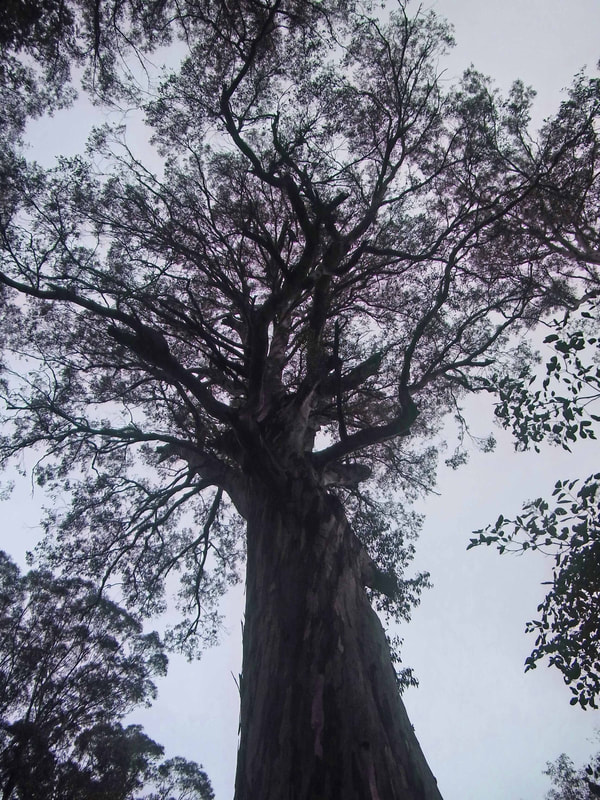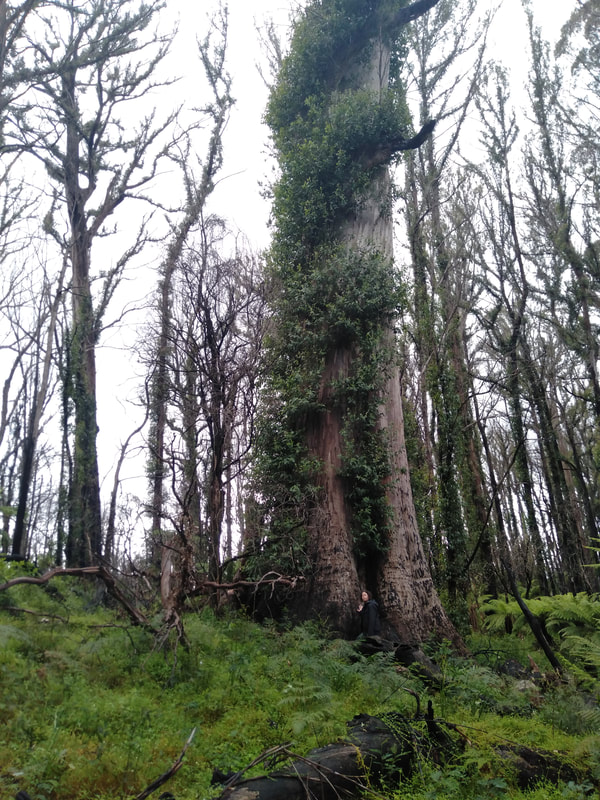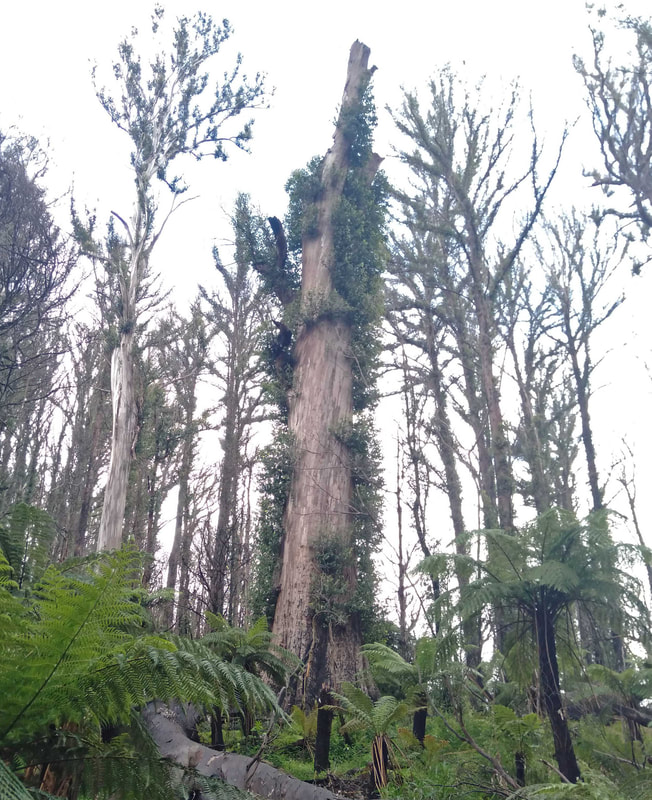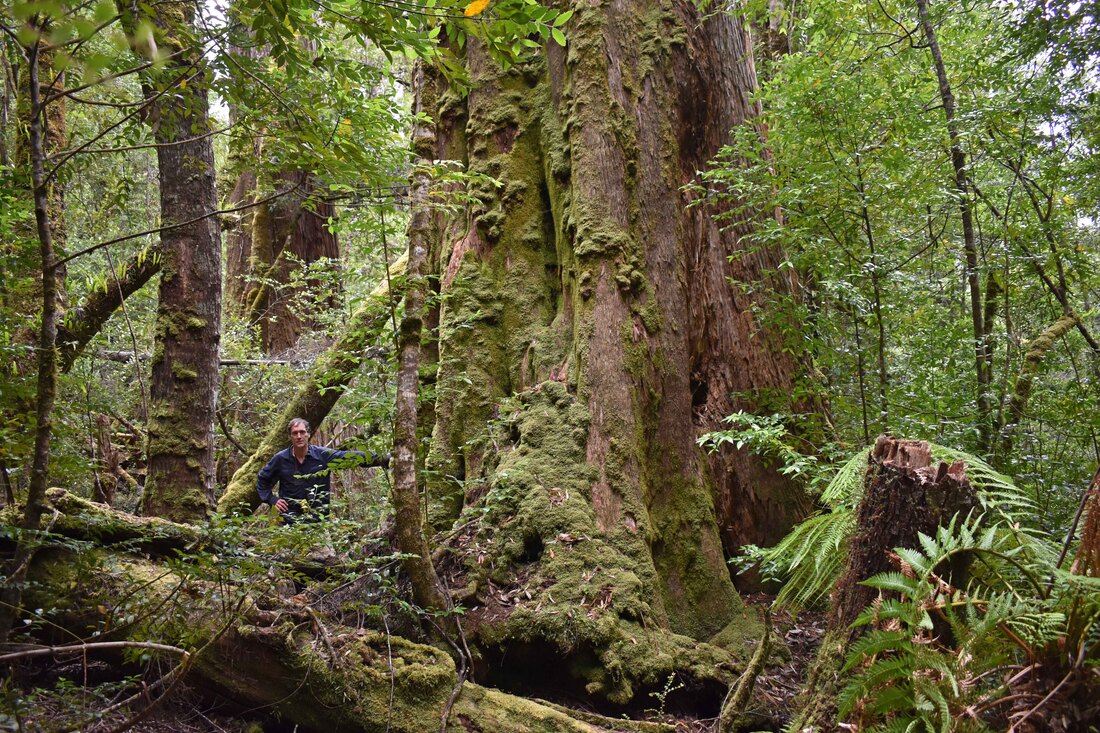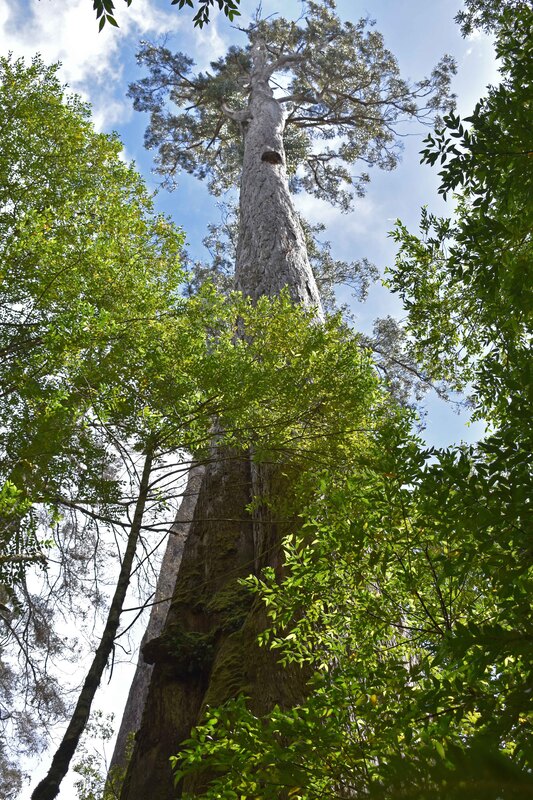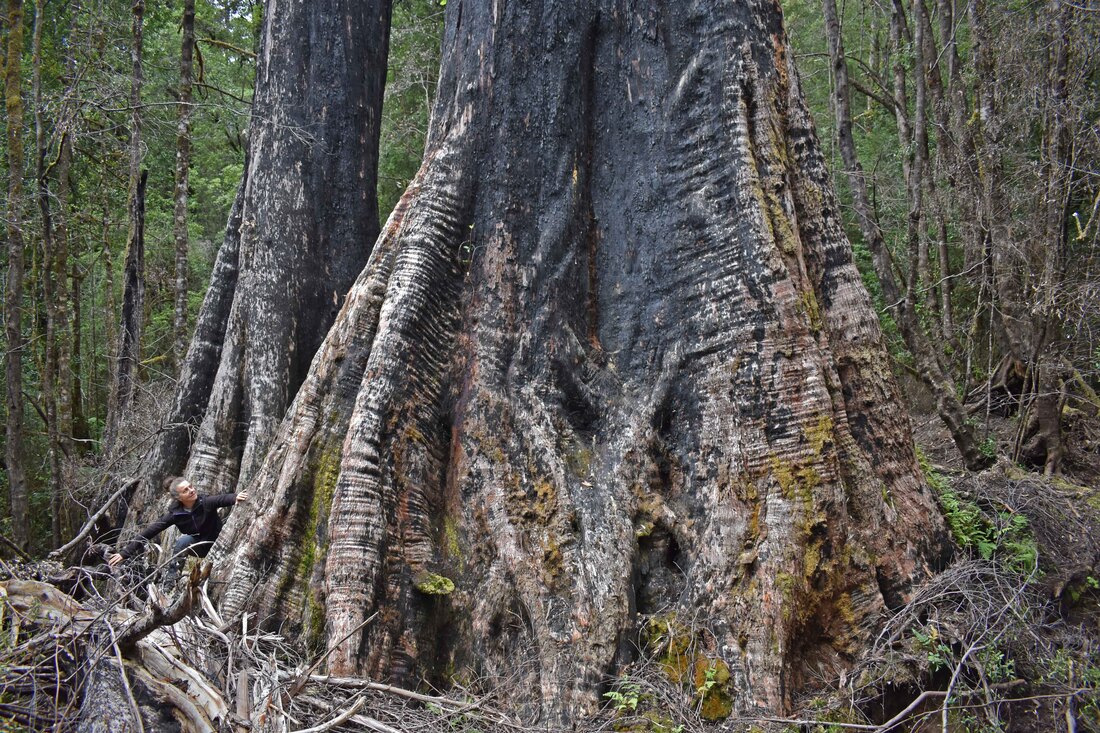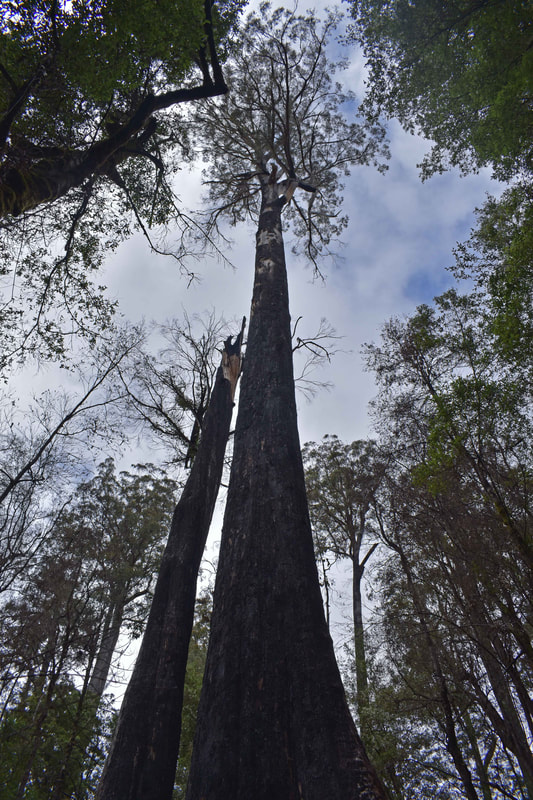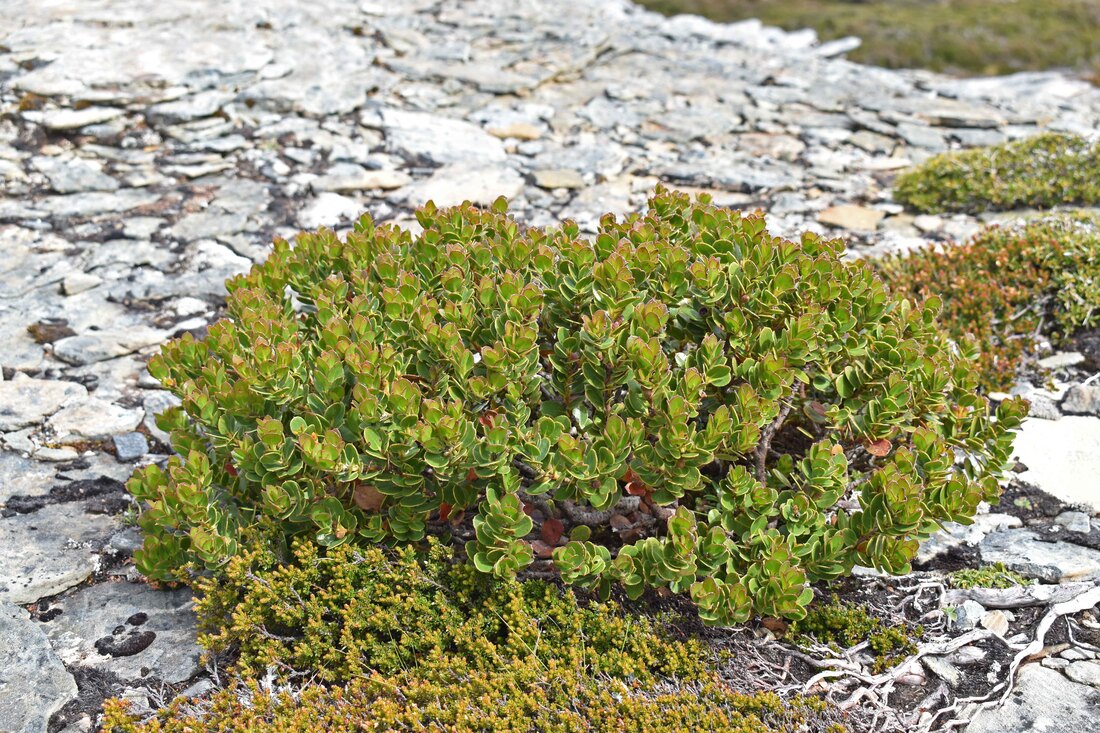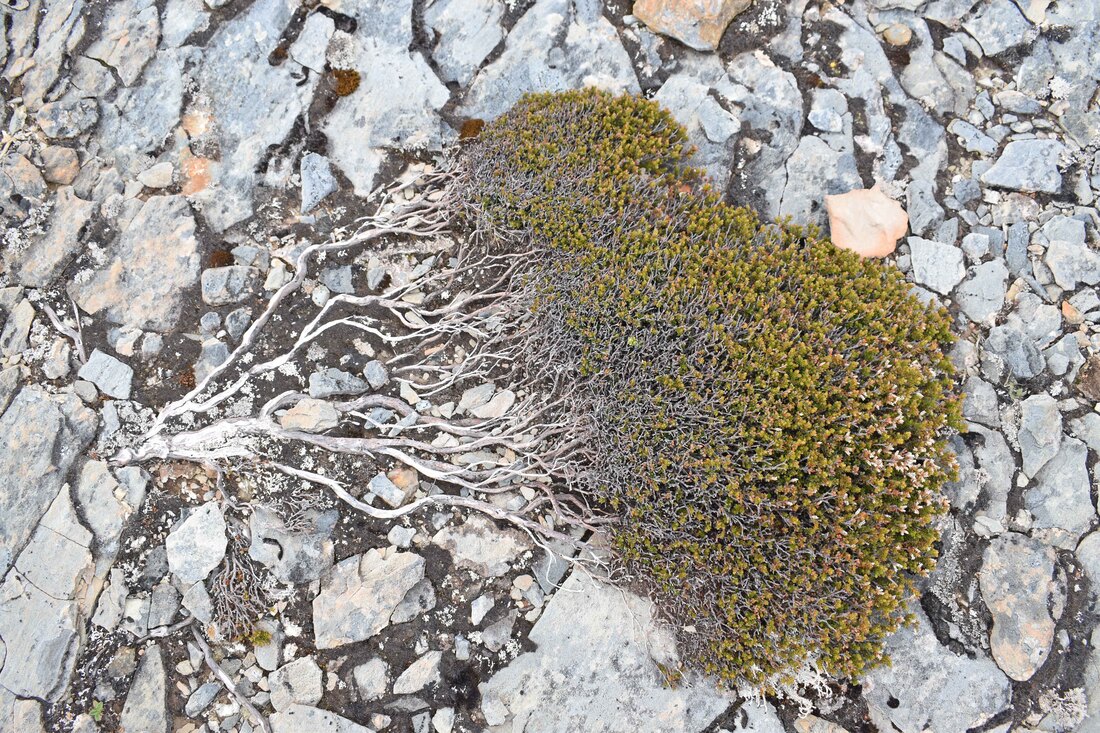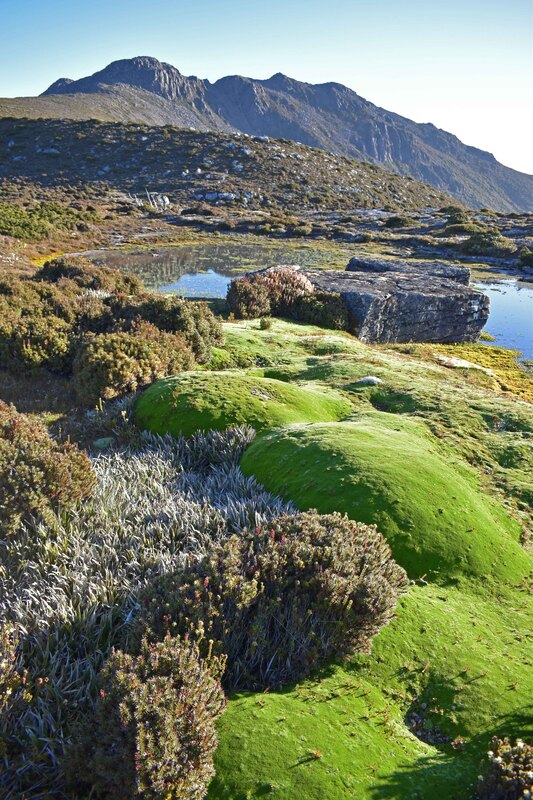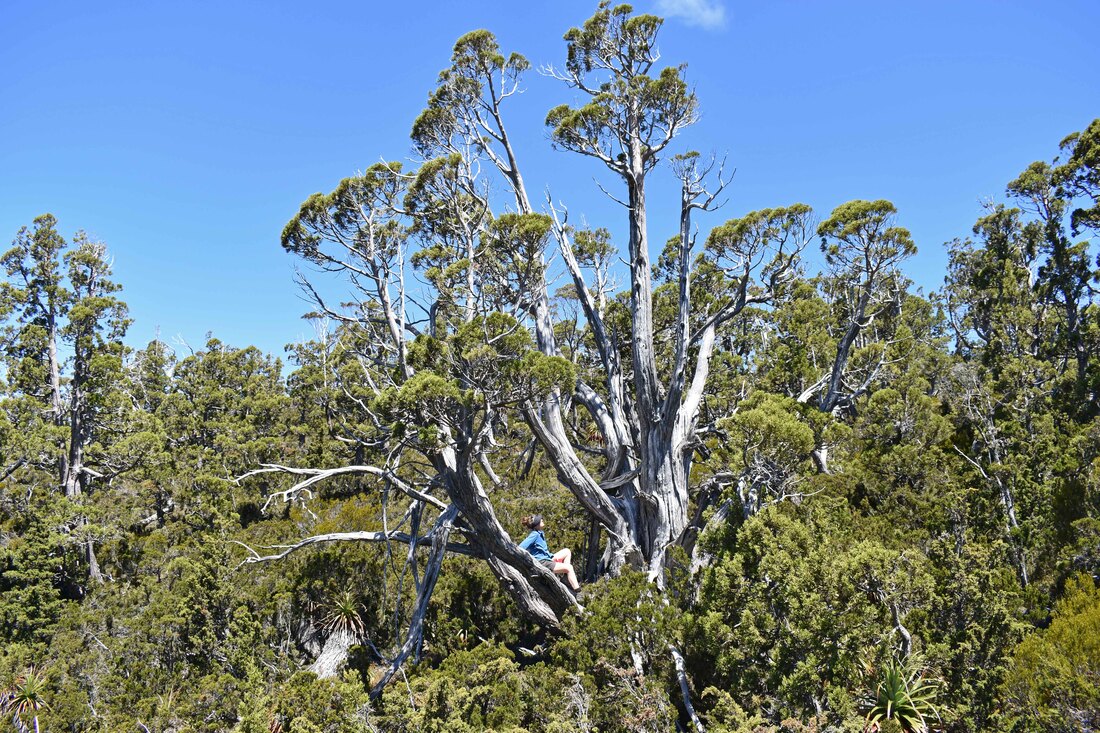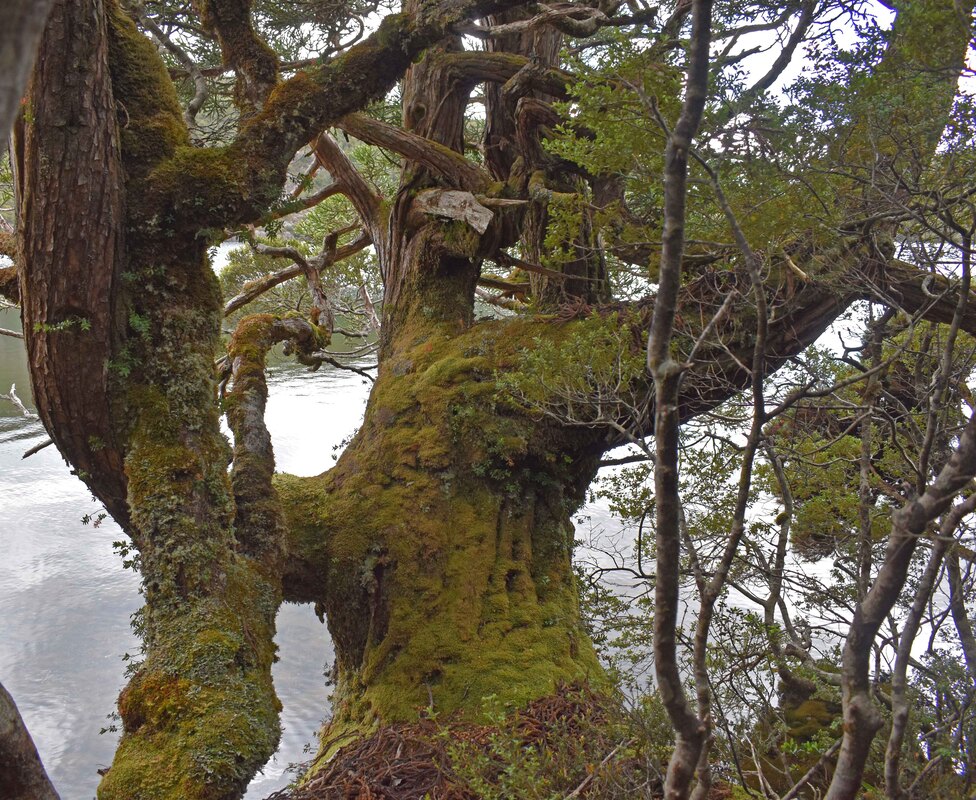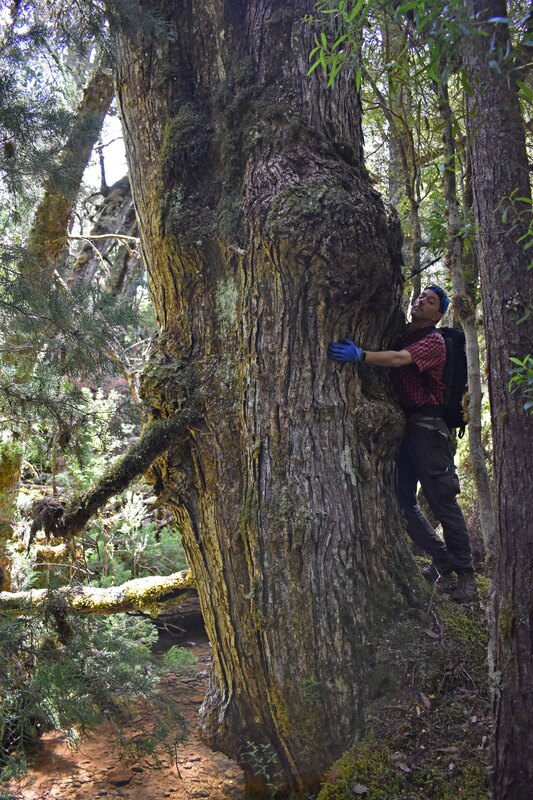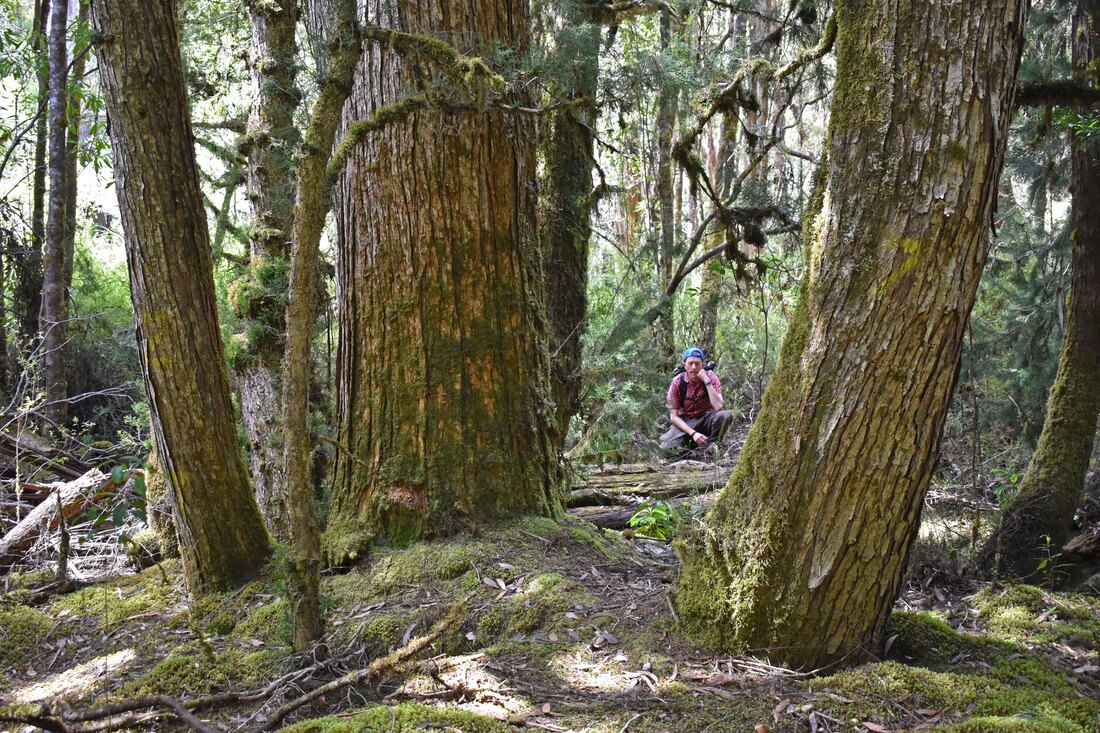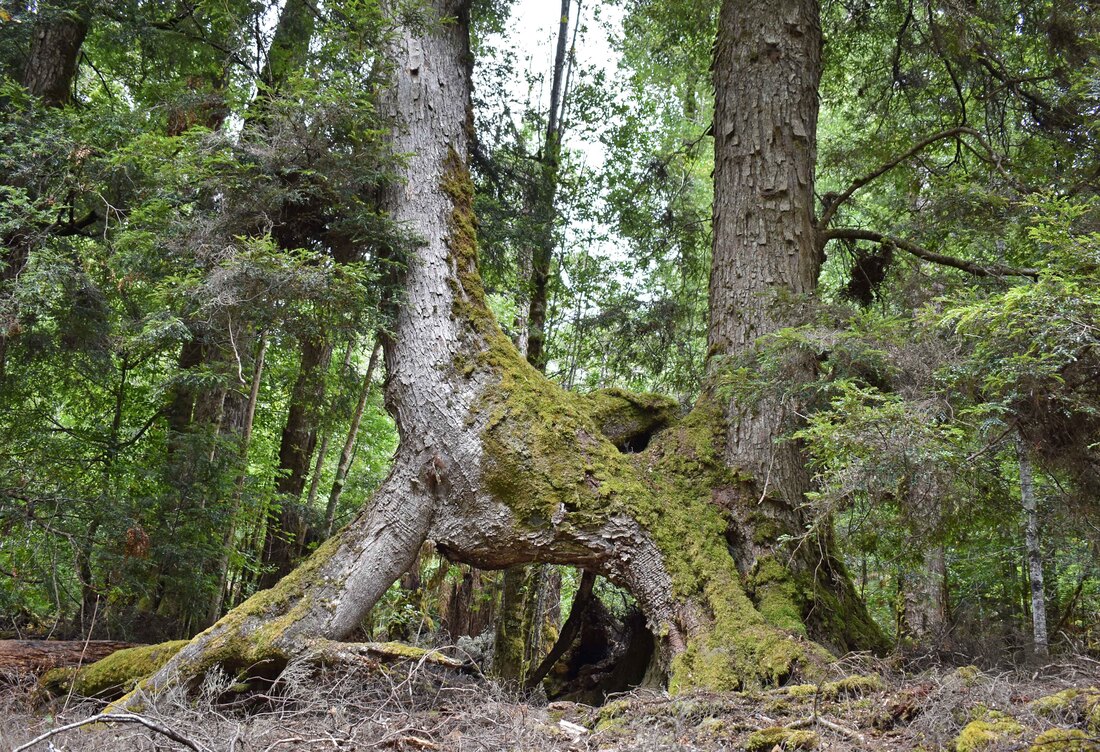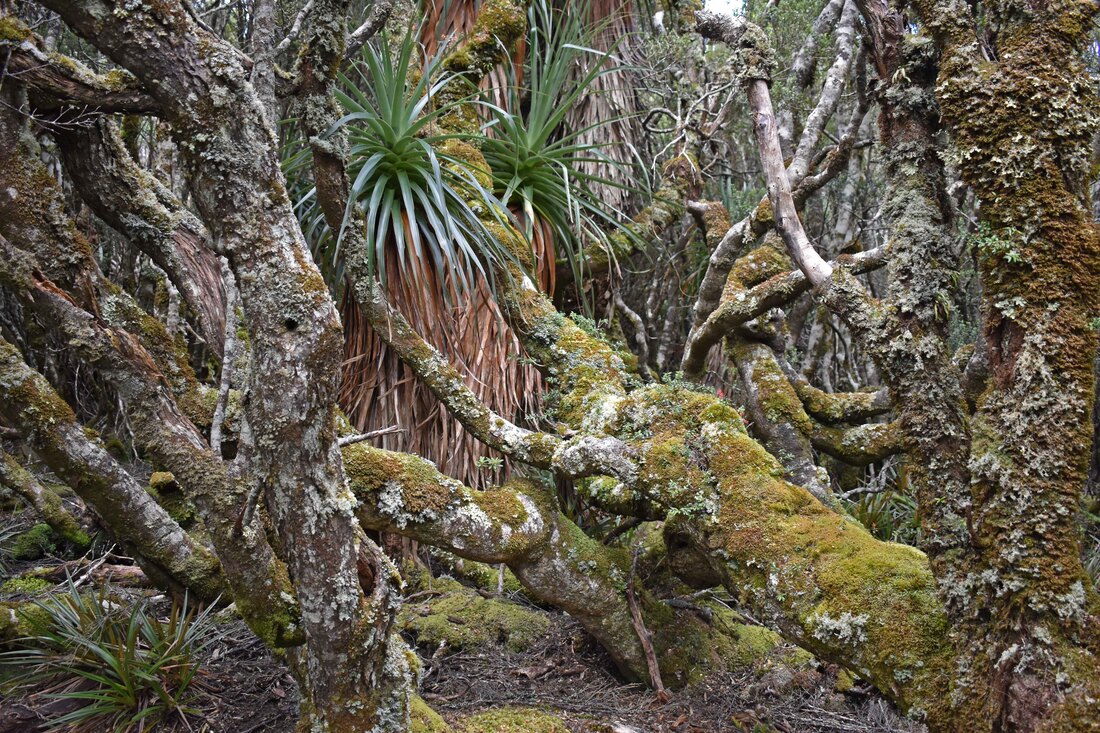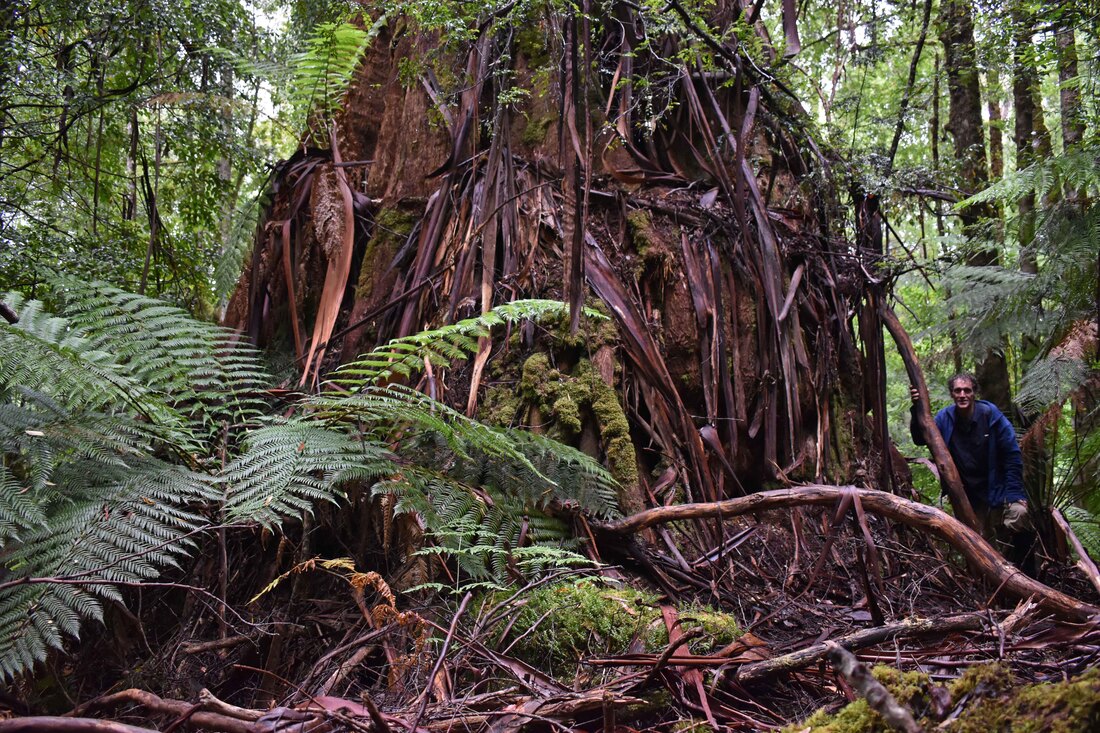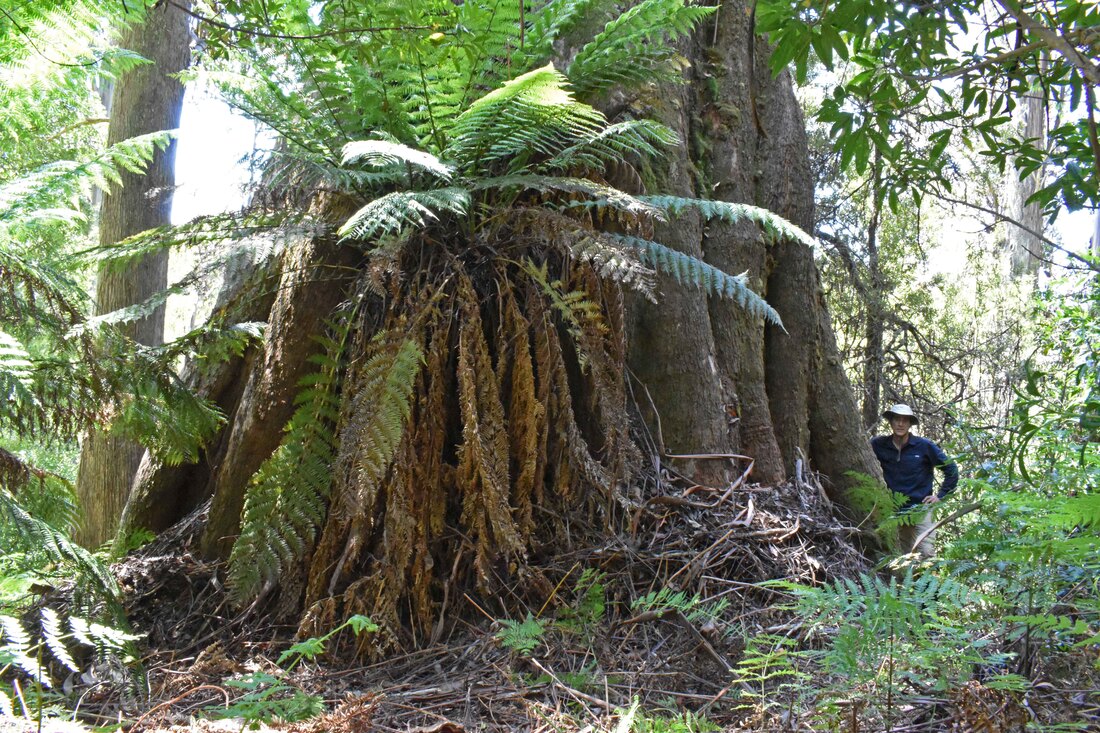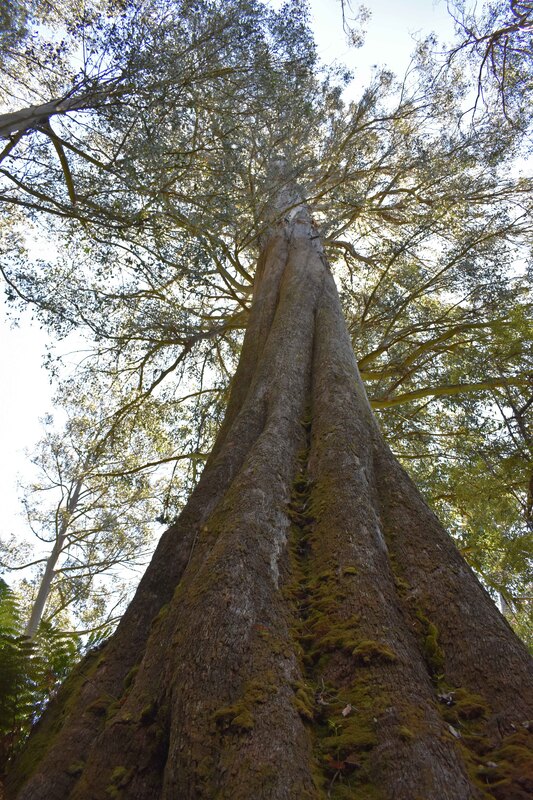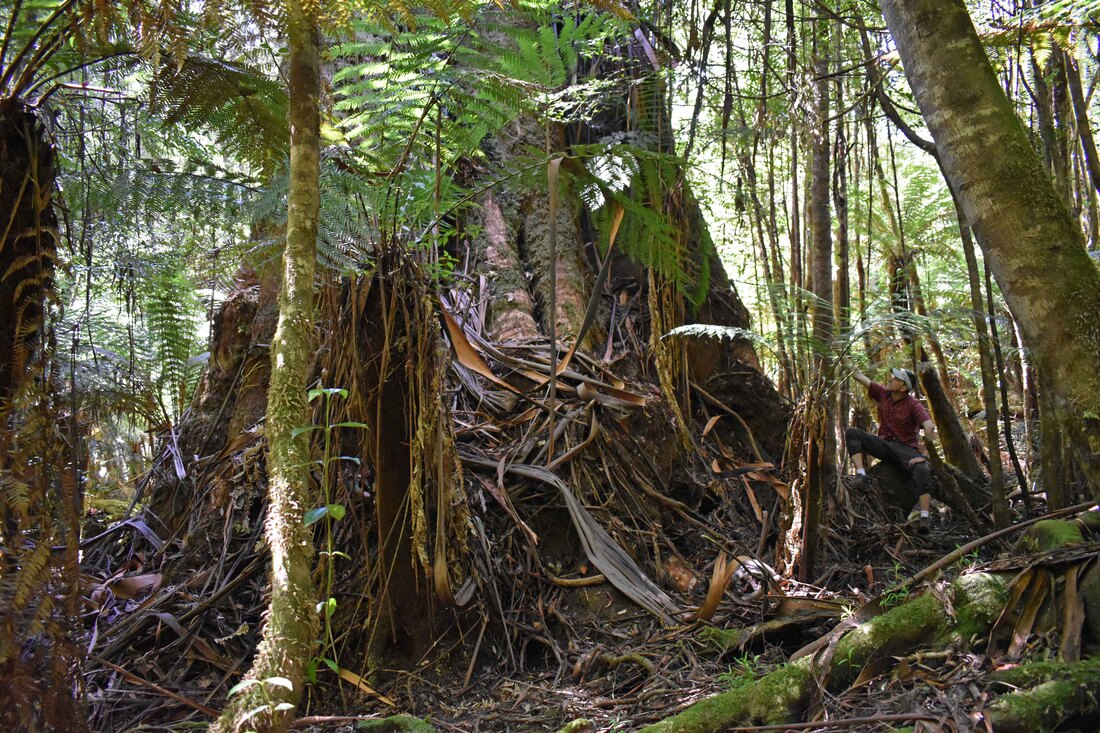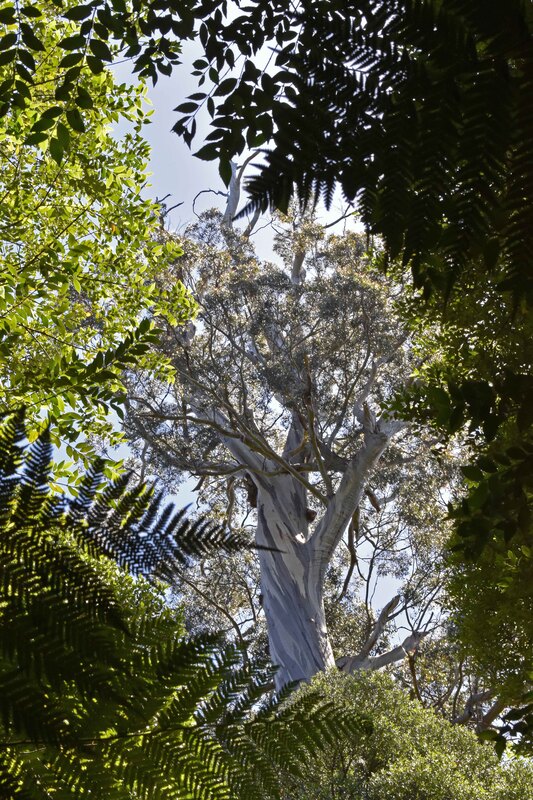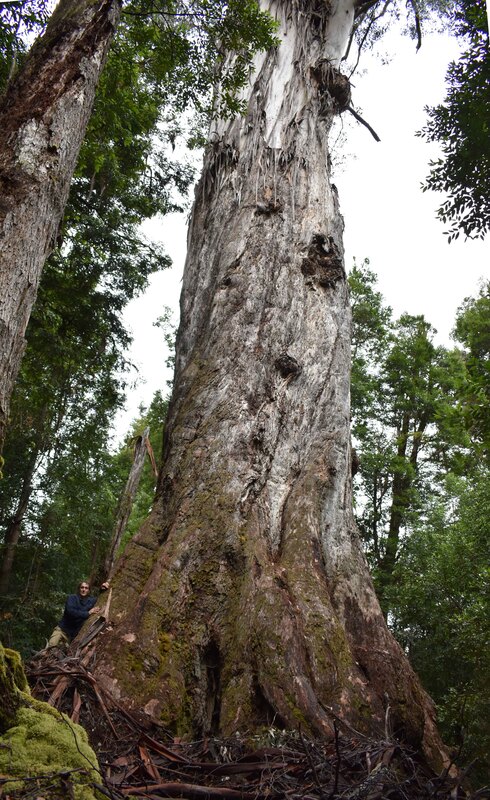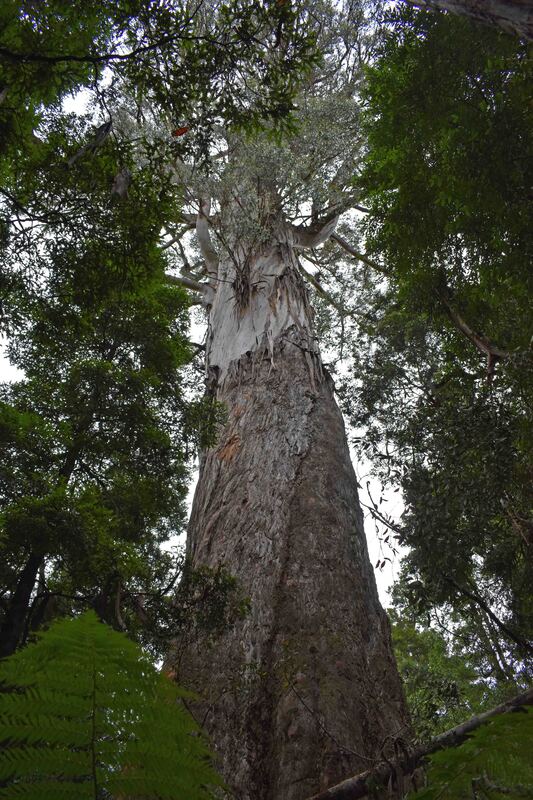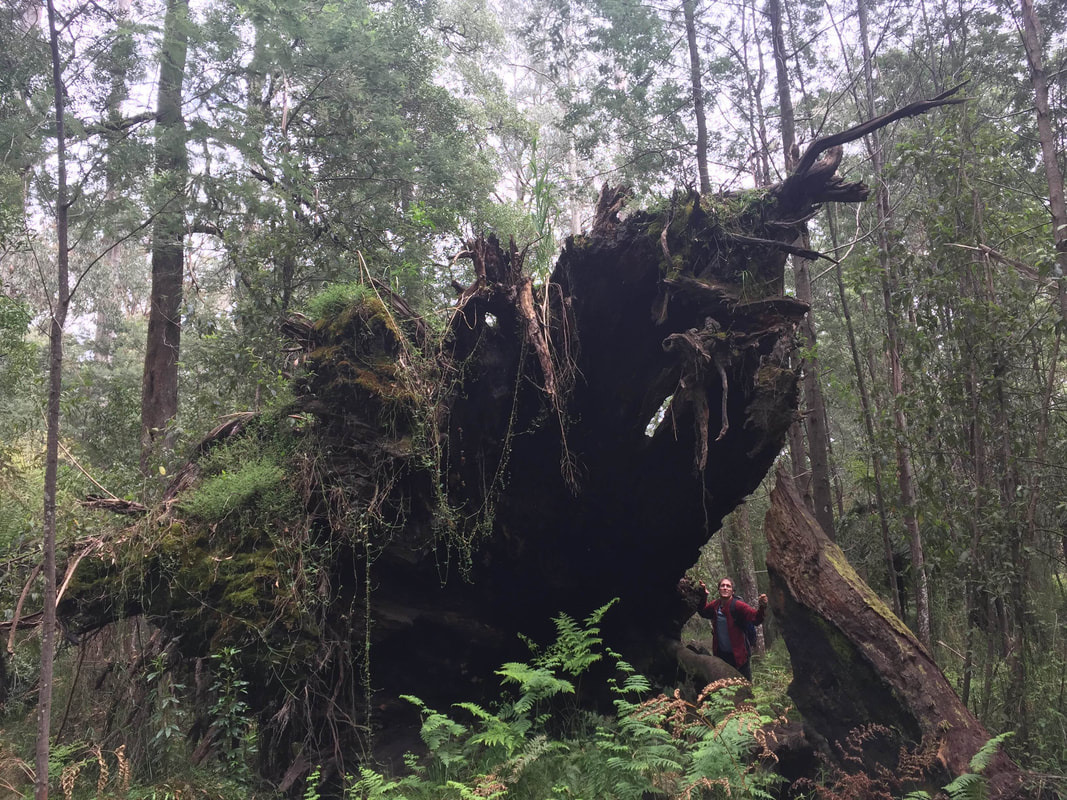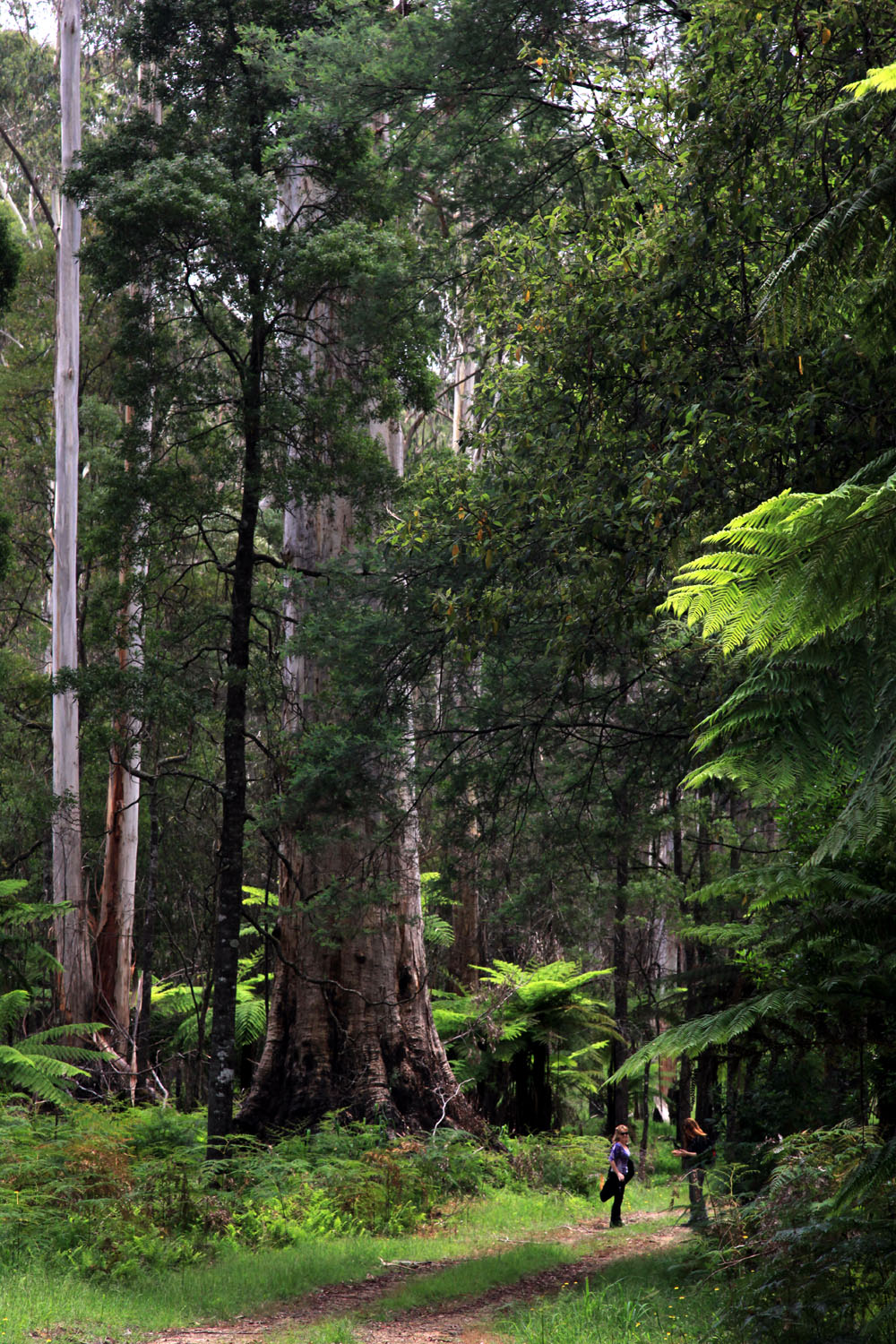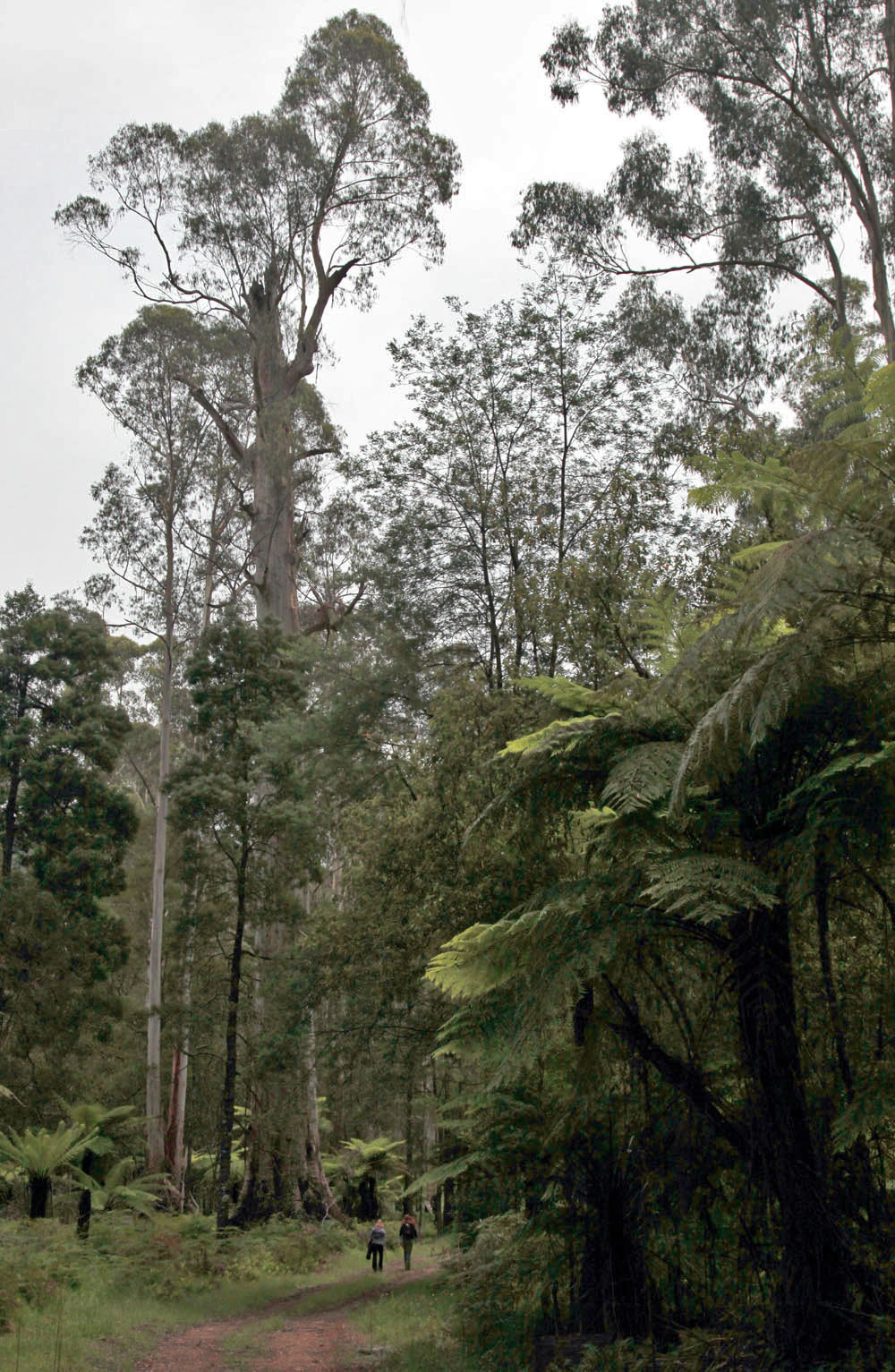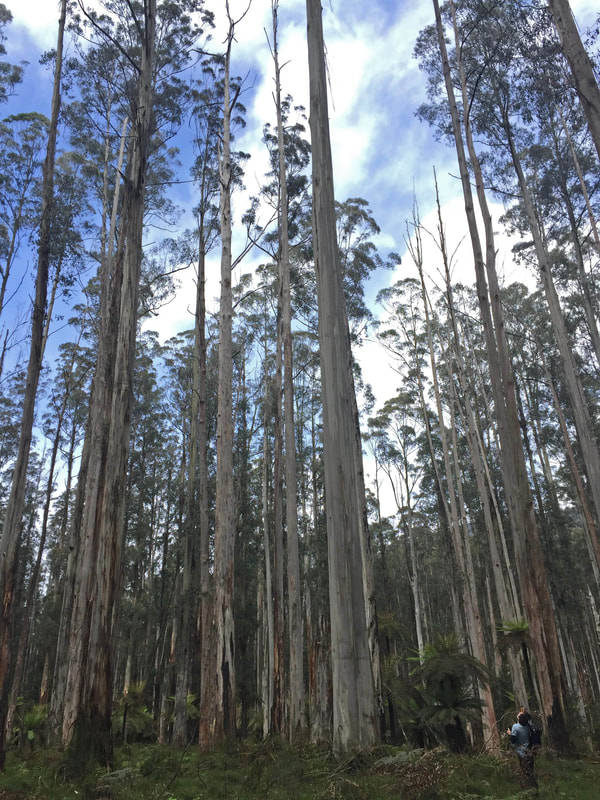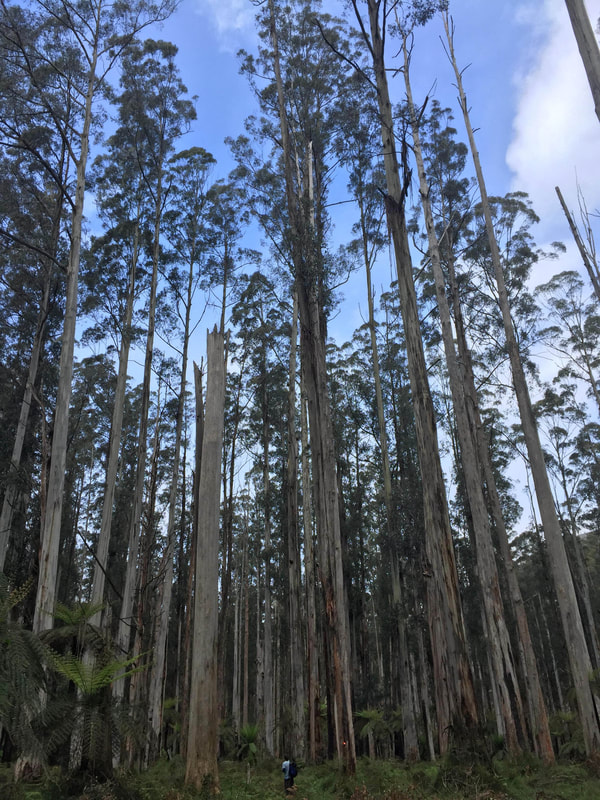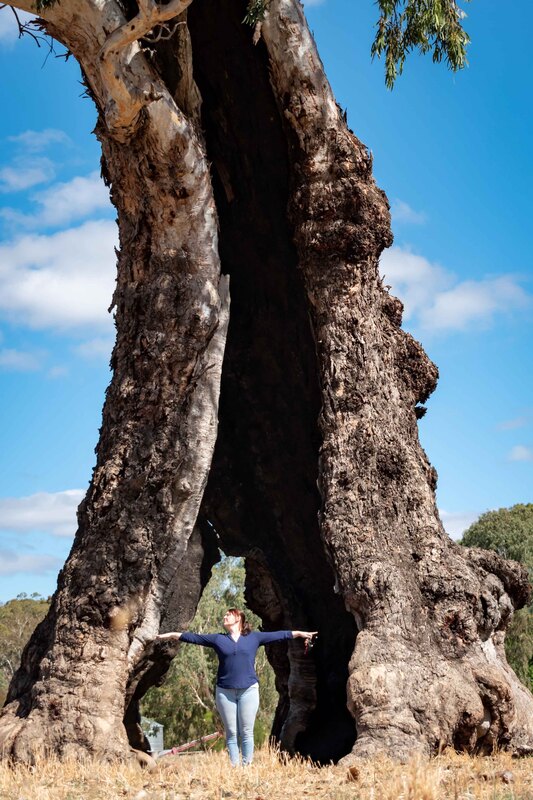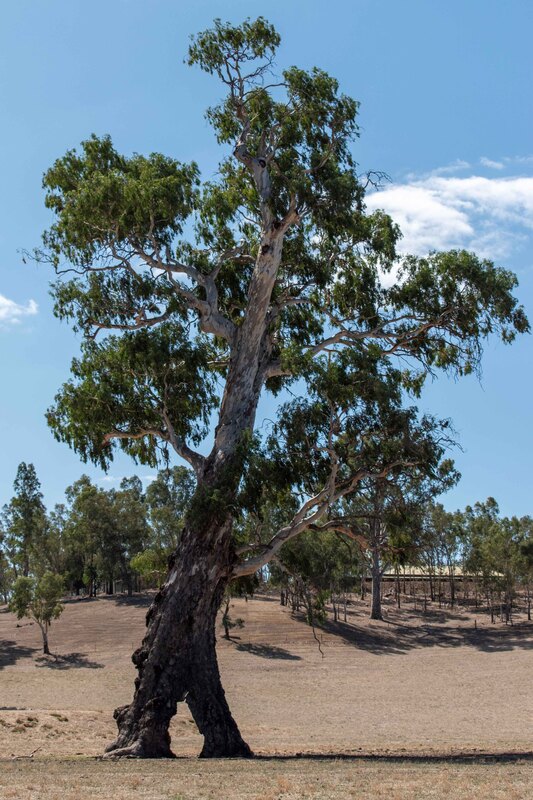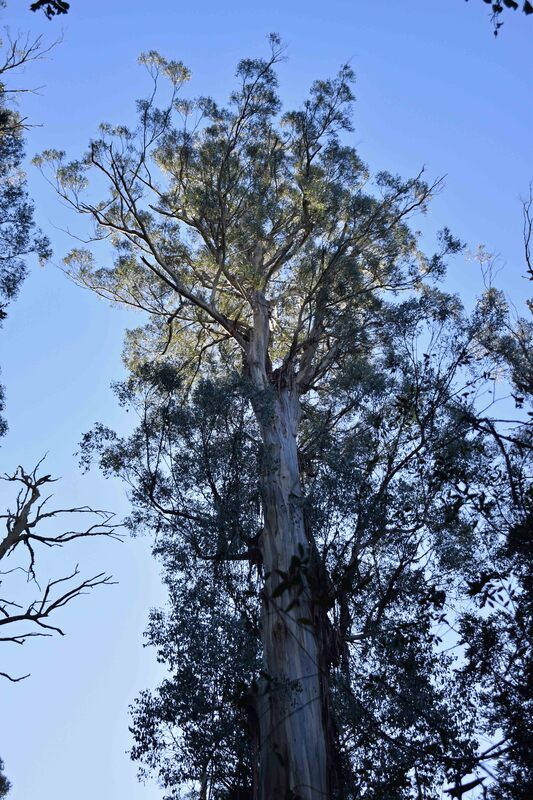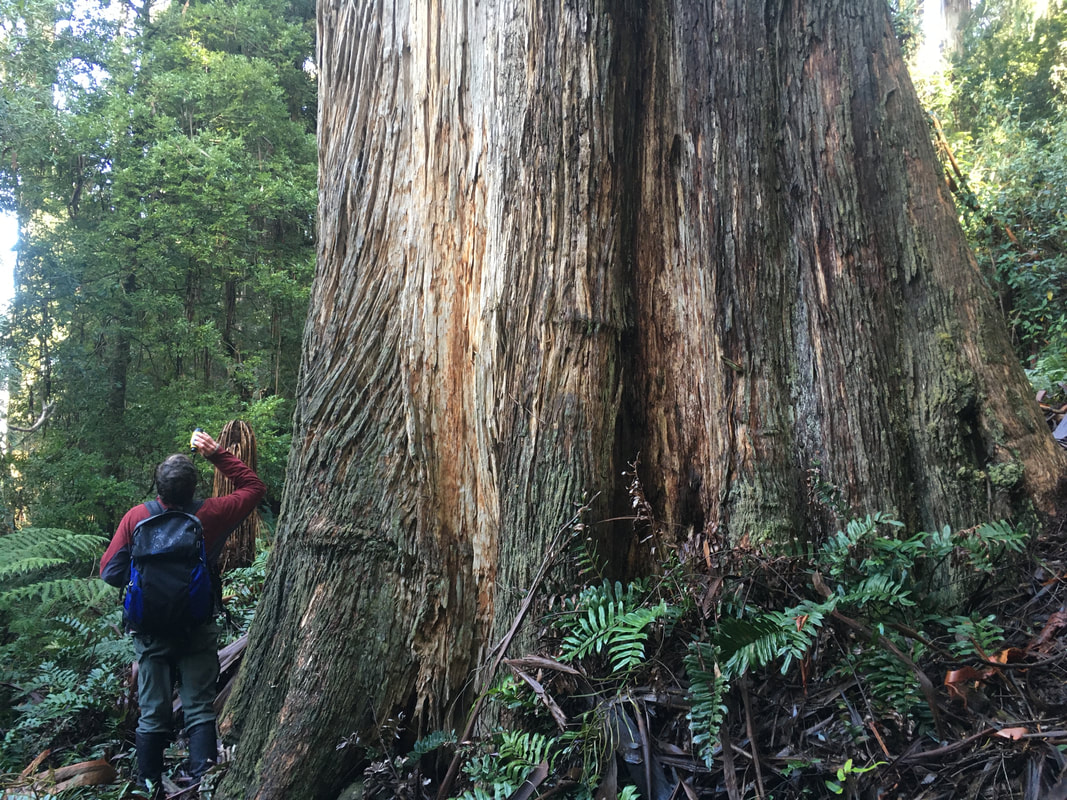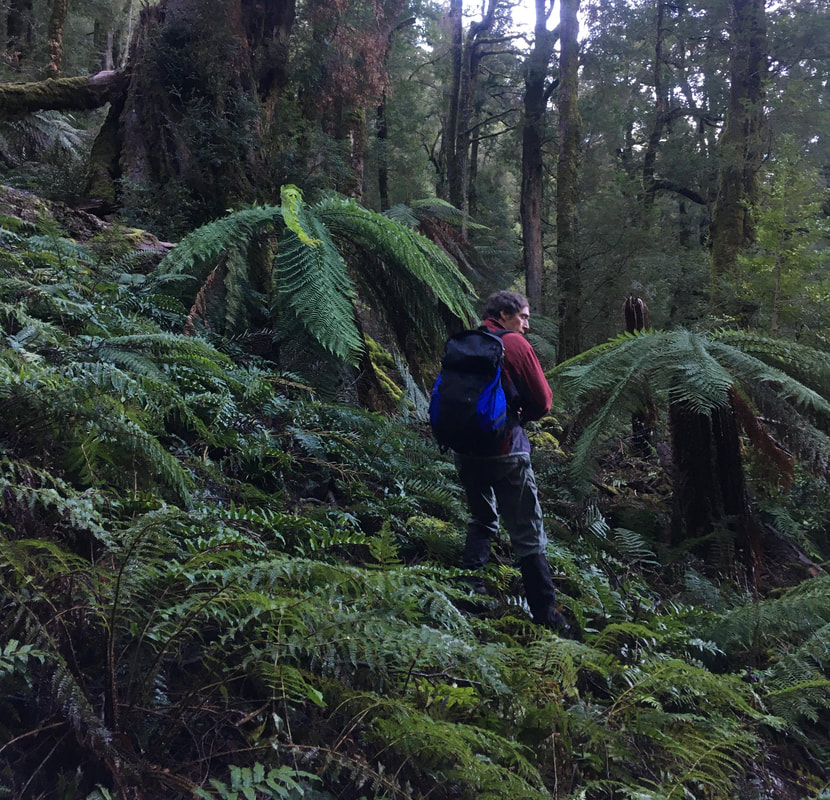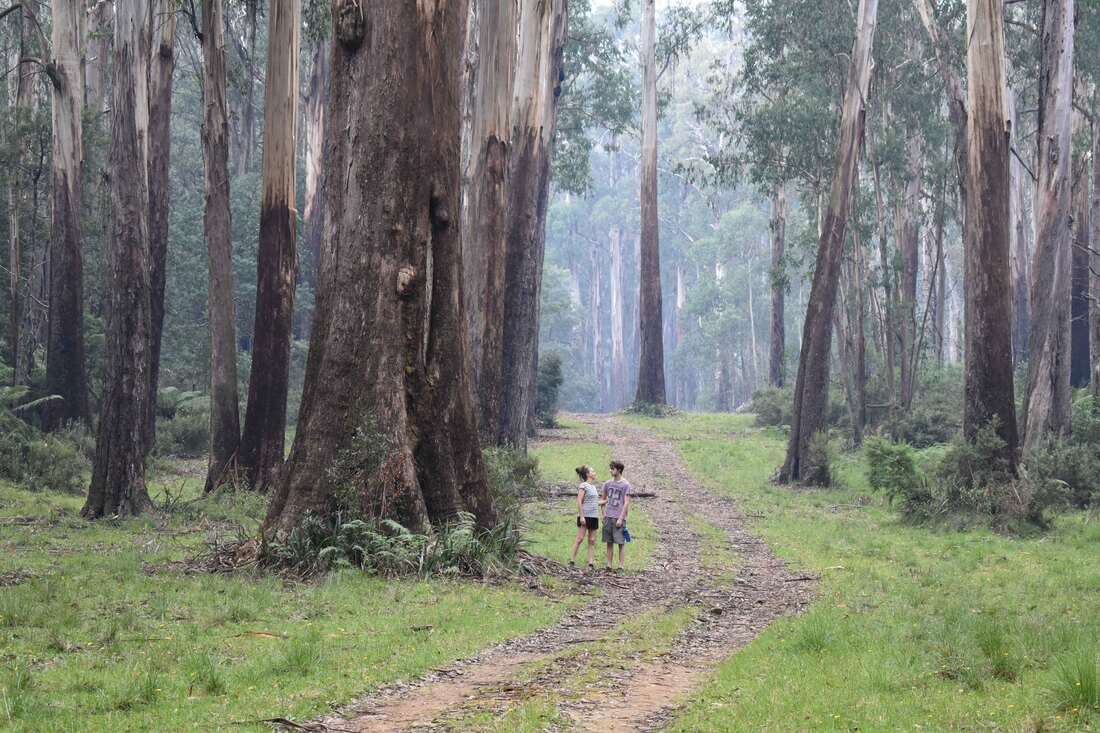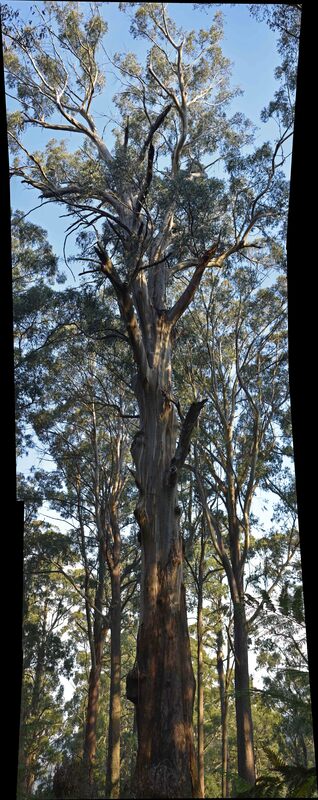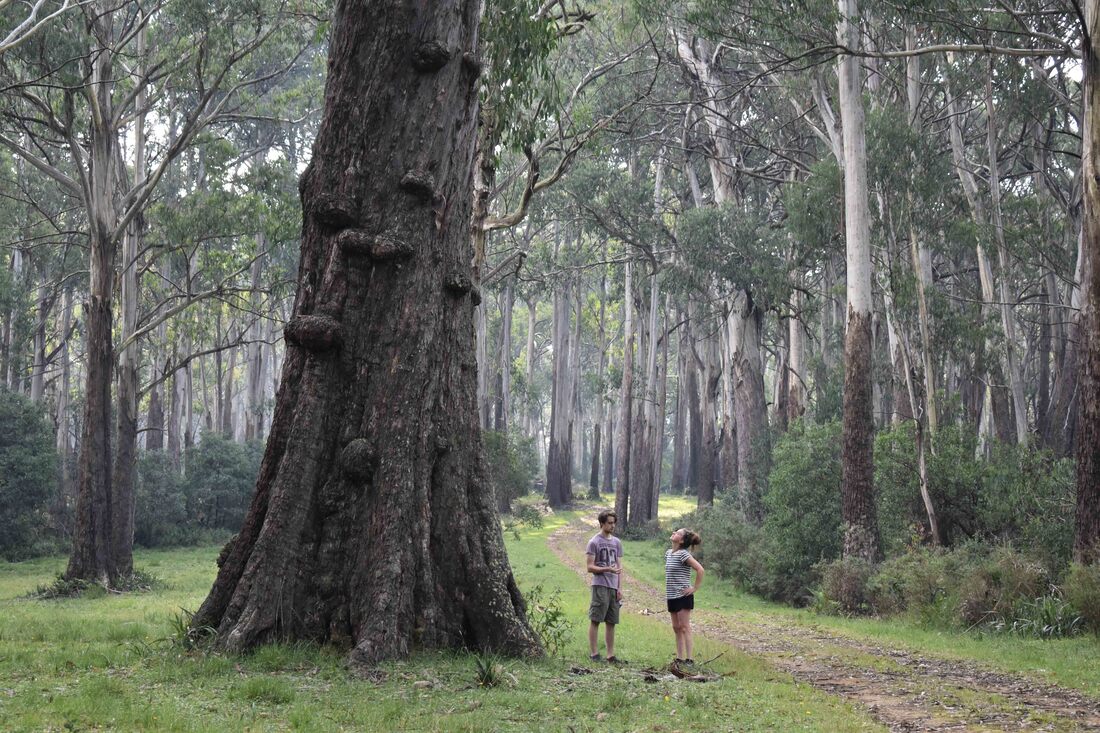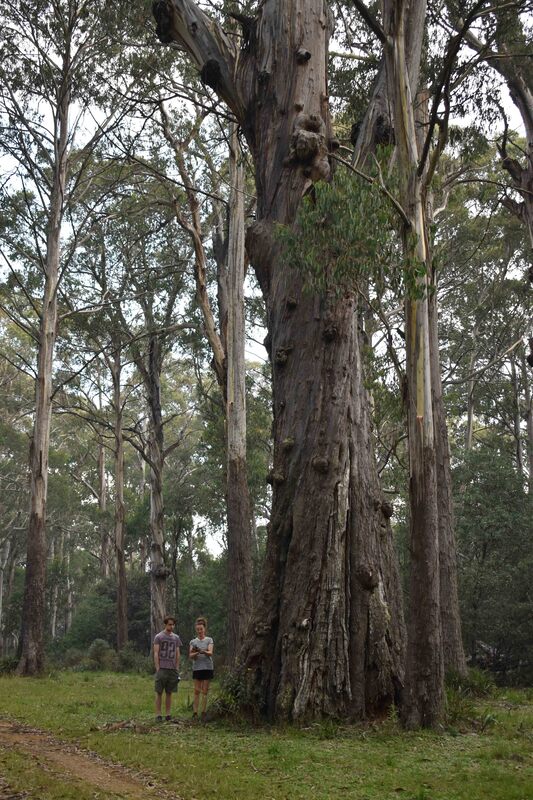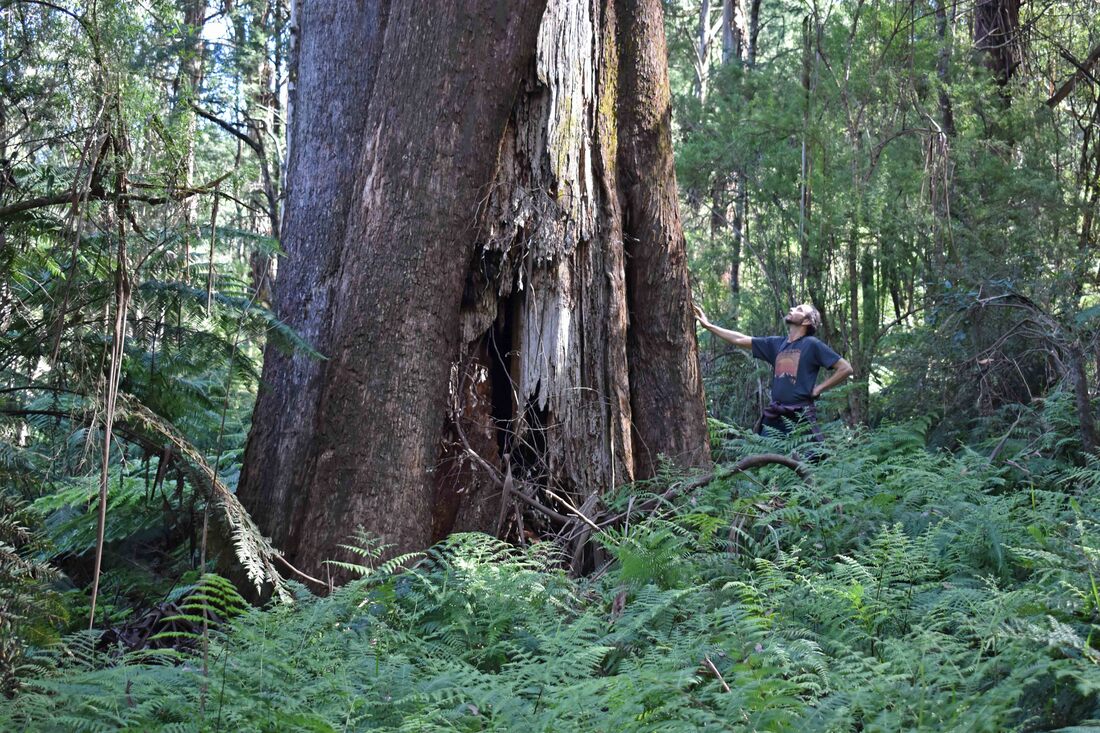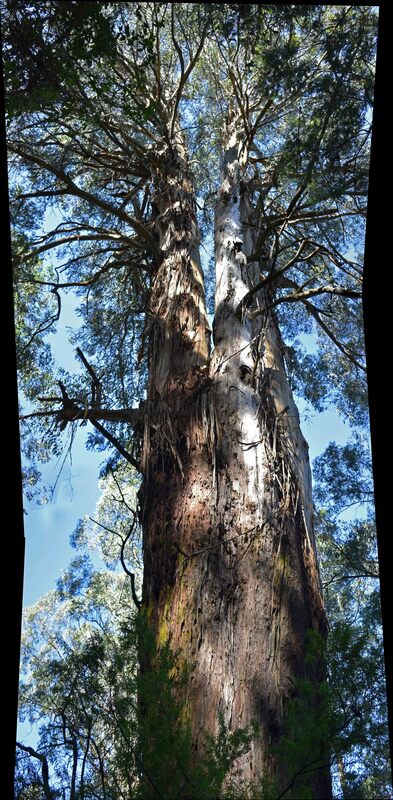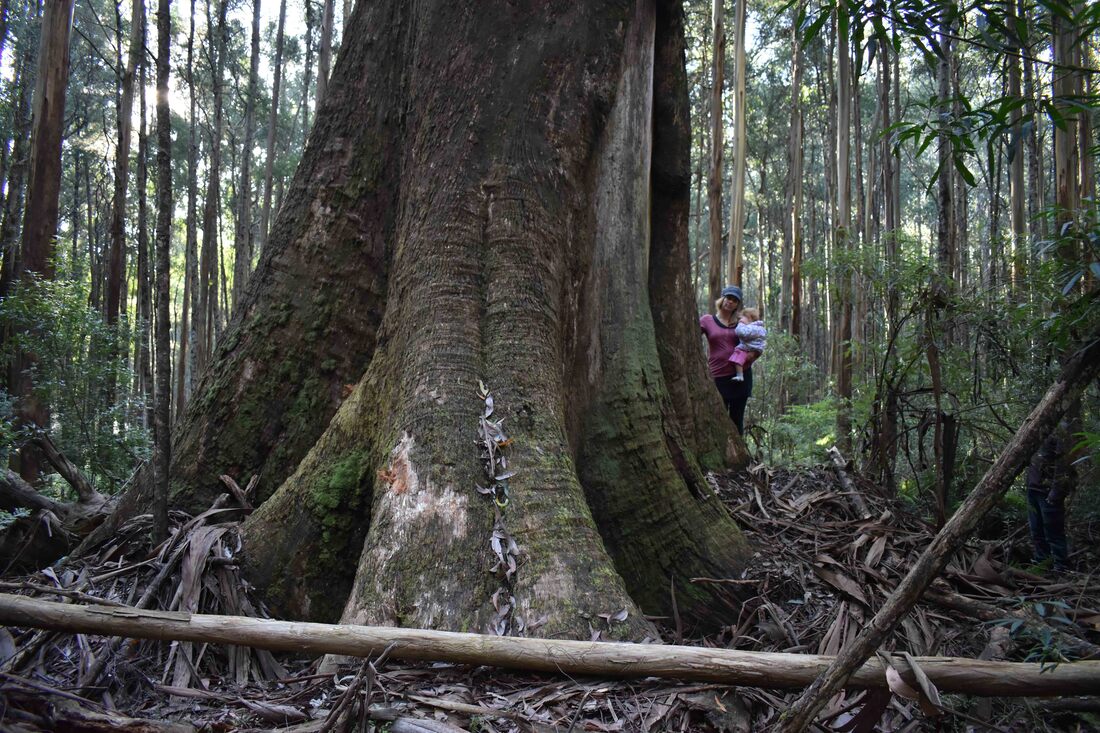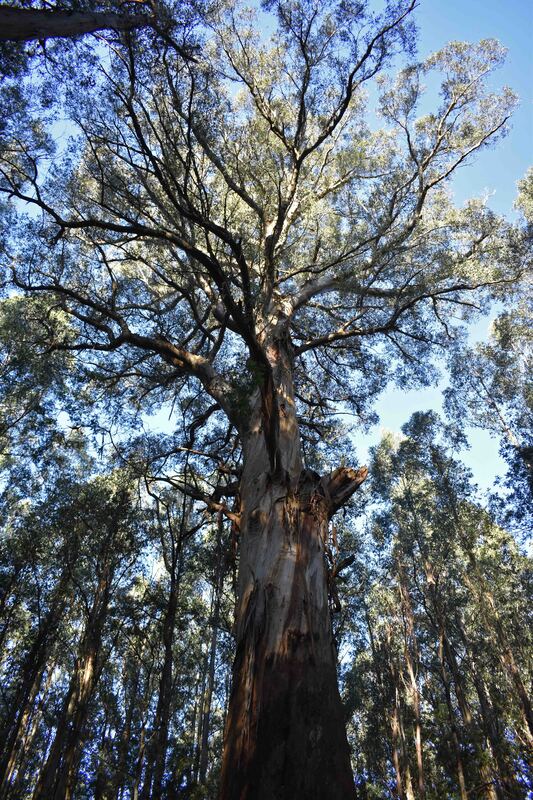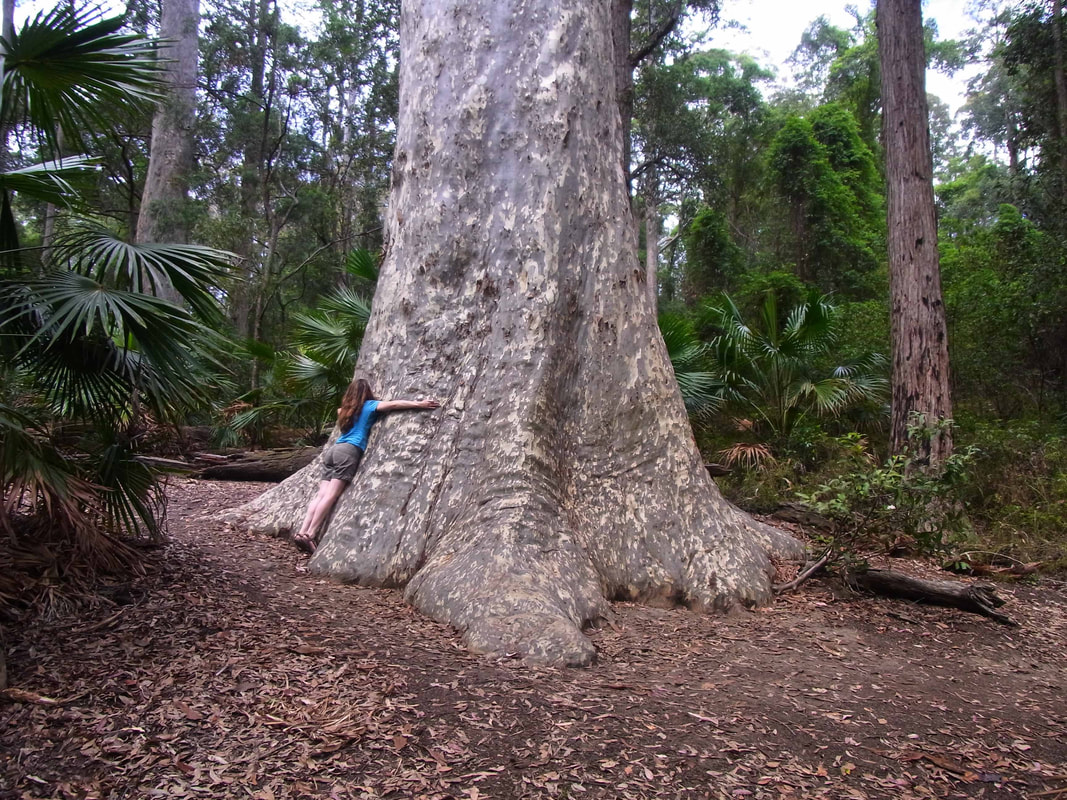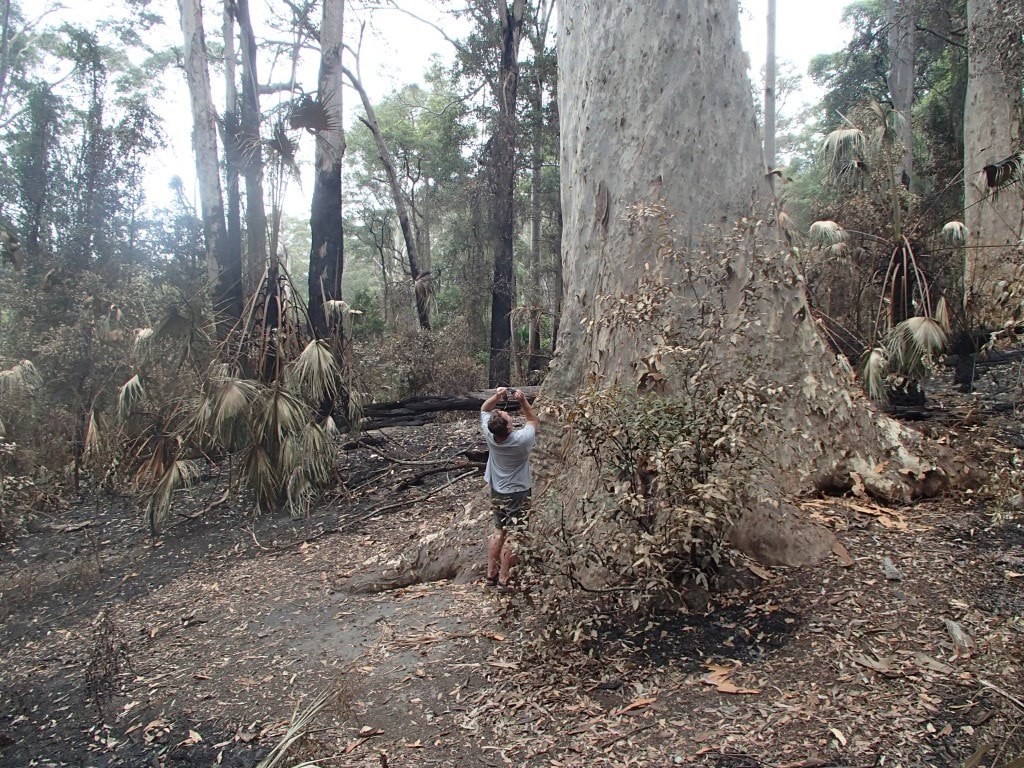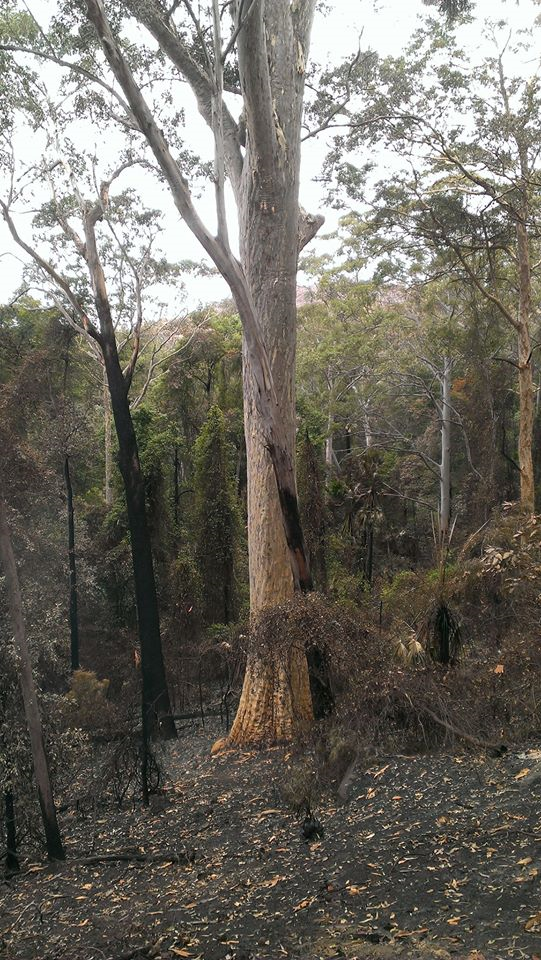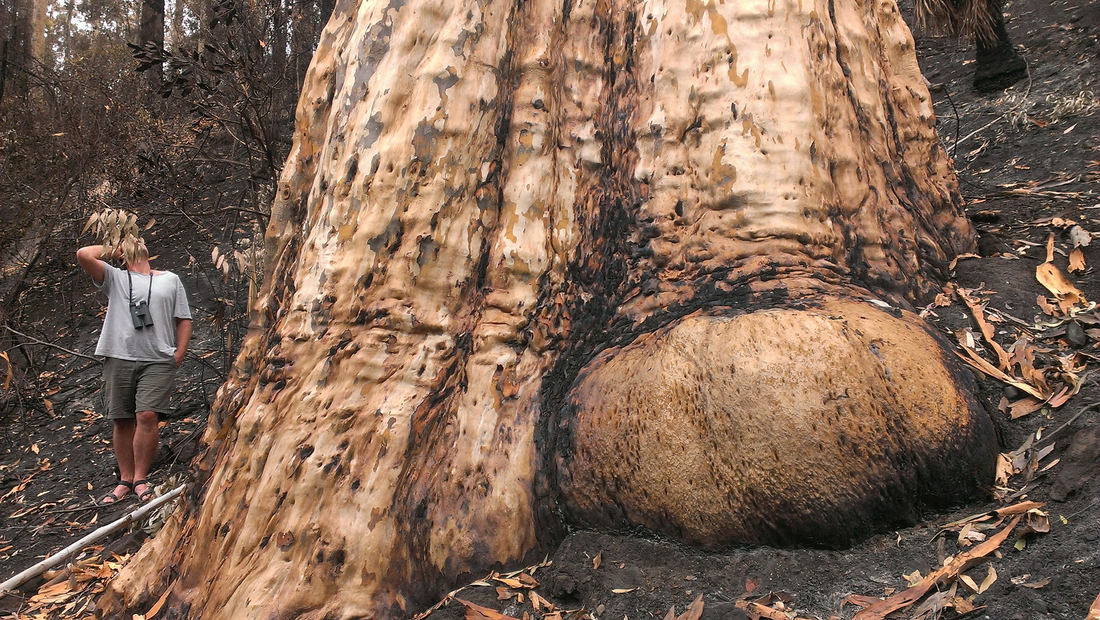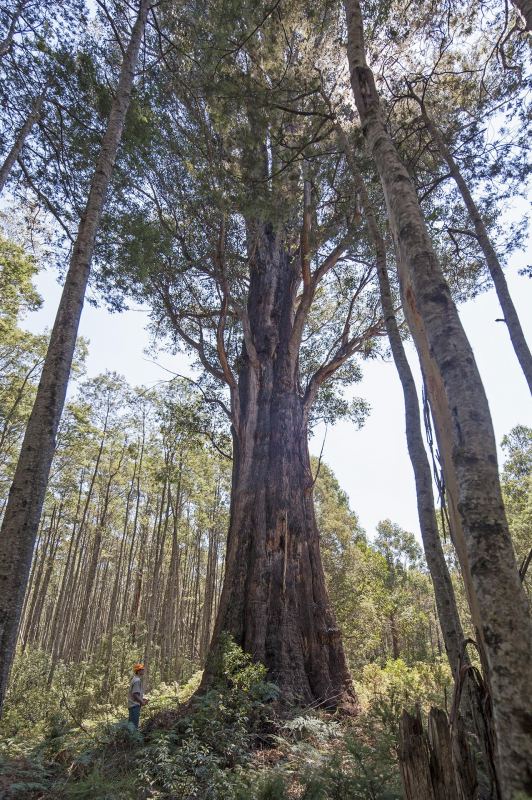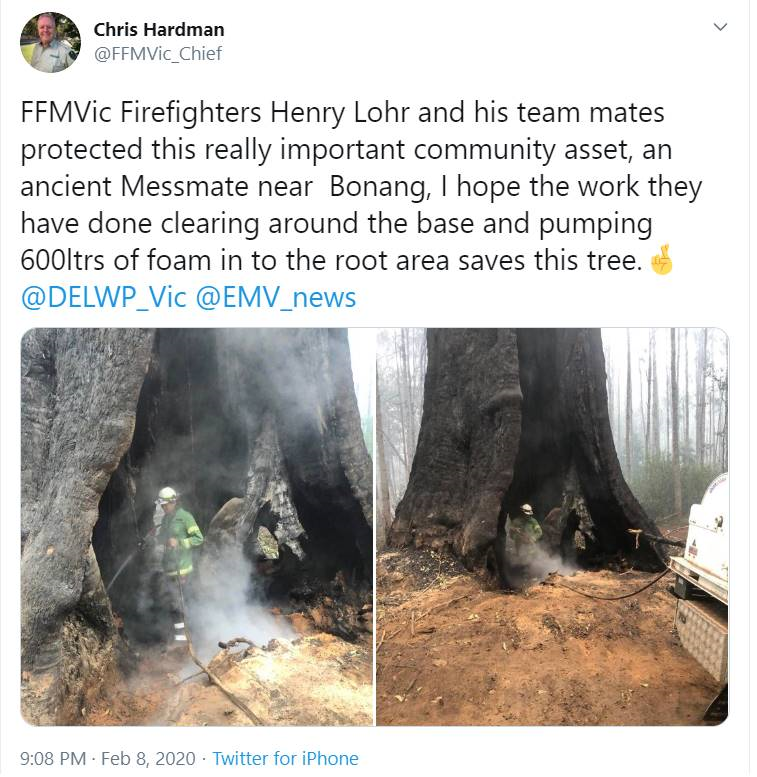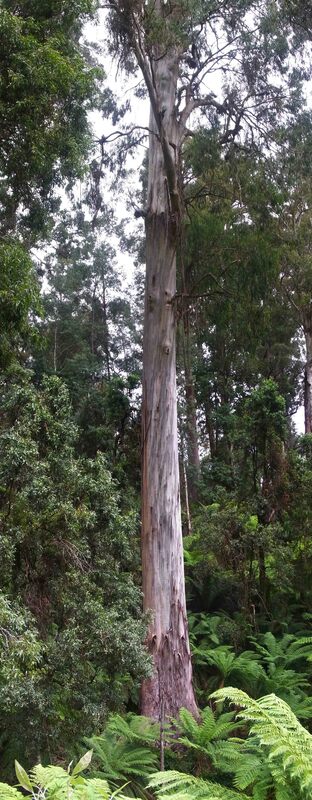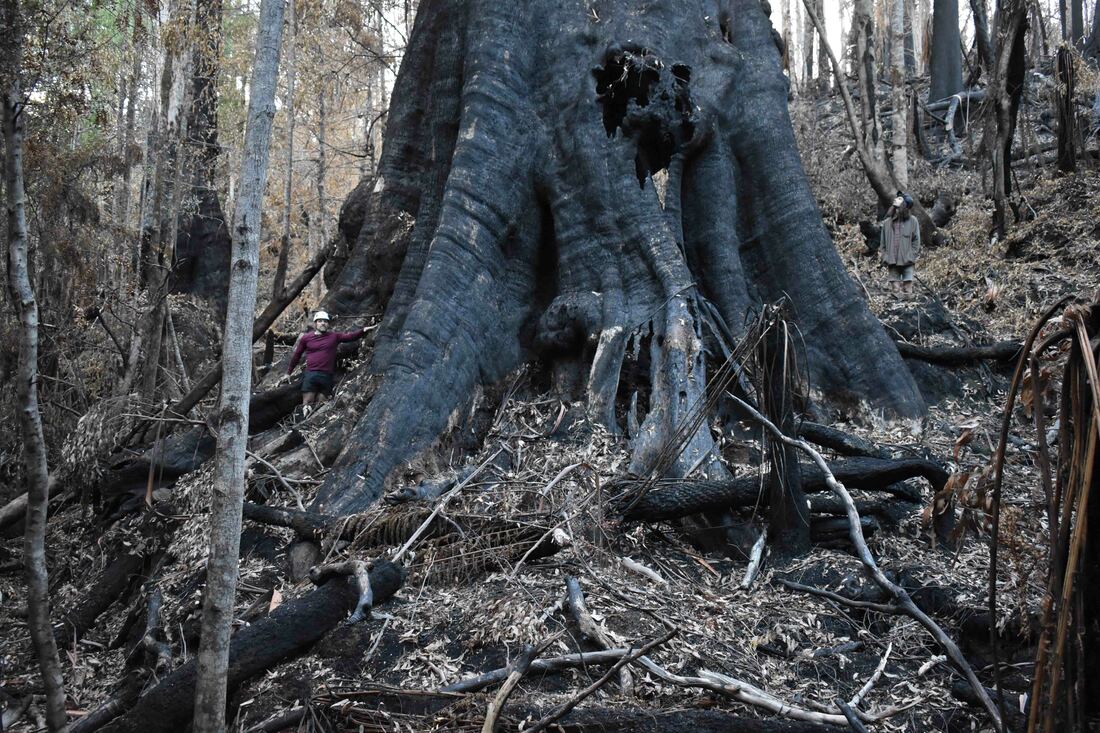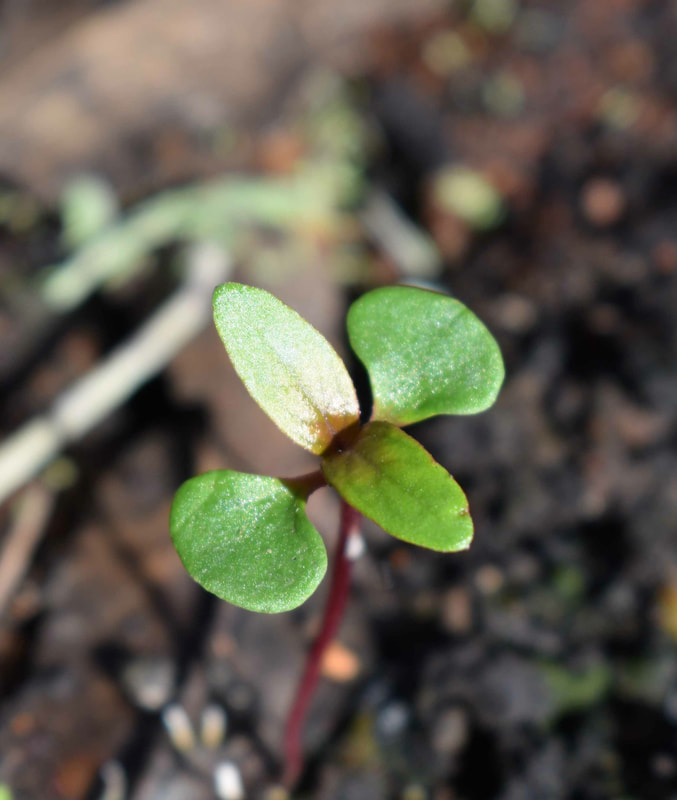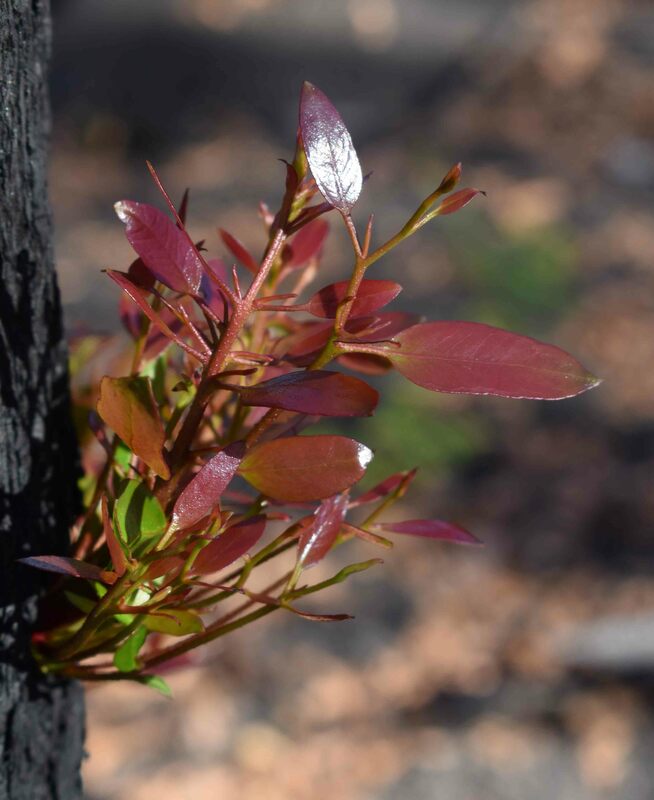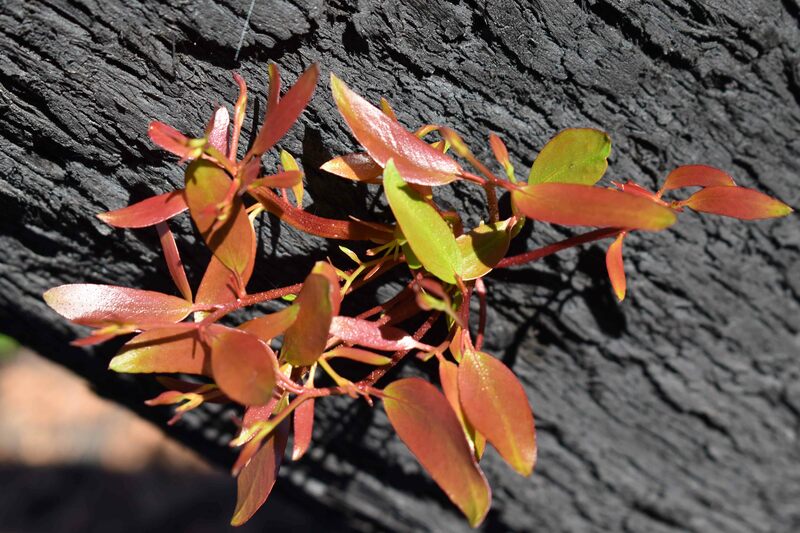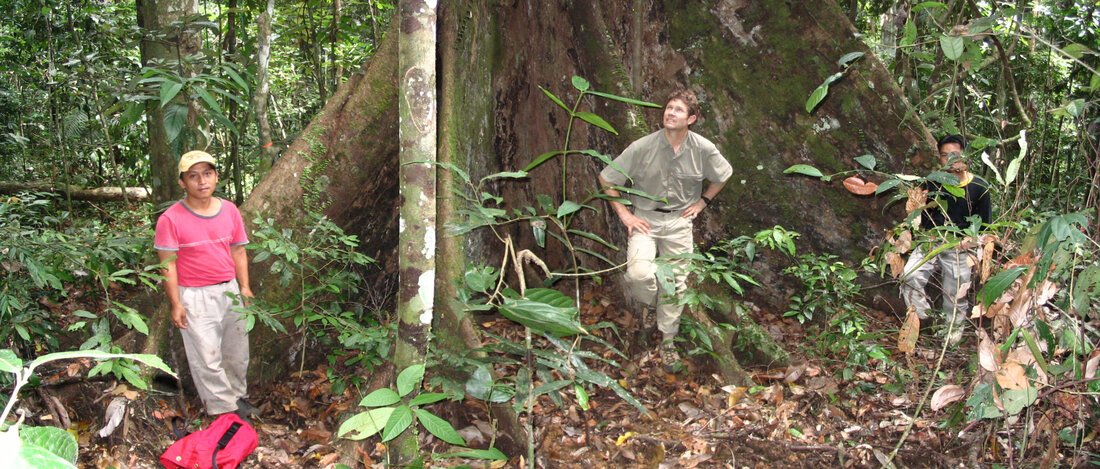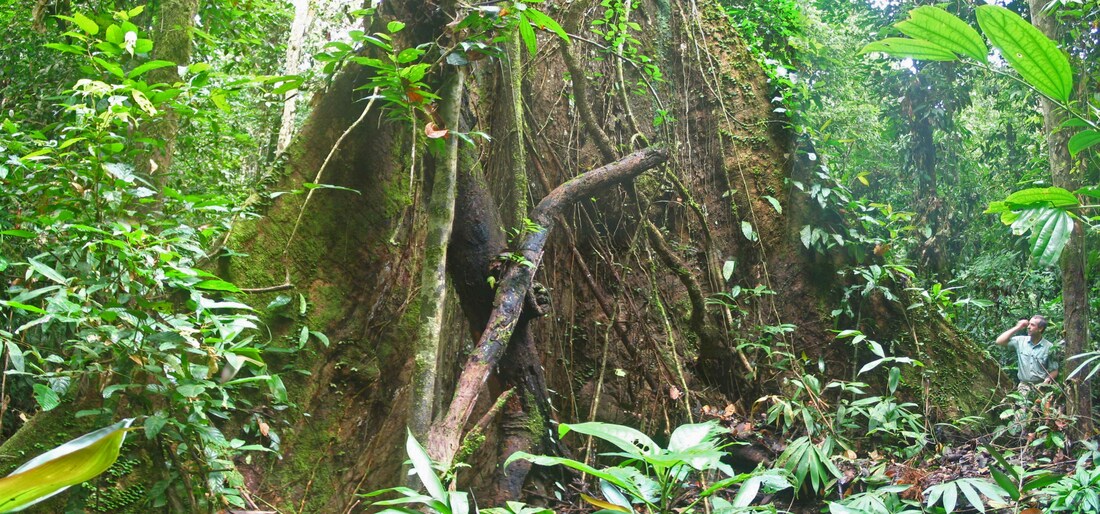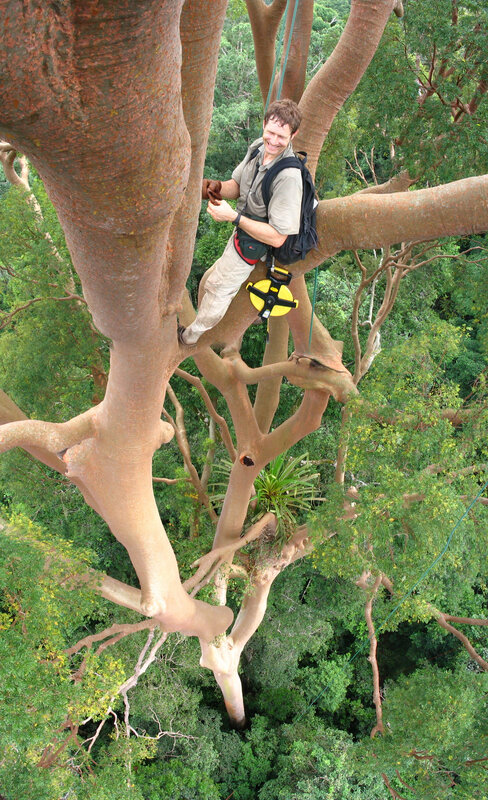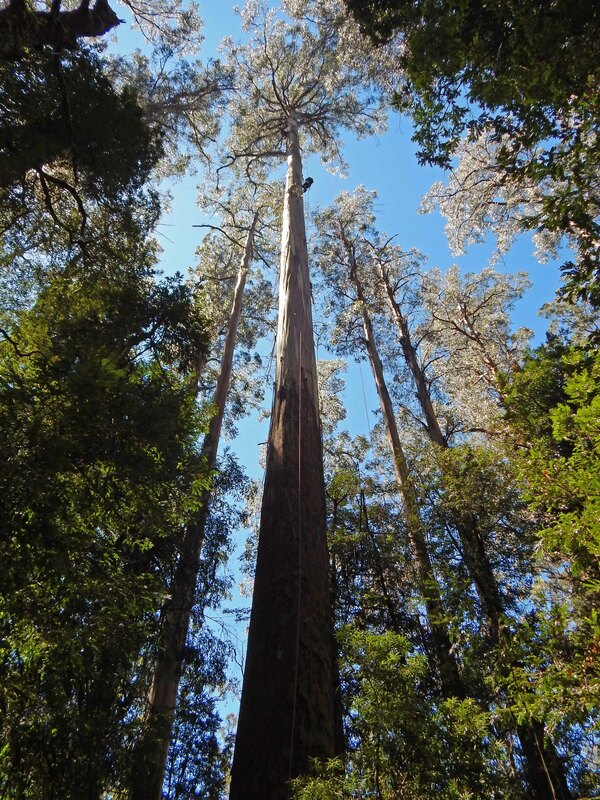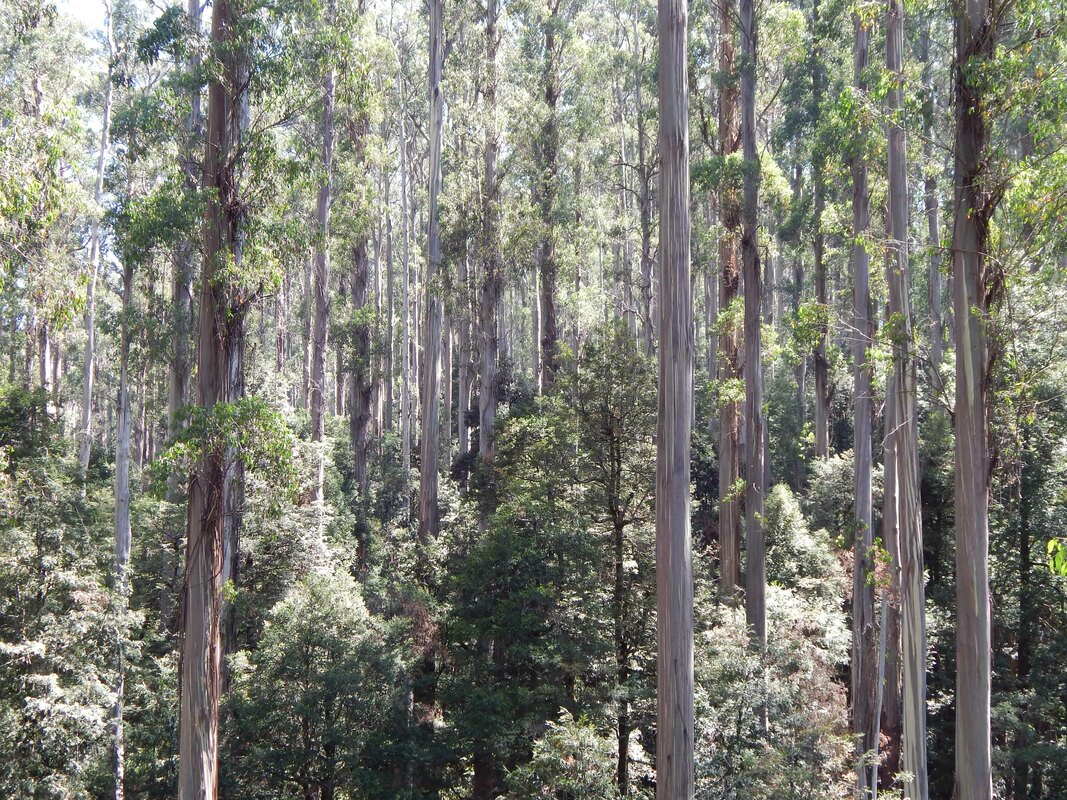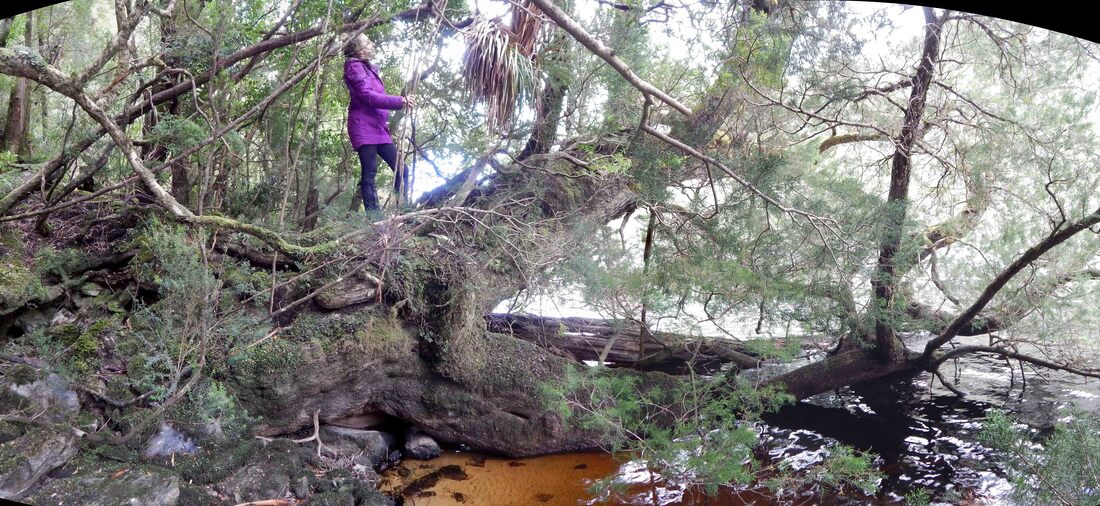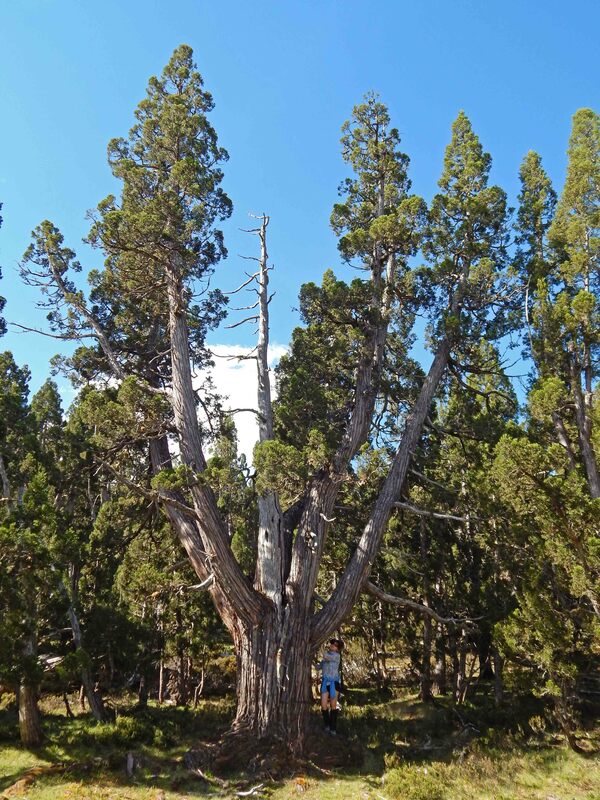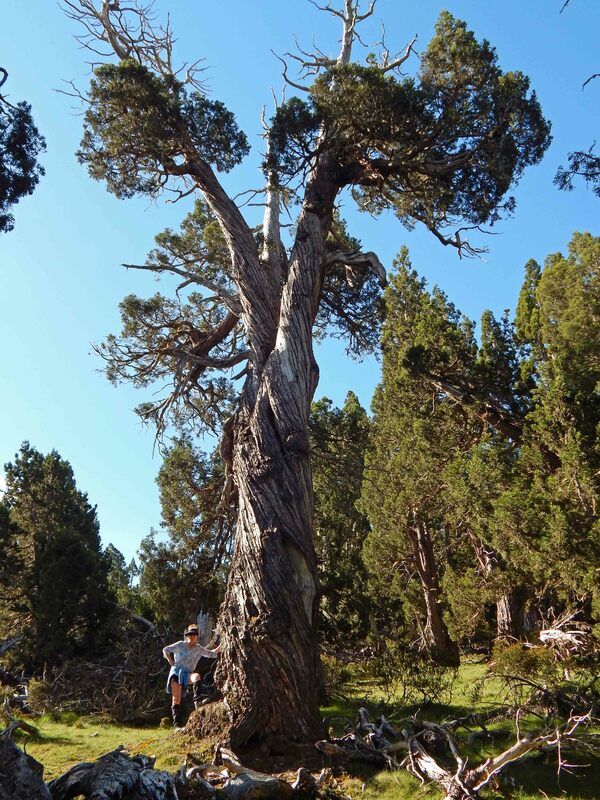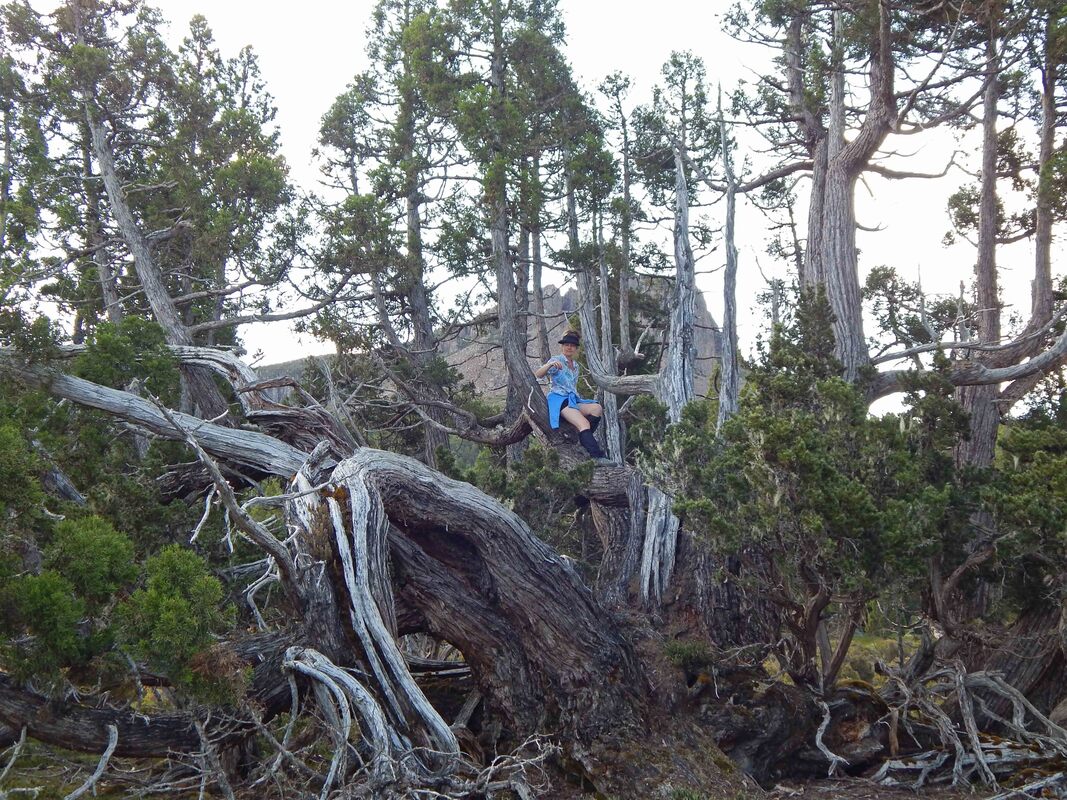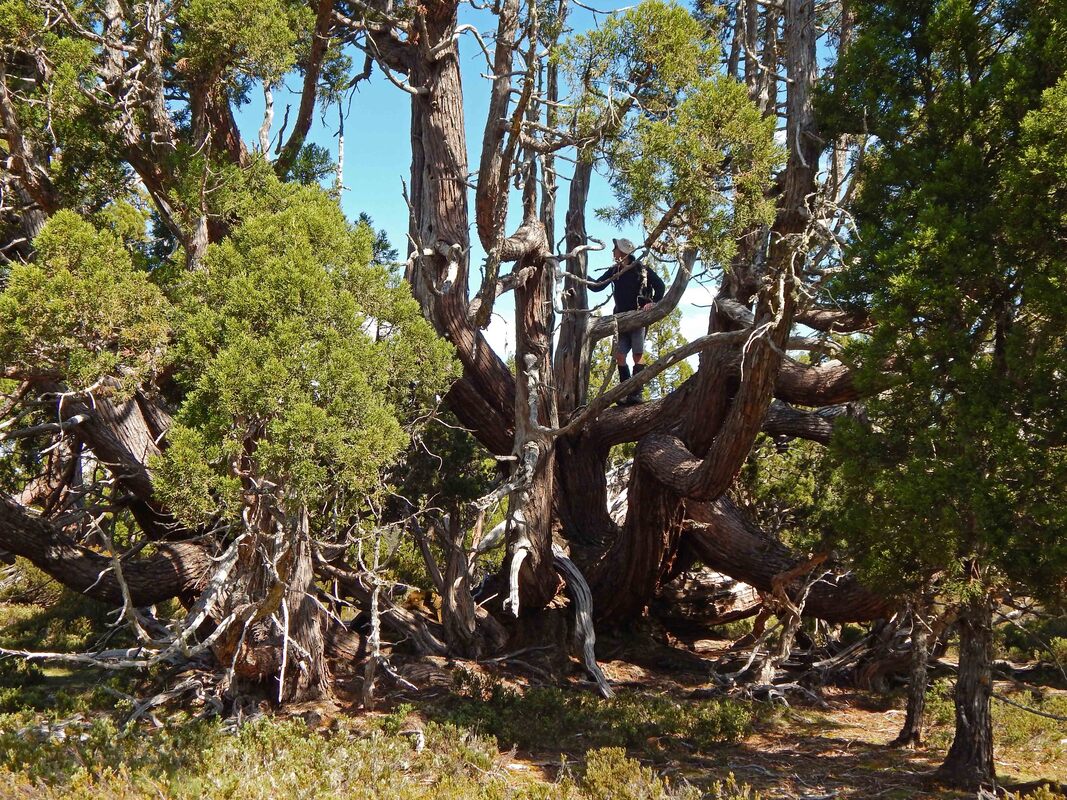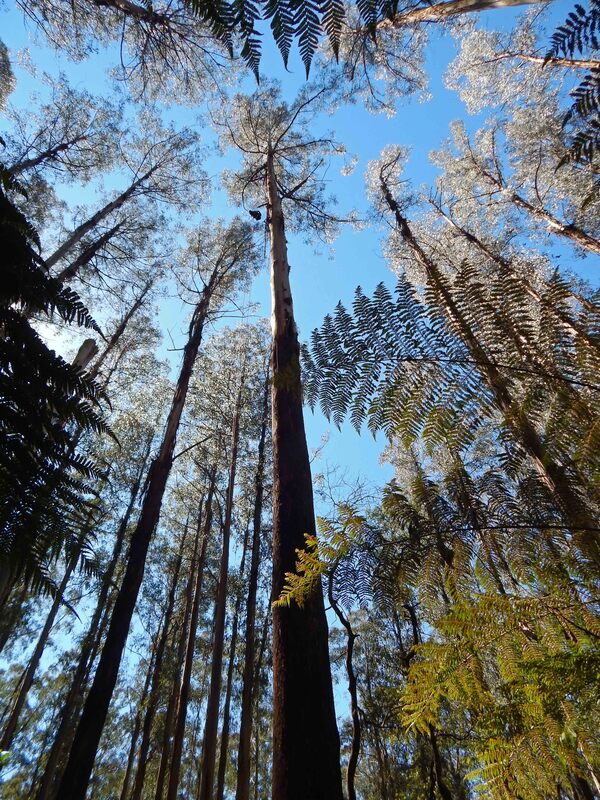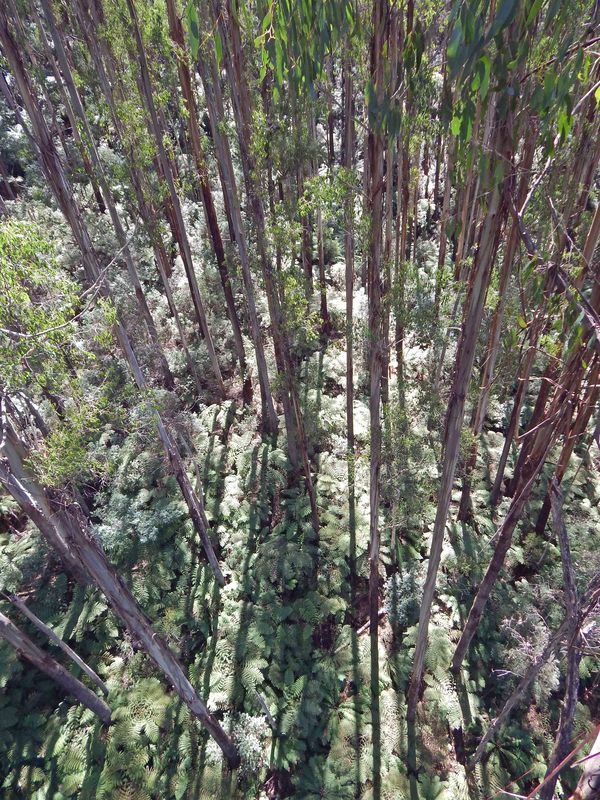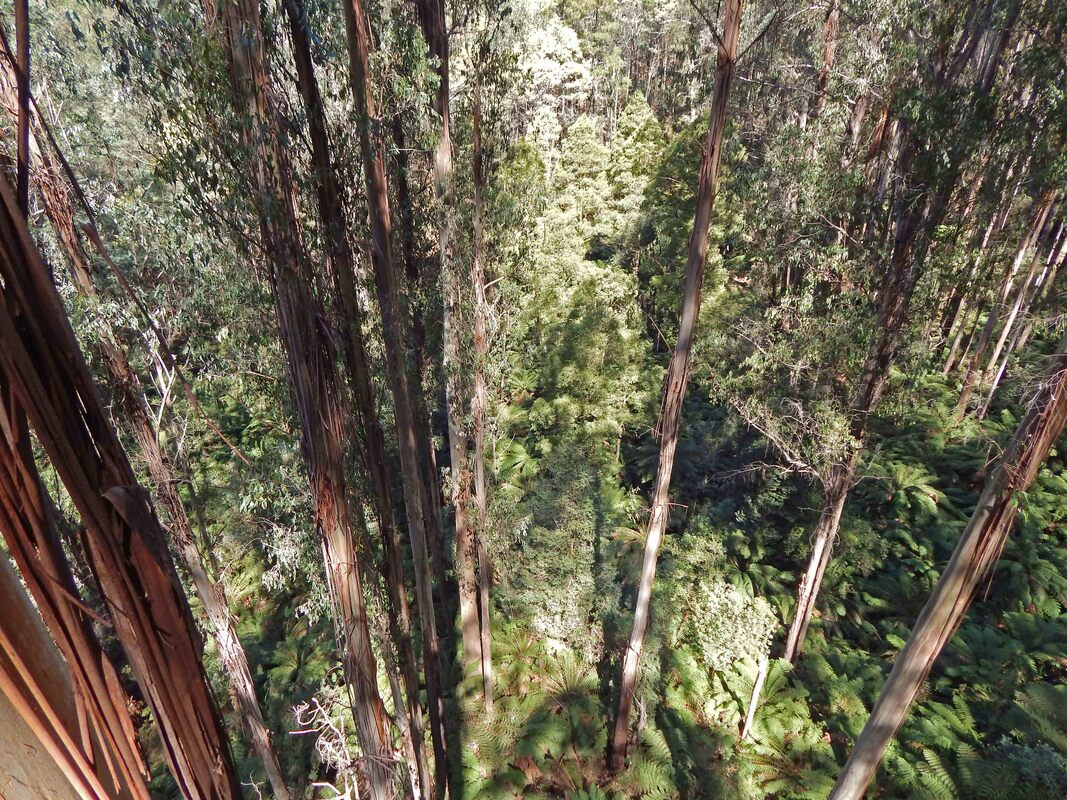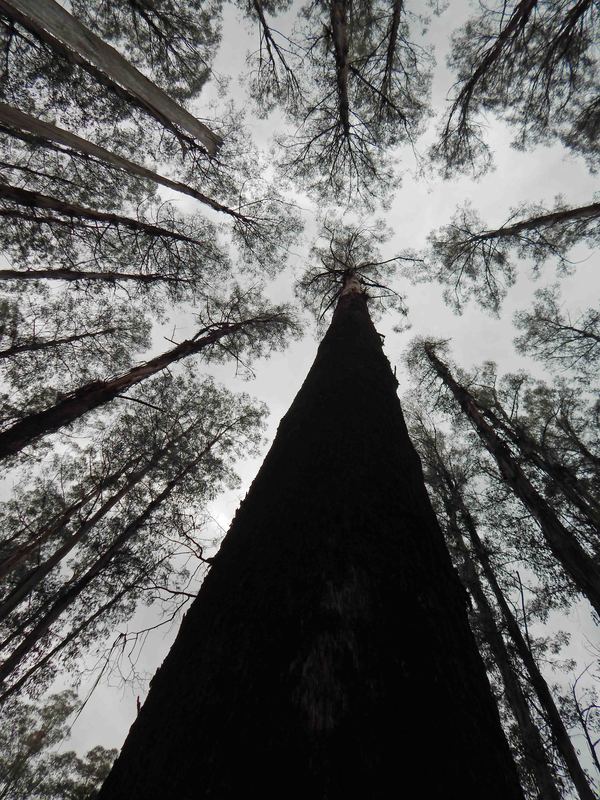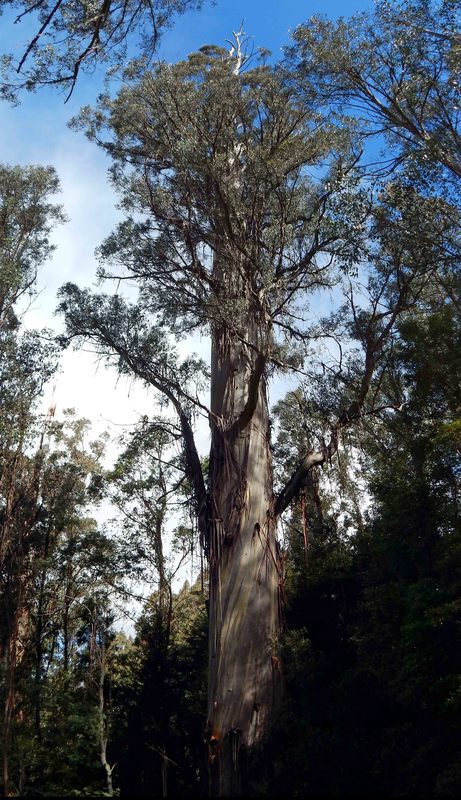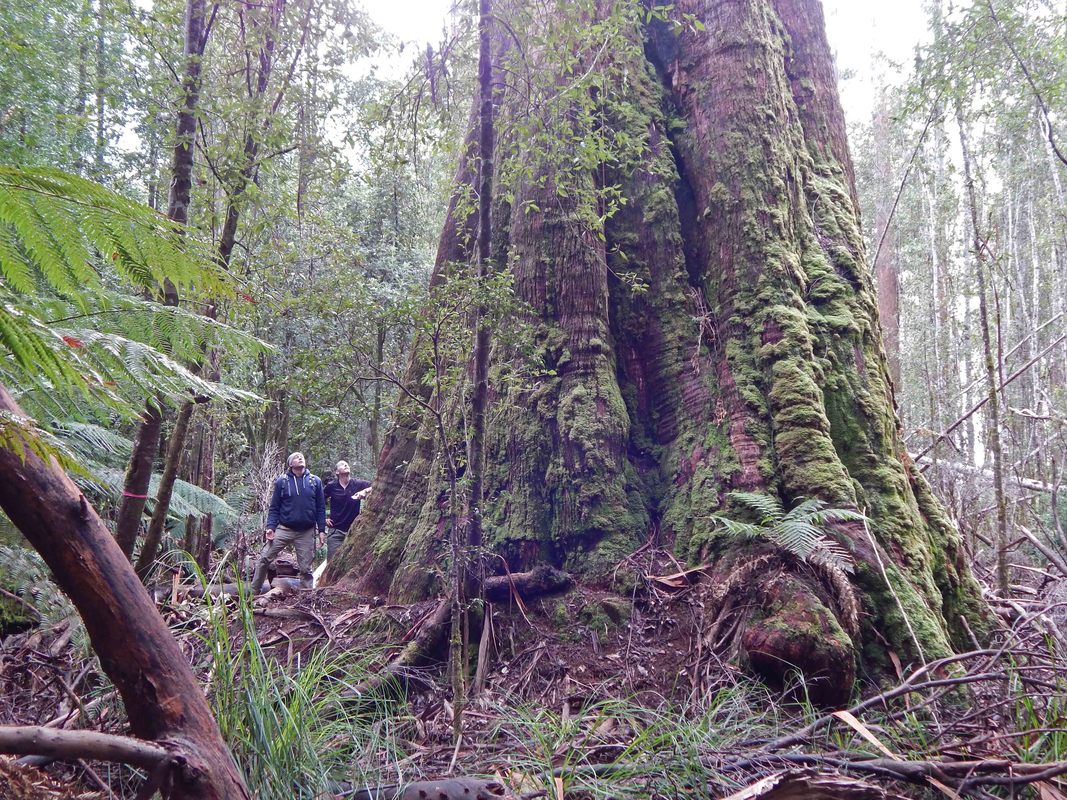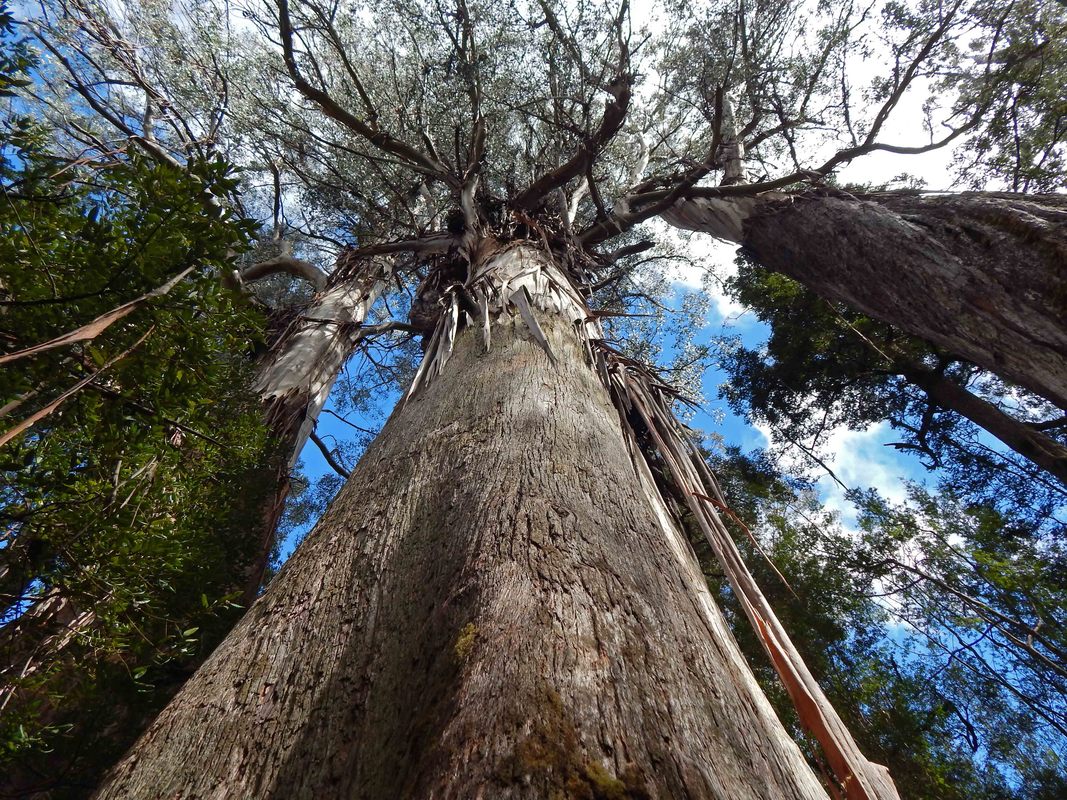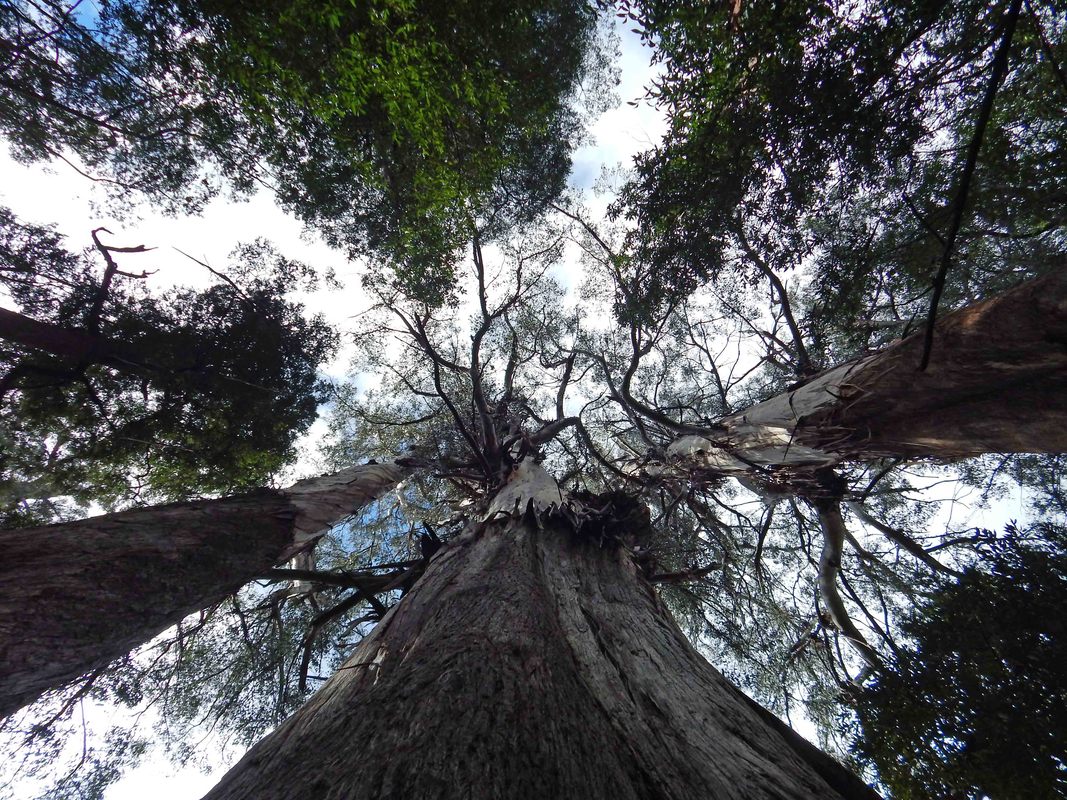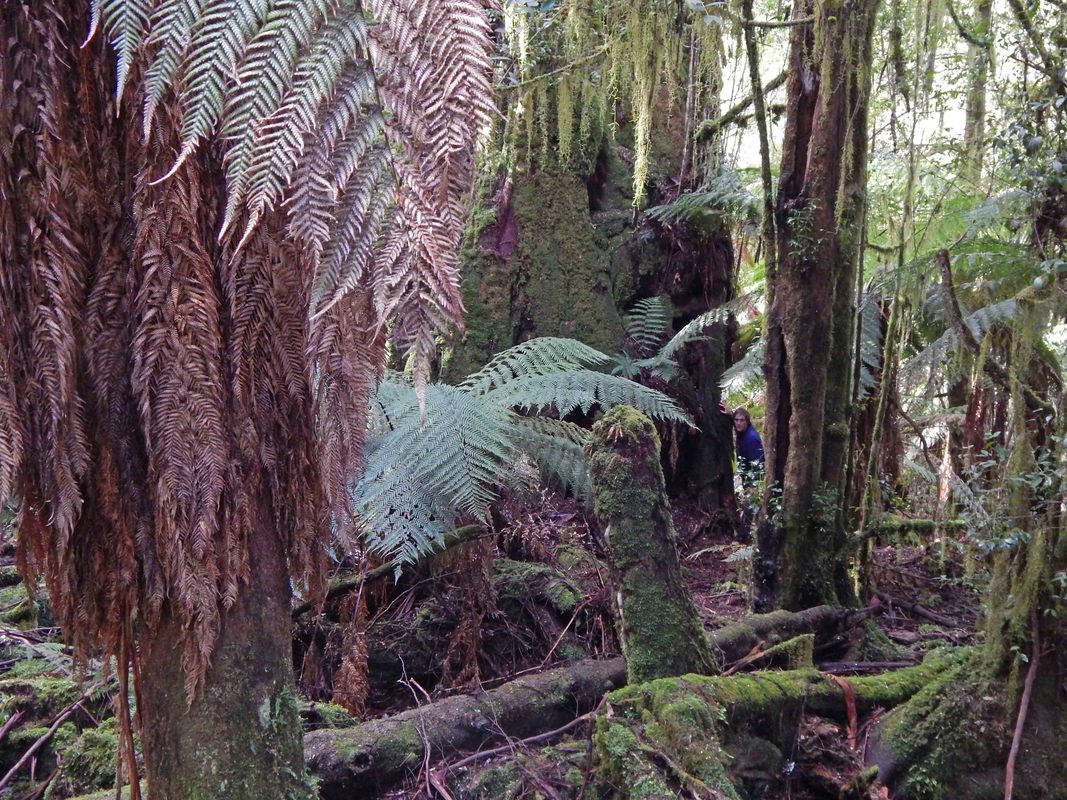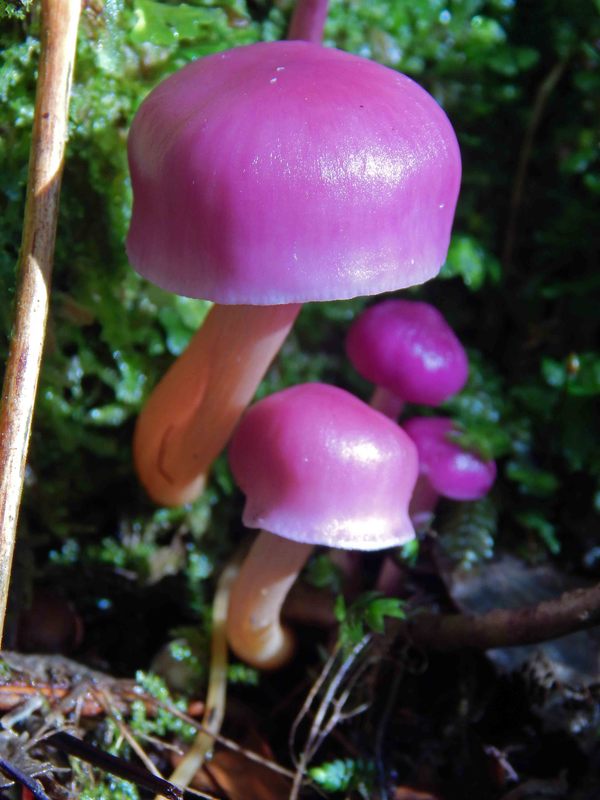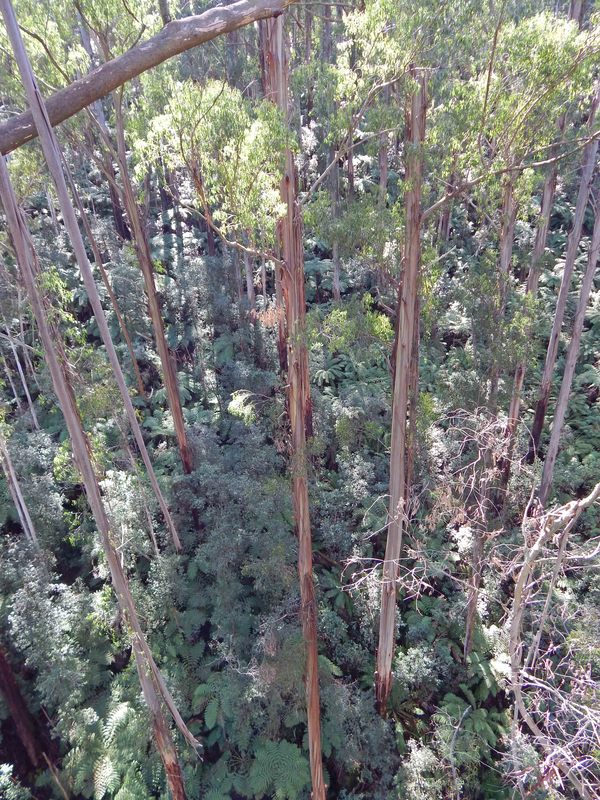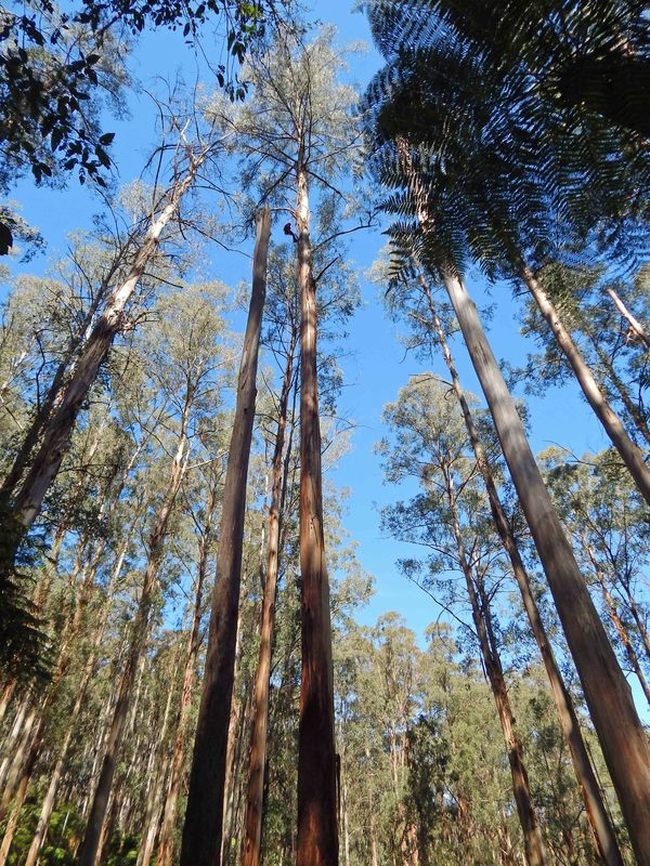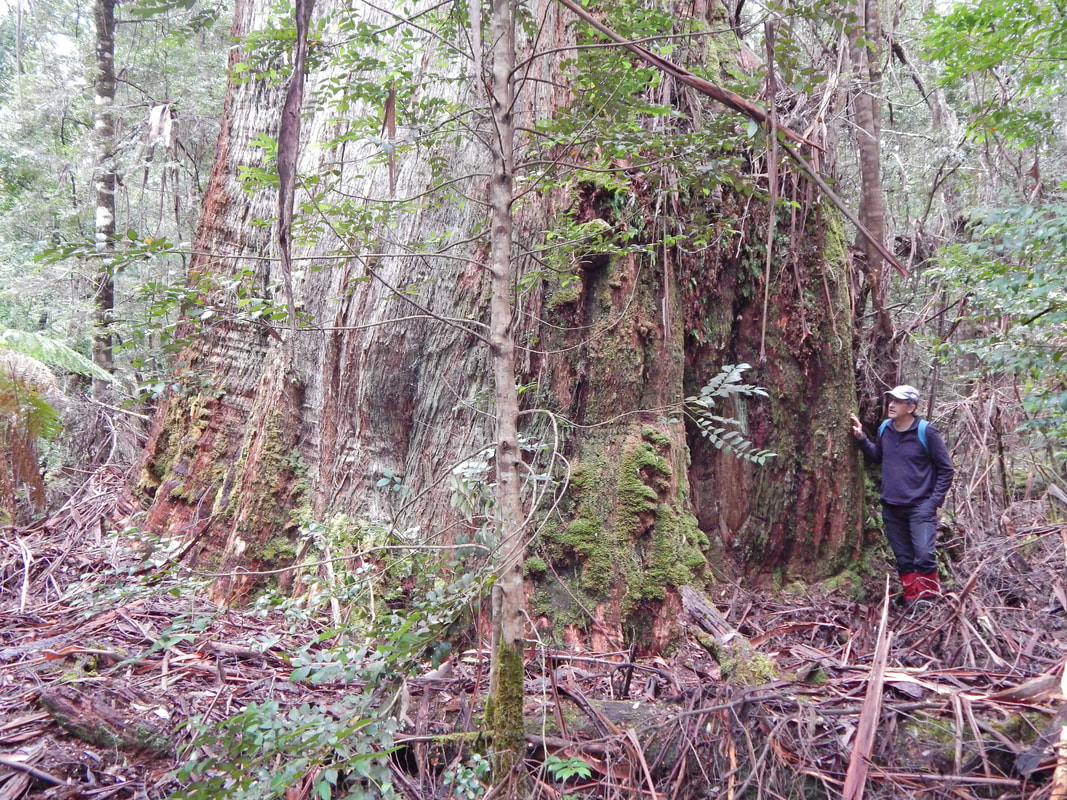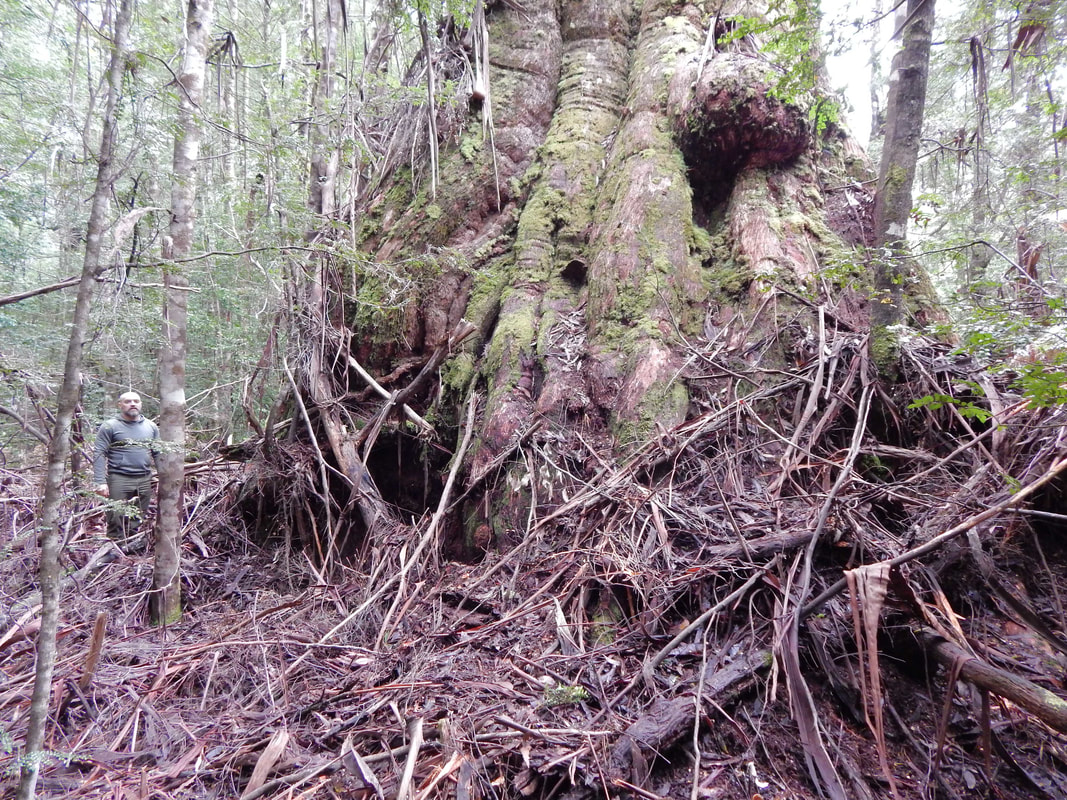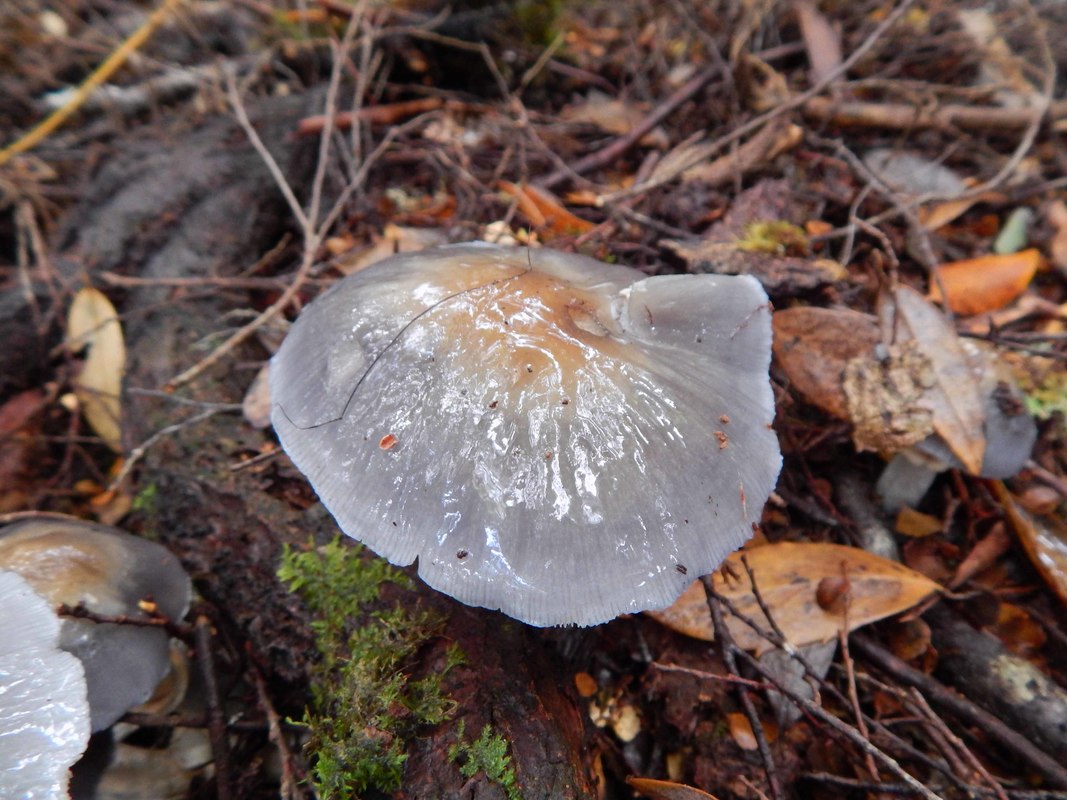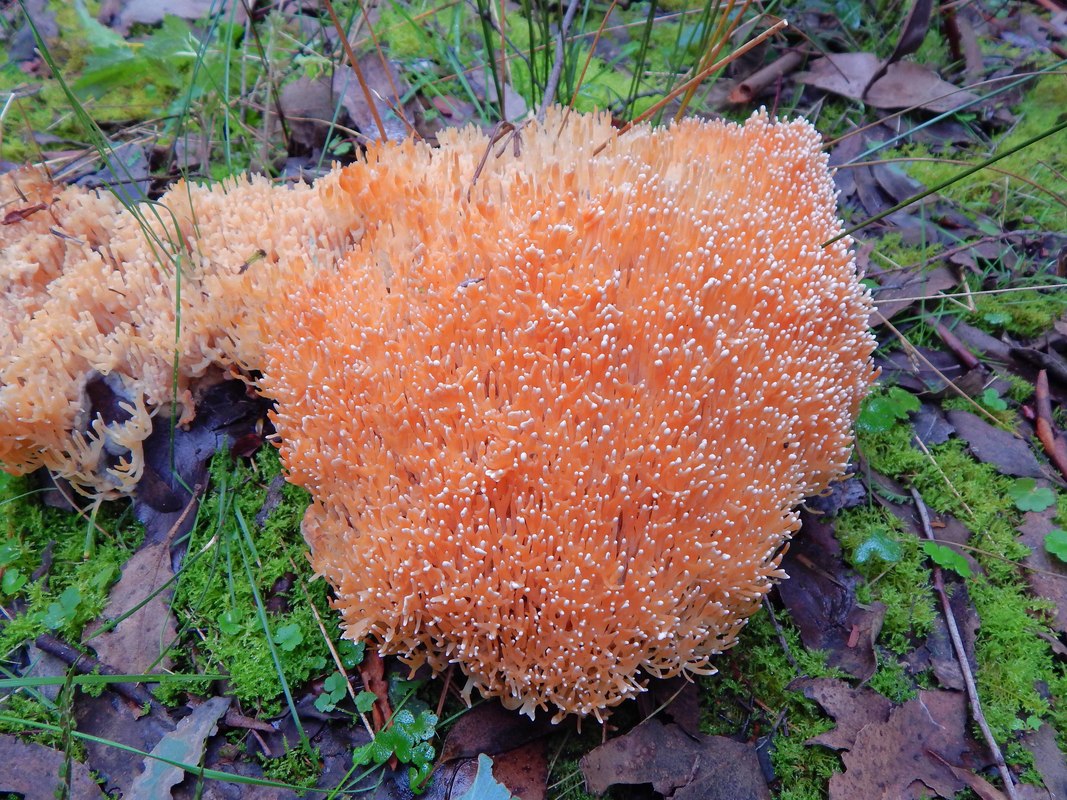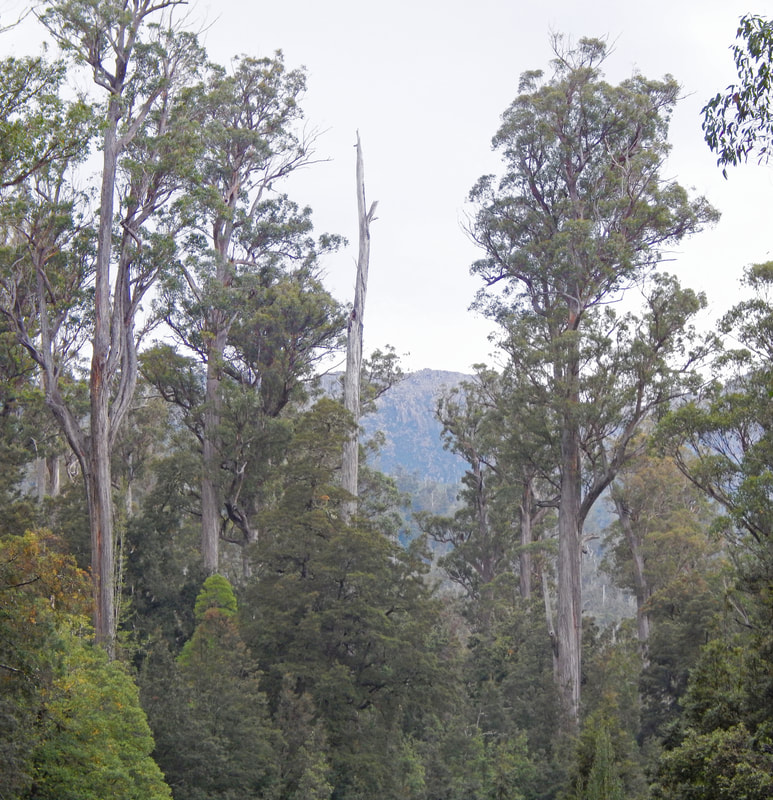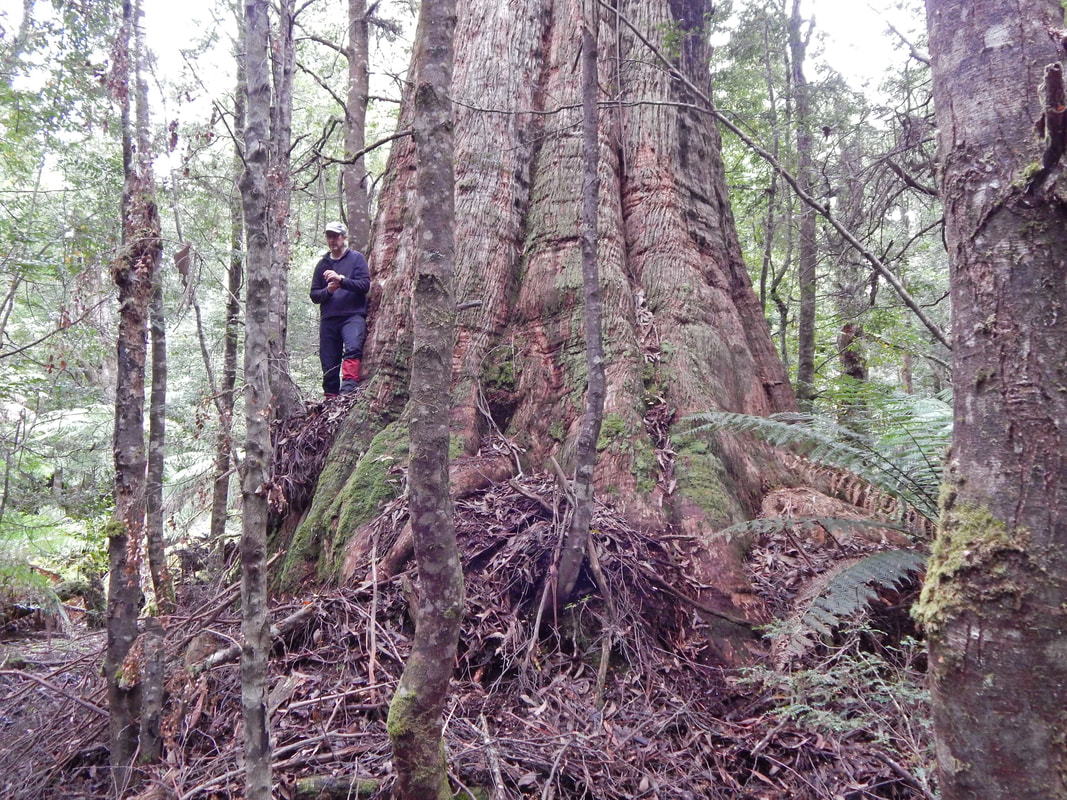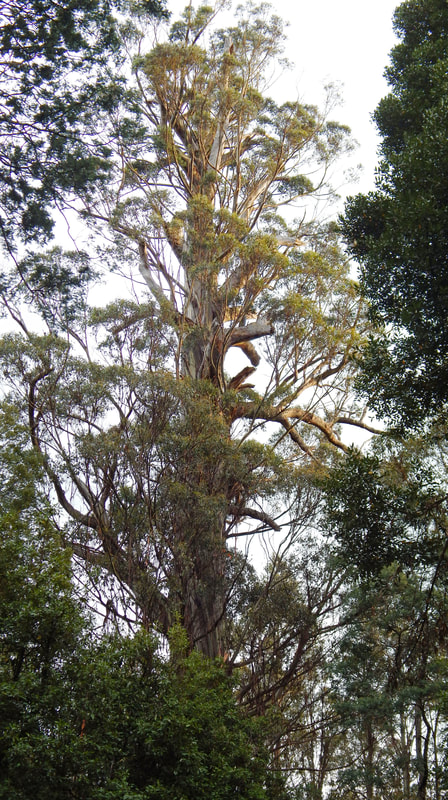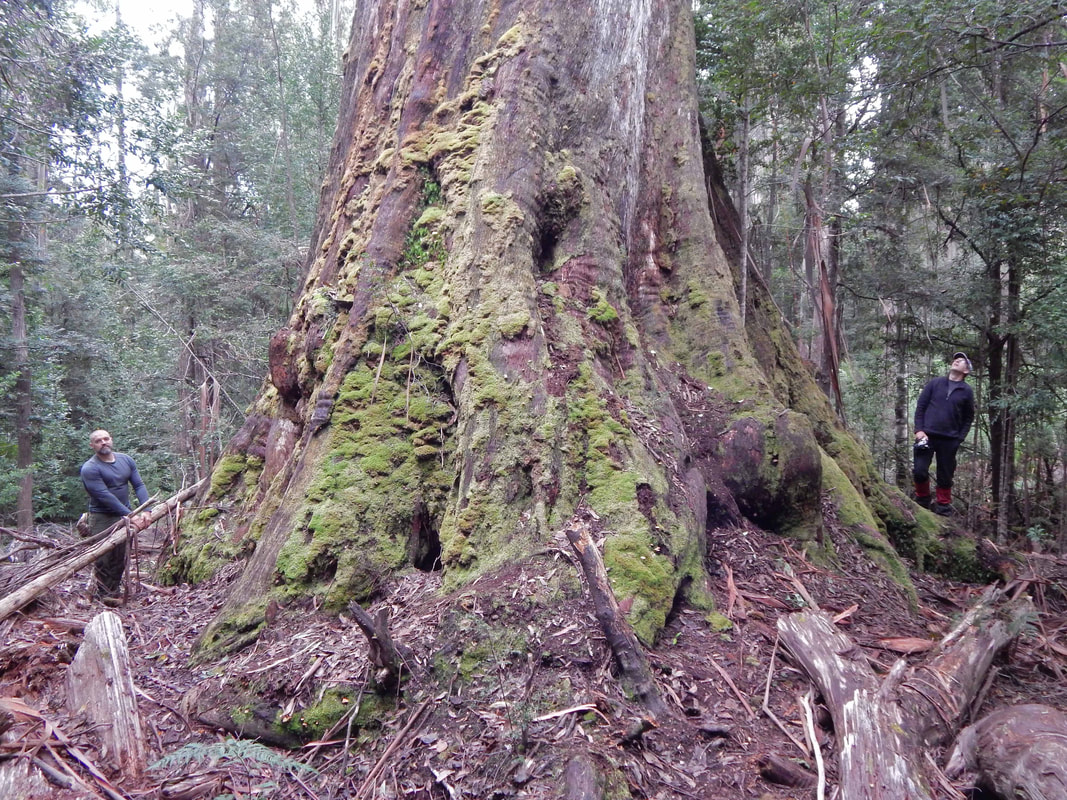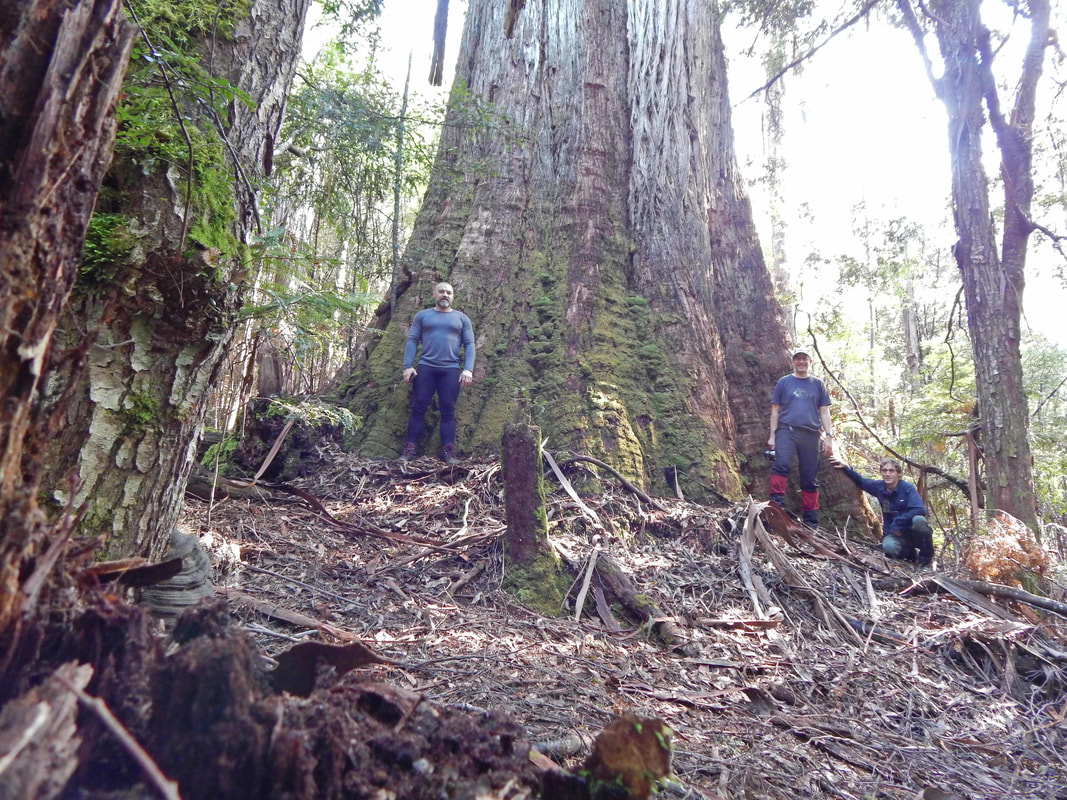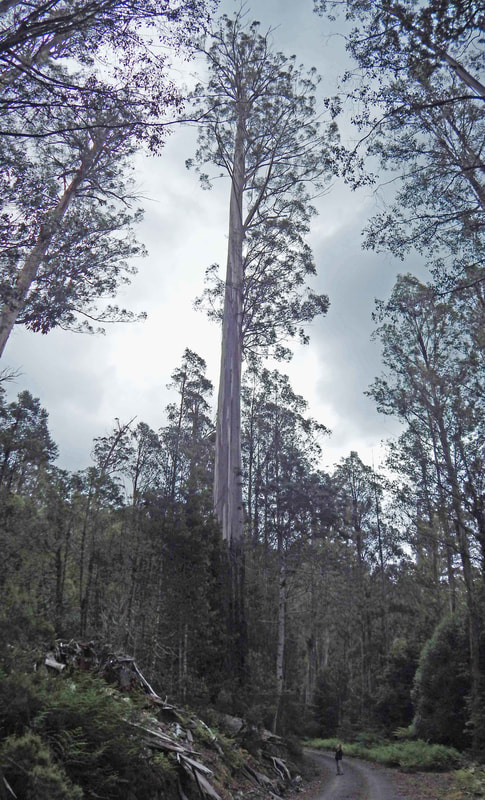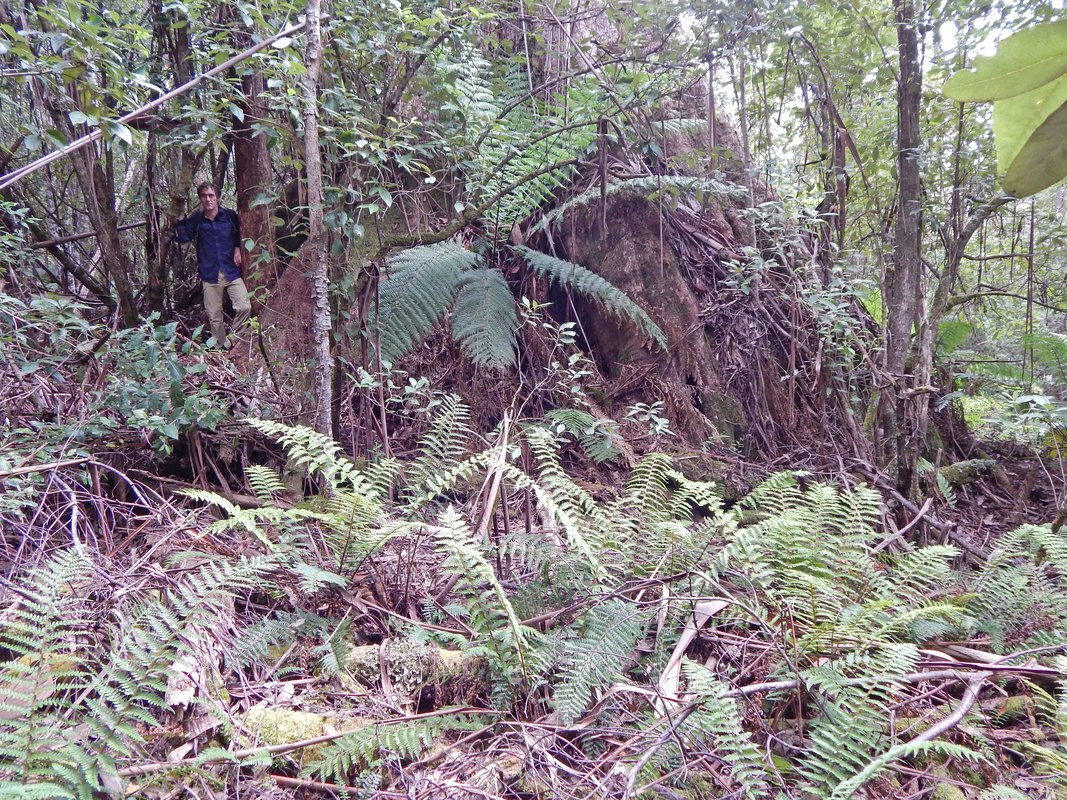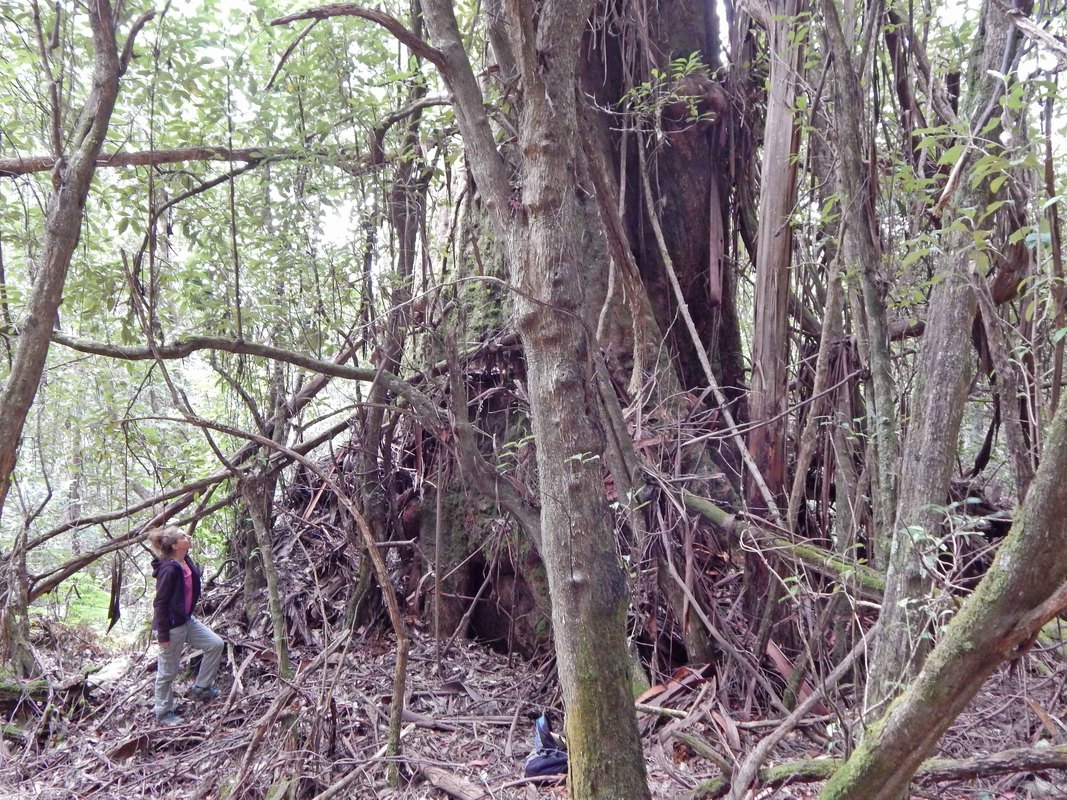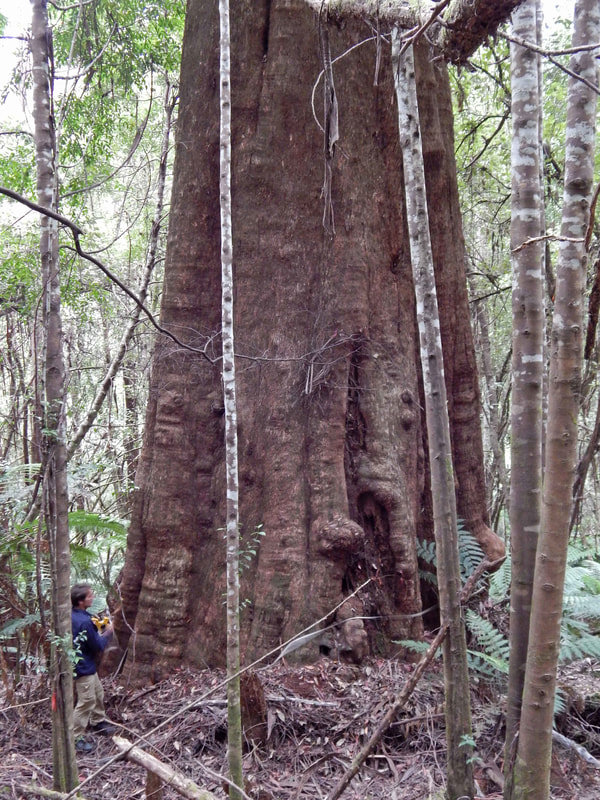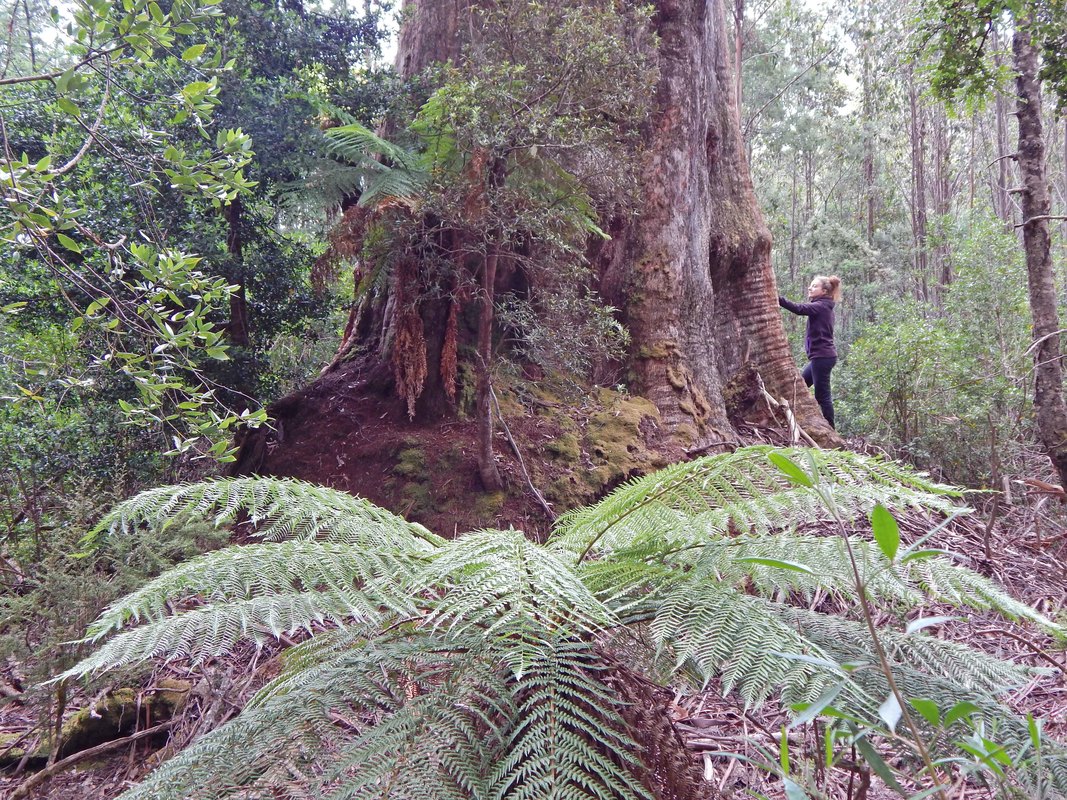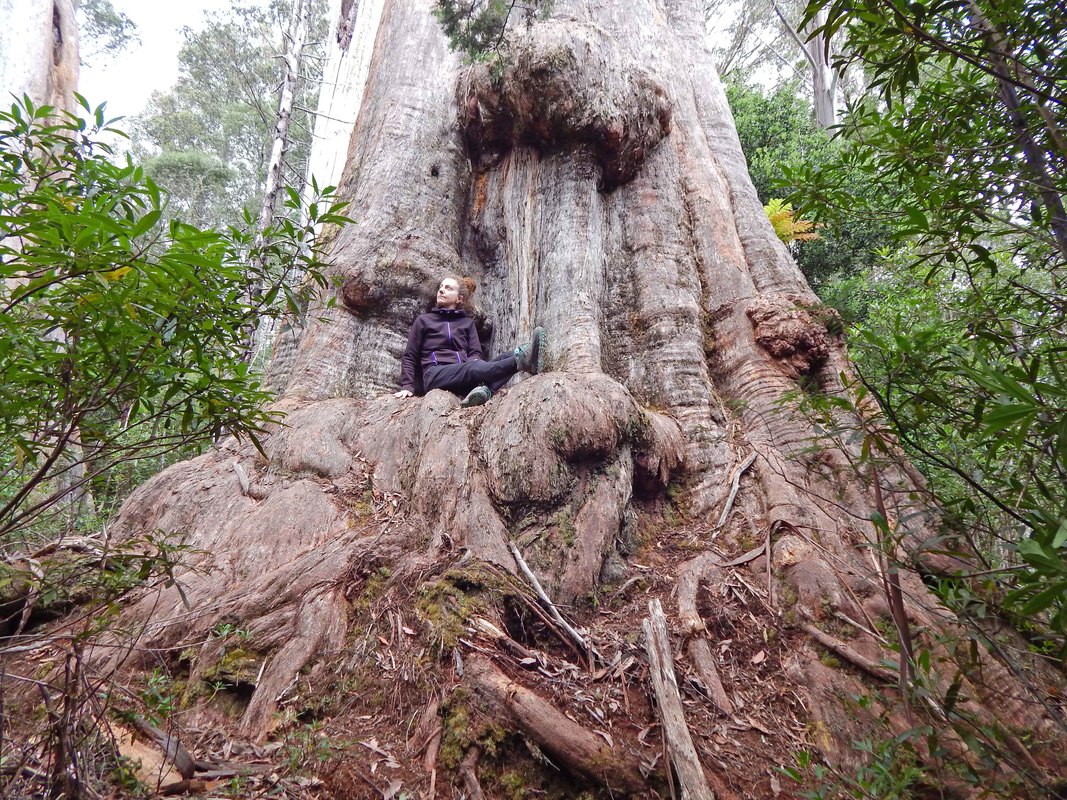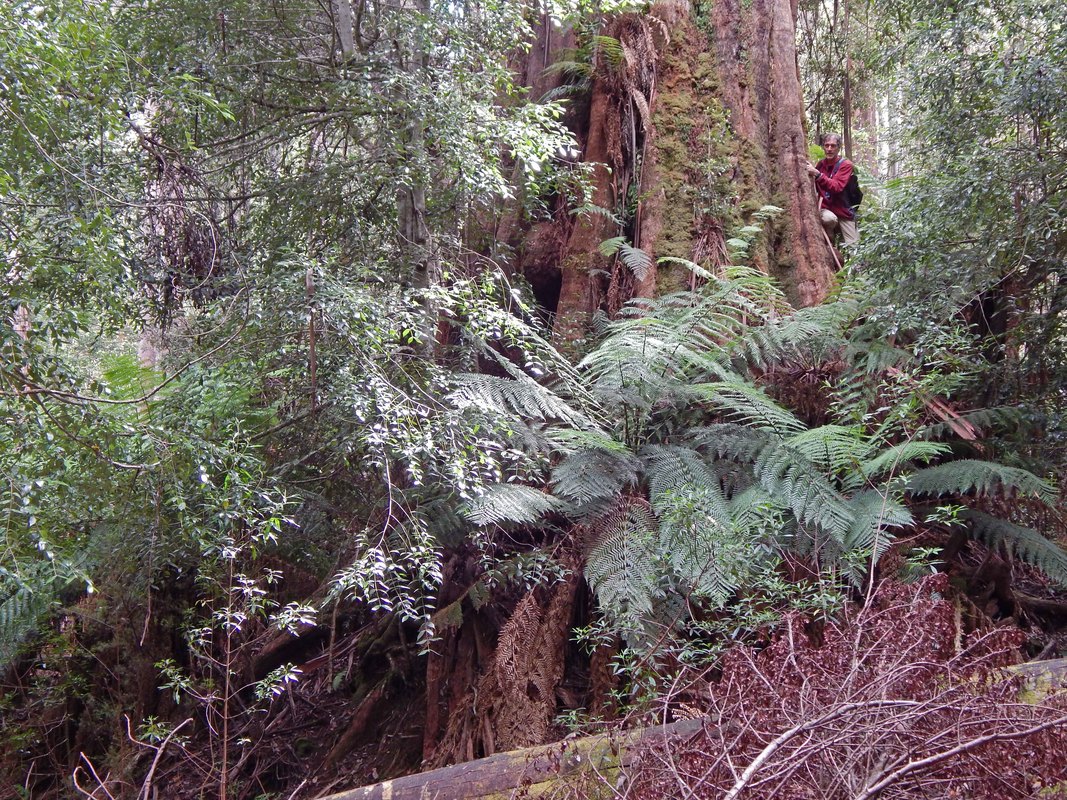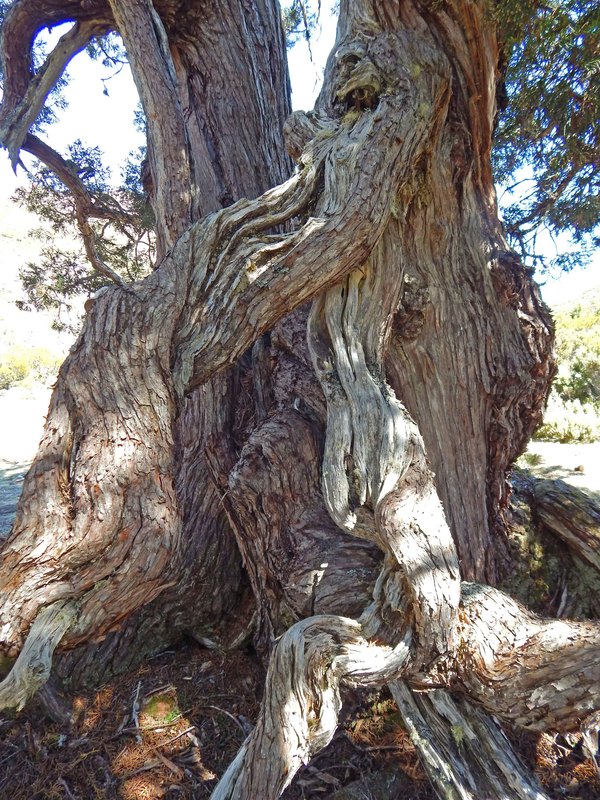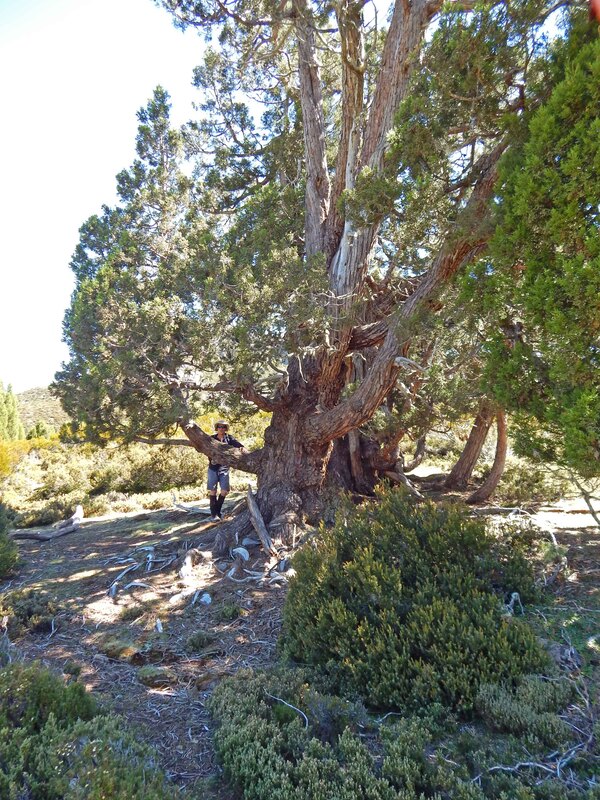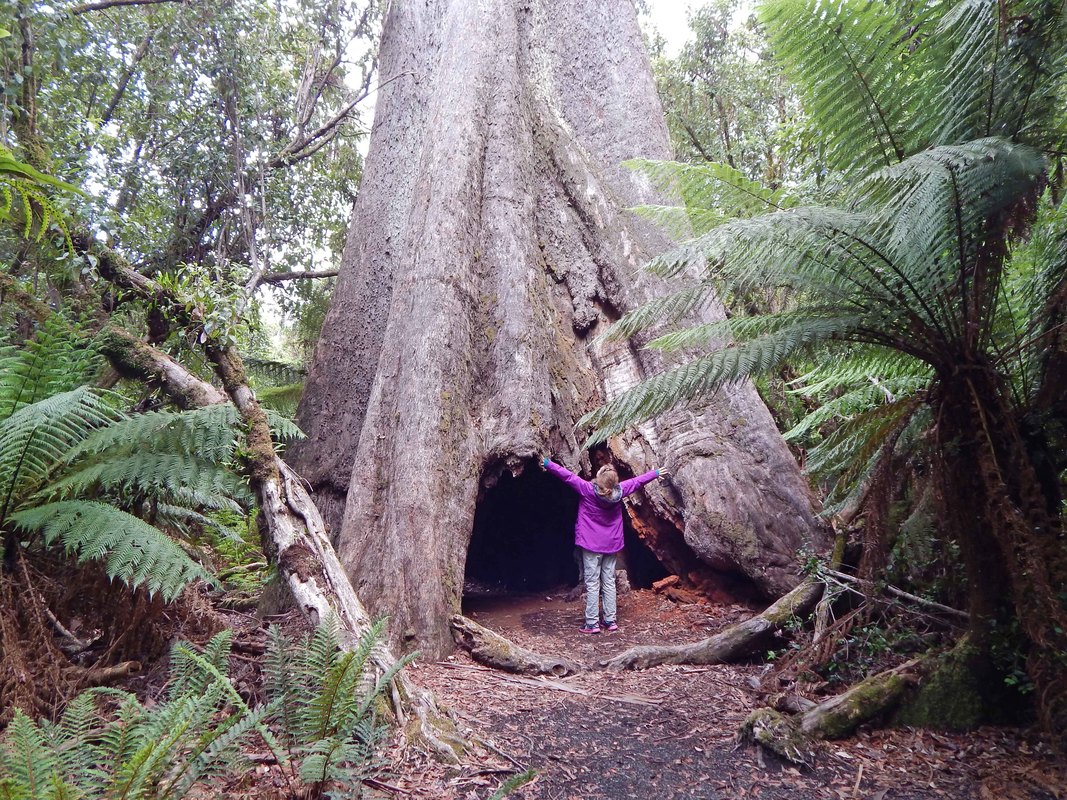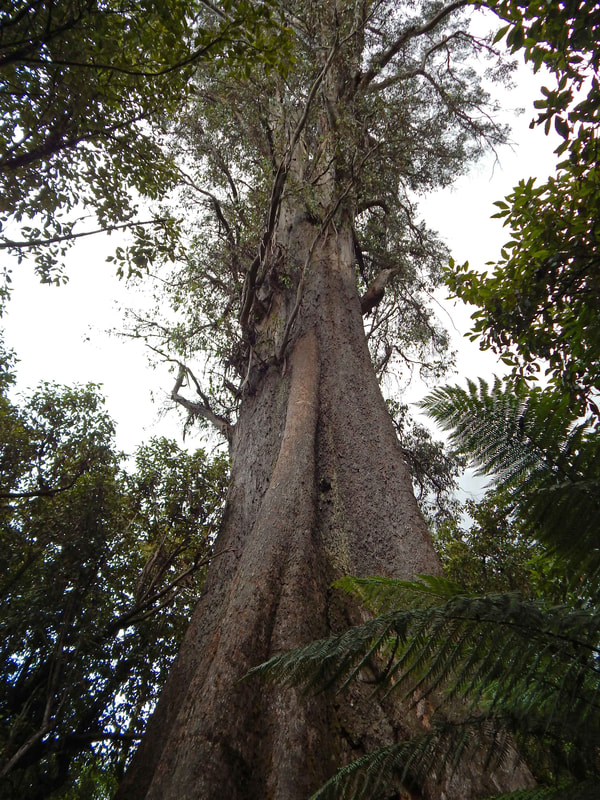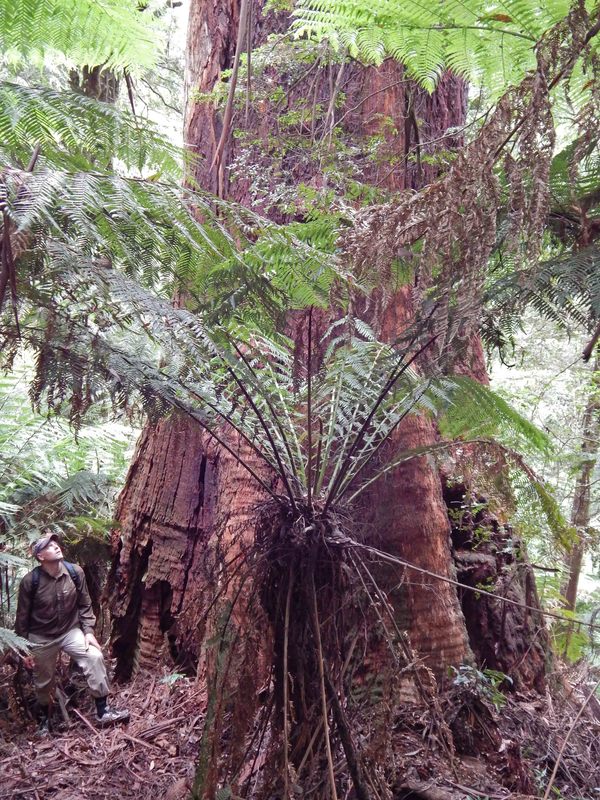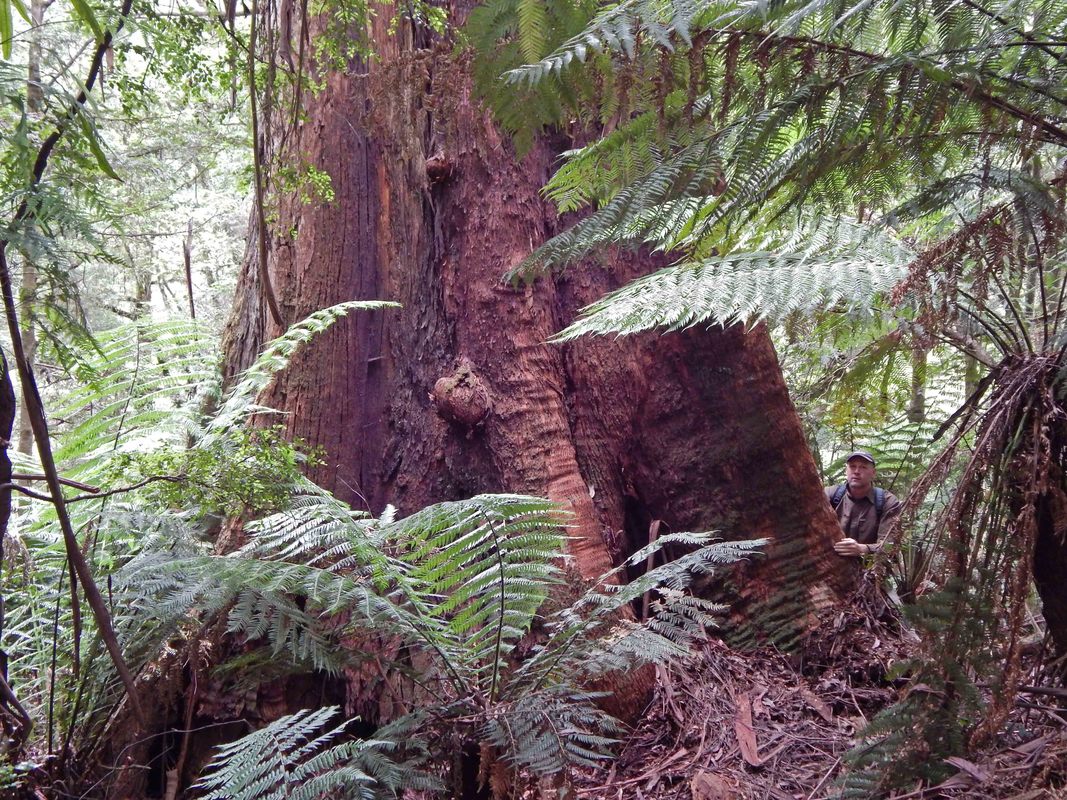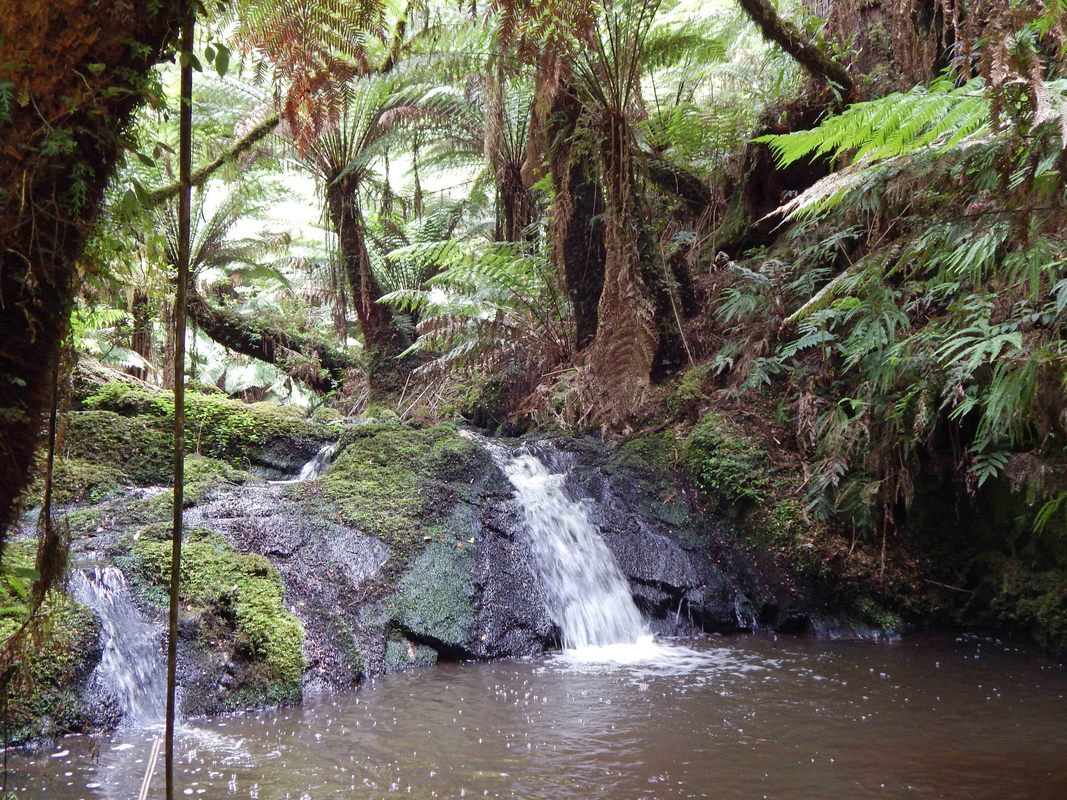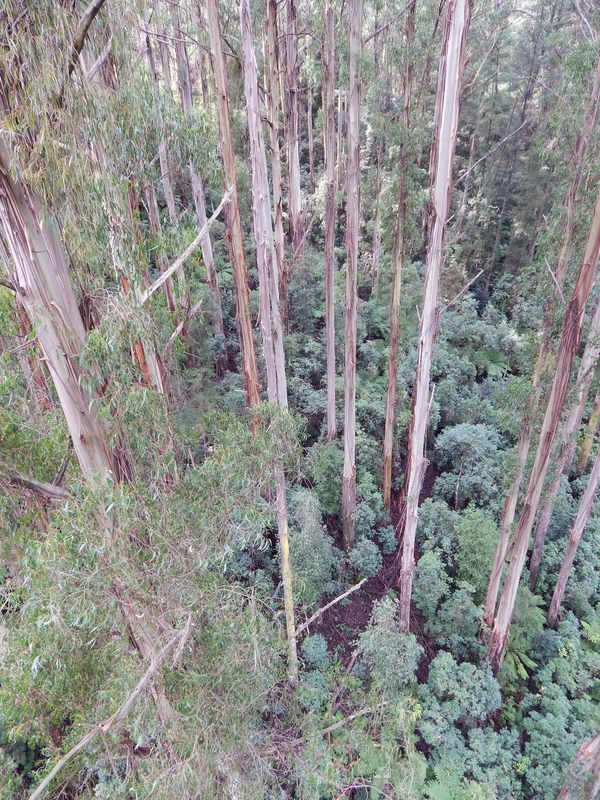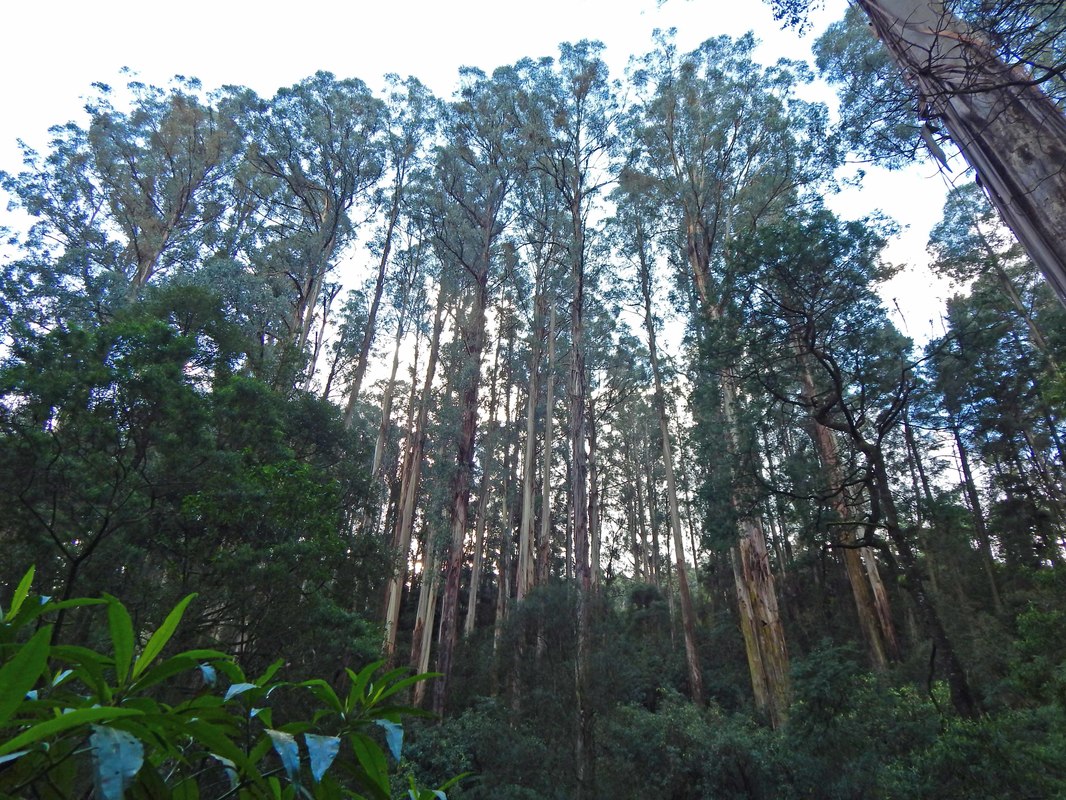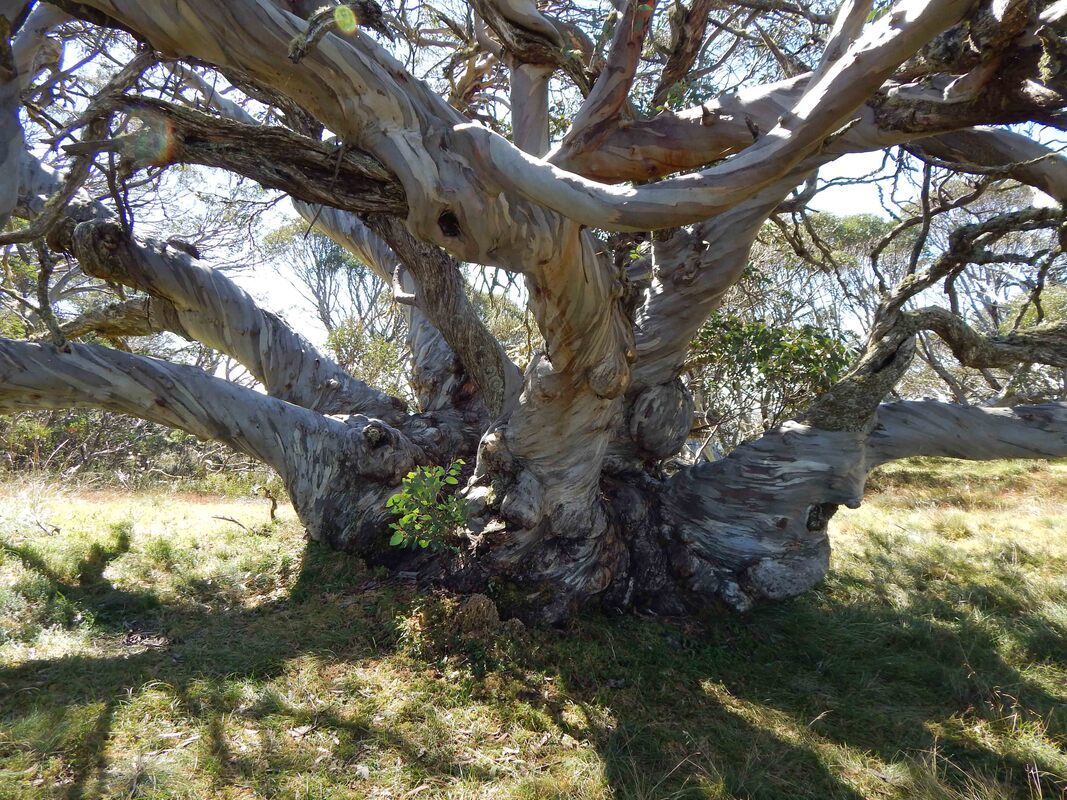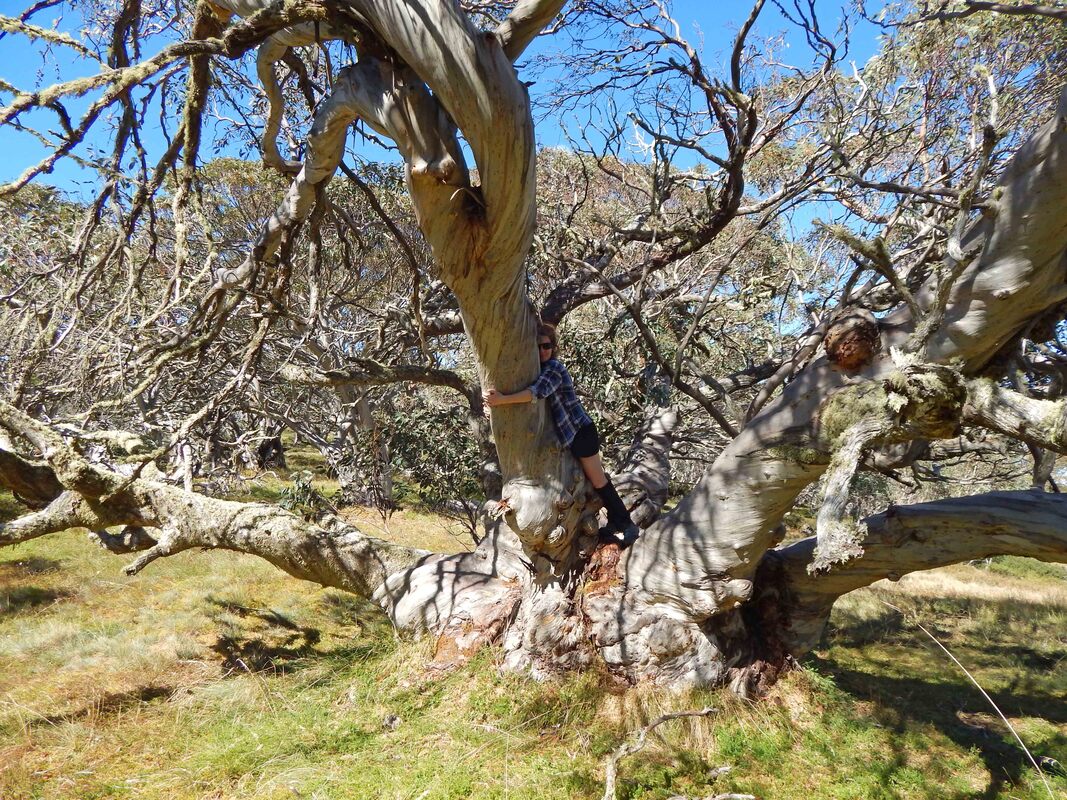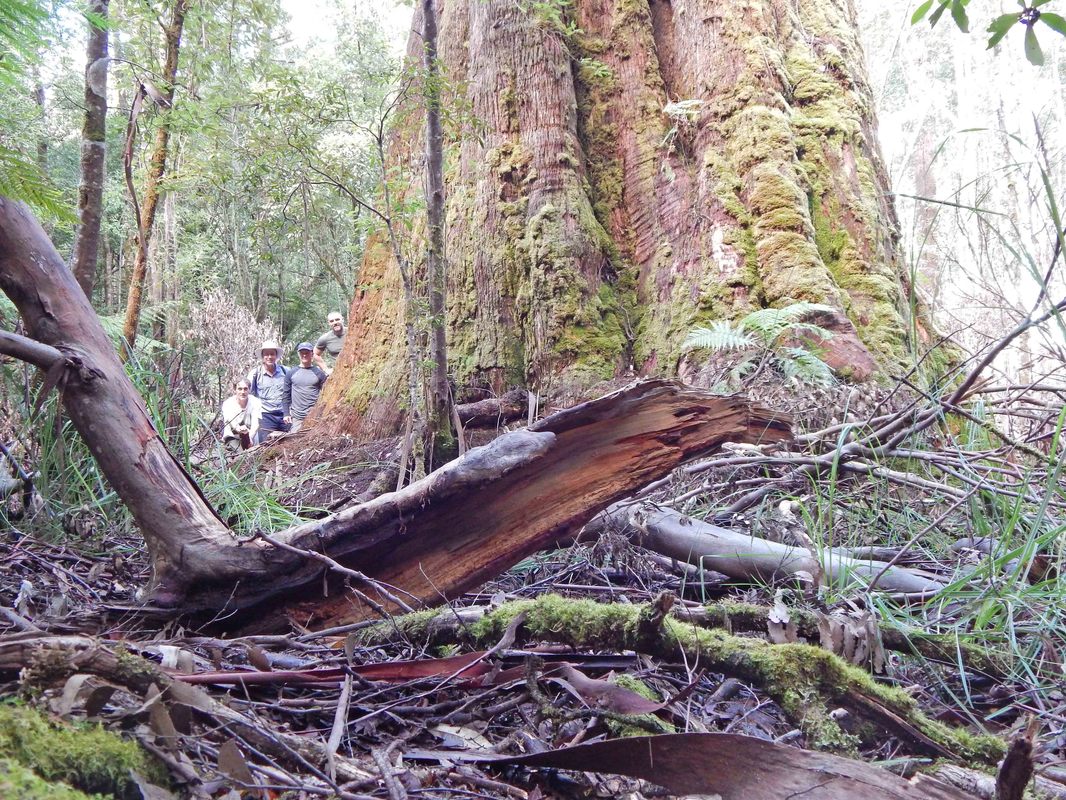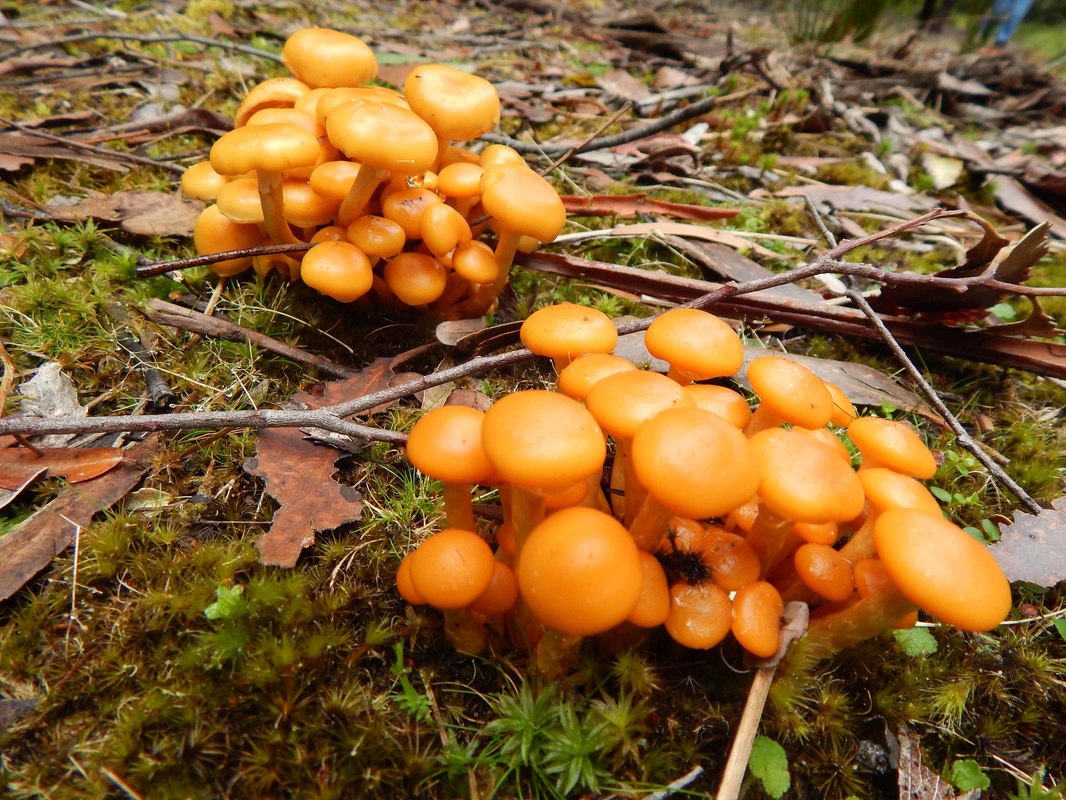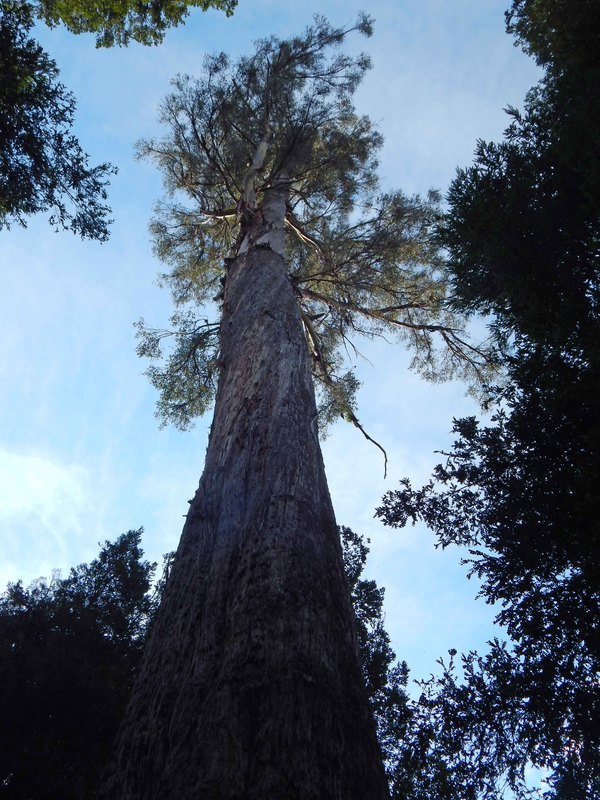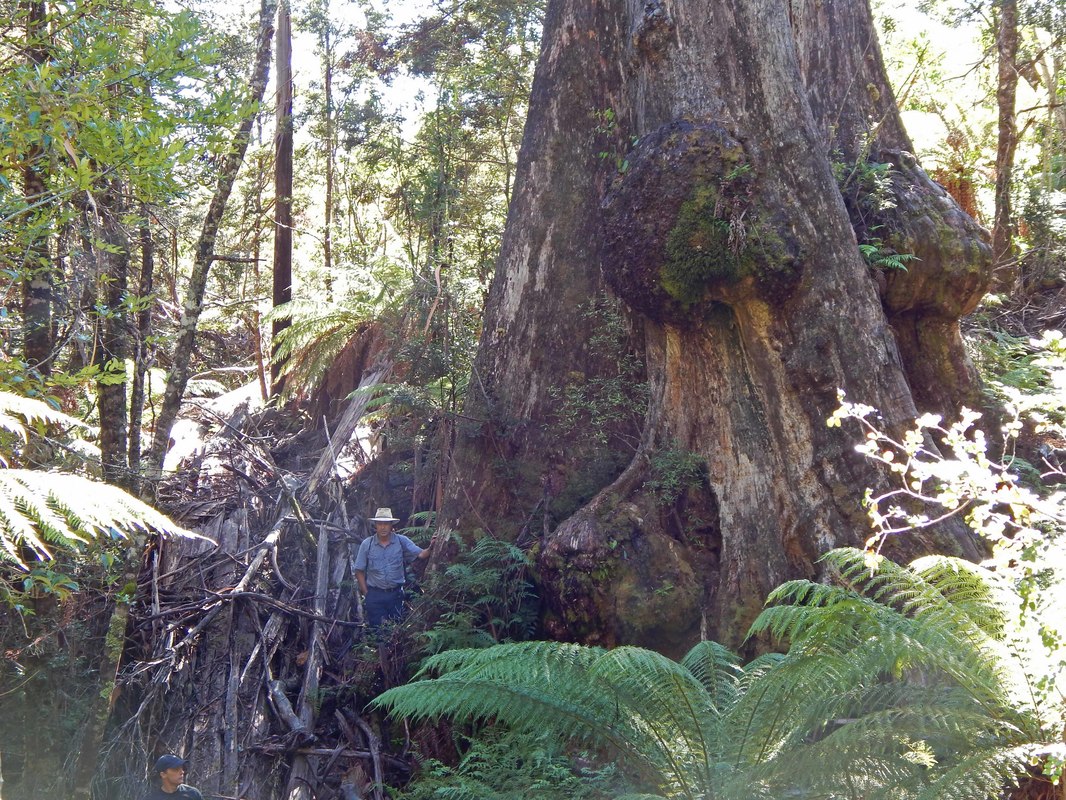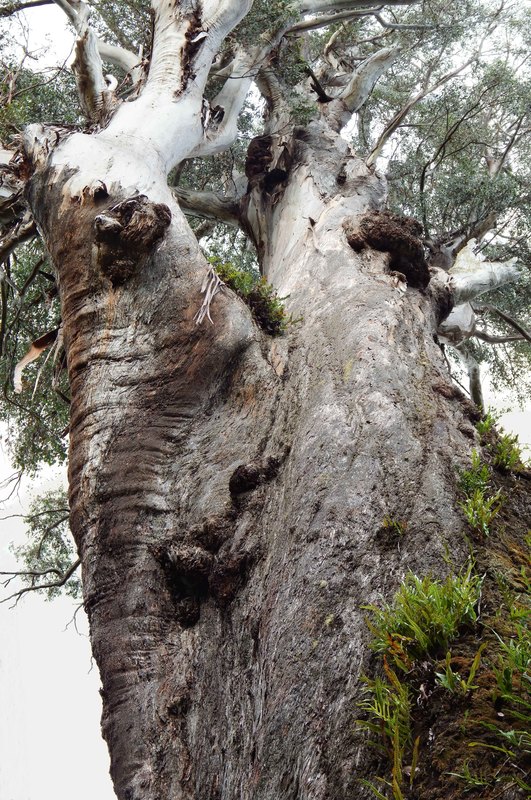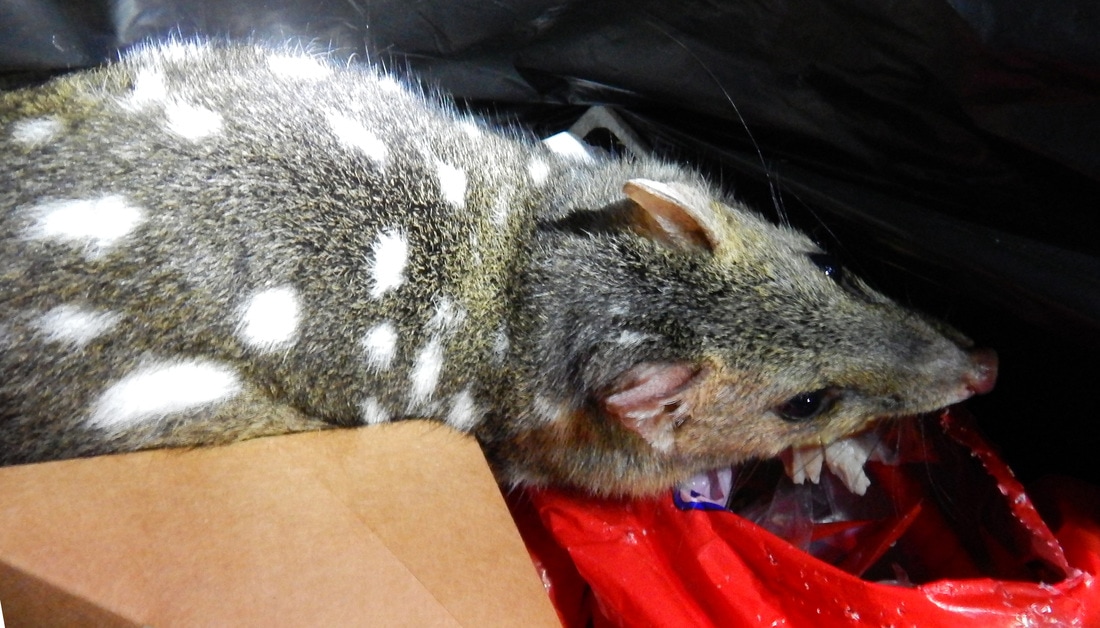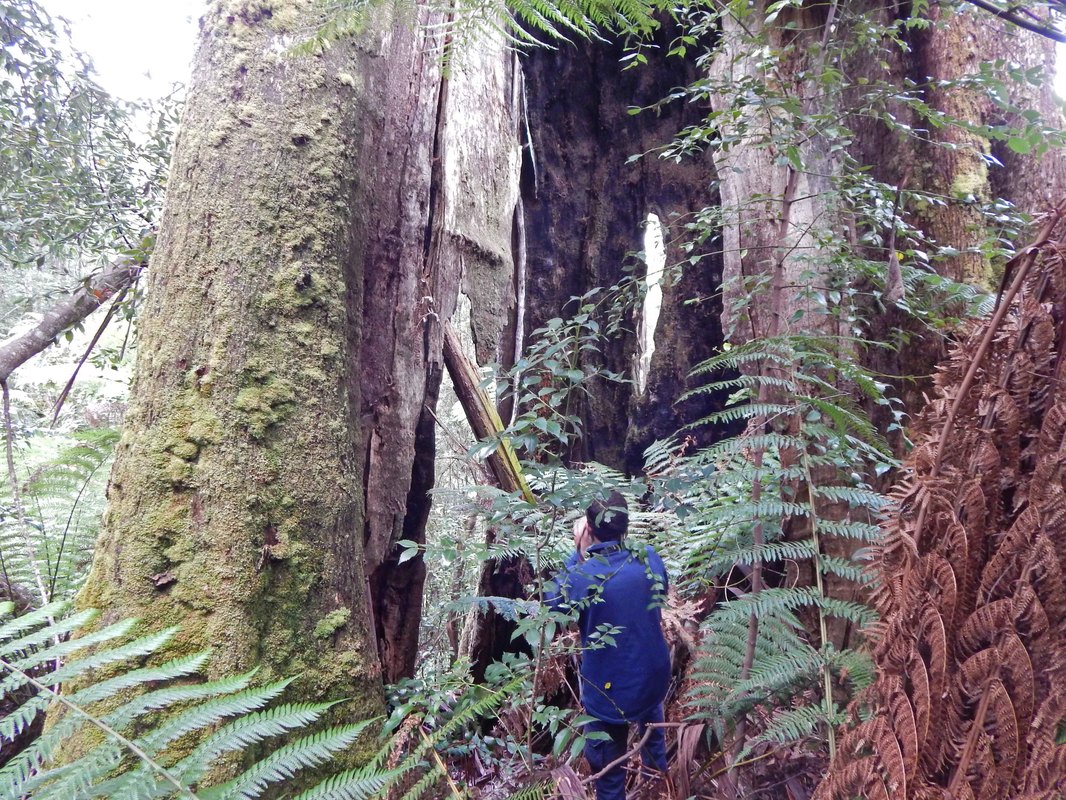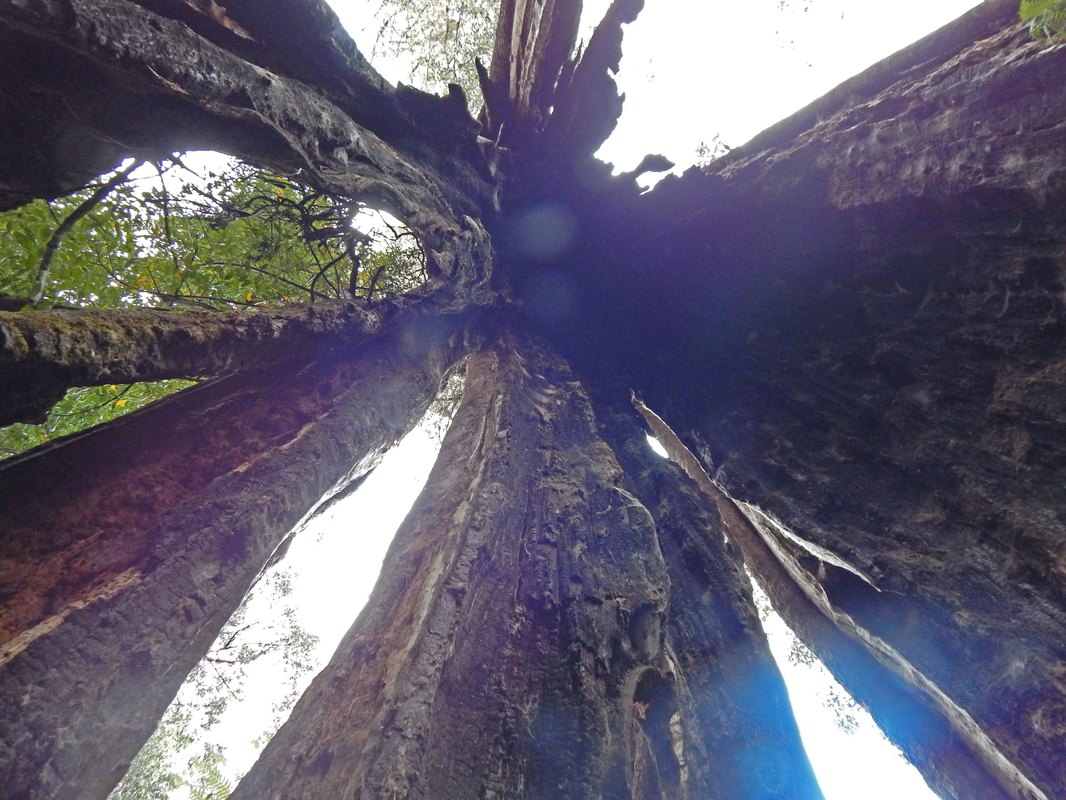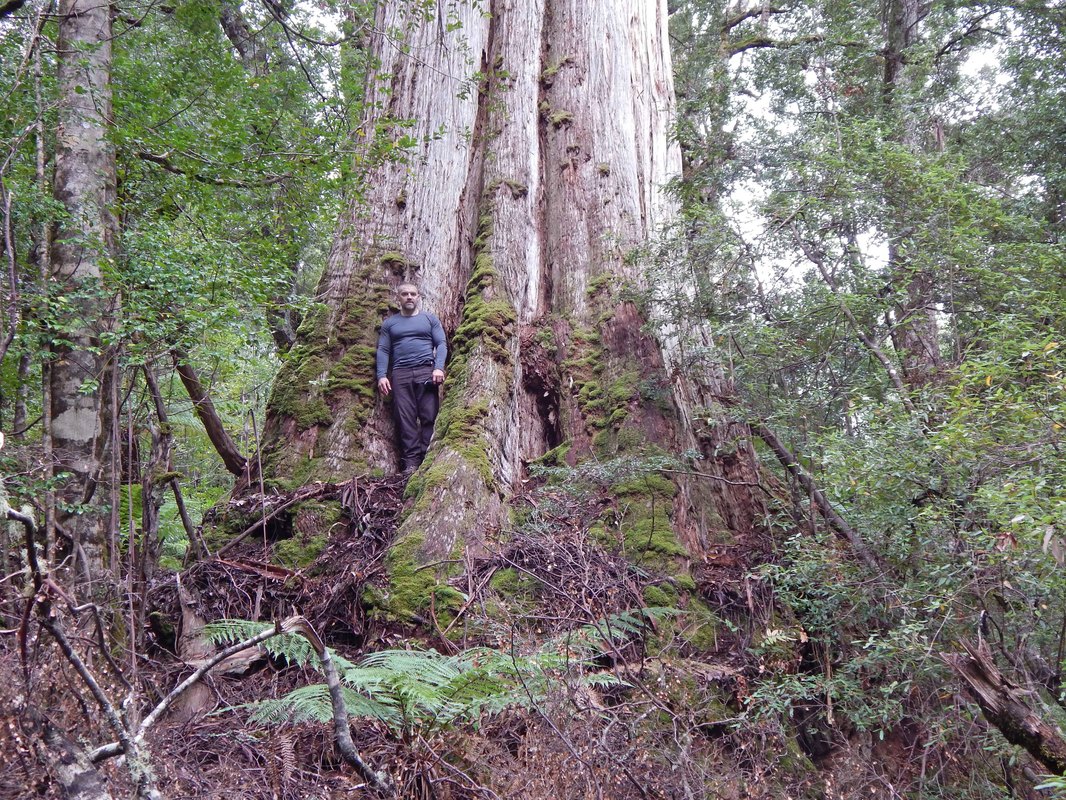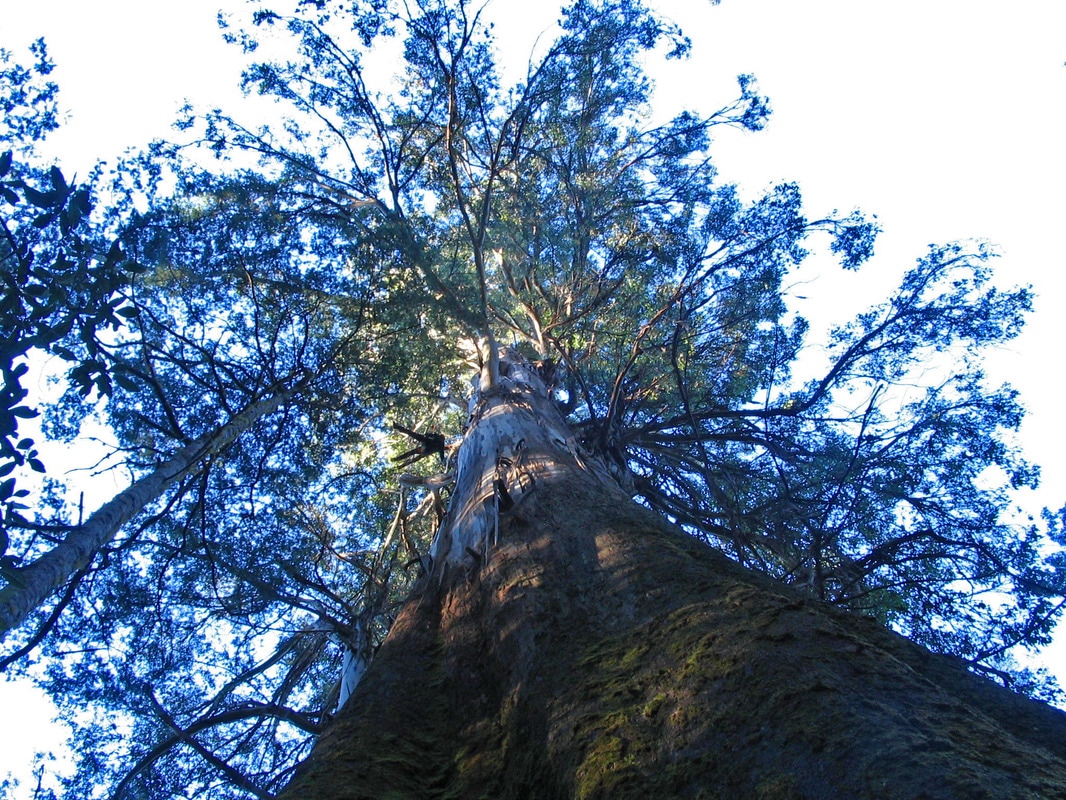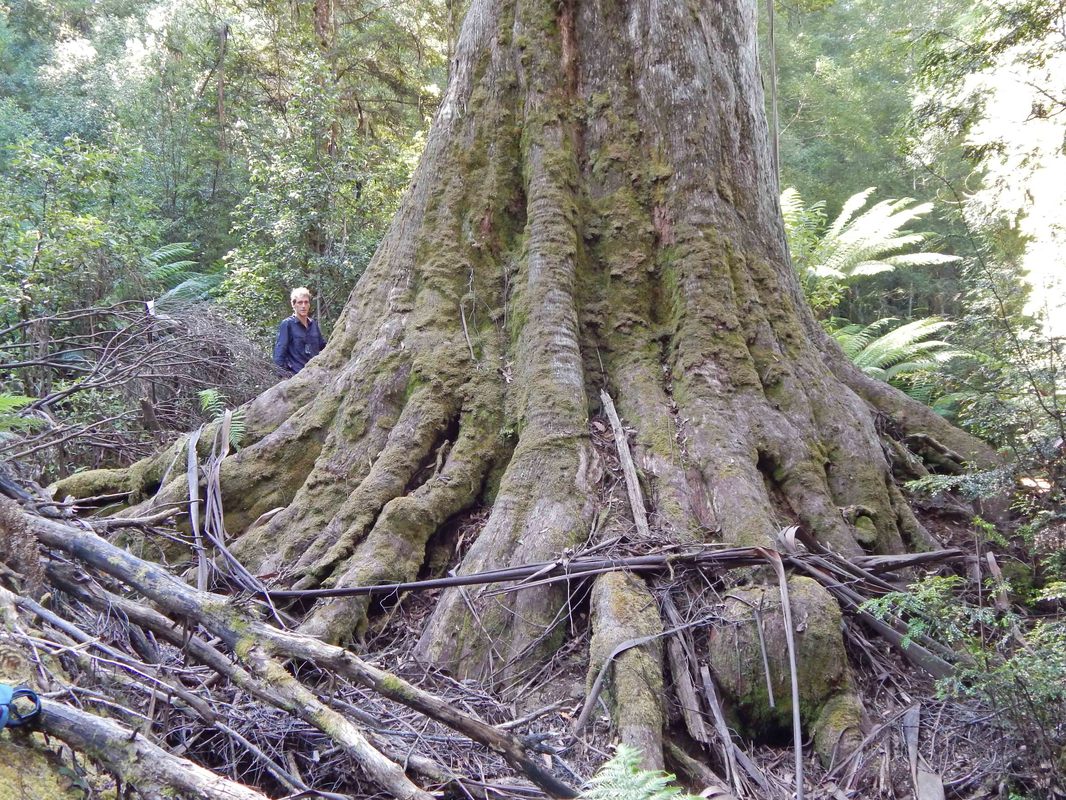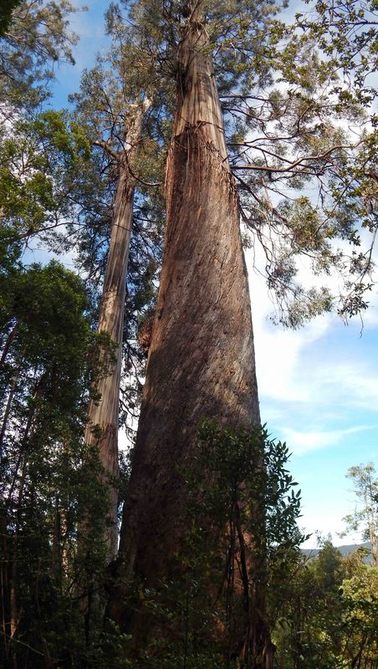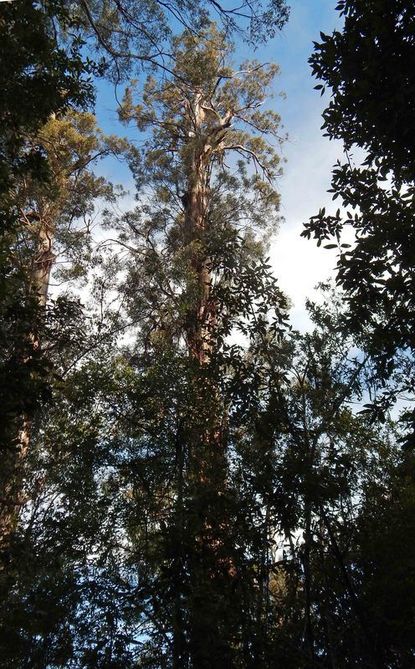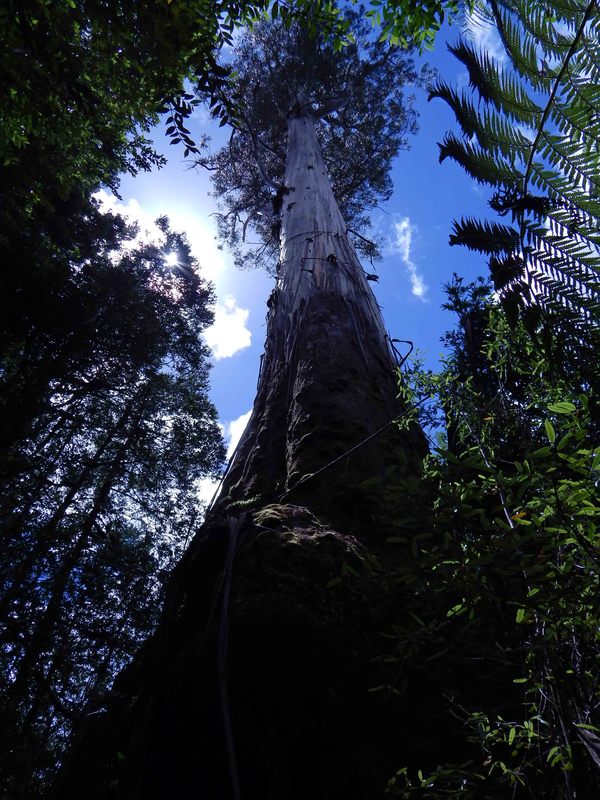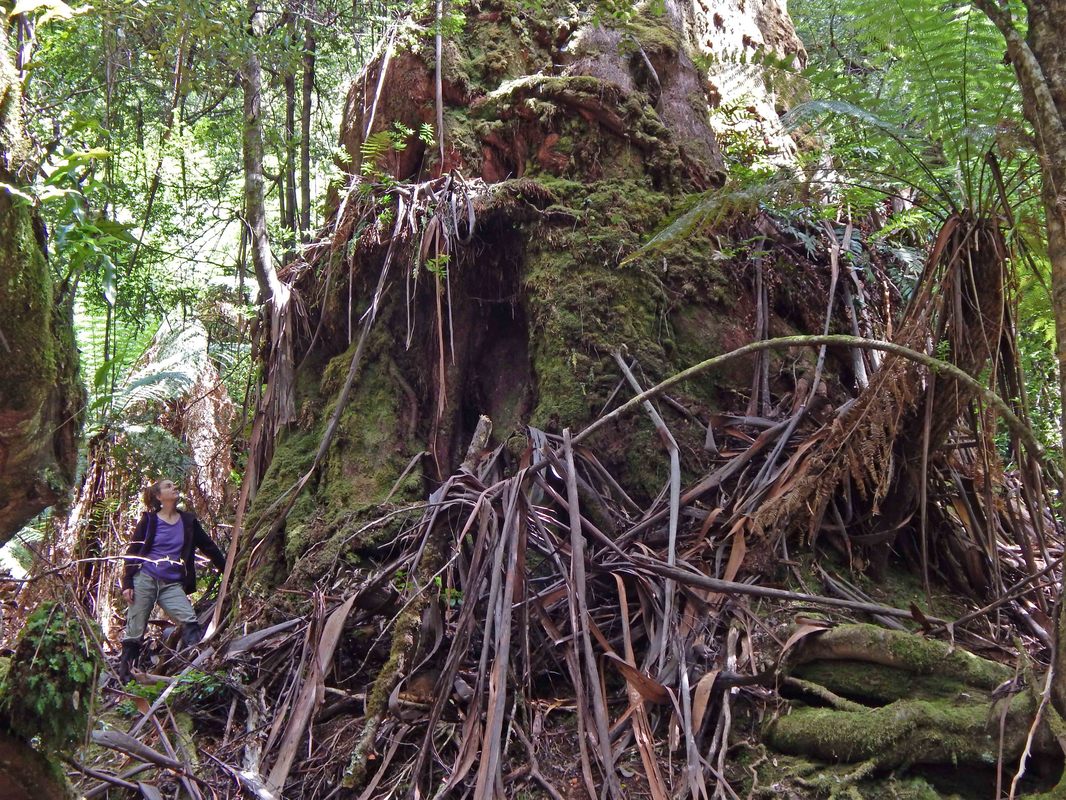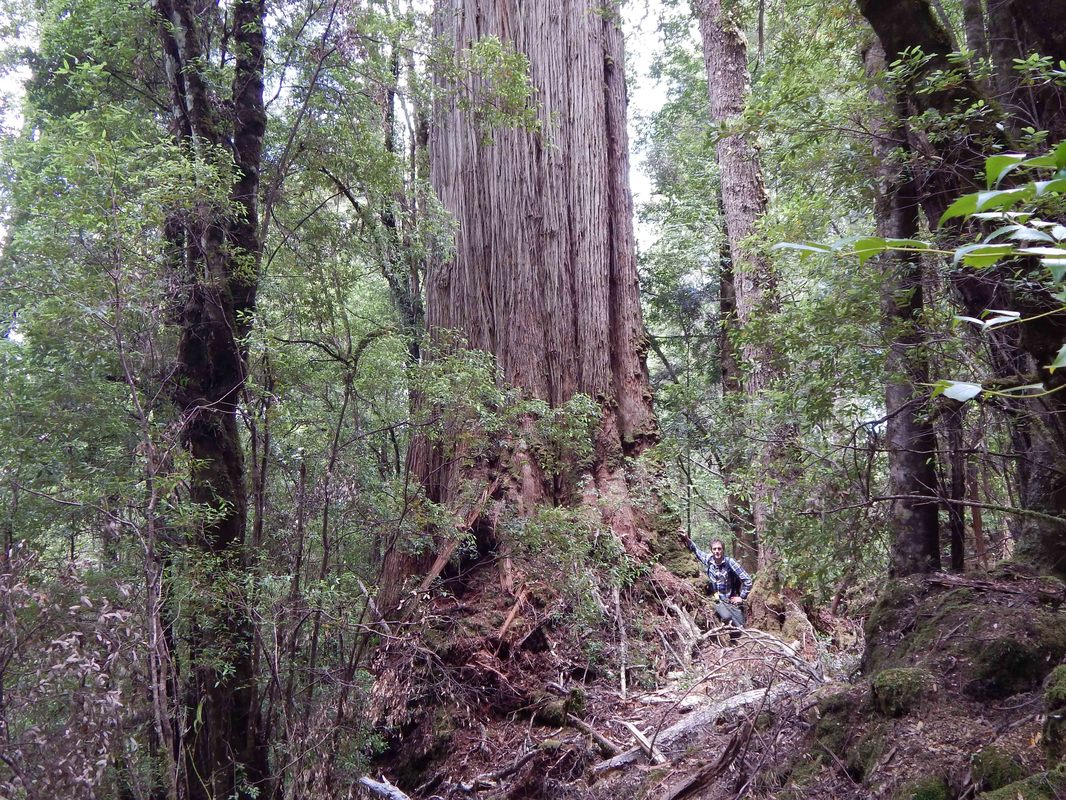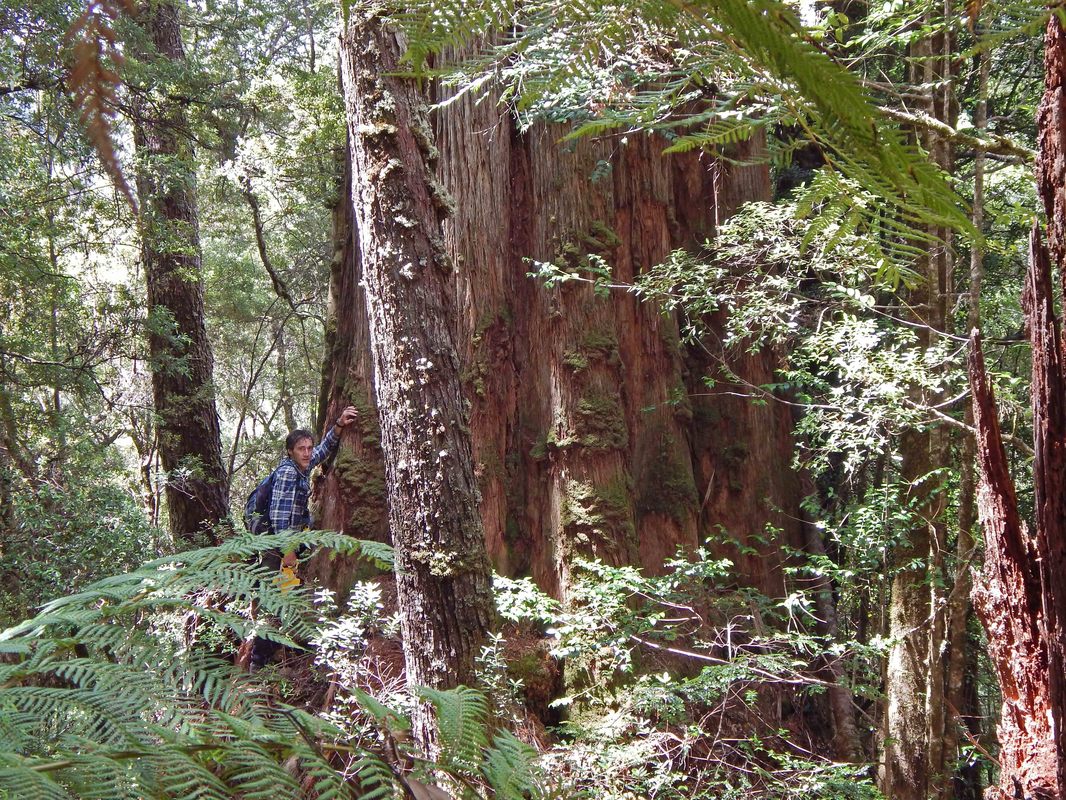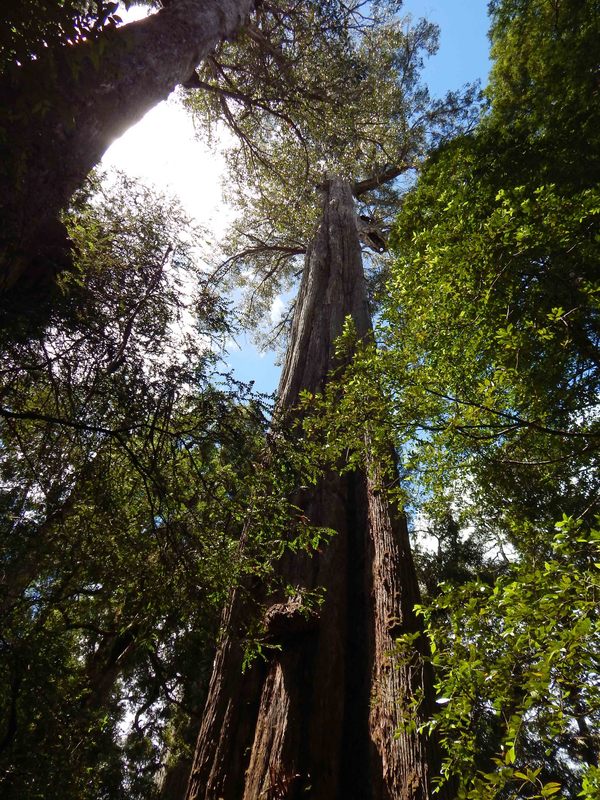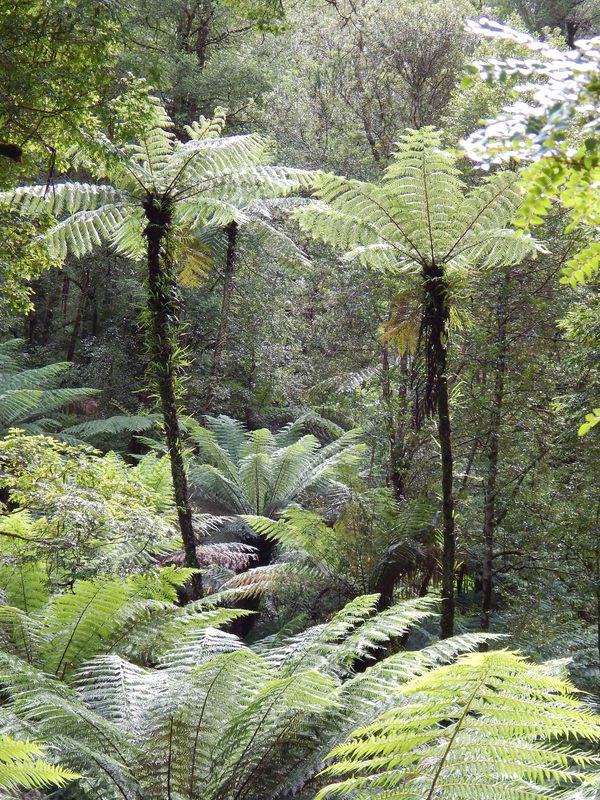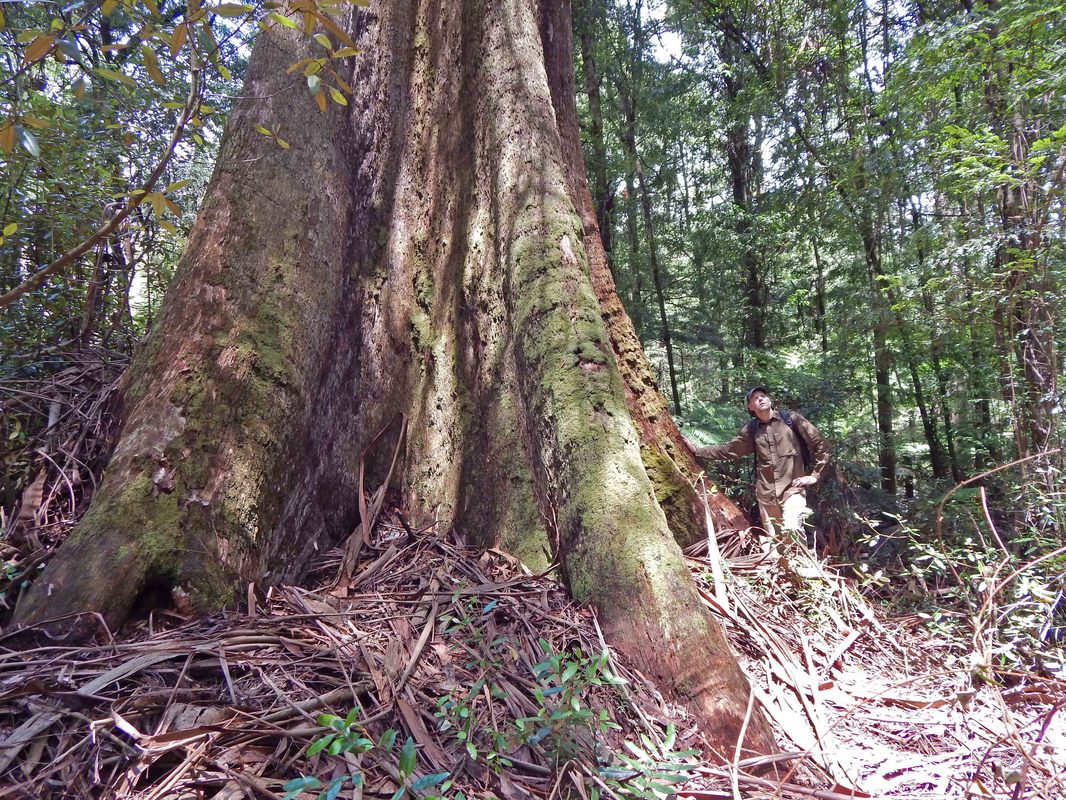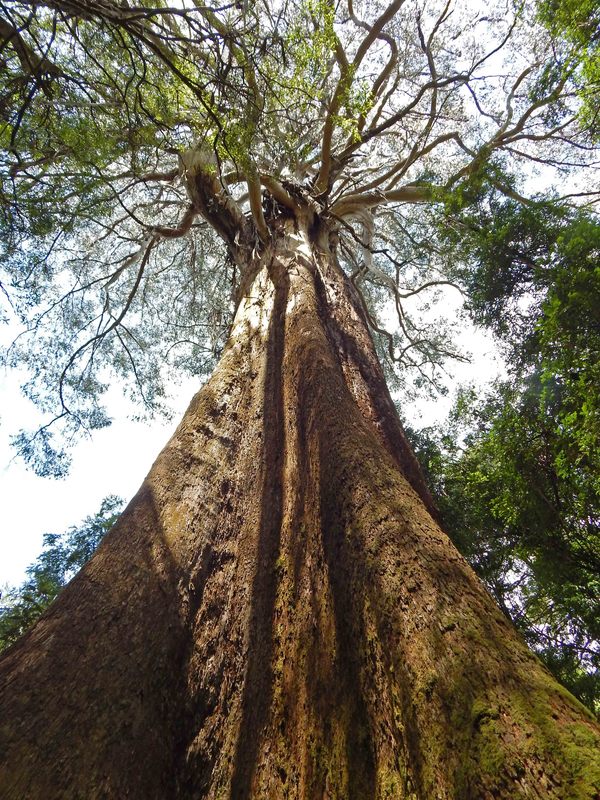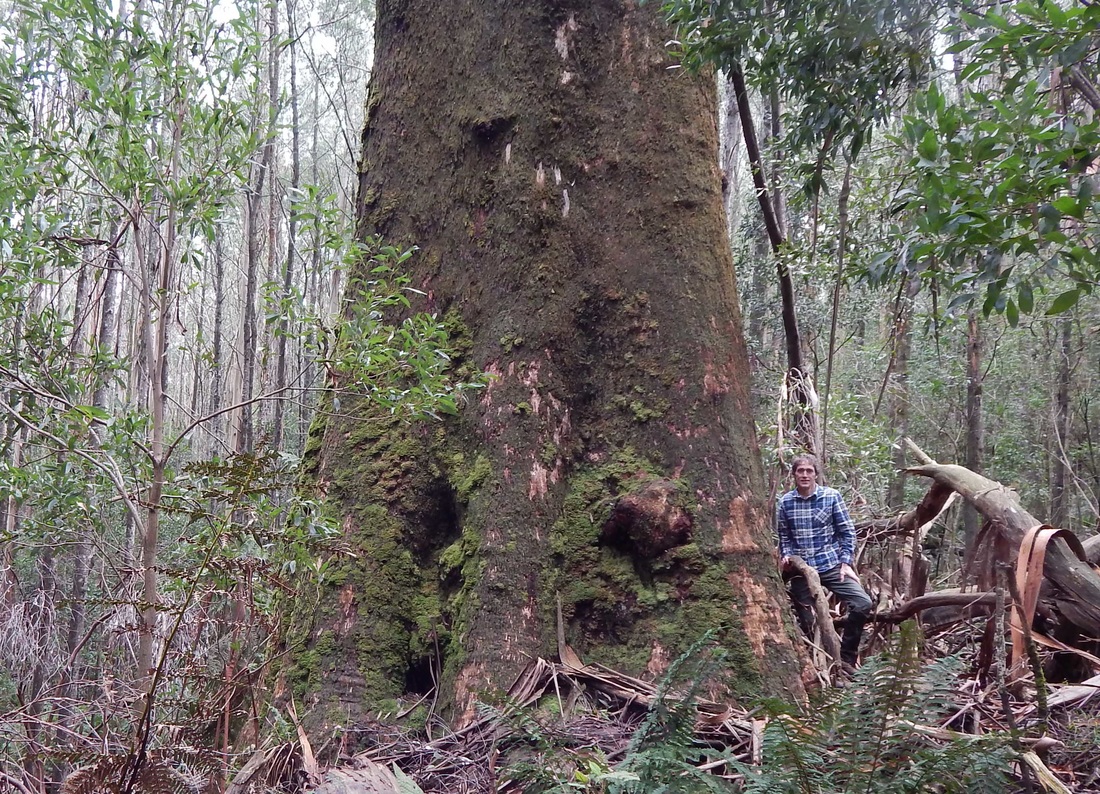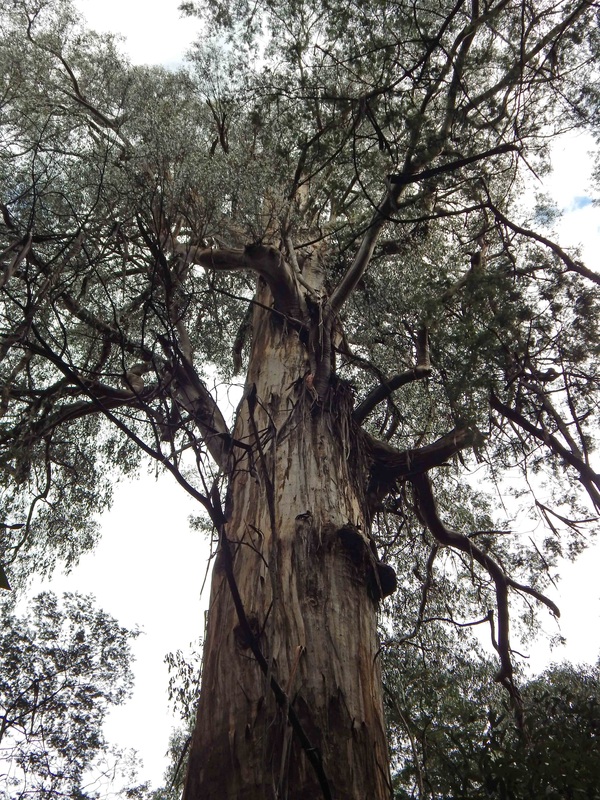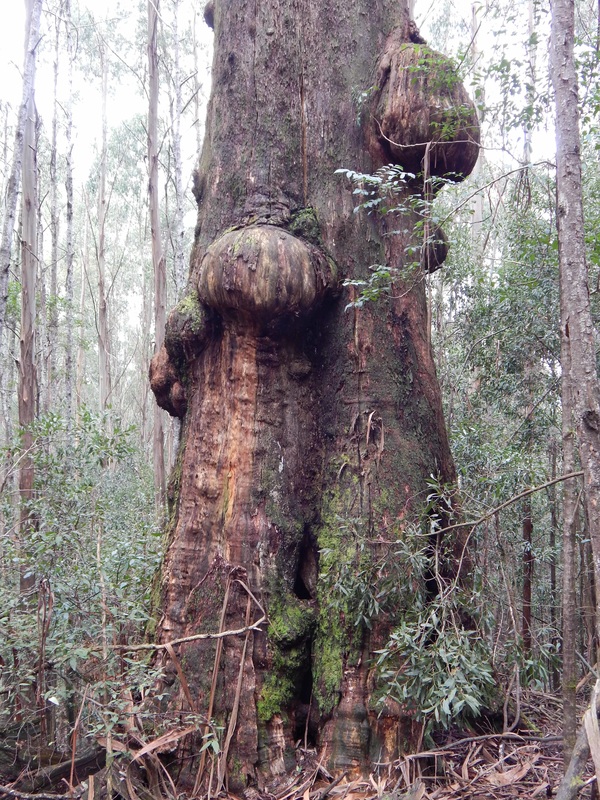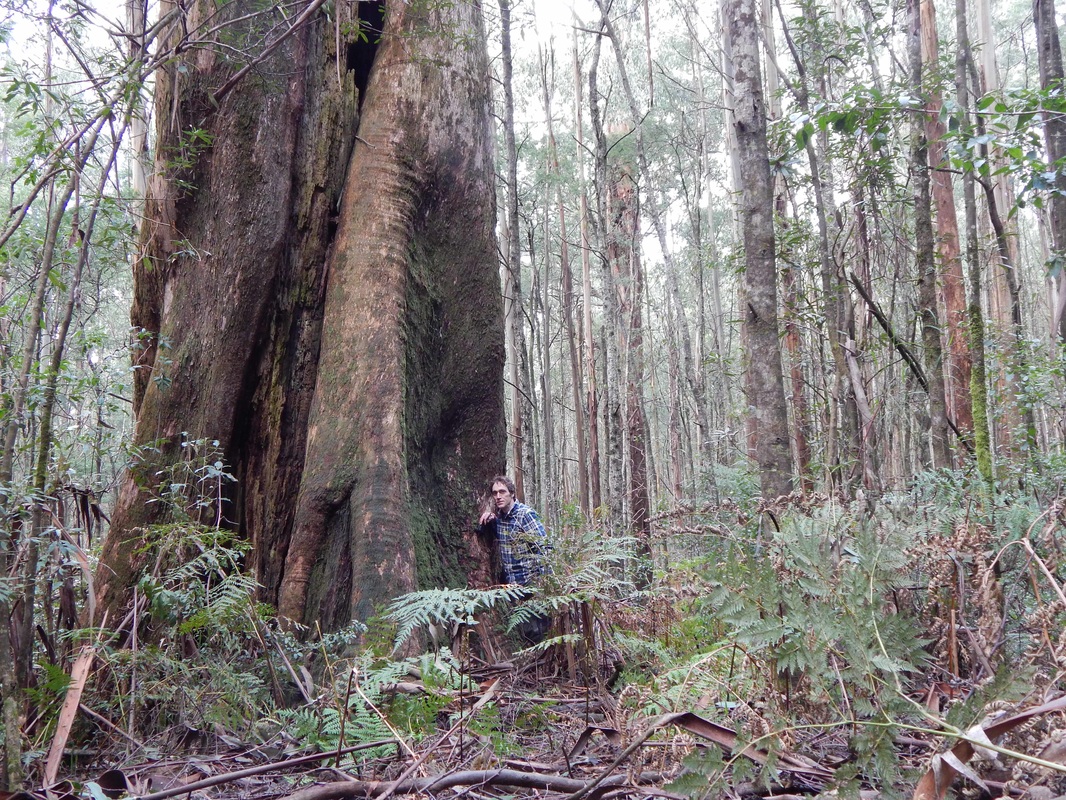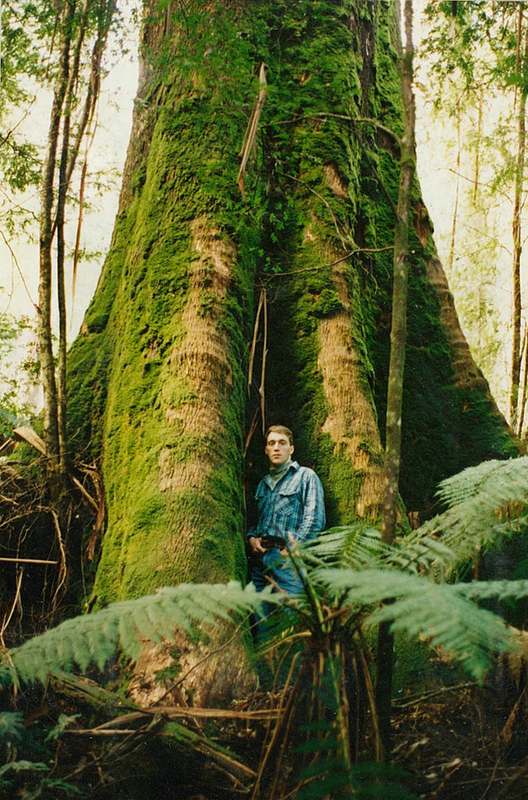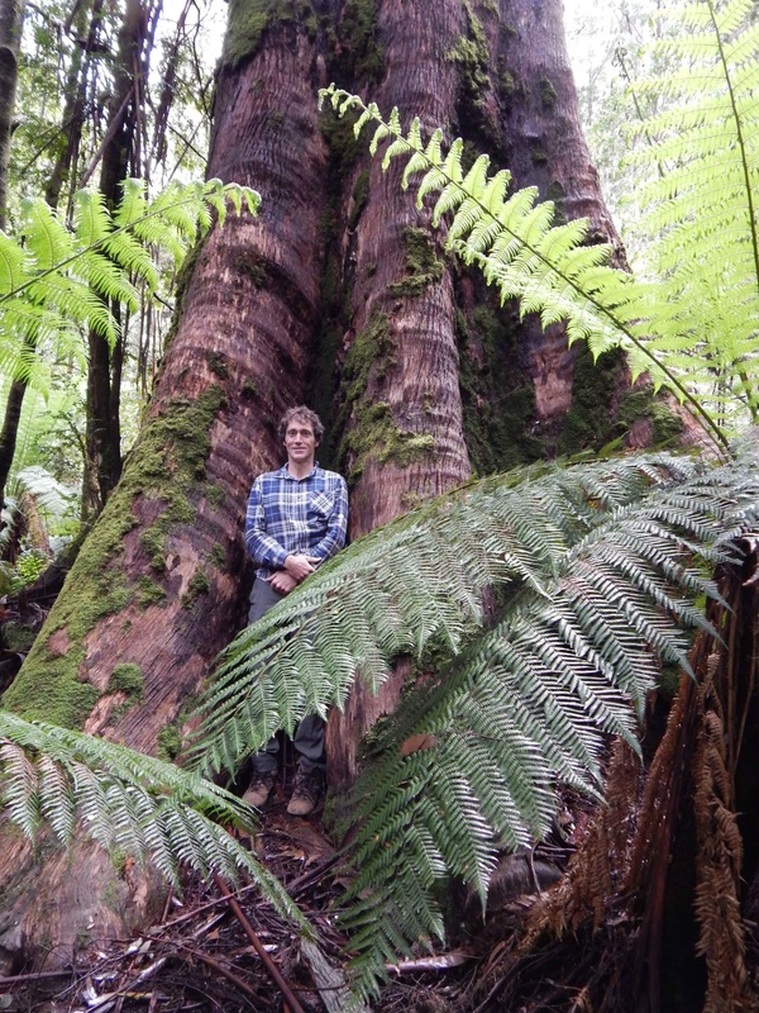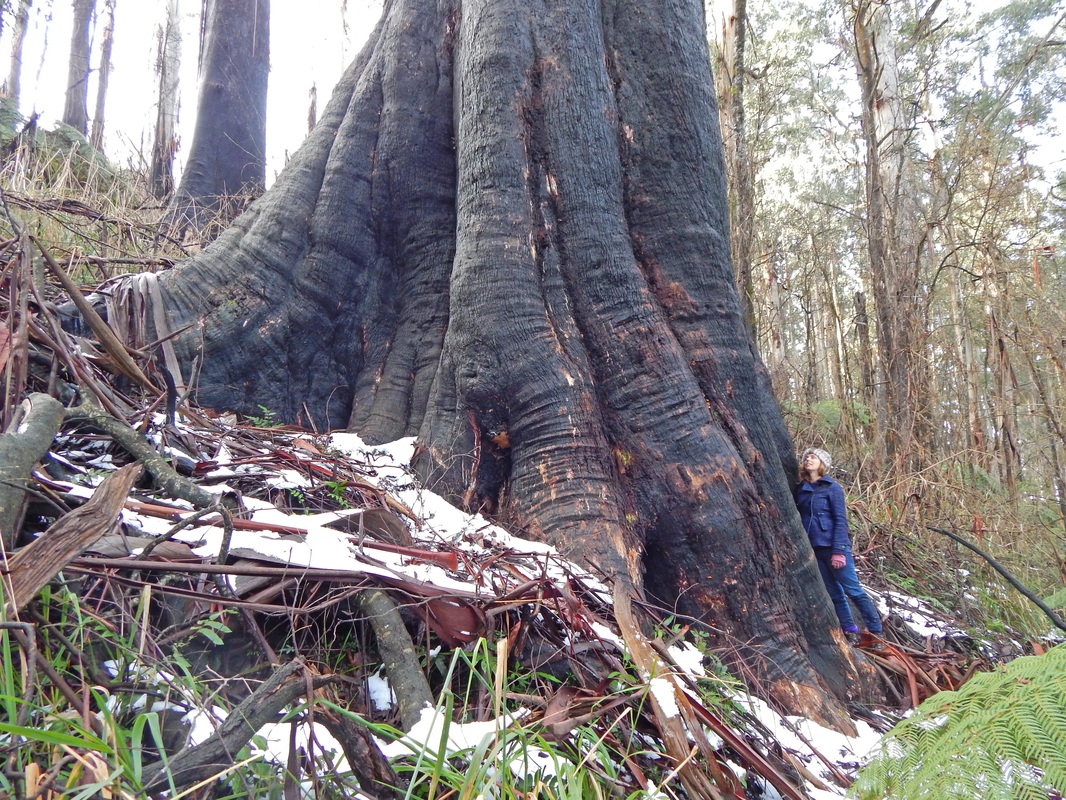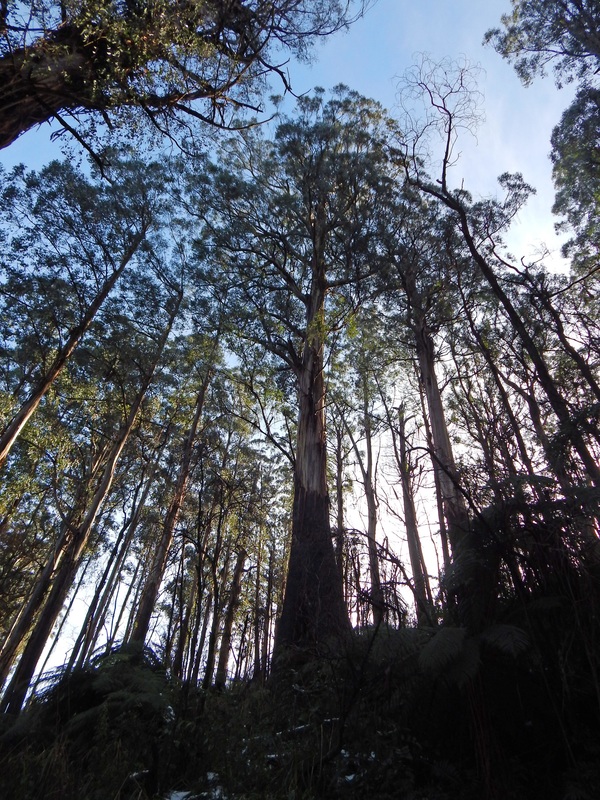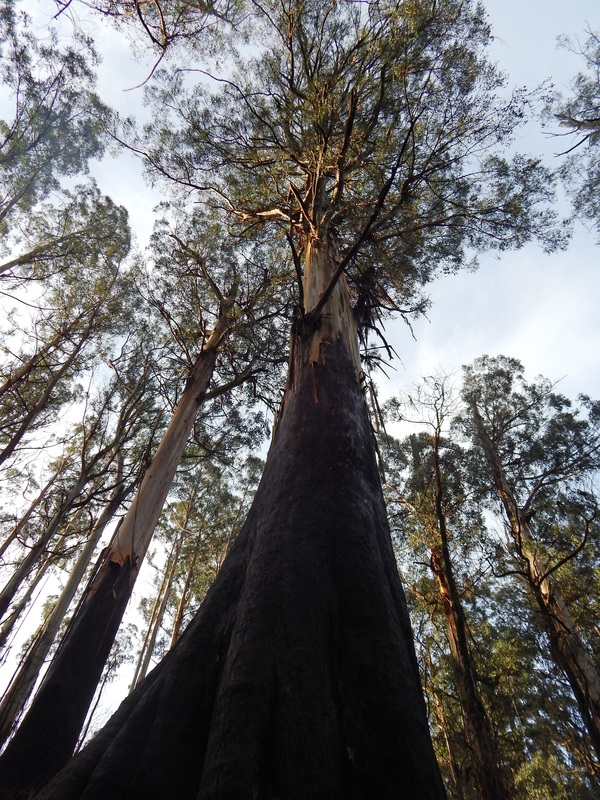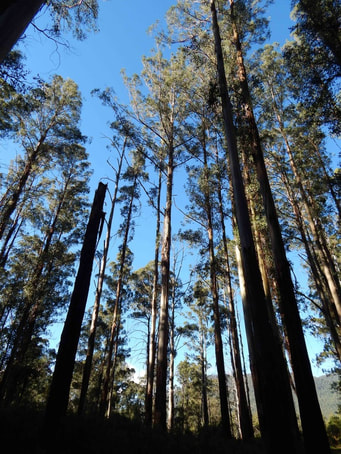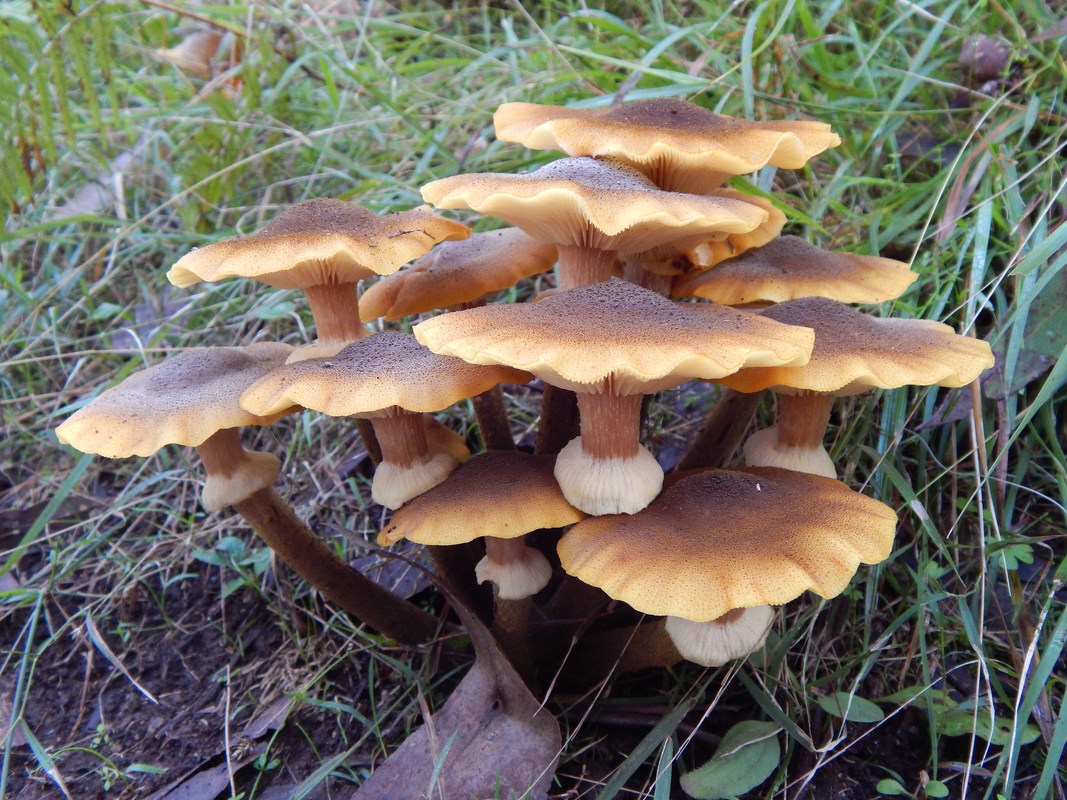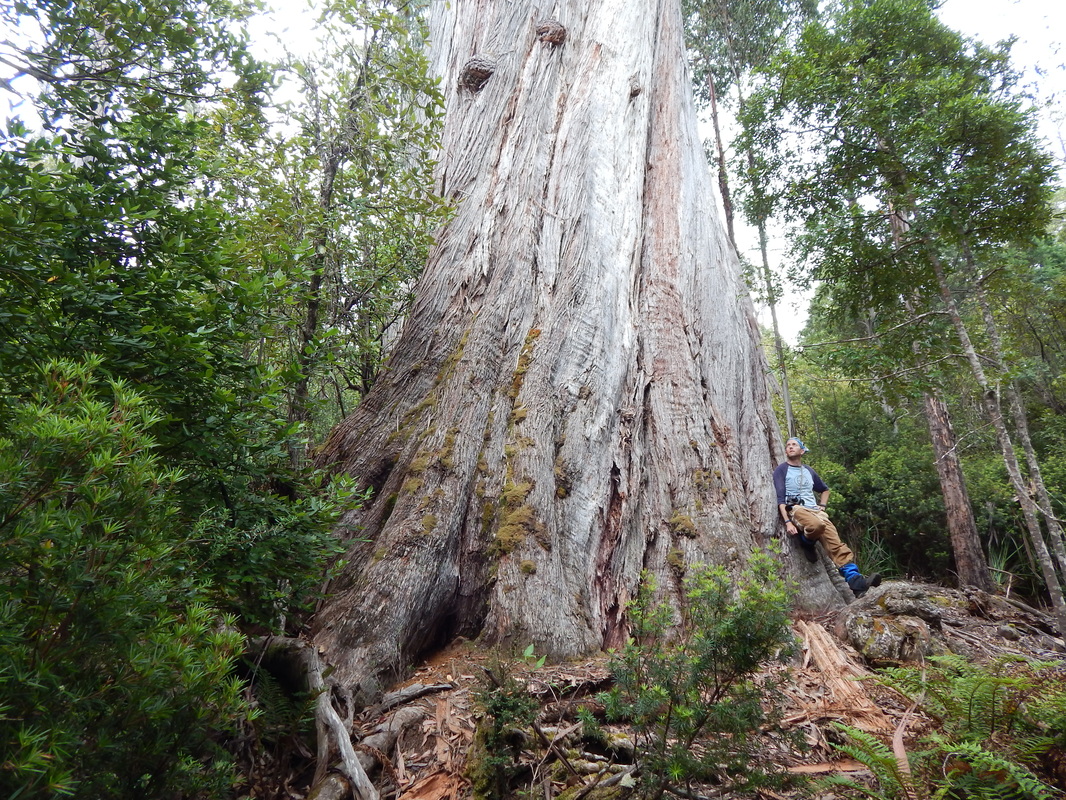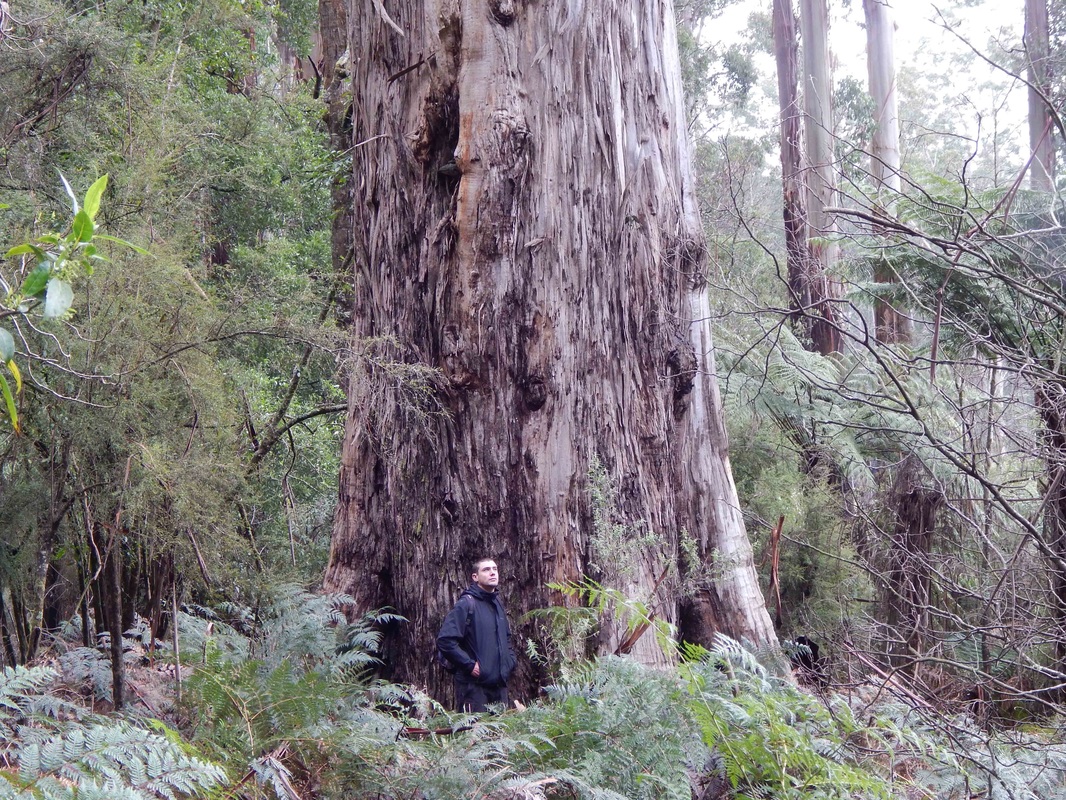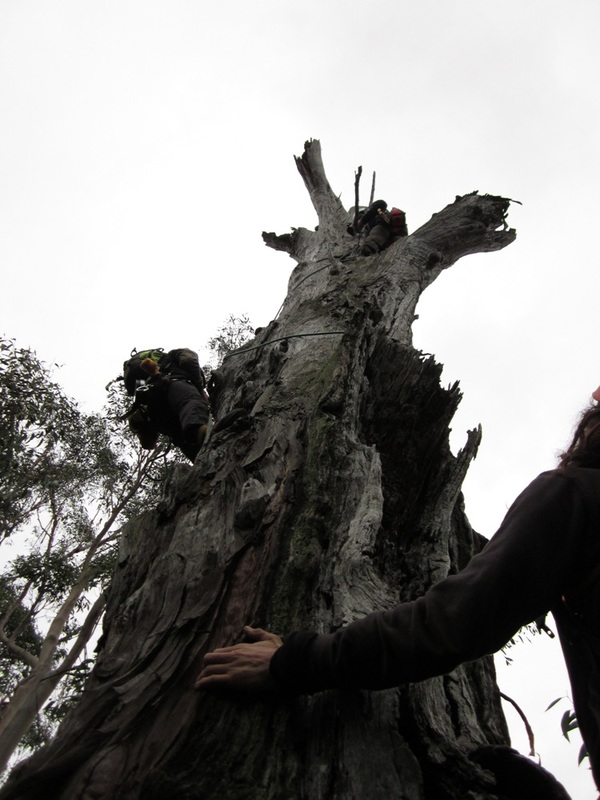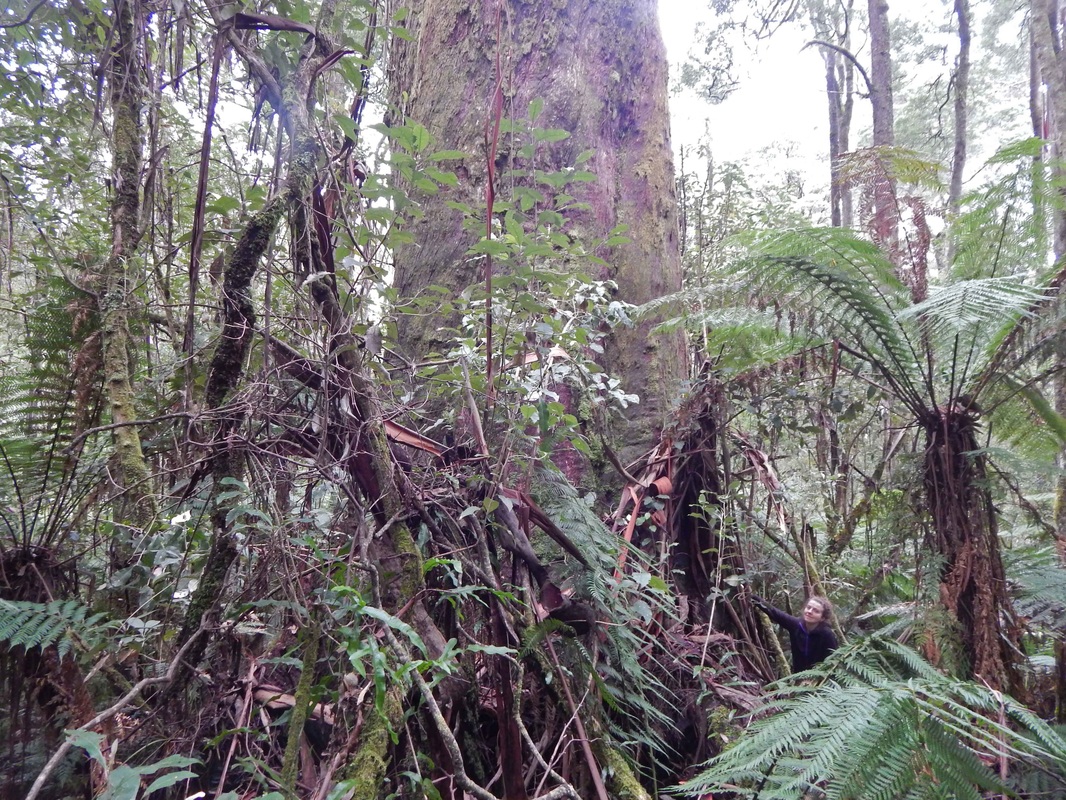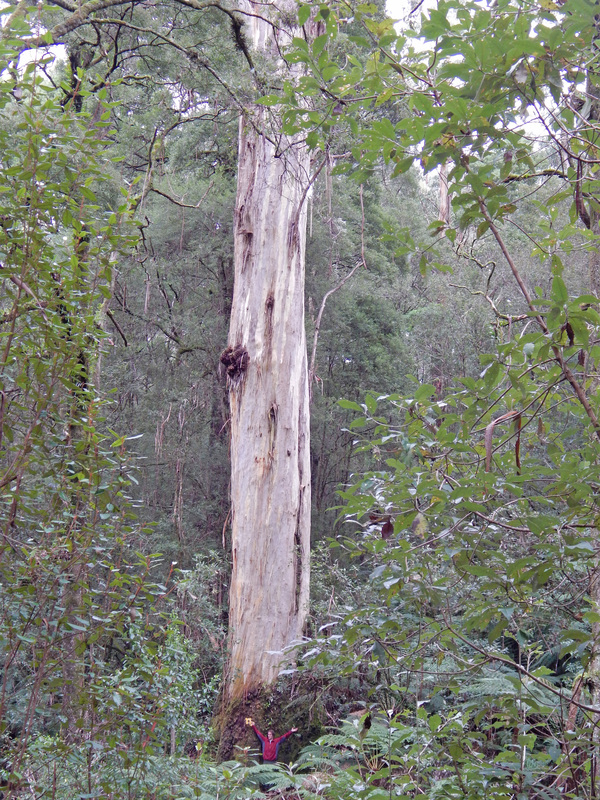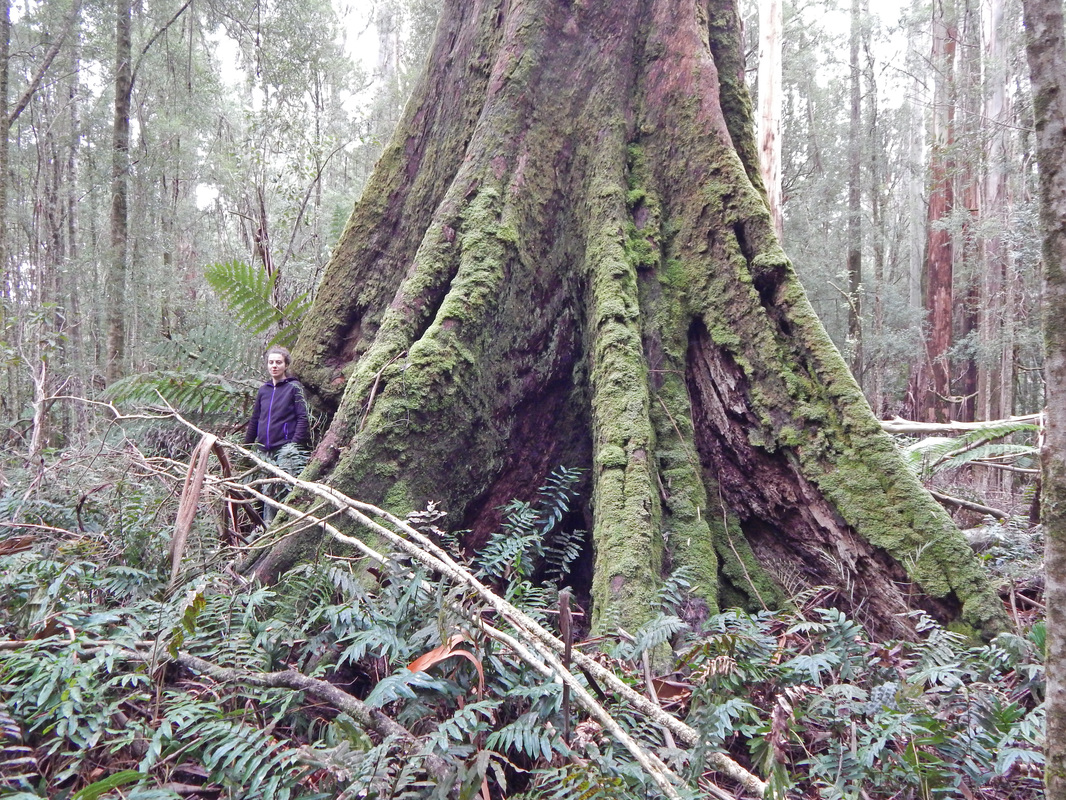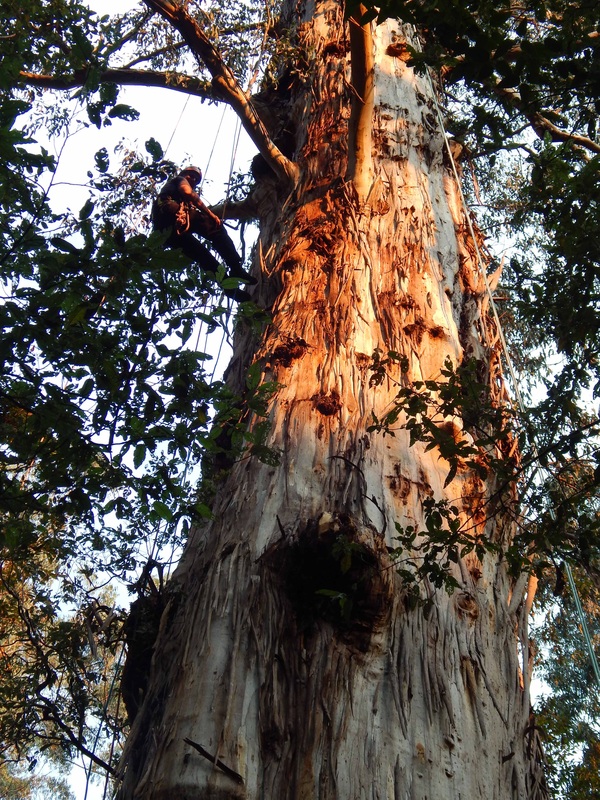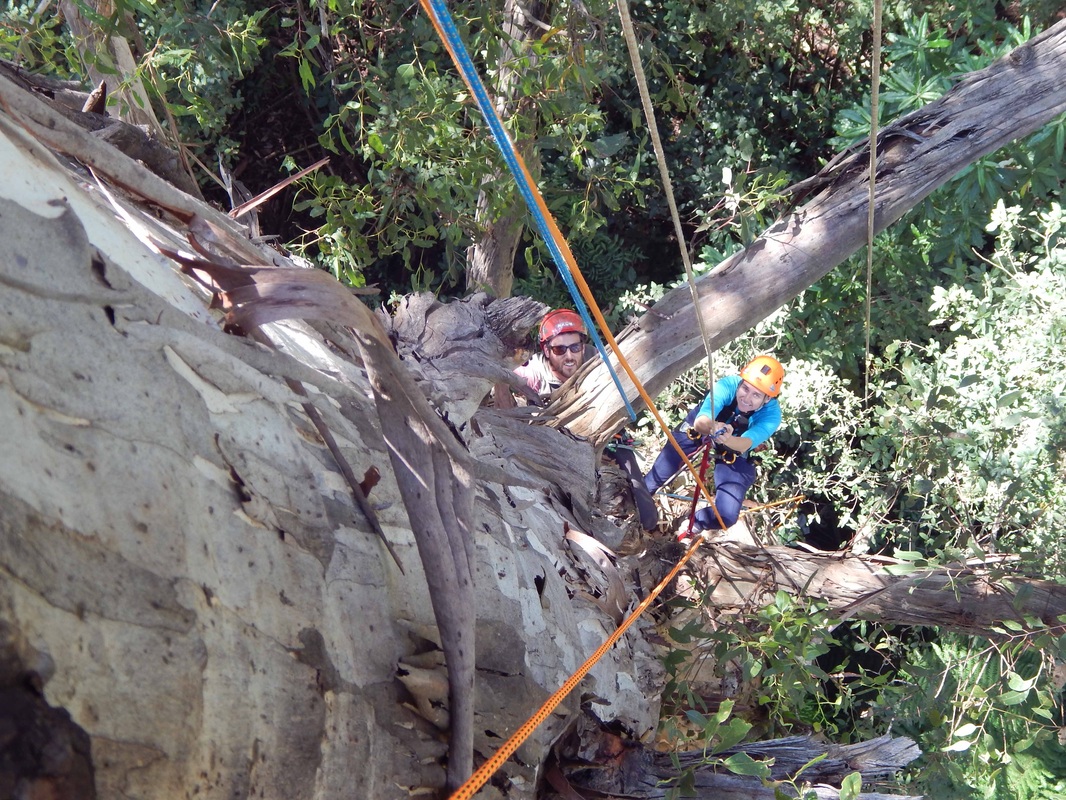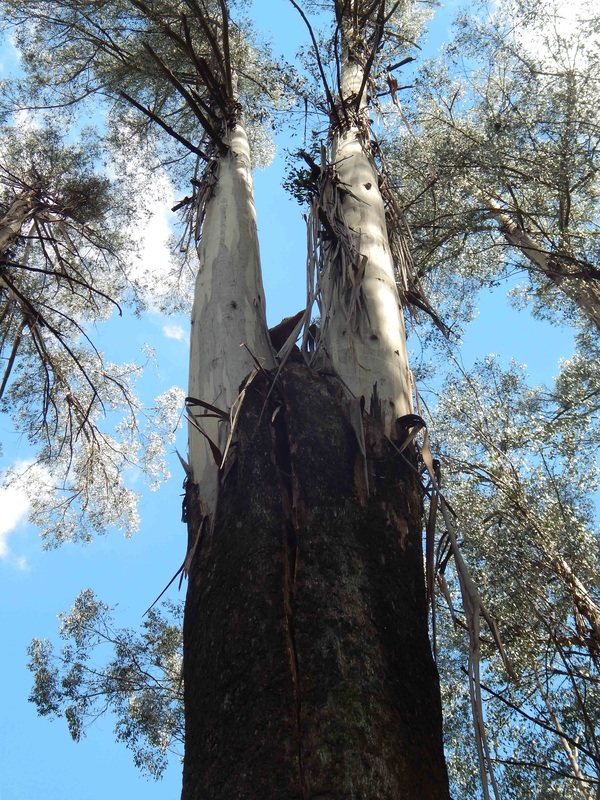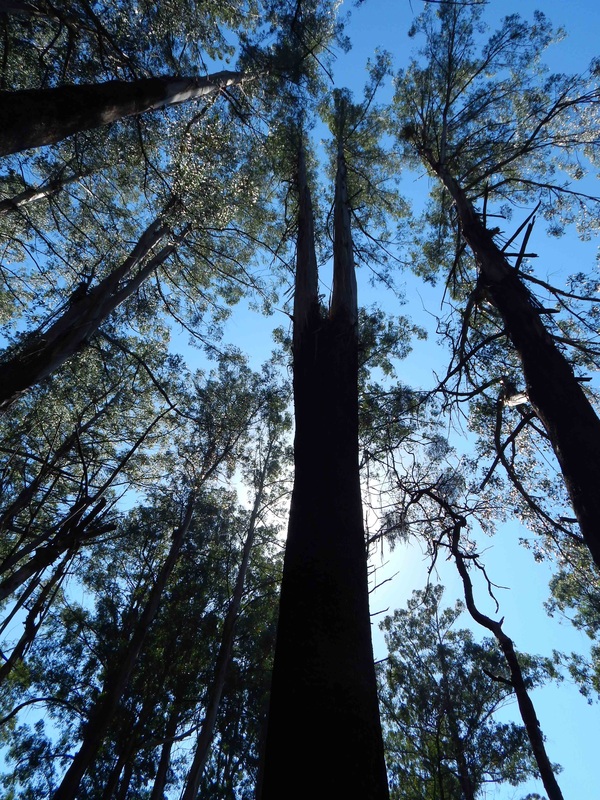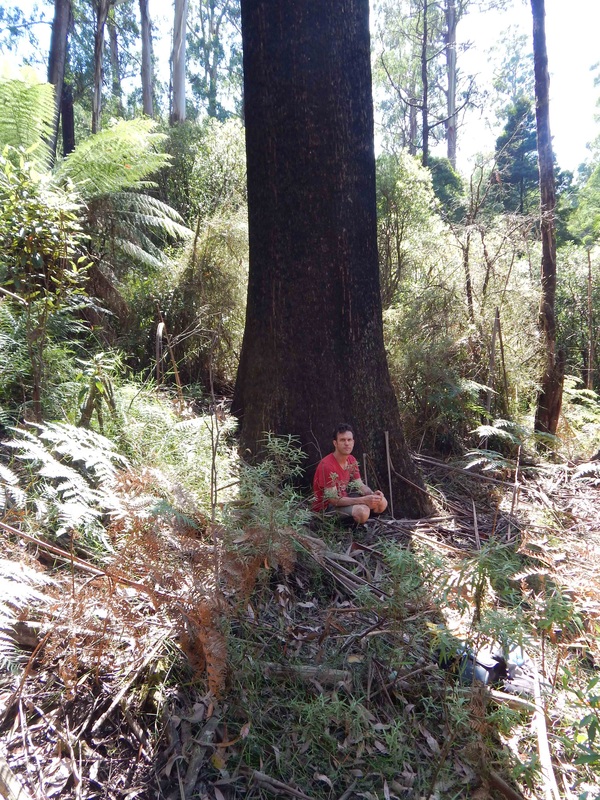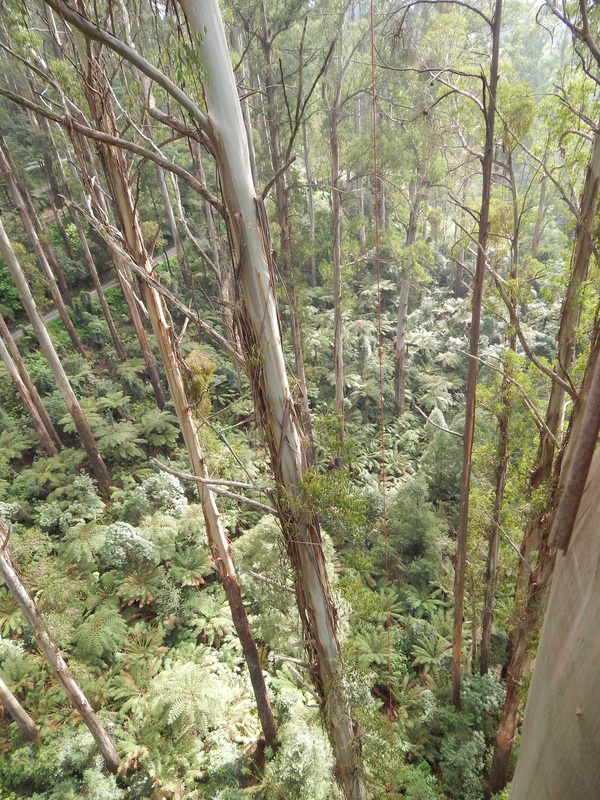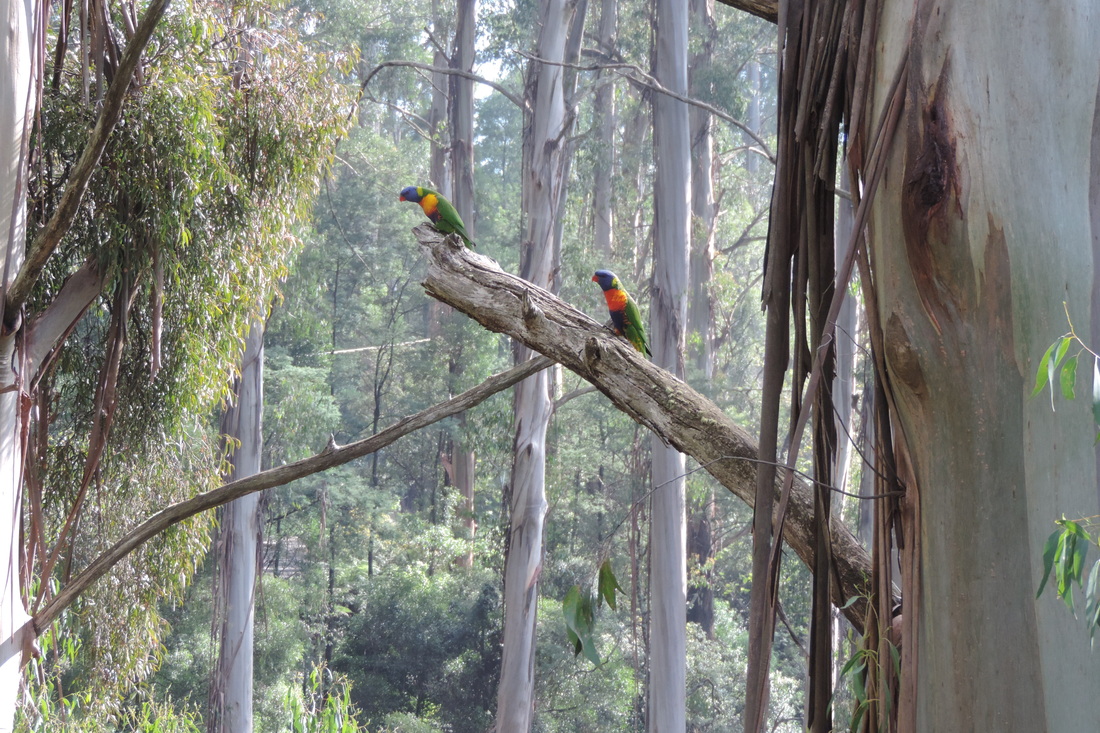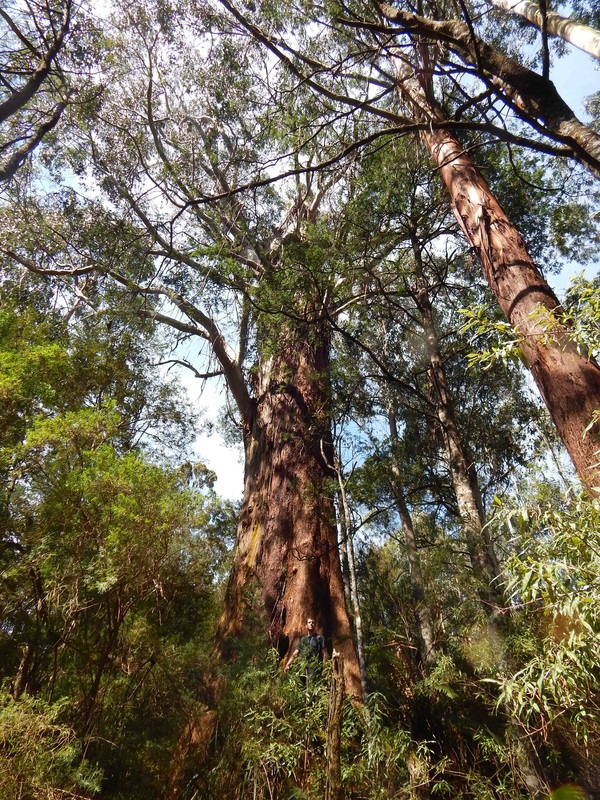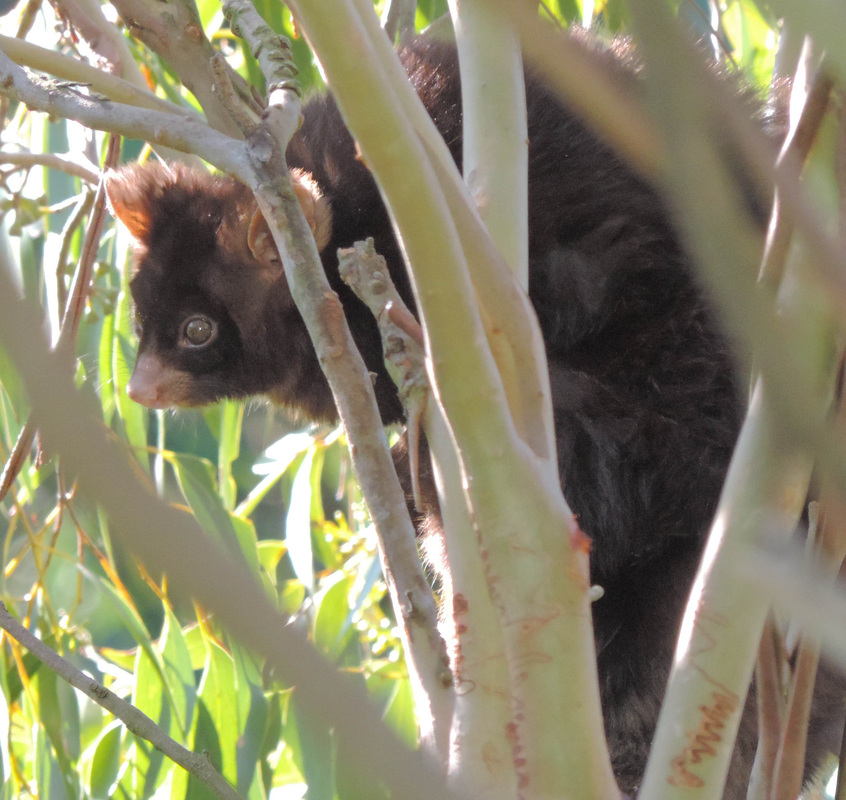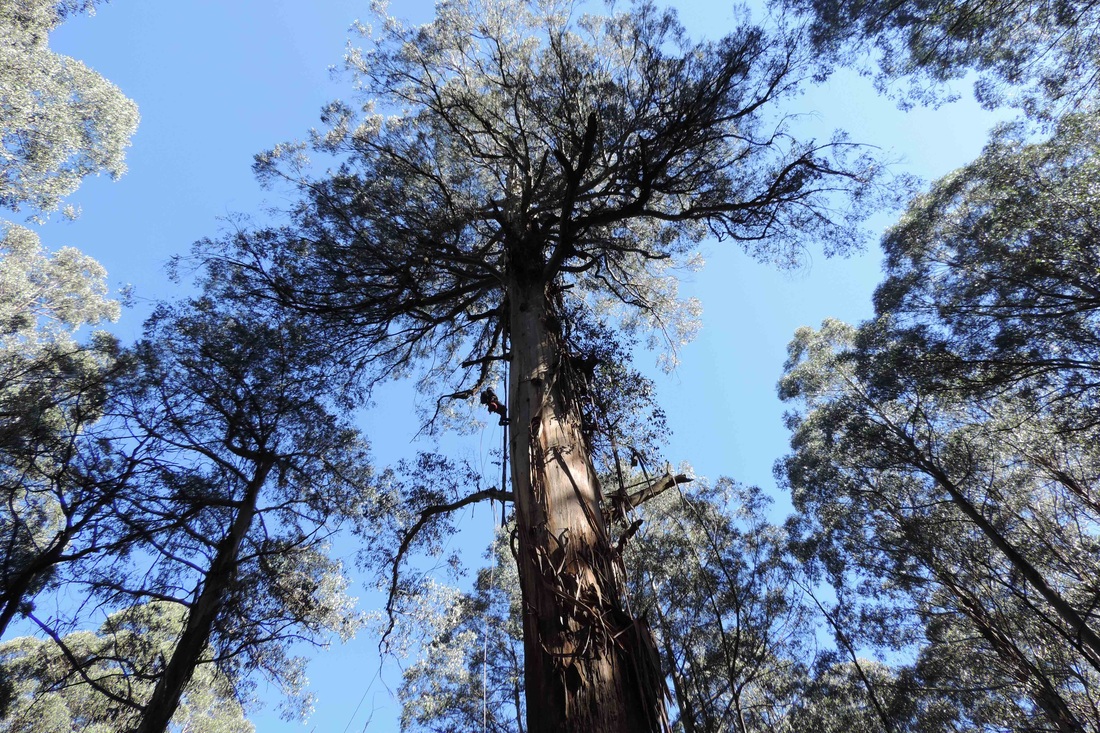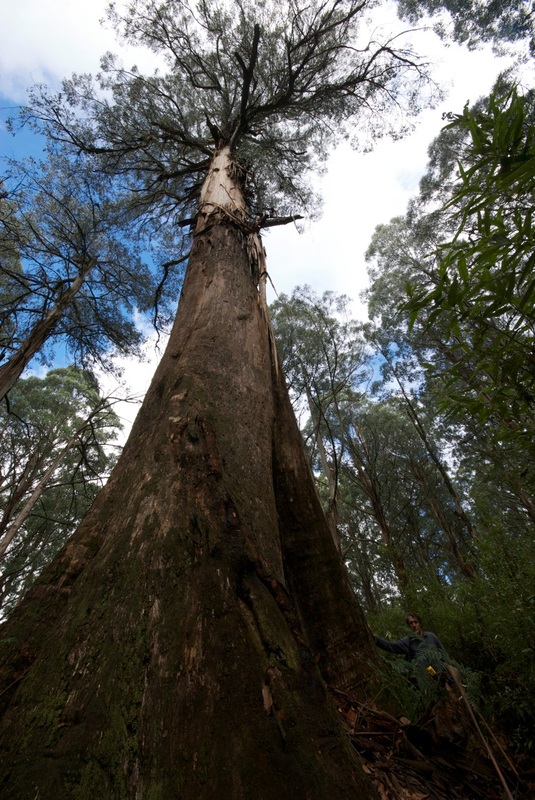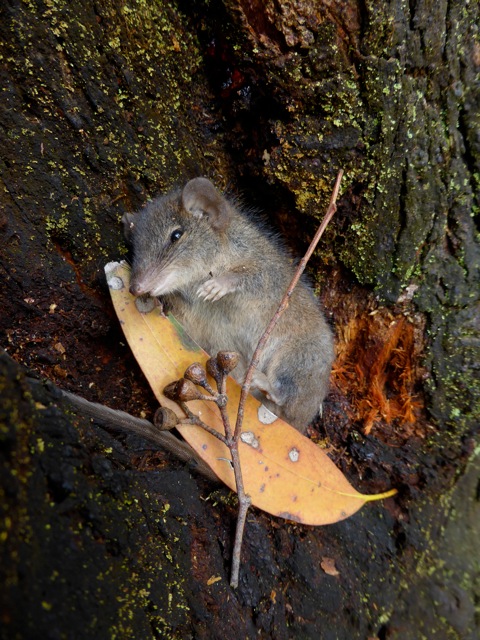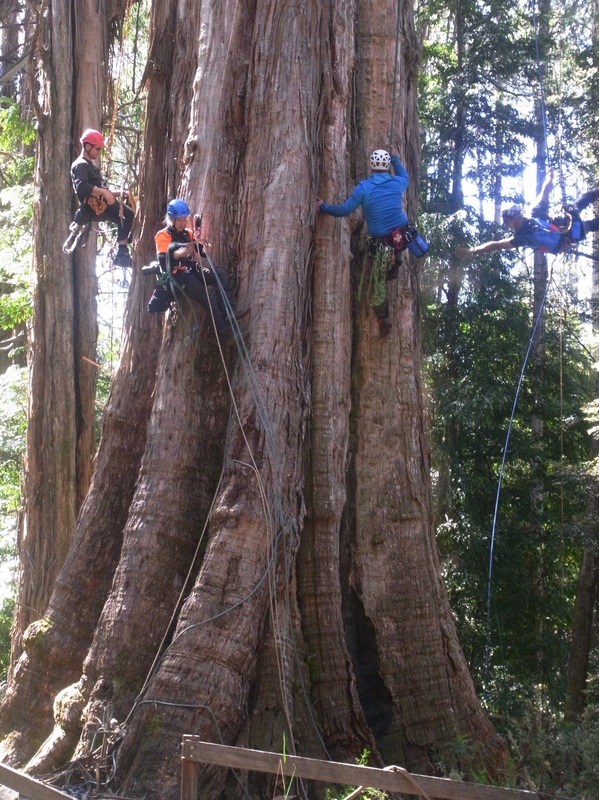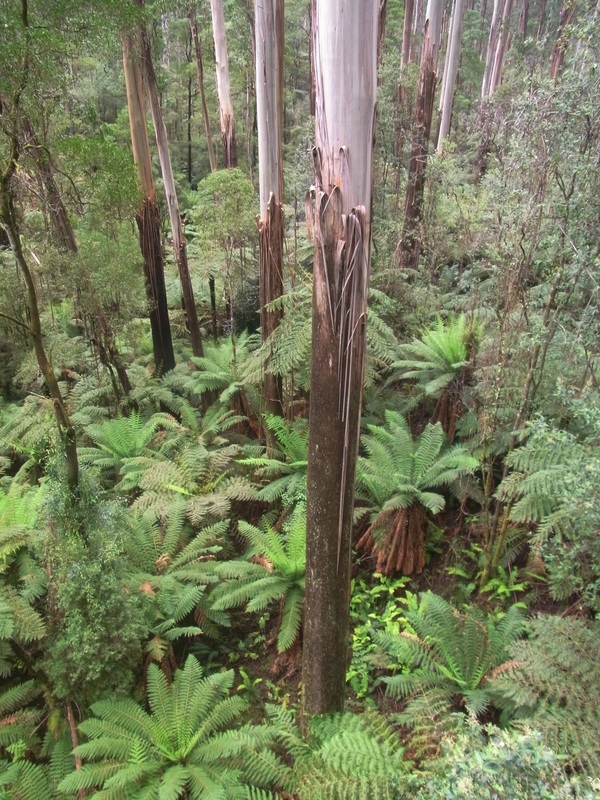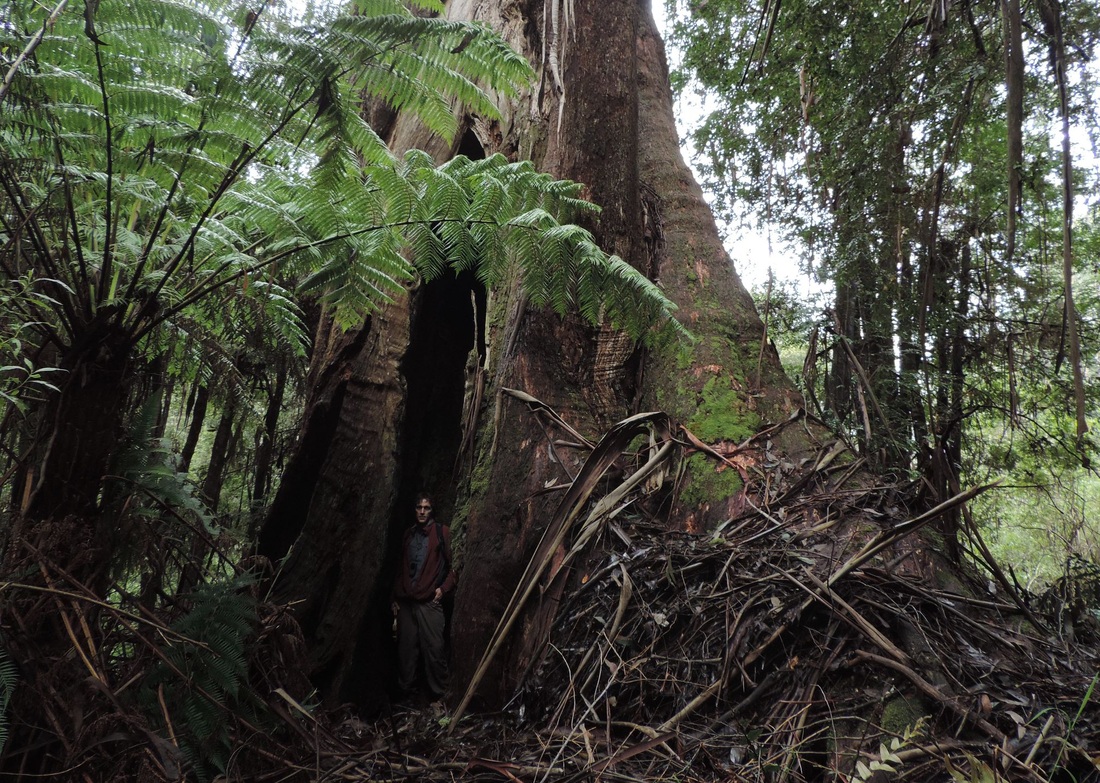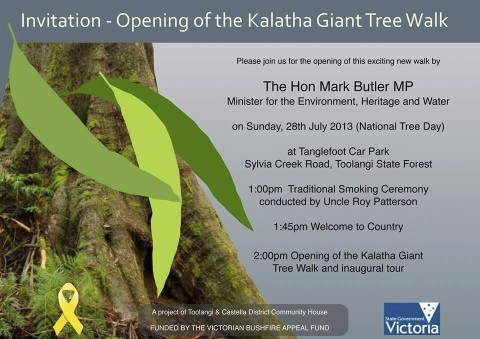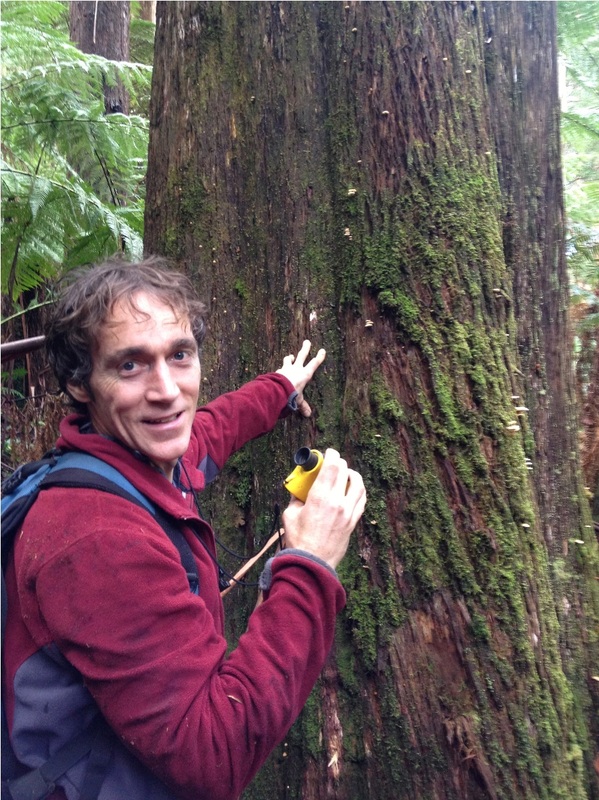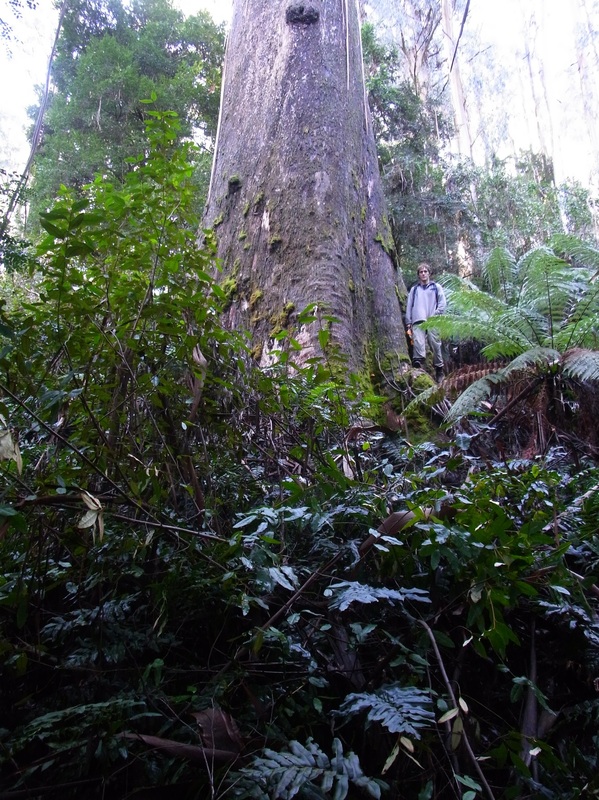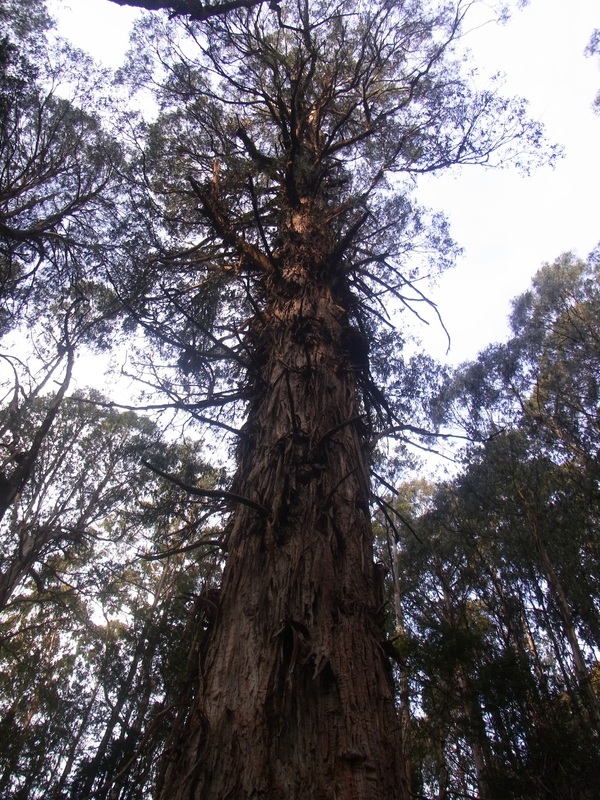Tall and Big Tree news:
From Victoria,Tasmania and occasionally other places!
Alice Saving Wonderland
One fine day, Alice *¹ went looking for Swift Parrots so that she could save more forest from being chopped down *². Swift Parrots, being birds, are small and fly around a lot, high up in the tree tops, so they are very hard to see in such a tall forest – and poor Alice was struggling to find any swift parrots. Suddenly, while looking up into the treetops Alice bumped into something very large back at ground level. It was so wide and so tall, it seemed like it was a wall – but she was in the middle of the forest - Alice thought: 'There are no walls out here!' On closer inspection, the wall turned out to be a giant tree – the biggest tree she had ever found. Alice knew that this tree was special and vowed to protect it from all possible harm *³.
*¹ Alice is campaign manager for the Wilderness Society, Tasmania
*² Alice and team were out there doing habitat density surveying for the critically endangered Swift Parrot
*³ While the tree sits just outside of the scheduled coupe, logging is currently paused there due to a court case
*¹ Alice is campaign manager for the Wilderness Society, Tasmania
*² Alice and team were out there doing habitat density surveying for the critically endangered Swift Parrot
*³ While the tree sits just outside of the scheduled coupe, logging is currently paused there due to a court case
Above and below - Alice's Giant tree 'Rose' - It is 20m girth and drops over 4.5m from the high to low points of ground!
Giants in Peril
Back in July, I received exciting news from Luke and Jason, two young, super keen big tree hunters from Tasmania about their latest find: ‘The Wyena Wall’ – a giant Eucalyptus regnans, 18.3m girth with a height of 78m, growing in the southern forests, about 10 km west of the town of Geeveston. Following on from that, in September, I received a follow up message from Luke saying that he, along with Jason and Alice Hardinge from The Wilderness Society, had found ‘A couple of big rigs today!’, when making a more thorough exploration of the grove. These ‘big rigs’ were: ‘Colossus’, a 16.8m girth and 72m tall Eucalyptus regnans and ‘Leviathan’, a 15m girth and 74m tall Eucalyptus obliqua. What made their efforts more important and pressing is the fact that this grove was listed as a logging coupe on Sustainable Timber Tasmania’s 3-year plan. Now that these 500-year-old giant trees have been documented as residing within the proposed coupe boundaries, it should mean that they will be protected from any future logging activity. However, it is concerning that a patch of unburnt old growth was put on the logging schedule in the first place, considering the huge loss of giant old trees in the 2019 bushfires (which, only managed to miss this grove by a few hundred meters).
I first had the opportunity to visit the grove in November of 2023 and it is a gem. Bordered by recent logging to the south, and regrowth from logging in the 1980s to the east and west, this wonderful patch of forest shows what can develop when fire and logging are absent for hundreds of years, with the giant trees are growing over an understory of huge tree ferns and rainforest trees – below are some photos that hopefully do some justice to this area.
I first had the opportunity to visit the grove in November of 2023 and it is a gem. Bordered by recent logging to the south, and regrowth from logging in the 1980s to the east and west, this wonderful patch of forest shows what can develop when fire and logging are absent for hundreds of years, with the giant trees are growing over an understory of huge tree ferns and rainforest trees – below are some photos that hopefully do some justice to this area.
Ancient Ogres of Mt Field
November 2023: Having spent over thirty years searching for big trees in Tasmania, I thought I had a pretty good idea where the very largest giant trees reside: They don’t seem to be found in the lower country, that is, below 150m above sea level (ASL) - and they are absent from areas over 600m ASL. Even though the target species like Eucalyptus regnans, globulus or obliqua can happily live beyond this band of elevation, they never attain the size or height of those found in optimal growing conditions. However, my perceptions changed when my friend Carl asked me if I wanted to see the high altitude grove of Eucalyptus regnans he’d discovered via LiDAR growing in Mt Field NP.
As you drive up the Lake Dobson Road, you initially pass through a damp forest of Eucalyptus obliqua and occasional Eucalyptus viminalis. Then you wind your way up through an extensive, multi-aged E. regnans forest with some sizable old trees with a well-developed wet sclerophyll understory, typical of a forest that has had a fire go through 50+ years ago. Eventually the going becomes less steep and you enter a forest of E. delegatensis ssp tasmaniensis (hopefully one day just E. tasmaniensis!) and Tasmanian Yellow Gum, (E. johnstonii) with a dense understory of rainforest species. These yellow gums are old, but not big nor tall and gave no hint as to what lay beyond them. However, this was where we left the car and started walking uphill through the yellow gums. Soon we were in a grove of very old, high elevation E. regnans, growing on relatively flat ground with a mature, easy to walk through rainforest understory. Carl showed me two giants he’d seen on his first trip there: ‘Grendel’ and ‘Polyphemus’, and then with a little more exploration we stumbled upon the largest tree of the grove, ‘Humbaba’ at almost 700m ASL – Incidentally, the names given to the trees are taken from ogres (or beasts) from Greek, Germanic and Babylonian mythology: They seemed a perfect fit for such old and gnarly trees.
As you drive up the Lake Dobson Road, you initially pass through a damp forest of Eucalyptus obliqua and occasional Eucalyptus viminalis. Then you wind your way up through an extensive, multi-aged E. regnans forest with some sizable old trees with a well-developed wet sclerophyll understory, typical of a forest that has had a fire go through 50+ years ago. Eventually the going becomes less steep and you enter a forest of E. delegatensis ssp tasmaniensis (hopefully one day just E. tasmaniensis!) and Tasmanian Yellow Gum, (E. johnstonii) with a dense understory of rainforest species. These yellow gums are old, but not big nor tall and gave no hint as to what lay beyond them. However, this was where we left the car and started walking uphill through the yellow gums. Soon we were in a grove of very old, high elevation E. regnans, growing on relatively flat ground with a mature, easy to walk through rainforest understory. Carl showed me two giants he’d seen on his first trip there: ‘Grendel’ and ‘Polyphemus’, and then with a little more exploration we stumbled upon the largest tree of the grove, ‘Humbaba’ at almost 700m ASL – Incidentally, the names given to the trees are taken from ogres (or beasts) from Greek, Germanic and Babylonian mythology: They seemed a perfect fit for such old and gnarly trees.
Above: The 19m girth base of 'Grendel' - note the rainforest understory of sassafras and myrtle
Torre Carmesi
August 2023: I’ve often waxed lyrical about the beauty of Victoria’s 1939 and 1926 vintage mountain ash forests. These stands are considered ‘in their prime’ - and with their often long, smooth boles and intact, vigorous crowns reaching for the sky, they make a dramatic sight, especially if you can rise above the understory and have an uninterrupted view of their majestic form. At lower elevations in the mountain ash range, trees with distinctly red tones in their smooth bark can sometimes be seen growing alongside their more typical light greenish grey toned peers. One such tree I named Torre Carmesi – ‘The Crimson Tower’. This tree stood out for more than just its unusual bark colour, which was in the process of peeling when climbed recently: It also was measured at 88m tall – one of the tallest regrowth trees in the state. Approaching 100 years old, the silver wattles and blackwoods that would have been profuse shortly after the 1926 fires, have largely collapsed. So now the views from high up in the tree showcased tall 1926 forest rising above a forest floor dominated by rough and soft tree ferns.
Tibetan Titan re-writes the record books!
Every now and then, a discovery comes along that completely changes the perception of how tall a tree species can get: Recently, a research team in Tibet used LiDAR to uncover a 102.3m tall Himalayan Cypress (Cupressus torulosa). This makes it the second tallest known tree species on earth, leap-frogging many famous species in the process like Mountain Ash (Eucalyptus regnans), Douglas Fir (Pseudotsuga menziesii), Sitka Spruce (Picea sitchensis) and Giant Sequoia (Sequoiadendron giganteum) - only the Coast Redwood (Sequoia sempervirens), growing to over 115m, has taller living specimens. A link to the story, including photos and a LiDAR scan of the entire tree is in the link below. If you look closely you'll see that the tree has a dead top, meaning it was once even taller!
'The Darkness'
An off track journey in search of giant trees is often a bit of a lottery. Usually, you make a series of big tree ‘targets’ via satellite imagery and aerial LiDAR mapping before you enter the bush and once you leave the track, you make your way as best you can between those points – Obviously you are hoping that the targets you have chosen will reveal a mighty tree or two and that the going through the ‘scrub’ is not too bad. Sometimes though, you have a bit of luck, and the big tree you find is not one of your targets, but something you spied a little way off your chosen route. In a two day off track mission in the remote Wayatinah forests in March 2023, I saw a big, broken off trunk a little off the bearing from our intended target and thought it deserved a closer inspection. We were rewarded with the impressive tree photographed below. Because its trunk is broken around 55m up, it didn’t show up as serious target on LiDAR. However, it vaults out from the surrounding myrtle and sassafras with a very solid trunk with little fluting or buttressing and with its 16m+ in girth and stovepipe lower trunk, it is likely over 250m³ in wood volume despite its relatively short stature. I named the tree ‘The Darkness’ due to the fact that due to the surrounding rainforest, not much sunlight ever reaches the base of this tree..
Giants on Vacation!
Sometimes when a tree is planted far away from its natural habitat and climate it can really struggle. Too hot, too cold, too wet, too dry in summer, wrong soil type: the potential problems are numerous. However, for many species of eucalyptus, being removed from their natural insect and mammalian pests has given them a freedom to thrive and two examples from New Zealand exemplify this. Firstly at nearly 46 degrees south, there is a small stand of Eucalyptus regnans growing in an eco-sanctuary near Dunedin on the South Island. The original trees were planted around 1870, however, a bushfire in the early 1900s has given rise to an even aged stand of very straight and healthy regrowth. The tallest trees in the grove are now over 82m tall and are easily the tallest known trees in New Zealand. Considering their sheltered aspect, the damp, cool climate of the area and the outstanding form of the trees, it is likely they have many years of upward growth left in them – who knows, maybe one day the tallest eucalyptus will be in New Zealand?! The second example is a giant Eucalyptus delegatensis, native to the montane areas of Victoria and NSW, planted in the Christchurch Botanical Gardens. There is some uncertainty regarding the actual age of the tree: A sign says they it was planted sometime between 1907 and 1913 – and the gardens shows a photo of the tree in its juvenile stage in the 1930s. What is certain is that the tree has really enjoyed the climate of Christchurch. Well away from its mountain home, the tree has thrived in the cool, relatively dry environment of a city that is close to sea level – in fact, I can’t think of a Victorian E. delegatensis that comes close to having a base like this one. But then again, it seems trees, just like people, often put on a few kilos when they go on vacation!
Super tall – but for how much longer?
Take a look at the tall tree in the first photo below and you’ll notice two things: Firstly you’ll see how the tree dwarfs the people walking along the road (arrow), and secondly, you’ll notice the crown has died back. This is the Andromeda Reserve in the Styx Valley, Tasmania. This stand was first noticed and spared from the chainsaw way back in the early 1960s by ANM (Australian News Mills) surveyors who noticed some very tall stems being cut in the vicinity. It is still not clear what caused the dieback. While the decline of the crowns occurred very quickly after the adjacent area was logged and a regeneration burn escaped into part of the lower stand, severe dry conditions that preceded the devastating 1967 fires could also have been a factor. Currently there are still nine trees in the stand that exceed 90m in height. The tallest of which is still 96m tall – that’s 315 feet under the old system. However, they are slowly losing height and in a decade or two it is likely that very few exceptionally tall trees will remain there.
Afterglow - An Unassuming Giant
‘Afterglow’ was discovered by Jan Corigliano and Carl Hansen back in 2021 in an off track search of the Glowworm Creek area. A few months later I was down in Tasmania and they were keen to show me another tree in the vicinity: ‘Ursula’, a gnarly old Eucalyptus obliqua. They mentioned they’d also measured a nice old Eucalyptus regnans not far off the route we were walking and they asked me if I wanted to see it – I of course said ‘sure – no worries’. We got there and I was stunned – I said to Steve Pearce of the Tree Projects who was also on the trip that day: ‘This tree is BIG!’ Carl’s written notes on the day they found it read –‘E. regnans, 16.8m girth, volume estimate: 235m³’. Now, there are quite a number of trees in Tasmania with a larger girth than Afterglow’s 16.8m figure, so they were probably thinking that this tree couldn’t be in the elite 280m³ trunk volume class. However, Afterglow’s base is round and solid, with very little of the fluting or buttressing that most of the larger girth trees contain. It is also a slow tapering beast, still 3m thick at 10m up and 2m thick at 40m. Steve Pearce was impressed enough with the tree to go back a few days later with Shaun Green to climb it and take tape wraps at regular intervals as they descended down the trunk. The total volume came in at 305m³ (+/- 5m³) - which puts it in the top 6 largest trees (by volume) currently known in Australia! What is also interesting is that there is an abandoned bulldozer track not far from the tree. This was to be the road from which the logs were to be taken out. However, the 1990 extensions to the World Heritage Area came just in time to spare this forest and its largest inhabitant from the chainsaw!
Vale Derek McIntosh
March 2023. For those of us who have an interest in large and tall trees, one of the first places you would search for information on giants all across Australia was the National Register of Big Trees (link below). This wonderful resource was the project of Derek McIntosh. Starting over 13 years ago, the register lists literally hundreds of trees, both native and exotic and includes measurements, photos and geographic locations. The amount of travelling and communication Derek undertook to follow up on all the tree nominations he received from the public was truly enormous – and the sheer size and scope of the register is a tribute to his passion and genuine love of trees. Unfortunately, Derek passed away recently after a relatively short illness and our thoughts are with his family and friends. However, he leaves behind a wonderful legacy. He has been an inspiration to both me and to many other people who have an interest in our wonderful trees. I had the honour of spending time with Derek on a number of occasions both in Victoria and Tasmania. I remember these times fondly: Derek’s enthusiasm and love of the forest and trees was infectious. Below is one of my favourite photos – Derek (left) Tom Greenwood (centre) and myself at the base of the Kermandie Queen in Tasmania – we had just finished measuring what was then, the largest known tree by points in Australia!
Regrowth Rules! (In Victoria)
When I started attempting to find and measure the tallest trees in Victoria back in 1990, I naturally assumed that I should focus my search on finding large, mature or old growth trees. I thought: Surely trees that are 200-400 years old will be taller than those not even 100? For about a decade I held that view. However, it wasn’t until I began to use a laser rangefinder in the year 2000, an instrument that allowed me to accurately measure the heights of many hundreds of trees in a day, that I had an epiphany: The regrowth forests from bushfires in 1926 and 1939 were producing individual trees that were getting seriously tall - almost rivalling trees four or more times their age. In turn I realized that it wouldn’t be too long before these exceptional regrowth trees would one day be the tallest trees on the mainland. I also noted that the best regrowth sites were not at the higher altitudes where the surviving tallest old growth trees of Wallaby Creek, Mt Monda and O’Shannassy were (all between 690-950m above sea level), but more at the lower parts of the mountain ash range (200-400m above sea level).
Well it is the summer of 2022/23 and I now think that in Victoria there are more trees over 80m tall in the regrowth forests from 1926 and 1939 than in all the remaining old and mature forests. Below are some photos of some rocketing regrowth from Victoria's mountain ash forests.
Well it is the summer of 2022/23 and I now think that in Victoria there are more trees over 80m tall in the regrowth forests from 1926 and 1939 than in all the remaining old and mature forests. Below are some photos of some rocketing regrowth from Victoria's mountain ash forests.
Gleaming trunks of 1926 Mountain Ash regrowth in a gully rocketing towards the sky (Photo Carl Hansen)
A sea of tall trunks - 1939 regrowth Mountain Ash
Spring in the Victorian Tall Forest
While the tall wet forests of Victoria are dominated by the evergreen mountain ash and associated understory shrubs , there is still a flush of spring growth of the ferns on the forest floor and a splash of white or creamy flowers from some of the large daisy bushes like Musk Daisy (Olearia arophylla) Blanket Leaf (Bedfordia arborescens). If you look carefully at the photos below, you will see some of these subtle features of spring. I should mention here that the tree we climbed was 90.85m tall – one of only six trees on mainland Australia known to exceed 90m in height!
Beauty of the Beasts
They say beauty is in the eye of the beholder! So despite the fact they have long since moved on from their aesthetically pleasing, symmetrical juvenile form, these giants from the Denison forests in southern Tasmania present a wonderful sight in their gnarled old age. After all, if you’ve been around for five hundred years or more you can’t but help develop a little character!
Above left: 'Gargoyle North' - 18.5m girth 65m tall above right: ''Dragonstone' 17.7m girth 60m tall - both trees are giant stringybarks, Eucalyptus obliqua
Above and below - three views of 'The Fortress' a giant Eucalyptus regnans, 16.5m girth 77m tall to a broken top
Ancient King Billy Pines
One of Tasmania’s iconic trees, King Billy Pines, Athrotaxis selaginoides, are restricted to cool, mountainous terrain in the south, central and western parts of the state. They are quite slow growing and studies have shown that in the right conditions - and in the absence of fire - they can reach extraordinary ages of over 1700 years. The King Billy Walk in the Cradle Mountain national Park traverses through enchanting rainforest mostly consisting of Myrtle Beech and Sassafras. However, a small section contains some ancient King Billy Pines. The two trees featured below are easily the largest I have ever seen. ‘Uncle Bill’ is 8.9m girth and 29m tall, while ‘King William’ is 9.5m girth and 27m tall.
'Above: Two views of 'Uncle Bill' Below: 'King William'
Alpine Yellow Gums
At the risk of starting a debate, I'm nominating the the Alpine Yellow Gum, Eucalyptus subcrenulata, as having the most beautiful trunks of all the eucalypts - I know that is a big call so I've provided some examples below of them gleaming in stunning autumn shades!
Magnificent Myrtles
The burled, twisted and contorted trunks of these ancient myrtles seem perfect for a haunted forest movie scene. Trees such as these can only develop when the forest has been free of fire for many centuries.
Black Jack Tower
Over recent years, the magnificent 1939 regrowth Eucalyptus regnans forest along the Black Spur has become very popular as a scenic drive. You often see people driving along, holding their phones or video cameras out the window or through the sunroof, taking in the marvellous atmosphere of a mountain ash forest in its prime. This particular forest route has both a rich indigenous and European history. The spur was the favoured path for the local indigenous tribes as a travel and trading route, making their way through the Great Dividing Range from the Yarra Valley into the rivers that flow northward to the Goulburn – in fact it got its name when a team of surveyors, trying to find a suitable way through the mountains met, a party of indigenous people travelling through the spur in the opposite direction. In the middle to late 19th century the town of Fernshaw developed on a flatter section of the Watts River. This thriving timber town was subsequently removed, cesspits and all, when the whole area was declared a closed water catchment in the 1880s. The site of Fernshaw is now a delightful parkland complete with exotic trees planted from the 1910s to the 1930s. The area was hit by both the 1926 and 1939 bushfires. So poor was the eucalypt regrowth in some areas following the second fire that large areas of the spur were replanted with seedling mountain ash by hand. Today, over 80 years later, no one actually knows which trees regenerated naturally and which were hand sown. Either way, the mountain ash regrowth is both beautiful and very tall. How tall you ask? Well, young tall tree hunter Jack Chianta has found a tree growing right along the road that is over 88m tall (that’s almost 290 feet) – You may ask, why hasn’t anyone measured this tree before? Well, the Black Spur road is no place to be if you are a pedestrian – the road is narrow and winding, there is no footpath, the speed limit is 80kmh and technically, as it is a water catchment, you are allowed to drive through the area but not walk along the road. Furthermore, there are so many tall trees along the 6km section between Fernshaw and Dom Dom Saddle it would take a days to measure them all, even if you could access the road. Nevertheless, there are some walking tracks within the catchment where the public is still allowed to go - and it was from one of these tracks that Jack was able to spy the ‘Black Jack Tower’ pictured below. This astounding tree is not sheltering in a protected gully, it is right by the asphalt on a rare straight section of the road. It has clearly got special genetics as it towers a good 10-15m above its neighbours. Finally, a word of caution: This section of road is notorious for its narrow lanes, tight corners and slippery conditions with cars regularly ending up sideways or worse, upside down in a fern gully. So if you are travelling through the area and looking out for this tree, just promise me that you are a passenger and not the driver!
Above: Black Jack Tower 88m+ tall Below: The glorious forest seen driving along the Black Spur
A new member of the 85m+ tall tree club!
When a newly measured tree breaks the height record for that particular species, the difference between the previous champion and the new one is usually measured in centimeters, or maybe a meter or two. The rationale here is, that after many years of observations, the upper height limit for a given species is generally well understood. Recent examples include the 2021 Douglas Fir and Sitka Spruce discoveries in California which broke previous records by 50cm and 1.1m respectively. In light of this background I can announce the discovery and measurement of an 85m tall Mountain Grey Gum (Eucalyptus cypellocarpa) growing on a steep, south facing slope in the Errinundra National Park in remote East Gippsland. This smashes the previously tallest known Mountain Grey Gum by 14m (also from East Gippsland but killed in the 2019-2020 Black Summer Bushfires) and will completely rewrite the eucalyptus reference books and guides which invariably list it as being ’12-60m tall’. Furthermore, being 85m tall gives it membership to an exclusive club – only 12 other tree species in the world currently have a living specimen over 85m. There were three other Mountain Grey Gums measured in the grove at 83, 82.5 and 82m tall, with the potential for many more around this height further down the hill, indicating that the 85m tree was no freak. However, accessing the stand certainly was a challenge: The initial descent involved terrain that combined loose rocks, thick bushfire regrowth and creeks that had suffered landslips – We tried a different way out thinking ‘What have we got to lose?’ It was then we discovered we had to negotiate a series of wet, moss covered granite cliffs where any fall could have meant disaster. Nevertheless, we all made it out in one piece, and, in retrospect, surely you could argue that a discovering new member of the 85m tall tree club deserved a serious adventure?
Below are two photos of the tree - in the first photo, Jan Corigliano and Carl Hansen can be seen at the base of the tree. A recent storm had knocked over a couple of large trees quite a way uphill from the tree and in doing so had cleared a perfect photo and measuring pathway to the tree! In the second photo, the 85m tree is actually the bifurcated tree in the middle - the tree that appears taller is actual uphill but still 83m tall.
Below are two photos of the tree - in the first photo, Jan Corigliano and Carl Hansen can be seen at the base of the tree. A recent storm had knocked over a couple of large trees quite a way uphill from the tree and in doing so had cleared a perfect photo and measuring pathway to the tree! In the second photo, the 85m tree is actually the bifurcated tree in the middle - the tree that appears taller is actual uphill but still 83m tall.
Below, a close up of the beautiful mottled grey trunk with Jan and Carl at the base for scale
‘Lone Wolf’ confirmed over 90m tall
In mid-March 2022 Tom Greenwood and I climbed and measured a tree that had first been located by LiDAR back in 2018. Located off Mt Bride Road south of the town of Warburton, this tree grows in a gully which has helped it survive through numerous fires that have ravaged the area over the course of its 250+ years on this planet - including the deadly 1939 Black Friday blaze. The tree came in at 90.7m tall to live green leaves and I gave it the name ‘Lone Wolf’ as it is the only 90m+ tall tree known in the ranges between Powelltown and Warburton. It would also have once likely been considerably taller as the original top had long ago broken off and the current tallest part was a much smaller side shoot coming out below the old break. Below are a few photos from the climb.
The view north from Lone Wolf shows some myrtle beech rainforest (dark green), a few 250 year old trees and the pointed crowns of logging regrowth from the 1970s and 1980s in the background
R.I.P. Master Bennetts
When exploring the fire ravaged old forest off Bennetts Road in the Arve Valley following the 2019 fires, Master Bennetts, the grove's largest known tree at 318m³ in trunk volume, was burnt but still alive. In April 2021 I saw it again and noticed it was leaning. Sadly, when visiting the same area in March 2022 we found the tree had fallen. I had named many large trees in this impressive grove over the last twenty years – I had always given them the ‘Bennetts’ surname. The list of fallen giants now includes, Baron, Elder, Friar, Toby, Sargent, Fluted, Black Spiral and now Master Bennetts. The death of all these giants shows just how devastating even a low intensity burn can be to trees in the 500 year old age class. Any tree that age will invariably have areas of rot and hollows where a fire can enter and cause significant damage. Interestingly, most of the young trees in the grove which started their lives after fires in 1934 and 1967 were largely unharmed by the same 2019 fire.
Bodog The Branchless
When following up some LiDAR hits near Wayatinah, we came across an extraordinary tree. It was 83m tall which is tall but unremarkable, however, it was completely branchless for 62m. When I say branchless, there was not even a single tiny epicormic shoot breaking out along its entire bole. I thought this tree was newsworthy as I am unaware of any other tall tree in Australia that is totally branchless to such a height (if you do know of one, let me know!). We named it ‘Bodog the Branchless’ in honour of Jan’s great grandfather.
Grandest of all Globulus
Blue gums (Eucalyptus globulus) are quite common in the eastern half of Tasmania. They are an adaptable tree and can grow in areas of poor soil and fairly low rainfall – in these situations they often don’t exceed around 25-30m tall and can branch at a fairly low height. It is only when blue gums occupy an area of high rainfall and good soil that they show their true potential, however, they are mostly absent from these wetter, fertile forests – possibly as a result of being outcompeted by E. regnans and E. obliqua following the end of the last glacial period around 10,000 years ago. Nevertheless, there is a stand of very old and large blue gums that survives off the Denison road a few kilometers west of the town of Judbury. They avoided the 2019 bushfires by a whisker and they are probably the last remaining 500 year old Blue gums, growing in tall wet forest alive on earth. This stand includes the 90.7m Neeminah tree – which, being on the edge of a logging coupe, now sadly has a declining crown. However, it also includes other fantastic blue gums, some of which are featured below.
Above and below: 'Lathamus Keep' 78m tall, 16.8m girth
Yowiepaw
Deep in the wilderness forest west of Wayatinah we stumbled upon this 21m girth, 69m tall Eucalyptus regnans tree. It was in a quite high altitude for a Tasmanian giant at around 600m above sea level. It was also surrounded by a dense understory of Native Laurel (Anopterus glandulosus) making it almost impossible to get a decent photo of the tree. While not likely a giant in overall wood volume, it is just one of 8 trees I have found that measure over 20m girth in Tasmania.
Missed it by that (3 years…) much
The initial exploration through a patch of old forest along Coles Creek in the Florentine Valley had begun in a mix of rain forest and 500 year old eucalypts. There was some good sized trees in the 12-14m girth range and the walking was easy on flat ground with an occasional crossing of the constantly winding Coles Creek. Then we moved into an area that had been burned by the 2019 fires. And just as luck would have it, we came across easily the largest tree seen on the day and it had been killed by the fire – a fire I might add that had stopped a mere 30m further east. The tree was over 21m around at breast height, so it would have been one of the largest trees by girth in the state. At least we have the photos below to show what a beast it was….
La Belleza - The Beauty
Eucalyptus regnans trees like to grow fast and straight. Usually this means that in the first 30 or so years, all trees in a stand will look pretty similar. They have narrow pointy crowns with small branches that gradually die out once they are shaded out from above. It is only once a tree reaches 80-100 years in age that its crown starts to broaden out, its base starts to develop buttresses and the tree will start to form larger branches, often growing at seemingly strange angles or directions as a result of nearby canopy openings or just in the search for light. When a tree reaches over 200 years old it should have lost all resemblance to its pointed juvenile form – basically any tree of this age should be showing some serious signs of middle aged spread! This is why the tree I recently discovered in the Florentine Valley in Tasmania and called ‘La Belleza’ (The Beauty) is so unusual. It started its life in a fire around the year 1800 – all the trees around it have crowns typical of trees that have matured and survived for over 220 years. However, by some quirk of fate, ‘La Belleza’ somehow has retained a beautifully narrow and symmetrical crown. To top it off, it is just over 89m tall – one of the tallest live topped trees remaining in the state – so hopefully it can continue to grow taller in the decades to come.
Giants Hiding in Plain Sight
When reading the stories and looking at the accompanying photos of giant trees on this site you could be forgiven into thinking that everywhere you go in Tasmania you will ‘discover’ some previously unseen giants. The truth is a little different: The forests where truly giant (over 280m³ in wood volume) or tall (over 85m in height) trees can be found is limited to a rather thin strip running from Wayatinah in the centre of the state to Esperance in the south. East of this ‘strip’ the rainfall drops considerably and much of the land is cleared for agriculture or supports dry forests of much smaller stature. West of this strip takes you to the mountains, rainforests and buttongrass plains of the central, west and south west World Heritage Areas – a truly magical place - but not known for its giant eucalyptus trees. Furthermore, the forest areas where giant trees currently live are not commonly visited by the general public and motorists also don’t generally go through, for example, the Styx, Florentine, Arve or Picton Valleys as they are not ‘on the way’ between two towns. What I’m trying to say is that the casual tourist to Tasmania could visit a whole range of well-known areas - Hobart, the Tasman Peninsula, Freycinet and Maria Island on the East, Cradle Mountain and Lake St Claire in the centre, Strachan and Queenstown in the west, Launceston, Devonport on to Burnie in the north – and think that the state is devoid of huge trees. And unless they take the Tall Trees walk at Mt Field NP, they could be forgiven that thought.
In 2022, finding ‘new’ giants is now not an easy task. Let’s leave aside the fact that so much of the best old growth forest has been clearfelled in the past 60 years. We’re talking here about searching through what is left: Firstly regarding tall trees, virtually all the best forest areas have been height assessed by LiDAR. So the chances of finding a new 90m+ tall tree is rather slim. So the hunt in recent times has been for giants in girth and volume. You’d think it would be likely that most of the easier to find giants, those close to roads and tracks were noticed long ago. However, it is amazing what can be missed when you are standing close to or in dense forest. Therefore using LiDAR to assess crown size has opened up new areas and individual tree targets to explore. Sometimes this means going deep into wilderness areas. A few of these ‘finds’ from the past few months are featured below.
Above Left: 'Elixir' (Eucalyptus delegatensis) 82m tall and 12.8m girth - a very remote tree in the Wayatinah WHA. Above right: 'The Home Tree' a 73m tall, 17m girth Eucalyptus obliqua growing in an area originally scheduled for logging but now protected
Above: 'Afterglow' an enormous Eucalyptus regnans, 16.8m girth, 76m tall and over 300m³ in wood volume - joining a truly elite club!
Above and below: 'The Mystery Giant', 92m tall and 17m girth - the bifurcation starts at 40m and completes the split at 46m.
Above and below: 'Lady Binney's Lover' - 15m girth, 75m tall - a magnificent, fully intact old growth Eucalyptus obliqua
Above: Carl with the incredible 'Wall of Death' 17m girth - This tree has one of the most bizarrely shaped bases I've seen in a giant eucalypt - You can touch the back side of the tree through the door!
Above left: The super gnarly Eucalyptus obliqua 'Ursula' - 17m girth. Above right: 'Gorgeous' 16.8m girth 79m tall
Above left: 'The Hermit King', 20m girth, 71m tall deep in the Wayatinah WHA. Above right: The suitably named 'Warthog' in the Styx Valley
The 'Lone Black Ranger':
Majestic even in decline!
The Lone Black Ranger is the only very old tree surviving in an area of the Narbethong State Forest that is better known for its mountain bike tracks, conifer plantations and 10-25 year old logging regrowth. I discovered the tree when searching for big trees using satellite imagery - in this case the tree’s long dead broken upper trunk was clearly visible. My USA based, conifer loving friend, Bob Van Pelt once said when describing a particular tree ‘A little decadence is a good thing’. Well, the Lone Black Ranger has decadence in spades! The tree’s 14.7m girth base has a hollow section and now you can see right through the trunk. However, even though its core is decaying and rotting, the tree is still trying its best to keep growing and repairing itself by putting out aerial roots over the rot. While its original crown is long gone, its replacement epicormic branches have become huge and gnarly in their own right. Below are some photos of this true survivor.
Above and below: Jack Chianta next to the base of the Lone Black Ranger - note in the photo above the aerial root reaching down over an area of rot - this is repeated on the other side of the tree in the photo below. Also notice the pile of fallen bark and twigs. While some of this debris will break down over time, if a fire were to come through the area, this debris would spell doom for the tree.
Super Firs!
In September 2021 Michael Taylor and Steve Sillett measured two live topped old-growth Douglas Fir Psuedotsuga menziesii trees at 99.5m and 98.8m tall. These super tall firs are growing in the state of Oregon USA and Michael Taylor initially located them by painstakingly analysing publicly available LiDAR data. The trees were measured by a tripod mounted, remotely triggered TruPulse laser - a method which gives incredibly accurate results - comparable to a climber deployed tape drop. The 98.8m tall tree is estimated to be 600 years old and has a girth of 9.9m and a trunk volume of over 205m³. While the taller 99.5m tree is a little younger, estimated at around 460 years old and its girth is 7.6m with a wood volume of approximately 135m³. These glorious trees are pictured reaching for the sky below.
A Hidden Battle for the Land
People often look out at a mature eucalyptus forest and think what they are witnessing as an example of ‘nature in balance’ – where all the plants are happily co-existing and everything has its place. However, all is not what it seems: No matter how slowly they may be occurring, battles are being fought, not only locally for light, water and nutrients, but for the whole local ecosystem. In Victoria, the rainforest tree species of Myrtle Beech Nothofagus cunninghamii and Sassafras Atherosperma moschatum are primarily restricted to high rainfall, riparian vegetation alongside creeks and rivers at altitudes between 200-1200m. However, there are a few parts of the Central Highlands where fire has been (miraculously!) absent for at least 300 years. In this environment, these rainforest tree species slowly spread out from their typical creek-side environment and gradually become the dominant understory species in the wet sclerophyll forests dominated by towering old growth Mountain Ash Eucalyptus regnans and Shining gum Eucalyptus nitens. Even though we can’t see it happening, a slow moving life and death battle for the land is occurring in this environment: If there is no fire, the old eucalypts will slowly die off due to decay, old age and storms. In this scenario the rainforest becomes king and takes over. However, if there is a fire or a series of fires, the rainforest will be swept back to its creek-side origins – or worse, in the most catastrophic fires, completely removed from the landscape.
A wonderful day trip deep into this old growth mix of rainforest and wet sclerophyll forest revealed some previously unseen tall trees. One of these trees I named ‘Snowflake’ came in at over 86m tall. Found at an elevation of over 975m above sea level, this is the highest altitude known for an 85m+ tall tree in Australia.
Below: 'Snowflake' an 86m tall Eucalyptus regnans - note the rainforest biding its time in the understory....
Below left: 'Curly Top' 88m tall Below Right: 'Belleza Oculta' ('Hidden Beauty) 89m tall
Day of Discovery
When searching deep off track for giant trees, some days are better than others: There are times when you get torn to shreds by wiregrass or sword-grass, or you get caught in thickets of Mountain Correa, Correa lawrenciana or Horizontal, Anodopetalum biglandulosum and be reduced to covering less than 200m in an hour. You can accidently slide down steep fern gullies, or worse, fall off giant logs that impede your progress. You can get your blood sucked by leeches and ticks or come face to face with a very upset tiger snake. On some days it drizzles, on other days it pours and sometimes if you are really lucky it snows! And the truth is that you endure these trials and tribulations in the hope that you will find something outstanding - and even though you are usually walking through amazing bushland, 99% of the time the much anticipated ‘giants’ turn out to be way smaller or shorter that you’d hoped for. So it is in this context that I say that Jan Corigliano and Carl Hansen had a very special day out in the Beech Creek Forest near Wayatinah in mid July 2021. Firstly they discovered a new 300 foot live topped Eucalyptus regnans, the ‘Mystery Giant’. At 91.3m tall and 17m in girth, this tree is easily the largest known 90m+ tree in Australia – it should top 250m³ in volume – maybe even make the magical 280m³ (10,000 cubic feet – an elite class of tree). The ‘mystery’ part of its name comes from the fact that unlike every other 85m+ tree known in Tasmania, this tree was not picked up when Forestry Tasmania was assessing all the LiDAR data between 2008 and 2014. It was only Jan’s ability to scrutinize the LiDAR data for tree height and crown volume that he was able discern that a potential giant had been previously overlooked. Next came the confirmation that the mystical ‘King Stringy’ – a supposed 86m tall Stringybark, Eucalyptus obliqua (hence the King Stringy) that had been on the Tasmanian Giant Tree register for 17 years, was both not at the location given in the original documents but also clearly a Eucalyptus delegatensis not a stringbark! To cap off the day they also discovered the very impressive 18m girth ‘Hells Burls’ (AC/ DC fans should get the reference).
Above and below: Two views of the baser of the 'Mystery Giant' 91.3m tall, 17m girth
Below: The crown of the Mystery Giant
Below: The 85m tall Eucalyptus delegatensis - note the tell-tale smooth bark of the upper branches that differentiates this species from the similar Eucalyptus obliqua
Below: Three views of the incredibly gnarly 'Hells Burls' 18m girth 71m tall
Hidden Gems off Mt Donna Buang
In midwinter, walking off track in Victoria’s mountain ash forests would best be described as a cold, damp and slippery experience - and if you are walking on a south facing slope you could also add in dark as well because even if it is a sunny day, it is highly unlikely any sunlight will actually get down to you on the forest floor. This is especially so when walking under a grove of tree ferns or a patch of myrtle beech rainforest. On a recent trip on a glorious winter’s day, we experienced such conditions on a steep south facing slope near Mt Donna Buang. While the sun never reached us on the forest floor, we used this as an advantage because in these conditions, the sun only hit the tops of the tallest trees, highlighting the areas where we needed to aim our lasers. All up we measured four trees over 85m tall – the tallest coming in at 89m. Some of these amazing 250 year old trees are clear of branches for over 50m - check out the photographs below:
Left: 'Bulin-Bulin' Woiwurrung for Lyrebird Centre:'Bunatalang' Woiwurrung for Eastern Grey Kangaroo Right:'Datnam' A Wurundjeri Parrot Spirit
89m tall 88m tall 87m tall
89m tall 88m tall 87m tall
Above: Alice putting the tape around the 88m tall, 8.5m girth 'Bunatalang'
Super Spruce!
In late June 2021 a new species was added to the illustrious 100m tall tree club! A Sitka Spruce (Picea sitchensis)was confirmed at 100.2m tall growing in Humbolt County northern California - a place more famous for the mighty Coast Redwoods - The figure of 100.2m comfortably beats a 99.1m spruce discovered in April. When the tree's height was confirmed, the two measurers, Steve Sillett and Michael Taylor let out screams of joy as they had been searching for this elusive first non- redwood conifer to reach over 100m tall for over 30 years! Unlike the Coast Redwood which can live for 2000 years or more, Sitka Spruce generally live fast and die young (relatively speaking!) meaning that it would be very unusual to find a spruce over 450 years old. What is remarkable is the the way these spruces have been discovered: In the redwood forests there are 100s of redwood trees over 100m tall. However, my friend Michael Taylor has been able to use available LiDAR data to differentiate between species. In this way he was able to isolate tall Sitka Spruce hits from the far more numerous Coast Redwood hits. He then had to delve deep into the forest to confirm the exact height of the tree in situ - as there always will be variables such as the steepness of the slope, the extent of buttresses and the build up of centuries of duff.
Photos below from Steve Sillett are the 100.2m tall spruce on the left, (with an arrow to indicate just how thrifty its top is!) - and the 2nd placed 99.1m spruce on the right.
King Karri !
Dotted around many of the forested regions of Australia are signs proclaiming a ‘Big Tree’. Often these trees are accompanied by various statistics and information including the height, girth and estimated age of the tree. Of course what exactly constitutes a big tree depends on many factors – girth, height, the species in question – not to mention the comparative knowledge of the people creating the signs and making the walking track to the tree! Sometimes the signposted ‘Big Tree’ is of truly stupendous proportions as was the case with the now fallen Arve Giant, inland from Geeveston, Tasmania which was one of the largest recorded trees in Australia – at other times the tree in question is rather small: An example of this is the ‘Standing Giant’ at Mt Worth State Park in Victoria. This tree would not rank in the top 1000 largest trees in the State and yet it has its own walkway and interpretive sign!
In the forests of south west Western Australia, the words ‘Big Tree’ are often replaced by the title ‘King Karri’ (Eucalyptus diversicolor) – And my friend Russell Du Guesclin has been tracking down and measuring these WA giants for well over 20 years (check out his website here).
In the forests of south west Western Australia, the words ‘Big Tree’ are often replaced by the title ‘King Karri’ (Eucalyptus diversicolor) – And my friend Russell Du Guesclin has been tracking down and measuring these WA giants for well over 20 years (check out his website here).
Recently Russell was following up yet another tree named ‘King Karri’ that had long been on his list to visit and measure – This tree was on the ‘WA Significant Trees Register’ and was listed as 3m diameter at breast height - considering the largest Karris he had measured were all significantly larger than this figure he was not expecting anything special. Furthermore when he got to the site, a sign estimated the tree probably contained over 100m³ of wood, again well short of the wood volume figures of the largest known Karri trees. However, when Russell saw the tree with is slow tapering trunk, he instantly knew it was a whopper! His measurements put the tree at 198m³ in wood volume, making it the 4th largest known Karri tree. Furthermore, its slow tapering trunk meant that from 25m upwards it is the largest known tree in WA – this tree has certainly earned the title of king Karri !
Above and Below: King Karri South West WA: To add a sense of perspective in the photo below, check out where the upper left side branch breaks - at this point it is still 1m thick! - Photos Russell Du Guesclin
New species of giant!
You’d think that in the year 2021 that we’d have a pretty good idea of all the known tree species in Victoria that reach ‘Giant’ status (over 12m girth or 100m³ in wood volume or over 70m tall). However, clearly this is not the case because Jan Corigliano has recently returned from a trip to East Gippsland where he measured a Brown Barrel (Eucalyptus fastigata) at a whopping 13.75m in girth and 40m tall. Eucalyptus fastigata is most closely related to the largest of all eucalypts, Eucalyptus regnans, Both are the only Victorian eucalypt species having paired buds and fruits. The two species are easy to tell apart because E. fastigata has rough bark over the entire trunk and larger branches, whereas E. regnans has a short stocking of rough bark on the lower trunk only.
The following species are currently on the Victorian ‘Giant’ list:
Eucalyptus regnans
Eucalyptus nitens
Eucalyptus denticulata
Eucalyptus obliqua
Eucalyptus cypellocarpa
Eucalyptus viminalis
Eucalyptus camaldulensis
Eucalyptus globulus
The following species are currently on the Victorian ‘Giant’ list:
Eucalyptus regnans
Eucalyptus nitens
Eucalyptus denticulata
Eucalyptus obliqua
Eucalyptus cypellocarpa
Eucalyptus viminalis
Eucalyptus camaldulensis
Eucalyptus globulus
Above and below - two images of 'King Brown' the newly discovered largest E. fastigata - photo: Jan Corigliano
Jan also assessed the health of the Kelly Creek Giant, a huge Eucalyptus obliqua that was severely burnt in the Black Summer bushfires in January 2020. It looks as if the tree will survive as there is a good amount of live foliage that has re-sprouted. The main danger is whether the fire damage to its lower trunk has compromised its stability making it more susceptible to damaging winds.
Above and below: Two photos of the Kelly Creek Giant - the largest Eucalyptus obliqua known in Victoria - photos Jan Corigliano
From a giant to a hulk - a bushfire survivor
The giant Grey Gum, Eucalyptus cypellocarpa at Ellery Saddle in East Gippsland is one of the most remote giant trees in the state of Victoria. Even though it is just 60m from the road it would take six hours to drive there from Melbourne. Large swathes of the wonderful forests of East Gippsland were impacted by the 2019/2020 Black Summer Bushfires and sadly this tree was no exception. Its crown, which once consisted of a series of huge, wide spreading branches was completely destroyed and the tree is now just a hulk with a furry coating of epicormic growth covering the trunk. The photos below show the tree before and after the fire and illustrate just how much a severe fire changes an environment - the place is almost unrecognisable from how it looked before the bushfire: Prior to January 2020 the undergrowth was a mix of ferns, wet sclerophyll species and rainforest plants creeping up from the rainforest gully - while the tree ferns and bracken are survivors from the pre-fire vegetation, a year later there is now a profusion of fireweeds carpeting the ground with a complete absence of many species that once created a thick, lush understory.
Above: Three pre-fire views of the giant grey gum at Ellery Saddle, East Gippsland taken in 2010.
Below: Two views of the tree one year after the fire - notice the understory dominated by fireweed and bracken and the epicormic shoots on both the giant grey gum and the other eucalypts in the background. (two photos below courtesy of Chris Schuringa from the Goongerah Environment Centre)
Below: Two views of the tree one year after the fire - notice the understory dominated by fireweed and bracken and the epicormic shoots on both the giant grey gum and the other eucalypts in the background. (two photos below courtesy of Chris Schuringa from the Goongerah Environment Centre)
Tasmania January 2021
The island state of Tasmania is a land of botanical contrasts. Not only is it home to the largest eucalypt on the planet, Eucalyptus regnans, but also the smallest - Eucalyptus vernicosa, with the latter sometimes seen mature at only 30cm high. It is also a place where you can still see remnant conifers that have ancient origins linked to when Australia was part of the super continent Gondwana. They survived in the cooler and wetter parts of Tasmania while becoming extinct on the mainland as fire and drought became more widespread. In January 2021 I was lucky enough to observe some of the amazing plant life that calls Tasmania home.
January 2021: The tall trees of the future

LiDAR stands for 'Light Detection and Ranging'. It is a form of remote sensing where light in the form of a pulsed laser is used to measure distances. It has a number of uses, one of which is in forestry where LiDAR surveys can show both general canopy and individual tree heights. I was checking some LiDAR hits in the Wayatinah area about 300m off Lyell Highway– these 'hits' were in the 85-86m range and on a steep slope. Usually with old trees on steep slopes the LiDAR figure overestimates actual tree height by about 2-10m. However, on this occasion, to my surprise and delight, the LiDAR figures were very accurate. However, the reason these hits were spot on was because the trees were only 100-120 years old. While tree heights exceeding 85m are not unusual for trees less than 100 years old in Victoria, all of the previously known trees over 85m in Tasmania were at least 200 years old with most in the 400-500 year age class. So these are easily the youngest trees in Tasmania known to be over 85m tall – and as they will be still growing strong, with a bit of luck they may one day become the tallest trees in Tasmania as the older cohort dies out.
January 2021: The tallest Stringybark
I’d always regarded a 90m LiDAR hit in the West Picton area as suspect. The place had been extensively logged, was full of Eucalytus obliqua (not the normally taller Eucalyptus regnans) and the few remaining old stringybarks you could see from the road were mostly wind blasted and in serious decline. A while back I asked my friend Michael Taylor to do a detailed analysis of the LiDAR cloud of the 90m LiDAR tree. He kindly did and he thought the target was legitimate. Many COVID months later I finally made the trip through 500m of mostly horrific horizontal scrub to see the tree - and what a beauty it is: At 88.5m tall it is the tallest Eucalytus obliqua known, easily outpointing the previous tallest, an 84.7m tall tree in the North Styx named 'Boreas' . This 'new' tree also has most of its original crown. We’ve called the her ‘Princess Picabella’ because she's such a beauty! A further bonus included coming across the tree featured below; ‘Picto-Perfect’ which we discovered earlier while trying to find the best route in to the LiDAR target. This tree has the impressive girth of 15.7m and is 84m tall. From the photo you’ll notice that the tree was scorched by the January 2019 fires, however, it still has most of its original crown and does not appear to have skipped a beat.
Above and Below: 'Princess Picabella' 88.5m tall 12m girth
Above and below: 'Picto-Perfect' - 84m tall, 15.7m girth
January 2021: Adapting…
Being in the path of the Roaring Forties, Tasmania can have some pretty severe weather in its alpine regions – and some of the following plants have done their best to adapt.
Eucalyptus vernicosa - a fully mature gum tree, here growing to a height of about 20cm!
This Creeping Geebung, Persoonia moscalii, grows on a ridgeline on the Southern Ranges near Mt La Perouse where it has been blasted by the south westerly winds for so long its foliage has literally been pushed to the east from where it germinated
Above: These bright green cushion plants form tight knit colonies as a defence against the brutal conditions they often face throughout the year - plants this size are centuries old.
January 2021: Ancient conifers
Tasmania has a number of outstanding slow-growing endemic wet-climate conifers: The Pencil Pine Athrotaxis cupressoides prefers open moors and streamsides between about 900-1300m in elevation – however, I’ve seen stunted ones near the summit of King David’s Peak at 1480m asl. Its close relative the King Billy pine Athrotaxis selaginoides also likes higher alpine areas but can also thrive in montane rainforest. The Huon Pine, Lagarostrobos franklinii famed for its amazing rot resistant wood, was heavily cut from its preferred habitat of lowland river and stream sides (although it can be found at higher elevations)
Above: A gnarly, multi-trunked Pencil Pine at Mt Field NP. A tree like this is likely well over 1000 years old.
Above: The moss covered trunk of an ancient King Billy Pine growing with its roots in a lake at Hartz NP. Having its roots in the lake probably saved this tree from the fires which have periodically swept the main range.
Above and below: A rare stand of very large and old Huon pines surrounded by regrowth Stringybark forest. Somehow these trees have escaped both the ruthless exploitation of the early loggers and the bushfires which are necessary for the regeneration of the Stringybarks.
January 2021: Myrtle rainforest
Myrtle Beech Nothofagus cunninghamii can be quite varied in its size and form depending on altitude and aspect – below are two commonly seen forms.
Above: An unusual Myrtle Beech tree that has a flying buttressed root - how this formed is a mystery, however, the tree is centuries old and would have experienced all sorts of challenges in that time and this may well be an adaption to one of them! This type of taller beech forest is typical of lower to mid elevations.
Above: A twisted forest of myrtle with Pandani (Richea pandanifolia) typical of higher elevations
January 2021: Big….
'Fancy Flo' in old growth forest near Wayatinah: 16m girth and 84m tall
Above and below 'Morticia' in the Styx Valley: 17.5m girth 64m tall
January 2021: Bigger….
Above and below: Walled Bennetts: 18.1m girth, 74m tall
January 2021: Biggest?….
Above and below: 'The Titan' 19.3m girth 70m tall
Fallen Giant
Sometimes a tree is almost as impressive in its demise as it was standing. Below are some photos of what was the largest known Manna Gum, Eucalyptus viminalis, on the mainland: 'Evelyn's Hollow' was 13m girth, 150m³ in wood volume and around 50m to it's broken top. It survived a severe burn from the 2009 Black Saturday bushfires which scorched up its hollow, rotten trunk. However, this same fire likely killed off an entire side of the tree, rendering it vulnerable to collapse in strong winds.
The ruin of Evelyn's Hollow, October 2020 - photo by Jan Corigliano
Above and below: Evelyn's Hollow taken in December 2009, 11 months after the Black Saturday bushfires - note the already thick regrowth. Photos by Mike Ryan
Miraculous Manna Gums reach for the sky
When one thinks of the forests of the Yarra Ranges, images of steep, dark slopes and dense, lush, almost impenetrable undergrowth come to mind. However, in some locations at lower elevations there are rich alluvial flats that support wonderful regrowth trees originating from the 1939 bushfires. There is one particularly impressive patch of almost pure Manna Gum (Eucalyptus viminalis) that exists a few kilometers east of Healesville. The 2009 Black Saturday bush fires went through the area and killed some of the trees in the stand. However, the tallest trees survived and even now, eleven years later, very few shrubs have come back. This has created the scene below: a grove of 70m+ tall trees with gleaming white boles - many rising up branchless for over 50m - towering over an understory of wire grass and bracken fern. The tallest we measured came in at 80m while others were lasered at 79.5m, 77m and 76m – these are easily the tallest known of their species on the mainland – in fact, there is only one other Eucalyptus viminalis that is known to exceed 80m in height and this Tasmanian specimen is a remnant old growth tree, well over 300 years in age: (see Sir Vim link).
Above and below - the super stand of tall manna gums - photos by Jan Corigliano
Giant River Red Gum - A great survivor
For many years Adelaide big tree enthusiast, Aaron Poole, has been scouting around South Australia and Victoria photographing and measuring ancient River Red Gums (Eucalyptus camaldulensis). While many of the trees he visits have been well known for decades (or longer), every now and then he spies an apparently unknown giant, anonymously living out its life in a paddock somewhere. The River Red Gum photographed below is such a tree – not only is it right up there with the largest known in terms of girth but it also maintains a single trunk for most of its height, unlike most of the other large red gums. This also makes it a contender for the largest red gum by wood volume. The photos below give you an idea of both its size and the pure gnarl factor of a tree that has survived centuries of blistering sun, drought, fire, frost and maybe even the occasional flood – all the while being nourished by the manure of generations of sheep!
Above and below - the giant red gum near the town of Kersbrook, South Australia - around 14.5m girth and 28m tall - photos by Aaron Poole
Emergent Giants
Hidden deep in an un-tracked part of the Yarra Ranges there is a patch of high altitude, unburnt old growth forest that few humans have likely ever ventured into. Eucalyptus regnans (Mountain Ash) and the occasional Eucalyptus nitens (Shining Gum) soar over an understorey of mytle beech (Nothofagus cunninghammii), mixed with tree ferns and ground ferns. At times, exploring this forest makes you feel as if you have entered into a 'lost world' - a place as far away as you could imagine from the city of over 5 million people that lies only 70km to the west. Many of the old eucalypts were in the 70-85m range with the tallest tree measured on the day being the 89m tall 'Belleza Blanco' (White Beauty) pictured below:
Above left: The base of a typical large, old growth mountain ash. Above right: Most of the old growth stand was on a steep slope with a fern and and myrtle understorey. Photos by Jan Corigliano
Mt Ritchie old growth
A little while ago, Jim Sams, a keen mountain bike rider, contacted me via this website, asking me whether I had seen and measured any of the old trees growing along the track that winds up to Mt Ritchie, a forested mountain that rises to an altitude of 1250m, situated about 20km NNE of the township of Warburton. The track where Jim had seen these old trees rises from about 900m to 1250m in altitude - this is normally a bit high for the really big trees. However, from the photos I received from Jim, the area seemed promising. So in late March 2020 we made the 15km round trip to Mt Ritchie. There were many great old trees that lined the track, with many more within the forest. The area seemed to have escaped the worst of the 2009 Black Saturday bushfires and the forest understorey had recovered well. Some of the best trees of the day are featured below:
Above: In this section of the walk up to Mt Ritchie the track winds its way through a forest of mostly 1939 regrowth mixed in with the occasional much older and larger surviving tree. You will notice that while some larger trees have been retained, the understorey is cleared for about 15m on either side of the track: this is a common Melbourne Water management practice where water catchment (right side) meets state forest (left side).
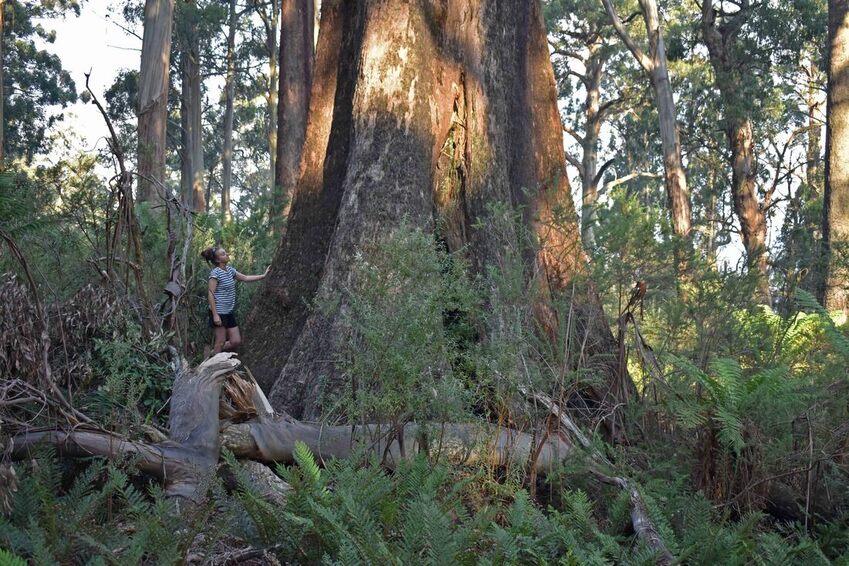
Above and below:‘Ritchie’s Ruin’ is a 13m girthed Eucalyptus regnans growing about 40m off the track that winds its way to Mt Ritchie. It is a truly charismatic tree; with its huge broken branches, irregular shaped trunk and large girth it would be an impressive sight anywhere. What makes it even more special is that it grows at an altitude of around 1030m a.s.l – I’m fairly certain I’ve never measured a mountain ash tree this big in Australia at such a high altitude.
Above and below: ‘Decadent Dell’ at 9.4m girth is the largest mainland Eucalyptus delegatensis subspecies delegatensis that I’ve put a tape around. The Victorian and NSW subspecies differs from the subspecies tasmaniensis (unsurprisingly from Tasmania!) in a number of ways:
- it grows at elevations between 900m and 1400m above sea level – the Tasmanian version grows at much lower elevations and rarely lives above 900m
- its stocking of rough bark on the trunk extends for only a third to a half of the trunk height before breaking into smooth bark – the Tasmanian subspecies has rough bark for all of the trunk
- the mainland subspecies is an obligate seeder (it is killed by fire – however, the fire initiates a mass seeding event). The response of the Tasmanian subspecies to fire is unclear
- the mainland subspecies is not known to get to the huge size of the Tasmanian subspecies – ‘deles’ in Tasmania are known to get to 87m tall and 18m girth
Mount Bride Beauties...
Mount Bride, a few kilometers south of the town of Warburton, rises over 900m in altitude. In terms of forest it has an interesting mixture of drier forests on its northern and western facing slopes, while nearer the summit and on the southerly facing slopes, wet forests predominate. While most of the wet forest originates from bushfires in 1932 and 1939, and more recent logging in the 1970s to the present, there are some sections that include giant and tall old growth trees and fantastic myrtle beech rainforests.
Above and below - 'The Bridal Twin' 400m off Mt Bride rd: This slow tapering tree is 10.3m girth and 67m tall
'Jeremy the Giant' is 13.4m girth and around 57m tall - it is easily seen about 80m off Mt Bride Road. It was likely never a very tall tree as the trunk tapers markedly above about 30m and it has some very large original branches.
Australian Bushfires - spring and summer 2019-2020
The Australian bushfires of 2019-2020 made international news for their sheer scale, the human lives lost, the horrendous death of billions of birds, mammals and reptiles, the loss of property, the evacuation of whole towns and the ongoing disruptions to people’s lives and livelihoods. Now that these fires have officially been put out, some people have asked me what affect these bushfires have had on some of the iconic giant and tall trees that were in the National Parks and State Forests that were burnt. While the fire maps provided by the state authorities are usually quite accurate, they obviously cannot show the fire intensity on the particular day the blaze went through an area.
In East Gippsland, trees which may be lost include the Ellery Saddle Grey Gum Eucalyptus cypellocarpa in the Errinundra NP, the ‘Big Tree’, a shining gum Eucalyptus denticulata along Monkey Top Track in the Snowy NP and the Kelly Creek Giant, the largest Eucalyptus obliqua known on the mainland. The largest Eucalyptus denticulata ‘Darejo’
In Southern NSW, the two largest known spotted gums, Corymbia maculata, were burnt. However, spotted gums are well known to be quite fire resistant and can survive quite severe bushfires relatively unscathed.
Along the Central Coast, ‘The Grandis’, a giant 76m tall flooded gum, Eucalyptus grandis near Bulahdelah was not affected. Neither was the 78m tall Eucalyptus nobilis in the Cunnawarra Flora Reserve inland from Coffs Harbour appears to have just escaped being burnt with fires a few kilometers to the south and north of the reserve.
In East Gippsland, trees which may be lost include the Ellery Saddle Grey Gum Eucalyptus cypellocarpa in the Errinundra NP, the ‘Big Tree’, a shining gum Eucalyptus denticulata along Monkey Top Track in the Snowy NP and the Kelly Creek Giant, the largest Eucalyptus obliqua known on the mainland. The largest Eucalyptus denticulata ‘Darejo’
In Southern NSW, the two largest known spotted gums, Corymbia maculata, were burnt. However, spotted gums are well known to be quite fire resistant and can survive quite severe bushfires relatively unscathed.
Along the Central Coast, ‘The Grandis’, a giant 76m tall flooded gum, Eucalyptus grandis near Bulahdelah was not affected. Neither was the 78m tall Eucalyptus nobilis in the Cunnawarra Flora Reserve inland from Coffs Harbour appears to have just escaped being burnt with fires a few kilometers to the south and north of the reserve.
Above: 'Old Blotchy' A giant Spotted Gum, Corymbia maculata, near Termeil, NSW South Coast. The large bushfires that devastated much of the region appear to have missed this tree and another equally large spotted gum nearby.
Below: Old Blotchy after the 2020 fires - note how some of the crowns of the trees in the background are still green
Below: Old Blotchy after the 2020 fires - note how some of the crowns of the trees in the background are still green
Below: Other old spotted gums post bushfire in the Murramarang National Park, Southern NSW.
Below: Before and after photos of the Kelly Creek Giant near Bonang, East Gippsland. This tree is 60m tall and 13.2m girth.
This giant Mountain Grey Gum, Eucalyptus cypellocarpa, above and the tall grey gum below may have been impacted by the East Gippsland fires
Update: Super Tall Tropical Tree
July 2019: A few weeks back I wrote about the super tall Shora faguteana named 'Menara' ( which means 'Tower') recently discovered in Danum, Borneo. The quoted height from the article was 100.8m tall. However, a recent paper on the measurement of the tree indicated that the 100.8m height was to the lowest point of the buttresses that extended below the low point of ground. Taking this buttress as the low point and the measured high point of 96.26m gives an overall height of 98.53m. Some very experienced tall tree enthusiasts have actually gone further and said the midpoint should be the difference between the high point of bole 96.26m and the low point of the bole 98.90m - which gives a height of 97.58m. While it is a bit disappointing that it has not quite reached the magical 100m mark, this is still an amazing height for a broad-leafed tropical tree. Furthermore, it has the most amazing form and is surrounded by extraordinary forest as you can see in the following video:
Southern Forest Giant Tree Fire Damage April 2019 Update
The Tasmanian bushfires that started with dry lightning strikes on January 15th burned for many weeks. These fires have had a devastating effect on most of the 500 year old giant trees that lived in the Southern Forests, inland from Geeveston. These very old trees are particularly susceptible to fire due to their various hollows, areas of rot and the centuries of accumulated ground debris consisting of fallen branches, bark, twigs and leaves. Most of these older trees have been killed, including some that have totally collapsed into an incomprehensible mess. Some of the living trees cling to life standing on blackened stilts, probably likely to fall when the next big wind storm hits. A lucky few have escaped with only a surface burn and could live for many years. A list of some of the assessed trees is included below, however, there were many trees that we were unable to access due to ongoing road safety works in those areas.
| table_of_burnt_trees_1.pdf | |
| File Size: | 55 kb |
| File Type: | |
Above: The incredible burnt out base of Bigfoot - how this tree is still standing is anyone's guess! Note the collapsed tree ferns - this view of the tree was previously impossible due to the rainforest understorey.
Below: Amazingly, the Kermandie Queen is still alive and standing after the burn that has now made it see-through!
Below: Amazingly, the Kermandie Queen is still alive and standing after the burn that has now made it see-through!
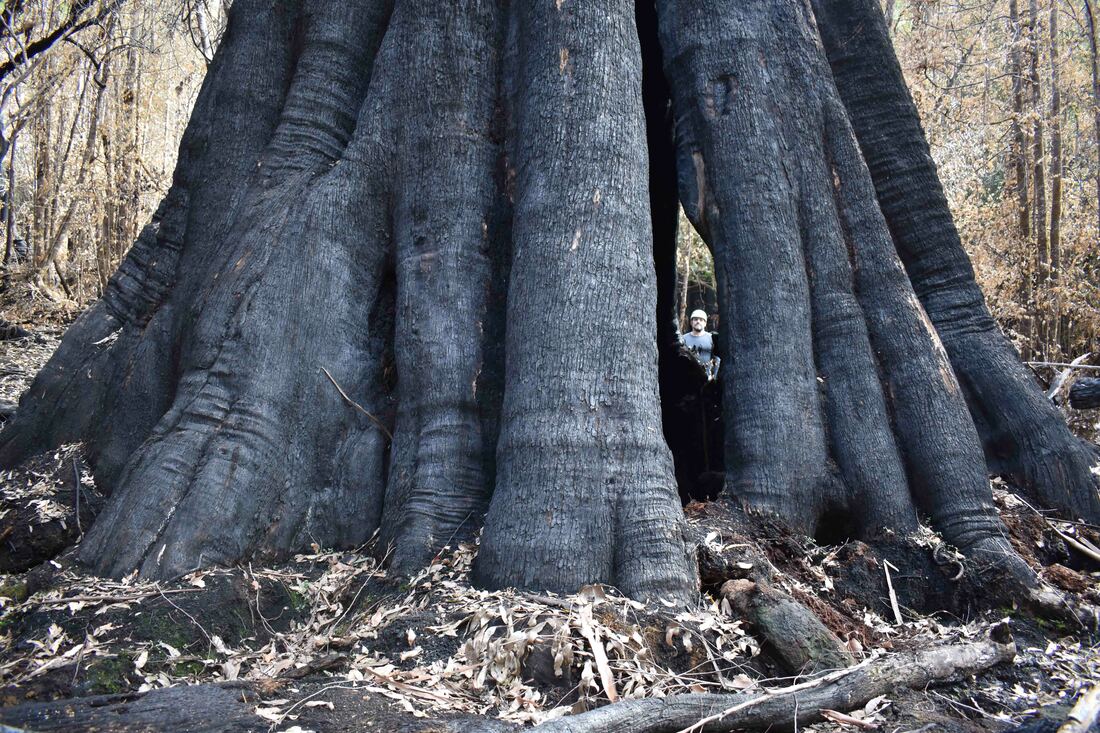
Below: photo 1: regrowth Eucalyptus regnans seedling - these baby regnans were everywhere in the millions, Photos 2&3: epicormic sprouting
Incredible tropical tree discovery!
In the tropical rain forests of Danum Valley Conservation Area in Sabah, Malaysia, a tree has recently been measured at 100.8m tall. This giant emergent tree is a Shorea faguetiana, a member of the dipterocarp family. Back in 2007, Tom Greenwood, Roman Dial and I found what was at the time the tallest known tropical at 88.3m - this also was a Shorea faguetiana. But 100.8m? This blows the previous records away and catapults Shorea faguetiana into 2nd place on the world's tallest tree species behind the Coast Redwood from California, which has many trees over 110m tall with the tallest over 115m. The 100.8m tree is also now the tallest known angiosperm (flowering plant) overtaking 'Centurion' a Eucalyptus regnans Click below for the full National Geographic story. Some photos of Shorea faguetiana and other super tall tropical tree species from our previous trips are also shown below:
The 2007 team at the base of the 88.3m tall Shorea faguetiana
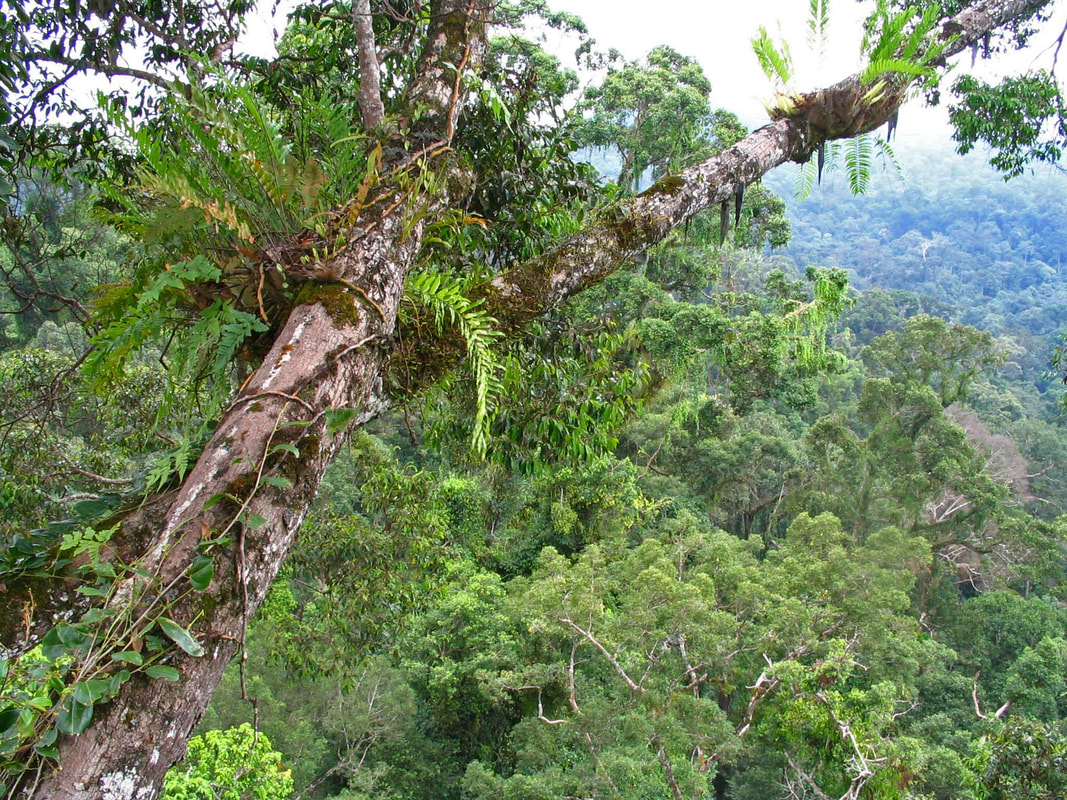
The view from a giant Shorea faguetiana - note the epiphytic orchids, vines and ferns on the branch.
Huge Shorea gibbosa, Roman Dial on the right gives scale.
Looking down an 86m tall Koompassia excelsa, with Tom Greenwood smiling on. The pinkish colour of the smooth bark occurs after rain
Majestic forest near Mt Donna Buang
Some wonderful old trees are visible on the way up Mt Donna Buang from the township of Warburton. Many of these mature mountain ash trees have intact crowns and despite their high altitude, some individuals exceed 85m in height. The tree photographed below came in at just over 89m tall and provided fine views of a forest in its prime.
Horrific Bushfires in Tasmania
In late December 2018 and January 15th 2019 'Dry Lightning' struck in many areas of Tasmania. Dry lightning is basically a thunderstorm without the rain - I actually experienced it as I was coming down from The Walls of Jerusalem NP on January 15th. Because the state had been experiencing one of its driest and warmest summer on record, these lightning strikes ignited many bushfires. One of these fires, known as the Riveaux Road fire, began on January 15th a few kilometers SW of the Tahune Airwalk. Because the forest was so dry, the fire was quick to spread and was unable to be controlled over the following three weeks. Tragically, the fire appears to have impacted on many of the giant and tall trees in the Arve, Huon, Kermandie and Barnback areas. While the fire would have burned at different intensities depending on the day, the wind and the aspect of the land, it is highly likely that most of the large old trees listed on this site from those areas would have died. This is because even if the tree survived the initial flames, very old trees invariably have hollows and rot pockets at their bases and lower limbs which allow multiple entry points for fire. This means an older tree can keep burning long after the fire front has passed. I will update the Tasmanian Giant Trees website pages for the Arve, Huon, Esperance and Dover areas as soon as I have better information. (see http://tasmaniasgianttrees.weebly.com/)
Trees that time (fire) forgot!
Of all the factors that influence the vegetation of Australia, fire is the most widespread and dramatic. The key aspects of fire intensity and fire interval have an enormous effect on the type of plant community that you will encounter in any particular place. The giant eucalypts of Tasmania that I regularly profile on these pages only get so large because they germinated shortly after a fire that occurred over 500 years ago. Furthermore, the reason why Victoria currently does not have any of the top 20 largest Eucalyptus regnans is not due to the lack of rainfall or appropriate aspects and soils. It is due to both the clearing of some of the best forests for agriculture in the late 1800s and the regular severe and widespread bushfires that have occurred since European settlement (1851, 1898, 1926, 1939, 1983, 2009). This has led to most of the Eucalyptus regnans stands remaining in Victoria being 80 years old or younger.
That is why the trees profiled here are so special: In this land of fire they have defied the odds and lived for well over a thousand years. The first is a Huon Pine (Lagarostrobos franklinii) I’ve nicknamed ‘Venerable Vera’ (photographed above) as it literally grows out horizontally out into the lake that gives its name on the track to Frenchmans Cap in Tasmania’s Franklin-Gordon Wild Rivers NP. There has been plenty of fires in the area over the years: Indeed the historical log book in the Tahune Hut records a harrowing walk by a group of women in the 1930s where they noted that the method of track clearing in those days was to burn the scrub! One lady wrote that the flames that night on the ridges reached over 200 feet in height. Luckily, ‘Venerable Vera’ and many other Huon pines escaped the flames in their protected niche by the lake side. As seen by the photos, where the trunk of the tree leaves the rock is now hard to determine, however, the trunk is at least 1.5m in diameter before the bifurcation. Given that the growth rate of a Huon pine is on average 1mm in diameter per year it is reasonable to think this tree is well into its second millennium.
Above 'Penta-Pine', below 'Poppa-Pine', Dixons Kingdom, Walls of Jerusalem NP. These are two of the largest single-trunked pencil pines in existence and would likely be well over 1000 years in age.
The next group of trees are Pencil Pines (Athrotaxis cupressiodes) and all are found within a forest known as Dixons Kingdom, located in the heart of the Walls of Jerusalem NP in Tasmania’s Central Plateau. At around 1250m in altitude, this area has severe winters – in fact bleak weather can occur here at any time of year. Nevertheless, the area still can have the occasional dry summer and the early cattlemen that would come up to the high country to graze their stock would often light fires to burn scrub. Some of these fires would get out of control and the skeletons of dead pencil pines seen for many kilometres across the central plateau are a stark reminder of the vulnerability of the pencil pine to fire. Dixons Kingdom not only contains the most extensive Pencil Pine stand I’ve seen, they also appear to be the largest, gnarliest and possibly oldest known. While the pencil pine does not reach the extreme age of the Huon pine, it still is a very slow growing tree and also known to exceed an age of 1200 years.
Two views of the extraordinary 'Octopine' in Dixons Kingdom. This tree has over eight trunks growing at all angles from its base. I thought I'd found the gnarliest pencil pine in 2018. However, this tree easily takes that title.
Tall tree confirmation
In Greek mythology, the Meliae were nymphs from the Mountain Ash trees - I know the trees growing in Victoria aren't exactly the European Mountain Ash that the myth refers to. However, I thought 'Meliades' was a suitable name for the amazing 1939 regrowth tree I lasered in early October. A week later on a beautiful spring day, Tom Greenwood and I climbed and measured it at 90.69m tall. The tree is a picture of health and vitality and is rocketing skyward. Below are some photos from the climb.
Above: Tom ascending 'Meliades'
Above and Below: Two views taken looking out from 'Meliades' from about 70m up.
Taller, faster........?
I was reasonably confident that nothing could top the recent news of the discovery and confirmation of the 1926 regrowth Eucalyptus regnans being climbed and confirmed at 92.1m tall: 92m in 92 years is pretty impressive. However, today, while I was continuing to follow up on the LiDAR data for the Central Highlands, I measured a tree that many may regard as being more remarkable. I lasered a 1939 regrowth tree at just over 90m tall.... Yes, you read that correctly. That is 90m of height in 79 years! This small grove, located in the Toolangi State Forest, contained many other trees over 80m including a further four trees I lasered at over 85m in height, the tallest being an exceptional bifurcated tree exceeding 88m. Before the LiDAR was done I had only found one 1939 tree over 85m tall, now we have at least six and I suspect this is only the beginning....
Looking up at the crown of the 90m tall 1939 regrowth tree. This is often the best place to laser a tall regrowth tree from, because you can often shoot right through to the highest leaves. Apologies for the bleakness of the photo, the day was very dull and grey.
Tassie wanderings.....
Firstly, some excellent news: The raised walkway at the Arve Giant has been fully rebuilt with steel after the original wooden version built in the late 1980s was deemed unsafe and removed about three years ago. The new walkway allows visitors to get an up-close look at this amazing tree. Although its top is long dead and breaking off bit by bit, it is still 85m tall. However, it is the Arve Giant's enormous trunk (photographed below) that makes this tree so impressive.
The Kermandie block contains some remarkable individual trees - including the very impressive base of the Kermandie Queen (photographed below). However, it also has a group of four 500 year old trees growing virtually side by side in a straight line - this is very unusual because by this late stage in the life of an old eucalyptus, trees are normally widely spaced. While none of the trees in the quartet is significantly large or tall in its own right, the grouping as whole is quite a sight. We've nicknamed this group 'The Four Horsemen'
Below: two views of the 'Four Horsemen' - I know, I know, you can only see 3 trees in either of the photos - unfortunately, the horizontal scrub (Anodopetalum biglandulosum) was so thick I couldn't get into a position where I could get all 4 trees into the shot!
Old growth forests are often quite dark at the forest floor, with mosses and ferns creating a tapestry of brown and green as demonstrated in this photo of 'Leaning Lumpy Larry' a tree 15m in girth deep in the Arve Loop Forest Reserve. Growing nearby I also photographed the fungi below - often the only splashes of colour in this gloomy light are provided by the assorted fungi that are continually breaking down the organic matter.
Victoria - back in the 90m+ club!
Every now and then a discovery comes along that makes you rethink what is possible for a tree species: Following up some amazing LiDAR data kindly shared by Vicforests, I began lasering some of the targets in early August. Today, September the 8th, Tom Greenwood and I measured one of these targets: a 1926 origin Eucalyptus regnans regrowth tree, located about 60km east of Melbourne. At first, Tom thought I'd played a trick on him by depositing the tape in the creek below to add a few meters to the tree's height - because the tape drop height came in at 92.1m! However, I assured him that the tape had come down on the high side of ground and the measurement was accurate. Not only does this discovery give Victoria a tree over 300 feet tall again*, it is the first known tree originating from the 20th century to reach 90m tall. This includes the entire planet, not just Australia! The tree is located in a sheltered gully and has a thriving, upwardly mobile and healthy crown. So far the tree has reached 92m tall in 92 years, and while it would be amazing if it could continue on that trajectory, our studies of nearby similar sized 1926 trees over the last 15 years indicate that its growth rate would now be slowing down. Nevertheless, hopefully this tree can escape the ravages of fire and windstorms for many more years yet and one day reach its full height potential.
(*Note that the only known tree in Victoria in the last 70 years over 300 feet was ‘Big Ash One’ from Wallaby Creek. This tree succumbed to the 2009 Black Saturday bushfires along with the four other known, measured 90m tall trees)
Above: Looking down from the 92.1m tall tree
Below: Tom silhouetted in the tree on his descent.
Below: Tom silhouetted in the tree on his descent.
On the trail of Giants
The Styx and Florentine Valleys have some truly immense eucalypts – rivalling in size those photographed in the late 1800s in the Strzelecki and Otway ranges in Victoria before those regions were ravaged by fire and clearing for agriculture. April is often a great time to visit them as the increased autumn dampness gives rise to a profusion of fungi that add colour to the forest floor.
Above and below; opposite views of the immense base of 'Jacques Wall', Styx Valley
Colourful fungi proliferate in the damp conditions: Above, Cortinarius metallicus. Below, Aphelaria complanata
The Lady Binney Forest Reserve contains an impressive stand of Eucalyptus obliqua. While the entrance to the old walkway is now obscured and the signs removed, a short walking track still exists, is easy to follow and immerses the visitor in classic old growth forest.
Nick standing 2m above the base of 'Gothmog', gives a sense of scale to the largest known Eucalyptus obliqua
The crown of Hercules in late afternoon light
The southern view of 'Two Towers' - a contender for the title of Australia's largest tree - framed by Russell and Nick
'Still Sorrow' the other contender for the title for Australia's largest tree by wood volume
'Accidental' Maydena Giants
Sometimes when searching for giant trees, it is more about the journey than the destination. A perfect example was in early January 2018. While walking from the Gordon River road high up into the range behind Maydena, on the way towards some LiDAR targets, we spied some beastly old trees just off the track. We continued on to the LiDAR trees which turned out to be in the 86-87m range - they were tall but not overly large trees (see photo below) and then returned to put the tape around a few of the older trees lower down the slope. Largest in girth, coming in at an impressive 20.4m was 'All about That Base'. Then there was 'Hercules' at 16m girth with some of the largest stubby branches I've seen on an old regnans. Last of the photos is 'Wall-Lord' with its slow tapering, dark trunk.
Above an 87m tall Eucalyptus regnans high up on the Maydena range - Even though it was late in the day and the light was poor, this was one of the few opportunities where we could capture an entire tall tree with a person for scale at the base.
Above, the 20.4m girth 'All About That Base'. It is not often that a eucalypt exceeds 20m in girth at breast height, in fact I can only count four other living trees in Tasmania in that category so this was quite an exciting find! This tree is also remarkable for its lack of buttressing or fluting on its entire lower side (in the photo, the right hand side all the way around the back) - it was literally a sloping wall of wood.
Above, the 16m girth 'Hercules' being obscured by a riot of mature musk (Olearia argophylla) This was probably the largest in overall volume of the trees we measured on the Maydena range. However, if the above picture does not do justice to the size of this tree, it was likely due to its base being one of the hardest to photograph I've encountered in a while.
Above, retrieving the tape after measuring 'Wall-Lord', a slow tapering beast on the Maydena range.
Styx Elders
While stopping on the side of the Styx road to assess where to go into the forest for a LiDAR target, I spied the two beauties photographed below. Both of them are in the oldest age class for regnans - over 500 years old - and have seen and lived through storms, droughts, fires and logging and they certainly have the character to show for it.
Above: two views of 'Sylvia's Throne. 15m girth, 60m tall
The 15.3m girth 'Gnarls Barkley' (I hope music fans get the reference!) - Again this tree's base was hard to photograph being completely surrounded by vegetation low down so I had to precariously balance on a small burl about 5m above the ground to get a sense of scale to the tree.
Gnarliest Pencil Pine?
At the risk of starting a debate, I'm nominating the two Pencil Pines, Athrotaxis cupressoides, pictured below, as the gnarliest I've seen. As seen below, one tree has low growing branches that have hit the ground and taken root to form new trees. Pencil pines grow very slowly, and these trees, growing at about 1250m above sea level in The Walls of Jerusalem NP, may exceed 1200 years in age.
Above: Pencil Pines are limited to high altitudes, usually between 850m and 1250m a.s.l - but I have seen them growing close to the summit of King Davids Peak at over 1450m altitude. They like constant moisture and peaty soils and are often seen surrounding mountain lakes and creeks. Unfortunately they are extremely sensitive to fire and due to the severity and frequency of fire since European settlement, very few large stands remain. In fact in many areas of their former habitat you can see the white skeletons of Pencil Pine trunks extending for vast distances because the wood is very resistant to rot. Above is a photo of the largest remaining Pencil Pine forest, growing at Dixons Kingdom in the Walls of Jerusalem NP, taken from Damascus gate on the walk to King Davids Peak.
Blue Tier Giant
The Blue Tier Giant is a tree that oozes character. I measured it at 18.6m girth and around 56m to its dead top, however, mere figures do not do justice to this old survivor. The tree is so gnarly and irregular that I suspect there is not a single part of the trunk that is round. The buttresses rise to over 11m up and the trunk splits into two at around 16m. In the photo below you may be able to see the twin trunks, the left terminates dead at around 25m up so the major part of the crown consists of the right hand trunk. In early January 2018, we started walking to the tree in bright sunshine, however, a thunderstorm developed and we had to temporarily shelter in the dry part of the massive hollow to avoid the downpour. To visit the Blue Tier Giant, follow the sign north off Tasman Highway a few kilometers south east of the town of Weldborough in the North east of Tasmania. Follow this major forestry road for about 1 km just past a quarry, then a sign will lead you right, down on a lesser road - take it easy on this road, the track is overgrown on both sides, visibility is limited and there is room for only one vehicle. Also don't forget to write in the visitors book kept at the base of the tree. Congratulations to the Friends of the Blue Tier Giant who have put in so much work to both protect this tree and many others in the area and also for the fantastic walking track they have built to provide easy access to the tree.
Gunyah Giants
The recently expanded Gunyah Reserve in the Strzelecki Ranges has 'fingers' of undisturbed forest consisting of Myrtle Beech rainforest and ancient, wind blasted, Eucalyptus regnans trees. Once you are away from the gullies and creek lines, on the flatter ridgetops, most of the forest is regrowth Eucalyptus regnans, the result of logging operations by HPV over the last 20-40 years. This regrowth forest often has a thick tangled understorey of correa and wiregrass making progress on foot slow and difficult. Nevertheless, as soon as you walk into the rainforest, progress is much more pleasant and you are transported to a relic of what these forests must have been like before European settlement. In late December in a six hour off track exploration focussing on the Upper Franklin river area we uncovered some impressive old beasts including the 13.8m girth 'Lone Star' (pictured below) and other trees 12.3m and 11.2m girth. The 'Lone Star' tree was unusual in that it was completely surrounded by myrtle beech rainforest, with its closest eucalypt neighbour at least 70m away - most of the big old trees in this area are in clusters above the rainforest gullies. In our travels we also came across a little waterfall (below) which gives you some idea of the pristine nature of the area.
Above and below - two views of Tom with the 'Lone Star'. With its slow tapering, stove pipe like trunk, 'Lone Star' is likely the 2nd largest tree known by wood volume in the Strzeleckis behind the 'Mt Fatigue Giant'. The tree is only around 50m tall, however, the main trunk is still thick where it is broken at around 45m up.
Below a small waterfall in thick rainforest on the upper reaches of the Franklin River
Emerald Creek gems....
July 2017 update: Tom Greenwood and I measured the tallest tree in the upper Emerald Creek stand on a cold Sunday in mid July. When Tom climbed to the top and lowered the tape, the tree came in at an impressive height of 85.2m tall. From his vantage point in an upper branch he was also able to easily laser the tops of the closest neighbouring trees and by carefully surveying the bases of these trees from the measuring tree we were able to obtain very accurate figures for them. They came in at 83.3, 82 and 81.4m tall respectively - which indicates that this tiny stand may in fact have more than a dozen trees over 80m in height, exceeding my previous estimate.
June 2017: In the headwaters of Emerald Creek there is a small but very impressive patch of tall regrowth Eucalyptus regnans growing on a steep, south facing slope. The stand probably originated in one of the numerous Dandenong Ranges fires of the 1920s and is bordered by an overgrown and likely abandoned Pinus radiata plantation. While the stand is tiny - only about 100m x 50m in size - I recently lasered at least 10 trees within it that exceeded 80m in height, with the tallest being about 84m. Many thanks to Jeff Latter, who is part of the Yellingbo Conservation Area Co-ordinating Committee for directing me to the area.
June 2017: In the headwaters of Emerald Creek there is a small but very impressive patch of tall regrowth Eucalyptus regnans growing on a steep, south facing slope. The stand probably originated in one of the numerous Dandenong Ranges fires of the 1920s and is bordered by an overgrown and likely abandoned Pinus radiata plantation. While the stand is tiny - only about 100m x 50m in size - I recently lasered at least 10 trees within it that exceeded 80m in height, with the tallest being about 84m. Many thanks to Jeff Latter, who is part of the Yellingbo Conservation Area Co-ordinating Committee for directing me to the area.
Gnarliest Snow Gum Alive?
I know this site is normally reserved for tall and giant Eucalypts, however, I couldn't let the opportunity of showcasing this old relic slip by. While bushwalking along Bluff track in Victoria's High Country between Mt Magdela and The Bluff at around 1600m in altitude, we came across this amazing snow gum Eucalyptus pauciflora subsp niphophila. It is perhaps the gnarliest snow gum I've ever seen in many a trip to the area - It has been named the 'King Billy Tree' and has Heritage listing on Victoria's National Trust register. Having no laser or tape measure with me, I didn't obtain any girth or height statistics - but the National Trust lists it at 9.4m girth and a wind restricted 6.7m tall! Snow gums at this altitude grow very slowly and are often covered in snow for 3-4 months of the year. They are also subject to extreme winds and bushfires. Miraculously, this locality had somehow missed the serious bushfires in 2003 and 2007 that burnt tens of thousands of hectares of alpine snow gum country. Nevertheless this tree appeared centuries older than all its nearby unburnt mature companions and all the other snow gums we saw over the three days of hiking.
Two views of 'The King Billy Tree'
Autumn in Tasmania's tall forests
Autumn is an ideal time to visit Tasmania's tall forests with often stable weather patterns that include cool nights, crisp mornings, calm days and excellent light for photos. So I took the opportunity to team up with some old friends to check out some special trees and also follow up on some potential tall trees identified by LiDAR.
The impressive base of the Kermandie Queen with (from left) me, Andrew, Ronnie, Rusty
'Devils Pitchfork' above and 'Fat Cat' below in morning light, Styx Valley April 2017
Twin tree on the 'Tolkien Track' Styx Valley, April 2017
Fungi of all colours and sizes abound in autumn in the wet eucalypt forests. Above: Pholiota malicola
The 88m tall 'Furry Flo' with its long stocking of rough bark. This tree is in a remote part of the Wayatinah area, accessed through pure rainforest of sassafras and myrtle and may never have seen a human visitor before.
Above - when looking for a potential tall tree identified by LiDAR, a giant tree had collapsed across Harveys Creek allowing us to cross easily - when looking back to photograph the crew crossing the creek I noticed just how big the tree I'd ambled past was!
Above: The incredibly gnarly 'One Armed Bandit'
An unexpected surprise greeted us when we opened the bin at the Arve River Camping ground: a spotted quoll snacking on discarded chicken!
Above and below: The remarkable 'Stilt Tree' - how this giant leaning monster is still upright is anyone's guess with probably 200 tonnes of wood being supported by a few remaining living shafts of wood.
Below, Rusty with the giant Eucalyptus obliqua 'Obli Wan Kenobi' (apologies to all Star Wars fans)
R.I.P Wayatinah Giant
When walking up Heald Spur in January 2017 I noticed from afar that the familiar crown of the Wayatinah Giant was missing from the skyline. This tree had been severely damaged by a fire in 2010. (for comparative photos see http://tasmaniasgianttrees.weebly.com/florentine-and-upper-derwent.html ) Although growing 50m above the road, it had collapsed and tumbled a little way downhill before falling and the top section had shattered, completely obliterating a section of the regrowth below the road and 80m from the tree base. This tree was pretty special to me as it was the first truly giant tree I found in Tasmania in 1992. It was 17.4m in girth and was 85m tall - it's trunk remained massive for a long way up, with the tree having the largest diameter for a living eucalypt at the 45-50m height range where it was still 6m in girth.
Climbing the Wayatinah Giant in 2009
Introducing some 'new' Tasmanian giants...
In January 2017 a number of amazing trees were uncovered when searching through a few areas where there had been LiDAR hits above 85m. 'Countess Basie' is over 16m girth and is very photogenic having an unusually clear view to its base. 'Brutus Maximus' is an 86m tall Eucalyptus regnans and while it has a large, rather than 'giant' girth of 13.8m, it still may push 280m³ in volume due to its huge, slow tapering trunk. 'Shield Maiden' at 17.4m girth and 87m tall is a show stopping, classic 500 year old Eucalyptus regnans, clean of branches for a considerable way up on its southern side. However, these trees were almost upstaged by a pair of ancient Eucalyptus obliqua trees growing 30m apart. 'Obnificent' has a redwood like lower trunk and is 14.8m girth and around 77m tall. Its neighbour 'Obli-Wan Kenobi' has a slightly larger girth at 15.8 and an amazing gnarly fluted trunk and complex crown.
Above, 'Countess Basie'
Above left, the slow tapering lower trunk of 'Brutus Maximus', above right shows the trunk remaining large right up to around 75m.
The trunk of 'Shield Maiden' rising up through the rainforest
The lower side of the base of 'Shield Maiden'. Over the centuries a huge amount of plant matter builds up and breaks down creating a fertile bed for mosses, ferns and larger plants like tree ferns, sassafras and myrtle to germinate and grow.
Above and below, the slow tapering, redwood like lower base of 'Obnificent'
The gnarly trunk of 'Obli-Wan Kenobi'
Strzelecki Giants
An eight hour off track walk through the gullies and ridges of the headwaters of the Upper Franklin river in early January 2017 has uncovered some very gnarly giant old trees. As is the case with most old Eucalyptus regnans in the Strzelecki Ranges, all of the 300-400 year old trees we saw had long ago lost their original crowns. Although some, like 'Octopia' (photographed below), had re-developed a complex lower branch structure and a full crown. While older trees were scattered throughout the area, 'Octopia' was found in a small patch of very old forest which produced all the largest girthed trees of the day: 'Benedict' 14.3m, 'Franklinstein' 13.2m, 'Octopia' 13.1m with many more over 10m. This part of the Strzelecki Ranges is also the only place on earth where the otherwise very rare slender tree fern, Cyathea cunninghamii, is actually abundant and was seen thriving in all the gullies we traversed.
,Slender Tree ferns, Cyathea cunninghamii, rising above soft tree ferns Dicksonia antarctica in the headwaters of the Upper franklin river
The impressive base of 'Octopia' 13.1m girth dwarfs my 195cm tall companion, Tom Murdochl! In the background myrtle beech Nothofagus cunninghamii forest, in the long absence of fire, is slowly overtaking the wet sclerophyll understorey
The tentacle like crown of 'Octopia'
Google earth helps locate big trees in logging regrowth
Recent improvements in the quality of the satellite images on google maps in some areas has helped me locate some impressive old trees amongst 20-30 year old logging regrowth off Nolans Road near Toolangi. The largest tree located I called 'Boss Nolan' - it is 10.5m girth but has a slow taper and a very large lower 25m of trunk including a 'fire window' about 20m up. In all there would be over 40 old trees surviving amongst the regrowth in the area and as they all have survived both the 1939 and 2009 fires, virtually all of them having fire scars and broken, decaying tops.
Above: 'Boss Nolan' crown and base
Above 'Nobbly Nolan', below 'Curly Nolan'
A different concept of time!
Two photos of 'Velvetine' taken 25 years apart show how little the tree appears to have changed in the time I first saw it - unfortunately the same can't be said about the person in both photos!
Giants survive Kobiolke Fire
A fire that started in a nearby logging coupe in February 2015 impacted on a number of old growth trees growing along Kobiolke Fireline in the Latrobe State Forest near Powelltown. Even though the fire killed most of the understorey shrubs and wattles, the steep southerly aspect of the forest meant the fire did not burn fiercely enough to kill the old E. regnans trees that make this such a special place. Below are a few photos of the the 11.7m girth, 65m tall 'Belladonna' taken after recent (June 2016) snowfalls.
1939 regrowth reaching for the sky
In mid-May I re-measured the tallest known 1939 regrowth tree 'Ferguson's Ghost'. The laser measurement indicated the tree is now at least 85m tall.The tree is in excellent health and shows no ill effects of having an under-storey burn in February 2009 (the fires killed a number of nearby trees as can be seen in the photo below) Late autumn is a great time to visit the mountain ash forests, the temperature is generally cool, the forest is damp and lush and there is a profusion of different fungi species that can be seen.
Above, Armillaria luteobubalina.
Victoria's largest trees paper published in the Victorian Naturalist:
Grant Harris and I have had a paper on Victoria's largest trees published in The Victorian Naturalist, April 2016, volume 133 (2). This is a paper 25 years in the making! We are grateful to the Victorian Naturalist for giving us permission to reproduce it below:
Giant Tasmanian Trees
In late December 2015 some previously unknown giant trees were discovered near 'Rullah Longatyle' the giant Blue Gum off Johns road in the Esperence Forests in Southern Tasmania. This remnant patch of forest is unusual as it contains giant Eucalyptus regnans, obliqua, delegatensis and globulus as well as large examples of myrtle beech and sassafras all growing within a 3 hectare area. Pictured below is Yoav Bar-ness next to 'The Spiral Claw', a giant Eucalyptus obliqua. Further examples can be seen at http://tasmaniasgianttrees.weebly.com/esperence-and-dover.html
Big Grey Gum found
A large grey gum Eucalyptus cypellocarpa has been discovered in the Toolangi State forest by local conservationist Harley Sanderson. Named 'Ramah' the tree is 10.15m girth and 54m tall and boasts an impressive lower trunk as the picture below demonstrates. With an estimated volume of around 150-165m³ the tree will likely rank in the top 2-3 grey gums known. Hopefully the discovery of this tree and other nearby large, old hollow bearing grey gums will mean that planned logging in the vicinity will not proceed.
Double Decker Dindi not able to be saved
A recent assessment (August 2015) of the 87.6m tall tree 'Double Decker Dindi' revealed a further deterioration of its condition. The taller uphill fork is now leaning into a neighbouring tree and the split from the fork 14m up now almost goes right to the ground. In this condition it is not able to be saved using bolts and cables. It will be interesting to see what will happen to the downhill side fork once the uphill fork falls right away. At the moment this fork is not leaning and is around 86.5m tall.
Blackbeard loses his crown
Until recently 'Blackbeard' was regarded as Victoria's largest living tree with a volume of 245m³.However, a winter storm back in 2014 sheared off part of Blackbeard's upper trunk. Recently I went to assess the damage and found that the tree was now 57m to where the trunk was broken - a loss of 16m of trunk from it's original height of 73m. While this part of the tree was not massive it still meant a loss of around 15m³ of wood volume, so the tree is now around 230m³ and ranks about 4th or 5th in the state.
The dead top of 'Blackbeard' taken in 2010 - this whole section has since fallen, taking a considerable amount of living branches with it when it fell.
Hidden treasures of the Otway National park
In late June 2015, an off track search of forest in the Great Otway National Park uncovered some wonderful 'new' giants. At least twelve trees between 12m and 14.9m girth were measured and many more in the 10m+ girth range. Highlights of the trek included the discovery of 'Grumpkins' with its enormous lower trunk, the 'Vim Vitale', possibly the equal largest Eucalyptus viminalis in the state and 'Sammy Spreadwell', with a girth of 14.9m. Off track walking in the Otway ranges is often a nightmare with devilishly steep and slippery gullies combined with dense vegetation making progress very slow. However, in this particular case, the fact that we covered only 1.5km in 6 hours was more due to the fact that there were so many great trees to measure and photograph because the terrain, vegetation and weather were pretty friendly by midwinter Otway standards.
The huge lower trunk of 'Grumpkins'. This tree is broken at about 35m up, however, its lower 20m is huge.
The 'Vim Vitali', Eucalyptus viminalis, 10.5m girth, 50m tall to a dead and broken top
'Sammy Spreadwell', Eucalyptus regnans, 14.9m girth, top broken at 45m up
Climbing the Lonely Tanjil Titan,
In late March 2015, a dedicated team of four climbers lugged their packs 4km up an overgrown track to climb and measure the Lonely Tanjil Titan - a huge mountain grey gum, Eucalyptus cypellocarpa, located a few kilometres east of the tiny locality of Tanjil Bren. We found the tree had decayed significantly since I first noted it in 1992. I re-measured it in 2006 where the top of the trunk was dead but still reached 64m tall. Now its main trunk is broken at about 33m up, however, a huge but dead original branch that is still hanging onto the shell of the trunk rises up to height of 44m. Despite the loss of about 25m of the main trunk, the tree still contained 163m³ in its reduced state due to its stove-pipe like lower trunk. This makes it the largest measured Eucalyptus cypellocarpa, however, the huge mountain grey gum at Ellery Camp has not been accurately measured for volume (see East Gippsland). Interestingly, once again there was an abundance of arboreal lizards that had made their home high up in the canopy of this aged hulk of a tree.
Grant Harris climbing the Lonely Tanjil Titan - the orange colour in the trunk is actually the sun shining through the smoke haze of a nearby regeneration burn!
Looking down to Damien and Ronny climbing the massive lower trunk of the Lonely Tanjil Titan
Good news ...... and bad news
The good: Today, March 8th, Tom Greenwood and I went back to Double Decker Dindi to climb and measure it. The tape came down and the tree came in at 87.66m tall – currently the tallest living measured tree in mainland Australia!
The bad: The tree has a major and apparently recent split at its bifurcation that runs for about 6m down from where the two trunks originally separated (see photo below). It is unclear how long the tree will remain upright – there is a possibility we could get a team together and cable together the upper trunks and then perhaps bolt the tree at the split.
The bad: The tree has a major and apparently recent split at its bifurcation that runs for about 6m down from where the two trunks originally separated (see photo below). It is unclear how long the tree will remain upright – there is a possibility we could get a team together and cable together the upper trunks and then perhaps bolt the tree at the split.
The Tallest tree in Mainland Australia – A new Contender!
On February 8th 2015, I measured a ‘new’ contender for the title of tallest living tree on the Australian mainland. This tree appeared on old (2007) LiDAR mapping from Vicforests at over 84m tall, but no one had actually gone to the tree to get a more accurate height using a laser. This regrowth tree with a healthy live top is located in the Toolangi State Forest, on the lower section of a gentle ridge not far from a small gully and creek – it is around 1km off a primary gravel road. This mountain ash tree is a stunner – forking at around 20m up with both boles remaining pretty clear for a long way up. Using the photo below as a reference, the left fork was lasered at 87m tall while the right fork was at least 86m tall. My companion on the day Pat, while scratched from some of the wire-grass thickets we had to walk through, definately approved of the name I have given the tree: ‘Double Decker Dindi' (see second photo below). Double Decker Dindi's DBH is 1.62m making it highly likely that the tree originates from fires in 1919, like other large regrowth Eucalyptus regnans trees in the vicinity.
'Double Decker Dindi' each fork is over 86m tall
Pat at the base of 'Double Decker Dindi'
'Prince William' tree over 85m tall
In October 2014 the tallest known tree in the patch of forest below William Ricketts Sanctuary off the Mt Dandenong Tourist Road was climbed and measured by Tom Greenwood and Grant Harris. I had lasered this tree from the ground a number of times in the past - at 82m in 2001 and 84.5 in 2011 - and was pleasantly surprised with the current total height of 85.68m which makes it 5th on the mainland's tallest measured, living trees. The site appears to be exceptionally fertile with at least 5 other trees in the stand exceeding 80m in height with 2 of them having a girth greater than 8m. As the morning light filtered through the surrounding forest I took the photo below.
We were also visited by some noisy rainbow lorikeets (Trichoglossus haematodus) high up in the canopy (photo Grant Harris)
Uncovering Strzelecki giants
A September 2014 expedition to uncover giant remnant Eucalyptus regnans in the Strzelecki Ranges unearthed a half dozen previously unknown large trees between 11m and 12.5m girth - the largest in volume was the 'Ridgie Ruin' pictured below. It had a probable wood volume over 170m³, despite it being a hulk with a broken trunk at about 33m up.
'His Royal Antechinus' a giant home for greater gliders
In late April 2014 a team of climbers measured the newly named and discovered tree, 'His Royal Antechinus'. The tree turned out to be considerably larger than first thought and, at 206.5m³, it now ranks as the 10th largest tree measured in Victoria. What was perhaps more impressive on the day was the appearance of two greater gliders (Petauroides volans) in the tree. One of which we had the privilege of seeing glide from the top of the tree down to the lower branches. The other stayed high up on a small outer branch, warily watching the activities of the strange noisy creatures who had interrupted his daytime sleep.
Greater glider 55m up 'His Royal Antechinus' - Photo by Dan Dass, courtesy of Grant Harris' camera!
Climbing 'His Royal Antechinus' - photo Grant Harris
Skinks discovered living high up in old mountain ash trees
Environmental scientist Grant Harris has written up a paper on our sightings of Spencers Skink in very large, old Eucalyptus regnans trees in the Central Highlands. Furthermore, the editors of the Victorian Naturalist journal have gratefully given us permission to publish the paper below.
'New' Toolangi Giant
Recently, Toolangi naturalist Don Butcher measured a large Eucalyptus
regnans tree, located in the Toolangi State Forest. It came in at 14.1m
girth and 65m tall. Its trunk was broken at around 55m up; nevertheless it was
still quite healthy with a fully developed mid-trunk crown composed of many
large branches. The tree has a fire scar on its northern side, not from the
recent 2009 fires but more likely from the 1939 bushfires and a mostly clear
bole for the first 30m. We have named the tree 'His Royal Antechinus'
after a small male of the species was found dead at the base of the tree -
Presumably having 'mated' himself to death as is the fate of all males of the species!
regnans tree, located in the Toolangi State Forest. It came in at 14.1m
girth and 65m tall. Its trunk was broken at around 55m up; nevertheless it was
still quite healthy with a fully developed mid-trunk crown composed of many
large branches. The tree has a fire scar on its northern side, not from the
recent 2009 fires but more likely from the 1939 bushfires and a mostly clear
bole for the first 30m. We have named the tree 'His Royal Antechinus'
after a small male of the species was found dead at the base of the tree -
Presumably having 'mated' himself to death as is the fate of all males of the species!
Photos: Don Butcher
Tasmanian tall tree LiDAR finds
In 2013, Forestry Tasmania’s ongoing LiDAR* survey of State
Forests uncovered nine potentially 90m+ trees in the Huon and Styx areas. In
December 2013 I was able to check out 7 of the LiDAR hits - of which 6 turned
out to be genuinely tall, old growth Eucalyptus regnans trees between 88m and
92m in height. The most impressive tree was a 92m tall tree deep within the
Kermandie block. This wonderfully formed tree is branchless for 45m and has
living top rising above an original crown. This is unusual in this area where
most of the very old trees have broken crowns and are composed of epicormic or
secondary branches which form lower on the trunks as a response to crown
dieback or loss higher up. I have nicknamed this tree ‘Kermajesty’. Other
impressive trees included a 90m tree off Arve spur 2 and an 89m tall tree high up on
the Maydena range.
* LiDAR is short for Light Detection and Ranging. It is a
technology that uses a stream of laser pulses, in this case taken from an
aeroplane, to generate three dimensional structural data of the landscape you
are flying over.
Forests uncovered nine potentially 90m+ trees in the Huon and Styx areas. In
December 2013 I was able to check out 7 of the LiDAR hits - of which 6 turned
out to be genuinely tall, old growth Eucalyptus regnans trees between 88m and
92m in height. The most impressive tree was a 92m tall tree deep within the
Kermandie block. This wonderfully formed tree is branchless for 45m and has
living top rising above an original crown. This is unusual in this area where
most of the very old trees have broken crowns and are composed of epicormic or
secondary branches which form lower on the trunks as a response to crown
dieback or loss higher up. I have nicknamed this tree ‘Kermajesty’. Other
impressive trees included a 90m tree off Arve spur 2 and an 89m tall tree high up on
the Maydena range.
* LiDAR is short for Light Detection and Ranging. It is a
technology that uses a stream of laser pulses, in this case taken from an
aeroplane, to generate three dimensional structural data of the landscape you
are flying over.
Giant Shining Gums climbed
In late November 2013, two giant shining gums, Eucalyptus denticulata, were climbed and their volumes measured. The largest, 'The Whitelaw Tree' came in at an impressive 229m³ in wood volume. This makes it the 5th largest tree in Victoria. Its girth was 14.9m at breast height while its trunk was broken at 50m. The second tree, named 'Hairy Maclary' due to its very shaggy appearance, contained 187m³ in trunk wood volume. These shining gums are growing at 1000m asl: winters are long and cold with regular snow falls, summers are mild. It is therefore highly likely they are between 450 and 500 years old. Below, my climbing companions, Grant, Julia, Ewan and Dan are enjoying doing the final tape wraps on the Whitelaw Tree.
Wotan's Spear height confirmed
In late October 2013, 'Wotan's Spear' was climbed by Tom Greenwood and Grant Harris and its height confirmed at 85.2m. The photo below shows a view of the magnificent 1926 regrowth forest taken from the tree.
Giants in the Strzelecki ranges
A recent (September 2013) off-track trip deep into the Gunyah area of the Strzelecki Ranges uncovered a surprising number of ancient mountain ash trees with very large girths. While most of them had lost their tops generations ago, what they lacked in height they made up for in their gnarly, buttressed bases, often lined with moss and filmy ferns. The biggest tree of the day came in at an impressive 15.7m girth, making it one of the largest bases in the State.
'Dr McCavity', while only 45m to a broken top, makes up for it's lack of height with a girth of 15.7m and some unusual features, including the 'toothed' cavity for which it is named and what appears to be a suppressed regrowth tree growing out of the front buttress (Photo: Grant Harris)
Kalatha Tree walk
The
walking track to the Kalatha Giant was officially opened by Mark Butler, the
Federal Minister for the Environment on Sunday 28th August 2013. The well graded
250m track forms a loop and takes visitors both above and below the tree. I
first noted this tree back in 1992 and it is fantastic that many people can now
easily appreciate this magnificant mountain ash tree.
Directions from Healesville:
Take Meyers Creek rd, head north 10km through some fantastic 1926 regrowth mountain ash forest along Meyers creek scenic Reserve. Turn right into Sylvia Creek Rd, travel along 10km, passing WirraWilla Rainforest walk and just past Tanglefoot Picnic ground. take Kalatha rd on the left. The car park for the walk is about 1.5km down Kalatha Road.
walking track to the Kalatha Giant was officially opened by Mark Butler, the
Federal Minister for the Environment on Sunday 28th August 2013. The well graded
250m track forms a loop and takes visitors both above and below the tree. I
first noted this tree back in 1992 and it is fantastic that many people can now
easily appreciate this magnificant mountain ash tree.
Directions from Healesville:
Take Meyers Creek rd, head north 10km through some fantastic 1926 regrowth mountain ash forest along Meyers creek scenic Reserve. Turn right into Sylvia Creek Rd, travel along 10km, passing WirraWilla Rainforest walk and just past Tanglefoot Picnic ground. take Kalatha rd on the left. The car park for the walk is about 1.5km down Kalatha Road.
Tall tree measurement
In early July 2013 I measured a tree along the Tomahawk Creek, Beenak, at over 85m tall. This tree is 2km further upstream from the 'Bunjil's Spear' tree and associated patch of very tall trees. The tree is superbly formed and only about 1.2m in diameter (see below). My companion on the day, Brian Walters, gave it the evocative name 'Wotan's Spear' It appears to be of 1926 origin and hopefully has many years of growth left in it.
Fireline Beauty
I recently remeasured a tree I had originally noted back in 1992 - I called it the Fireline Beauty and it grows off Kobiolke road, south of Powelltown. It is the tallest known of the trees that exceed 175m³ in volume. The tree is on a steep slope and the height is around 83m - a number I hope to get more accurate when the tree is climbed.
Large Shining Gum
An impressively large shining gum, Eucalyptus denticulata, was found not far from the Whitelaw tree (same species). It grows at around 1000m above sea level. It is 10.7m girth and about 58m tall. It has an incredibly gnarly and shaggy appearance - so I have named it 'Hairy McClary'.
